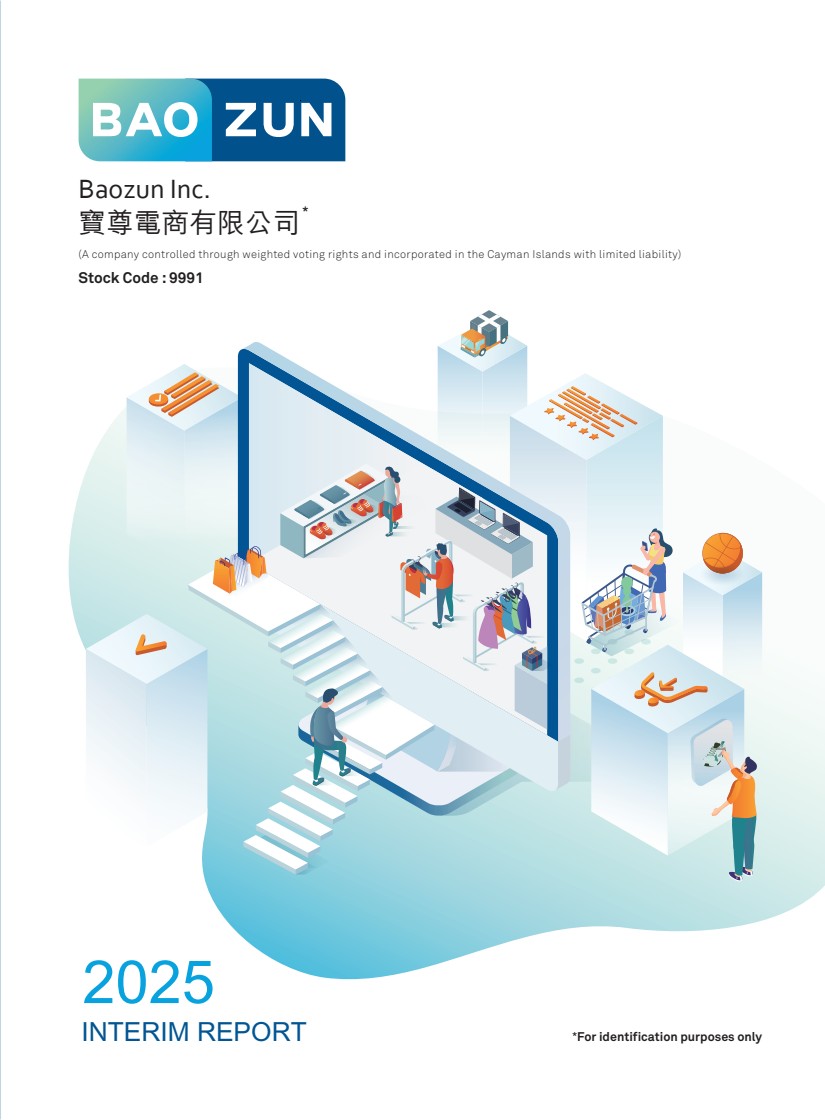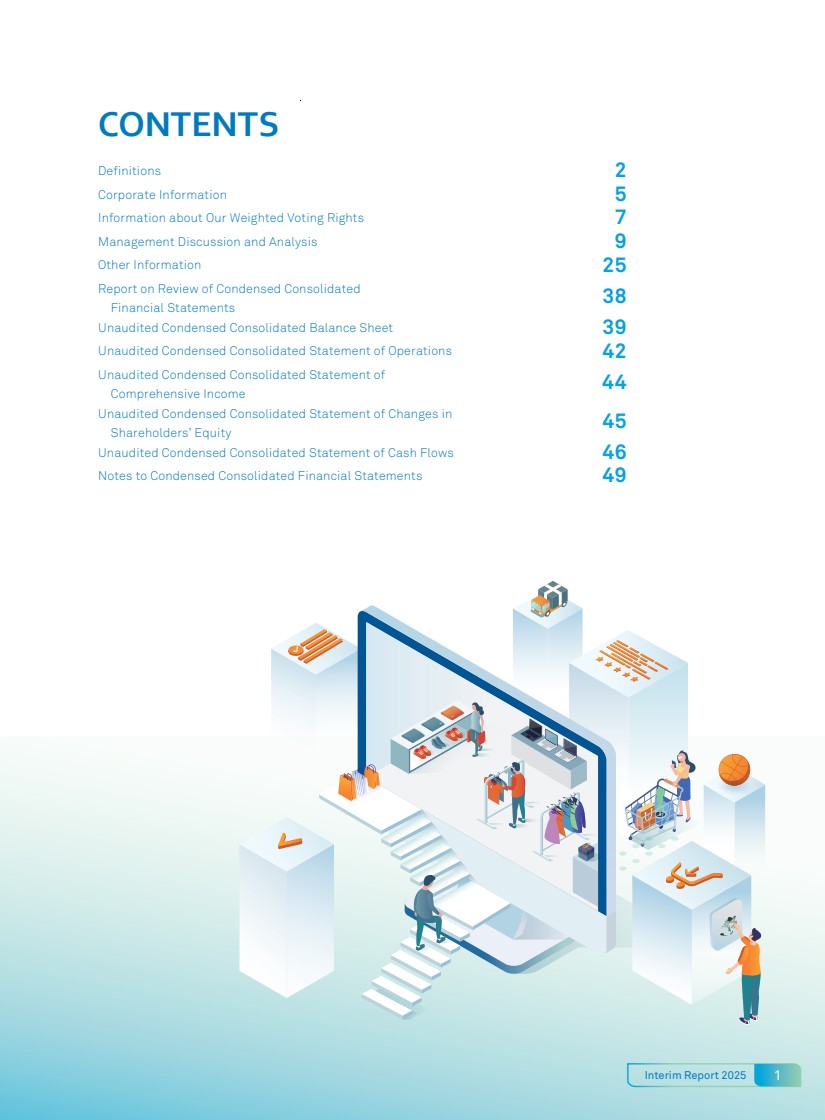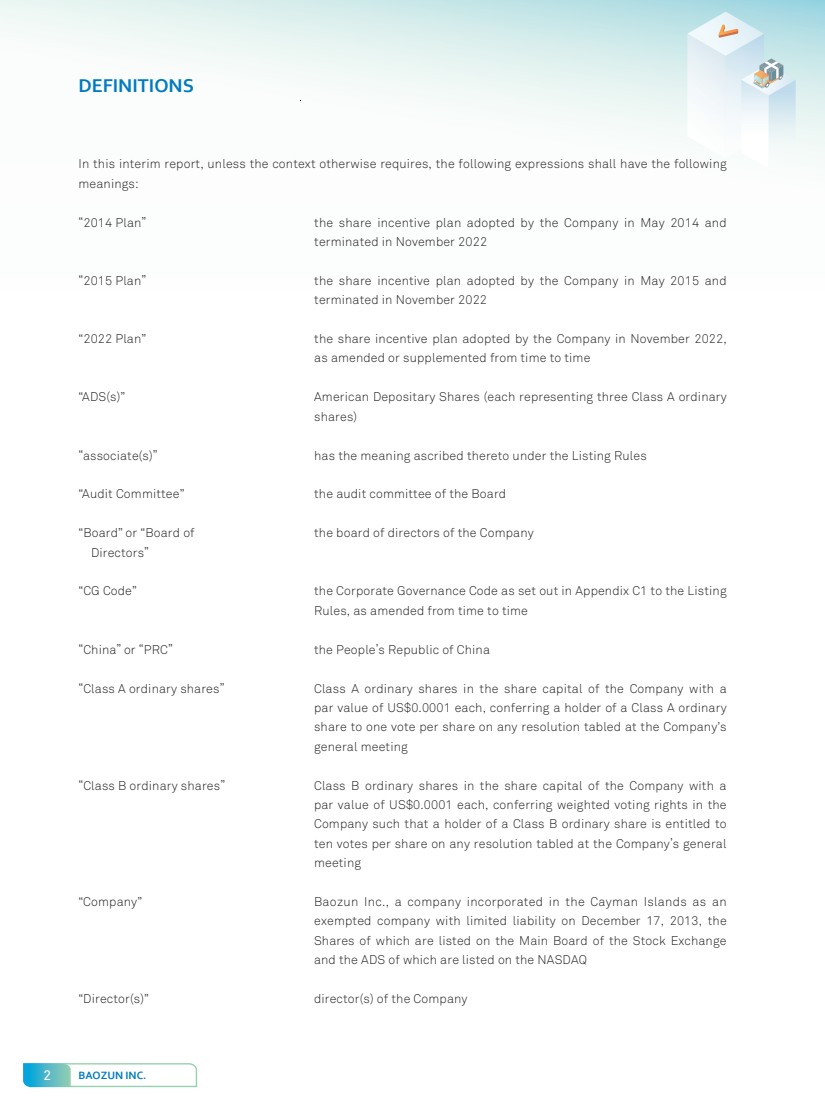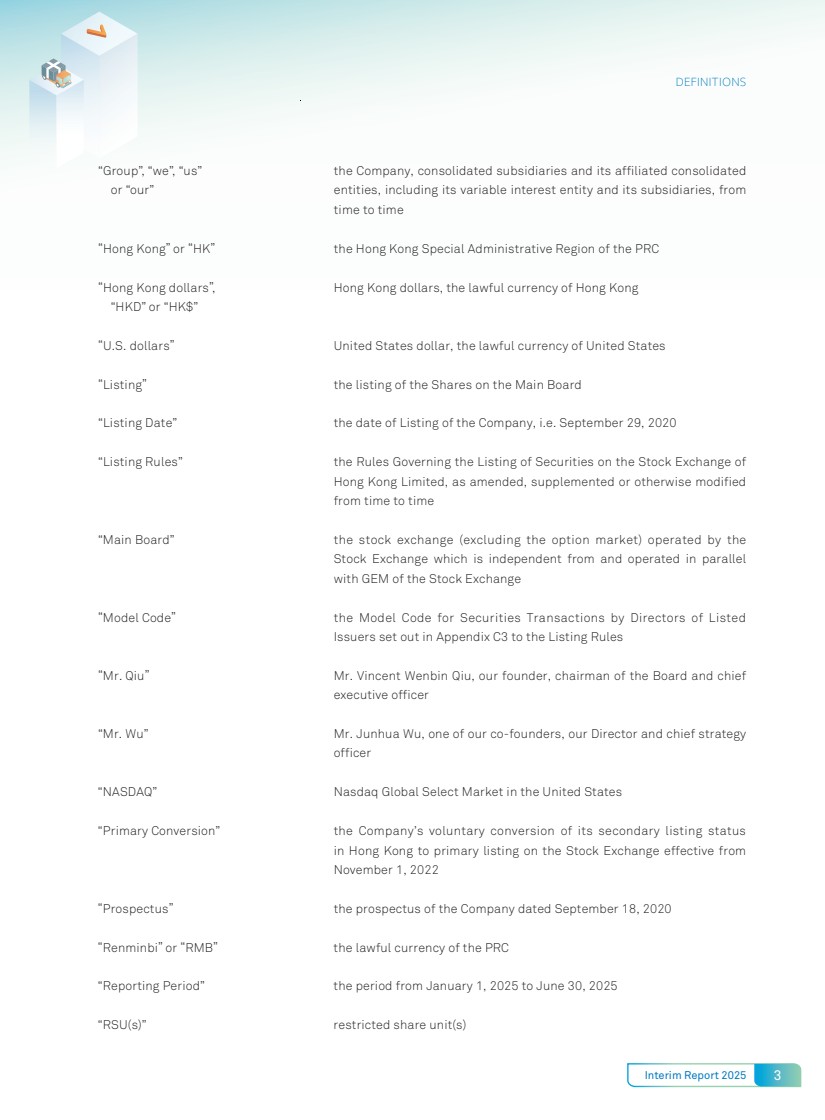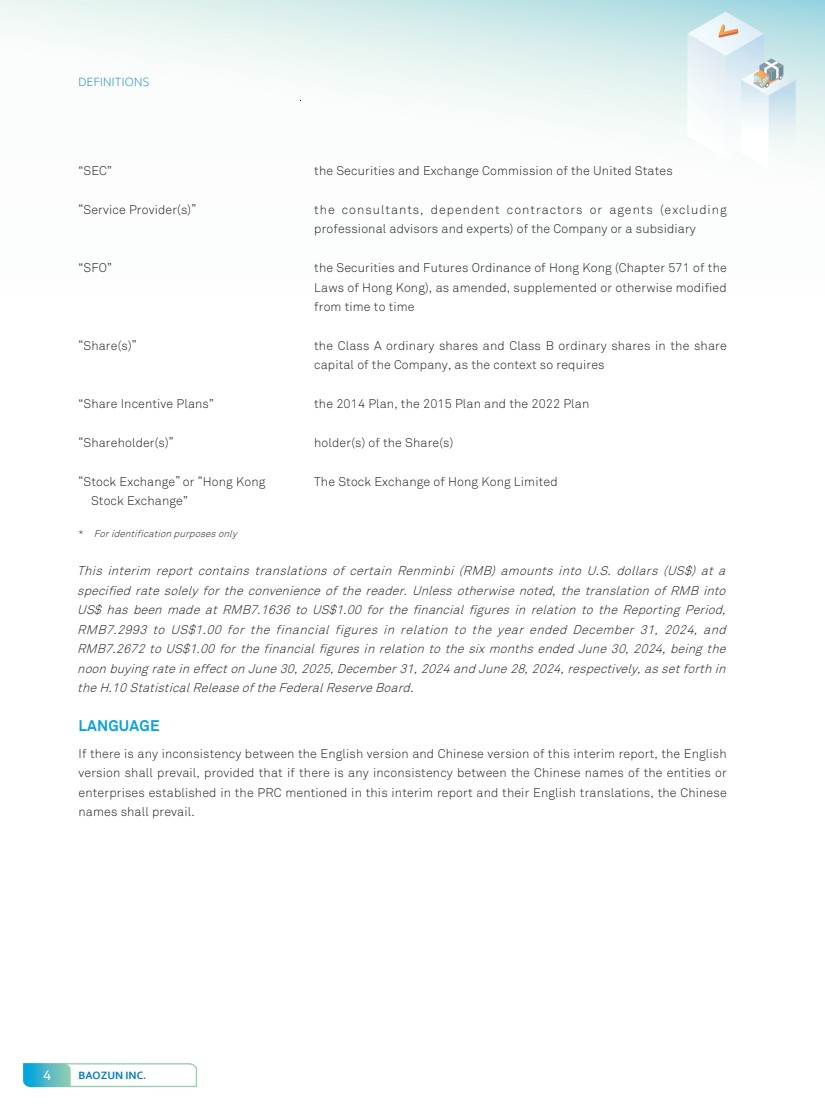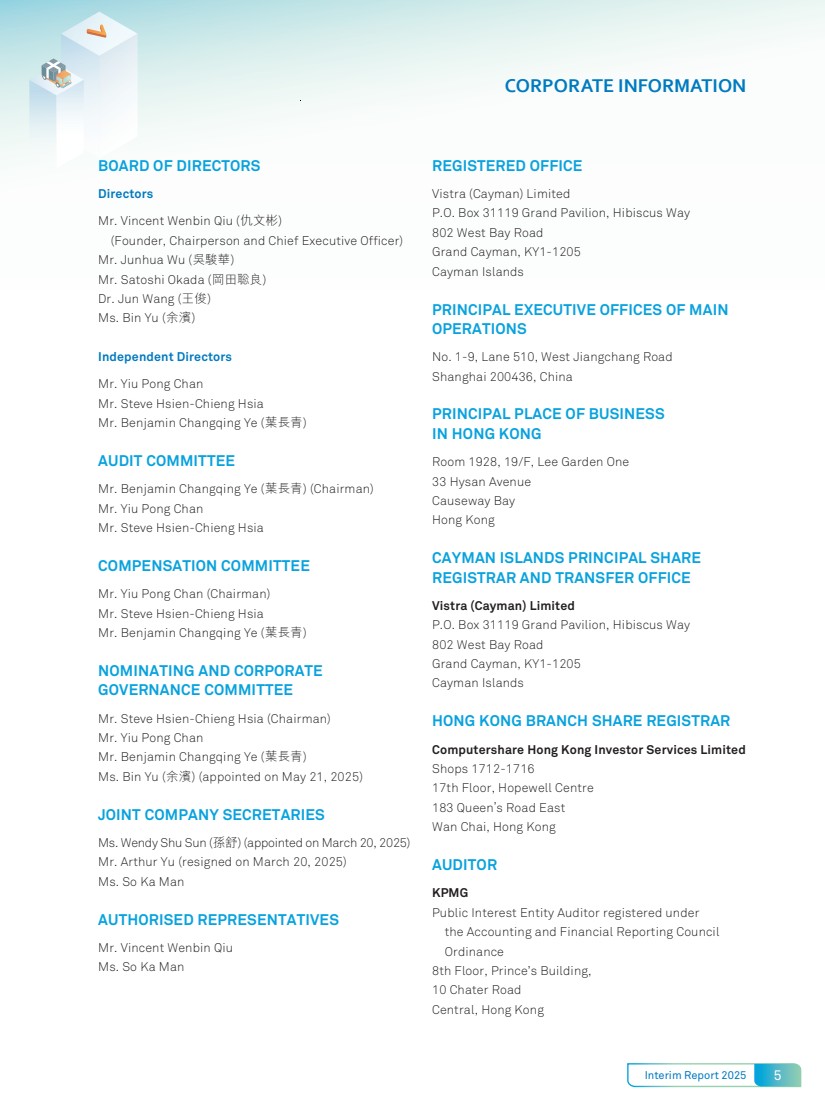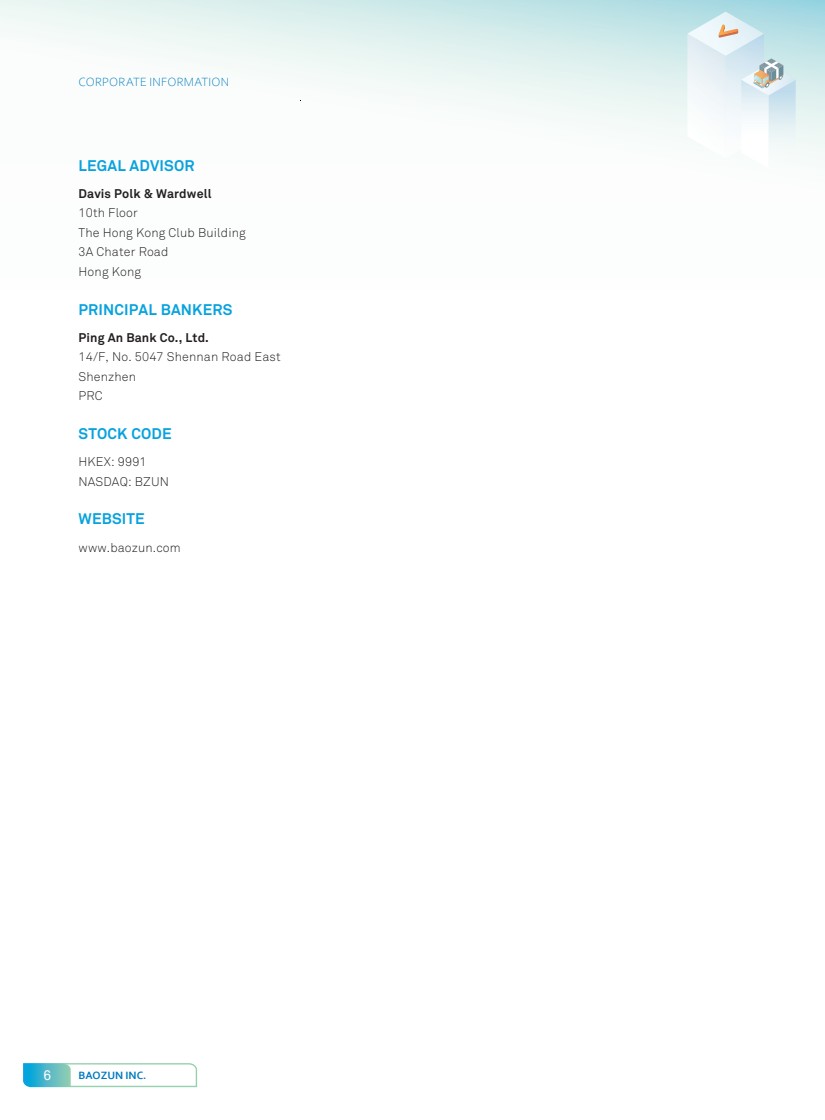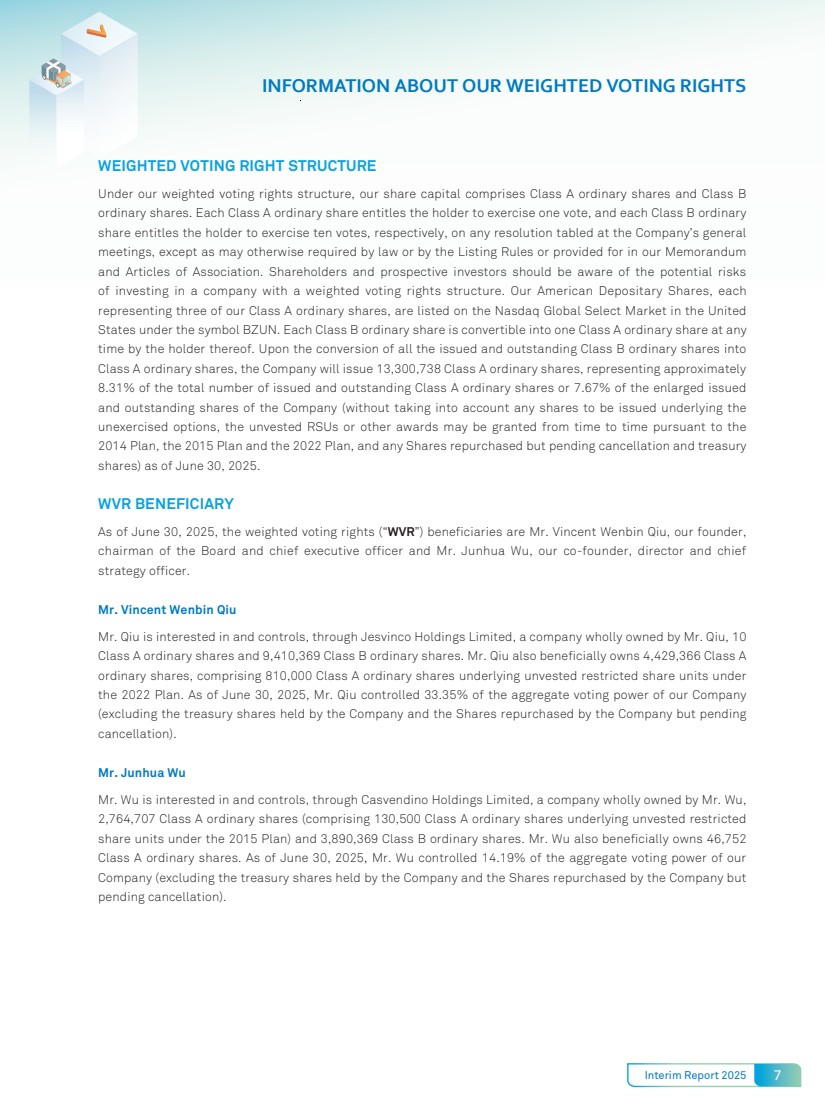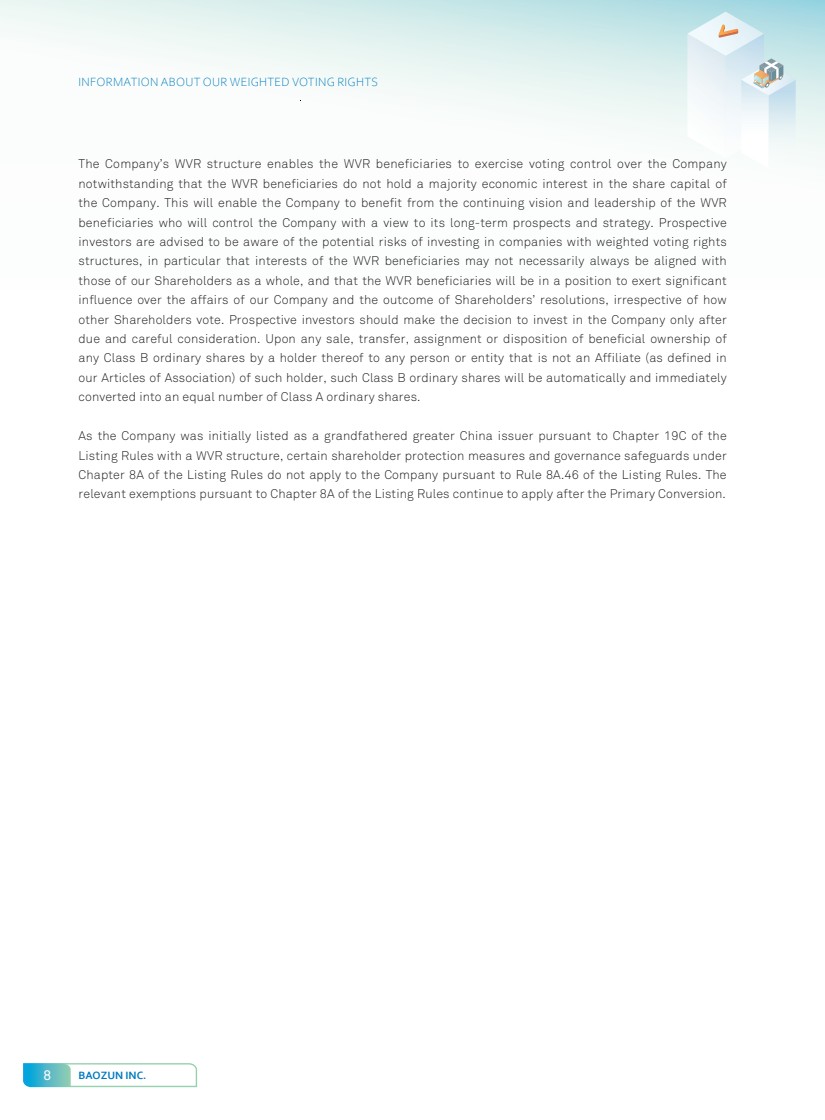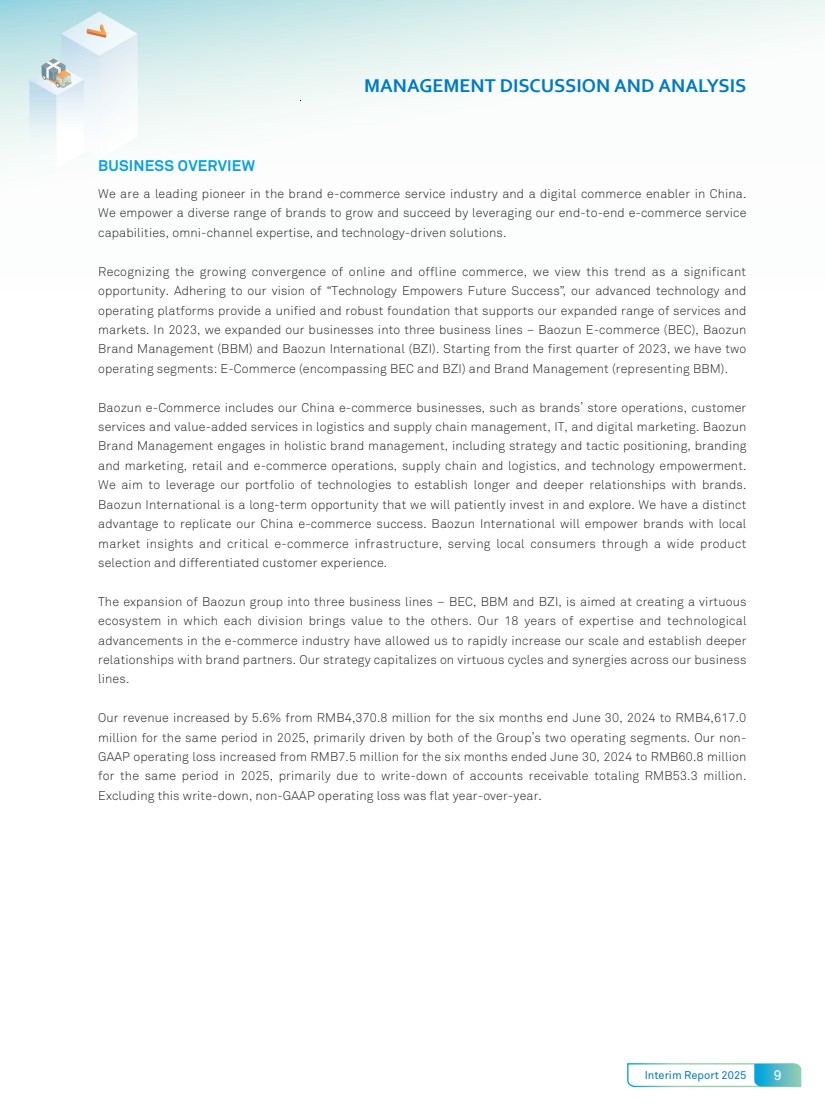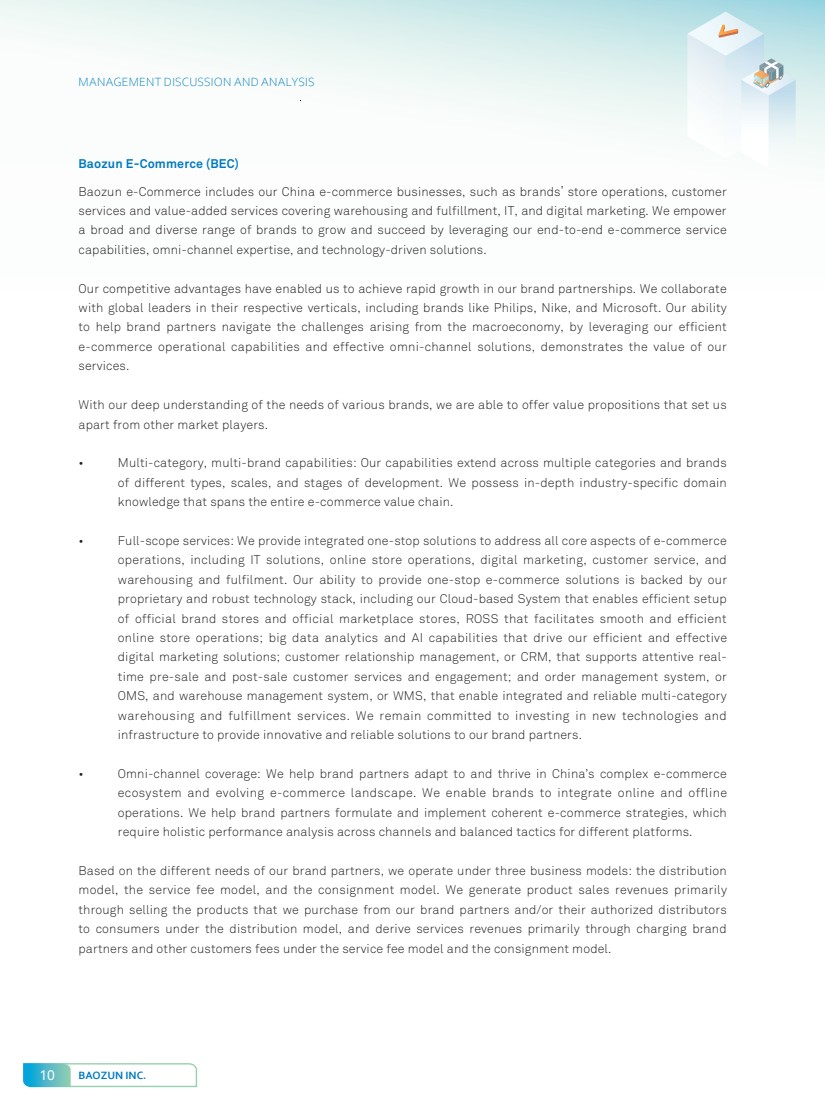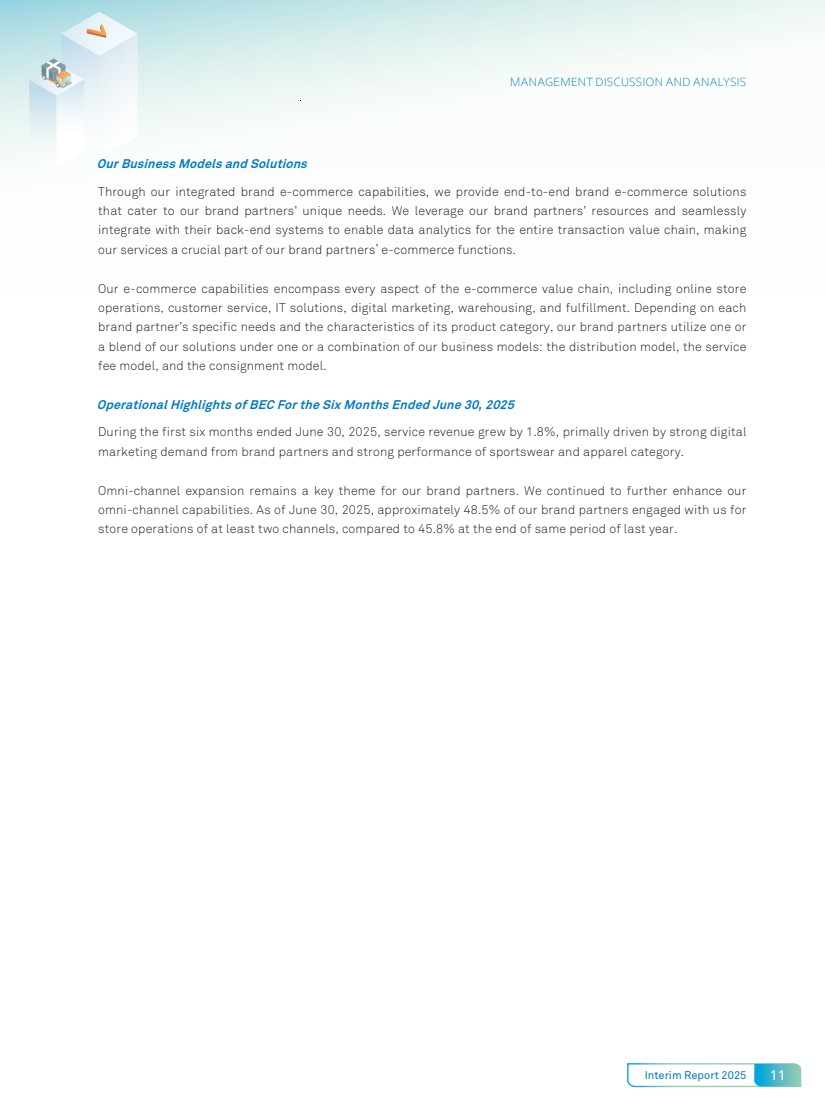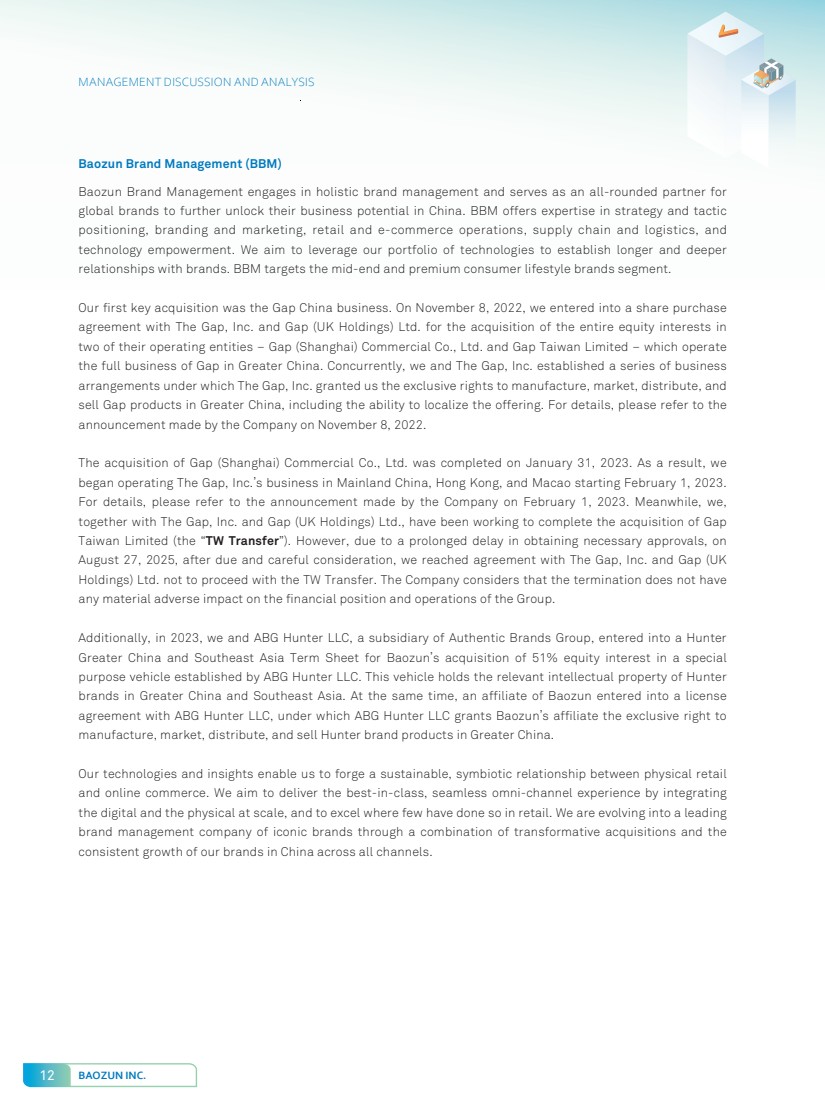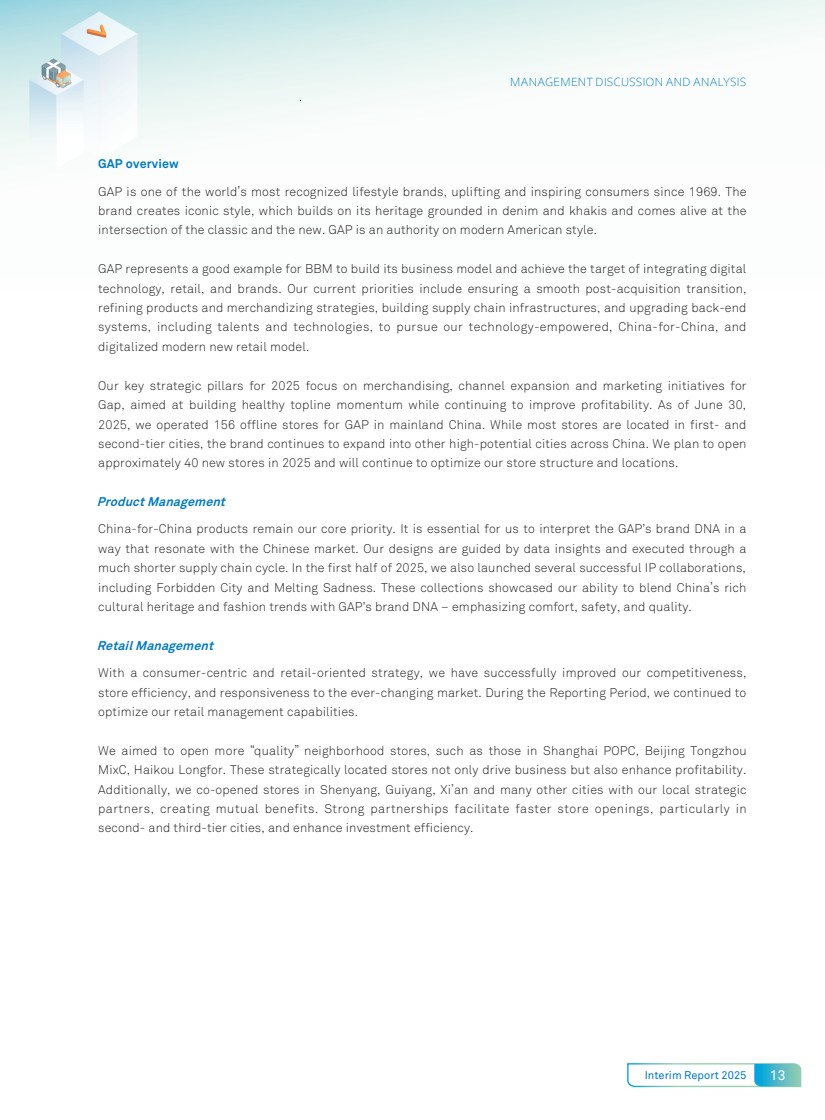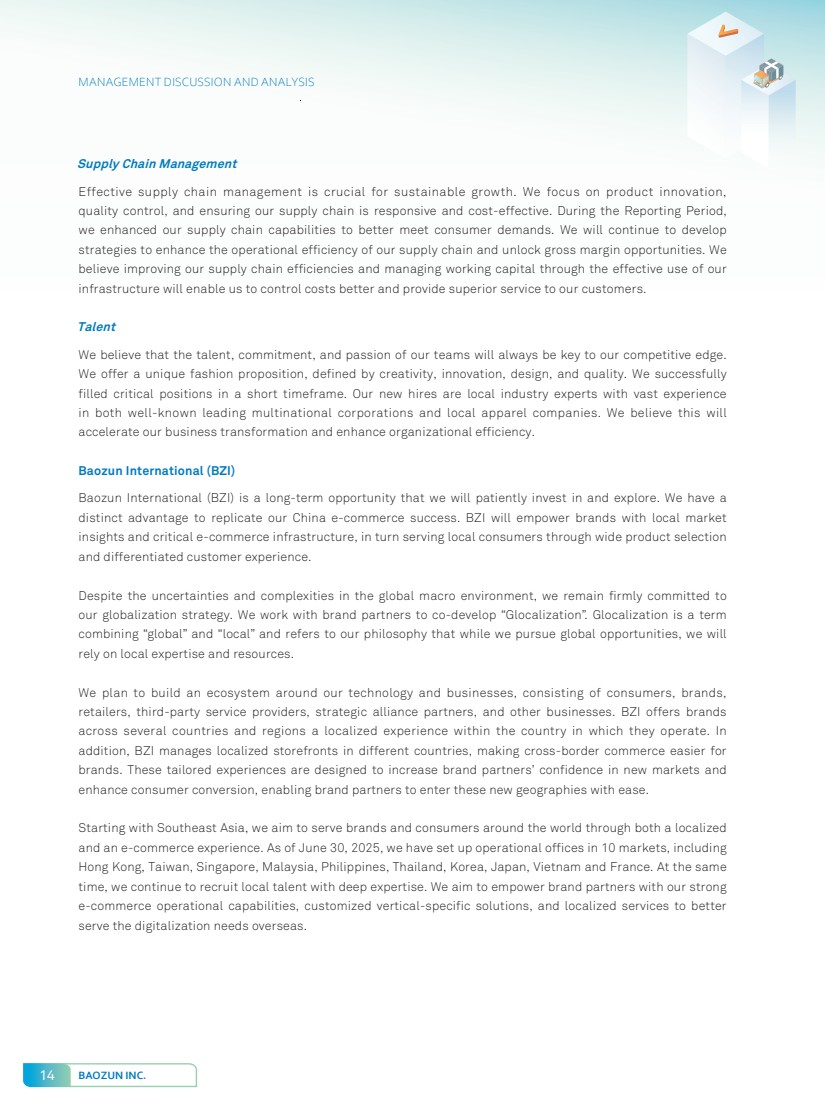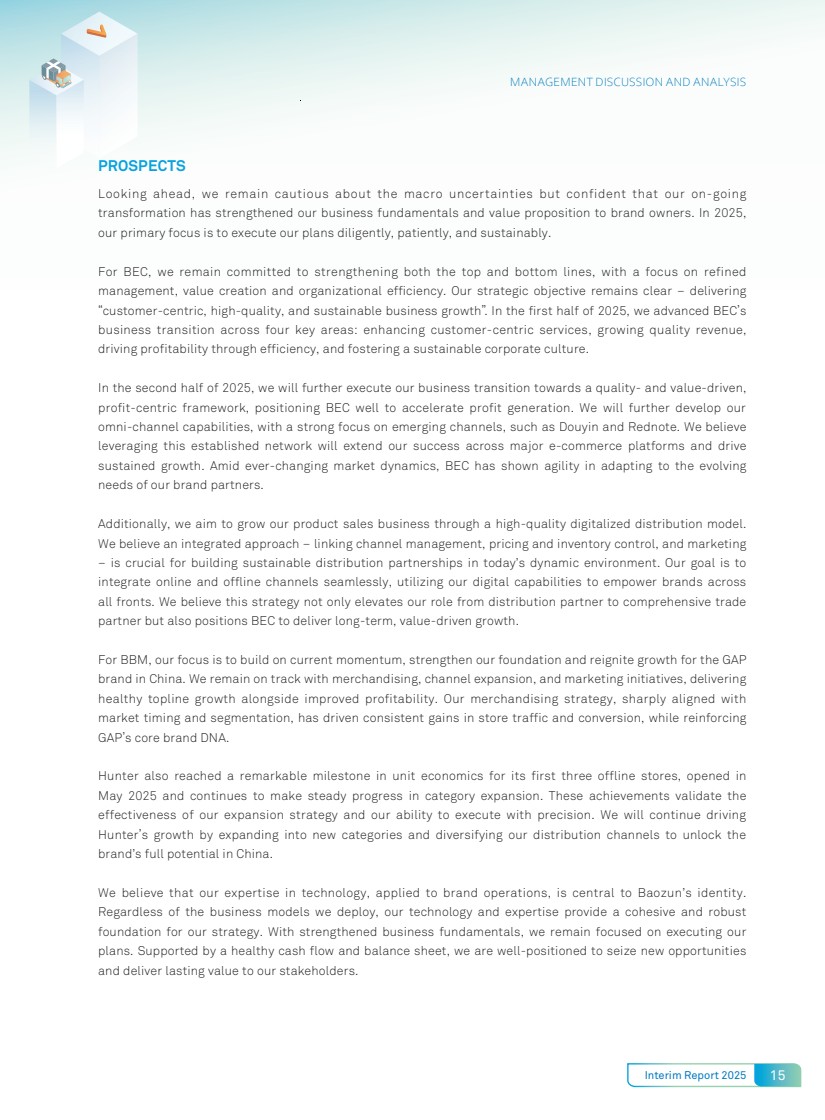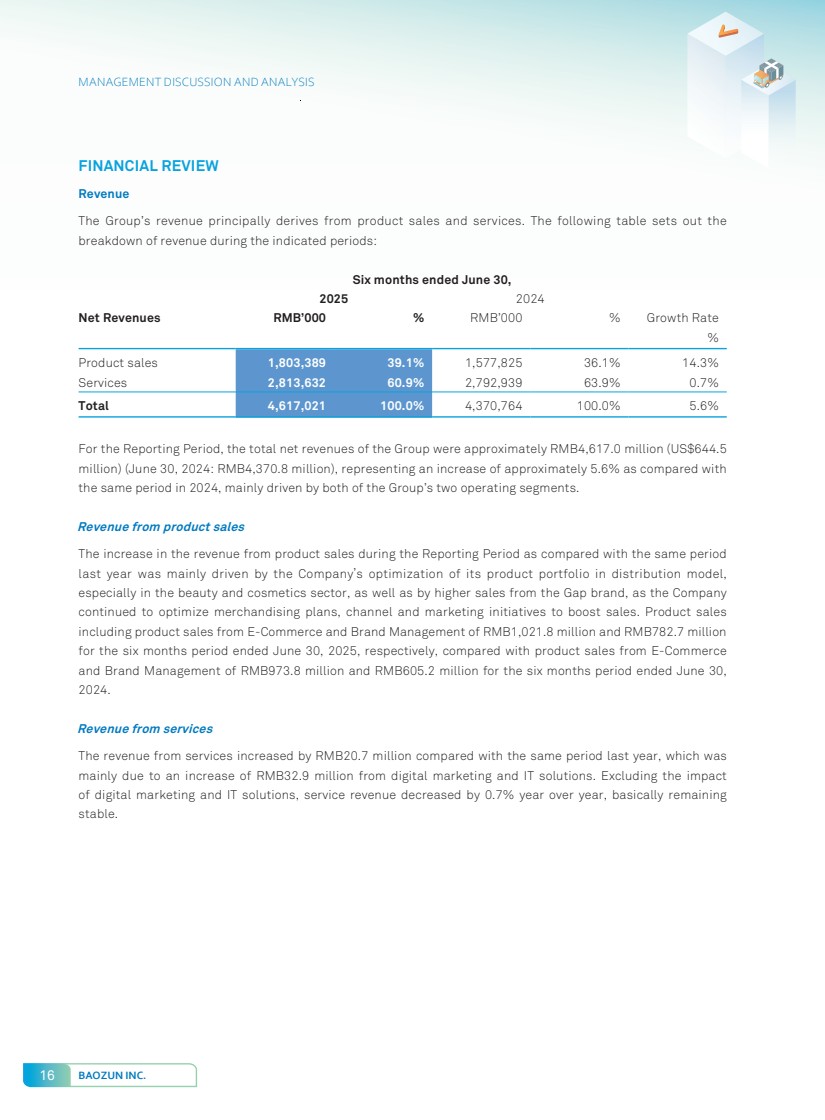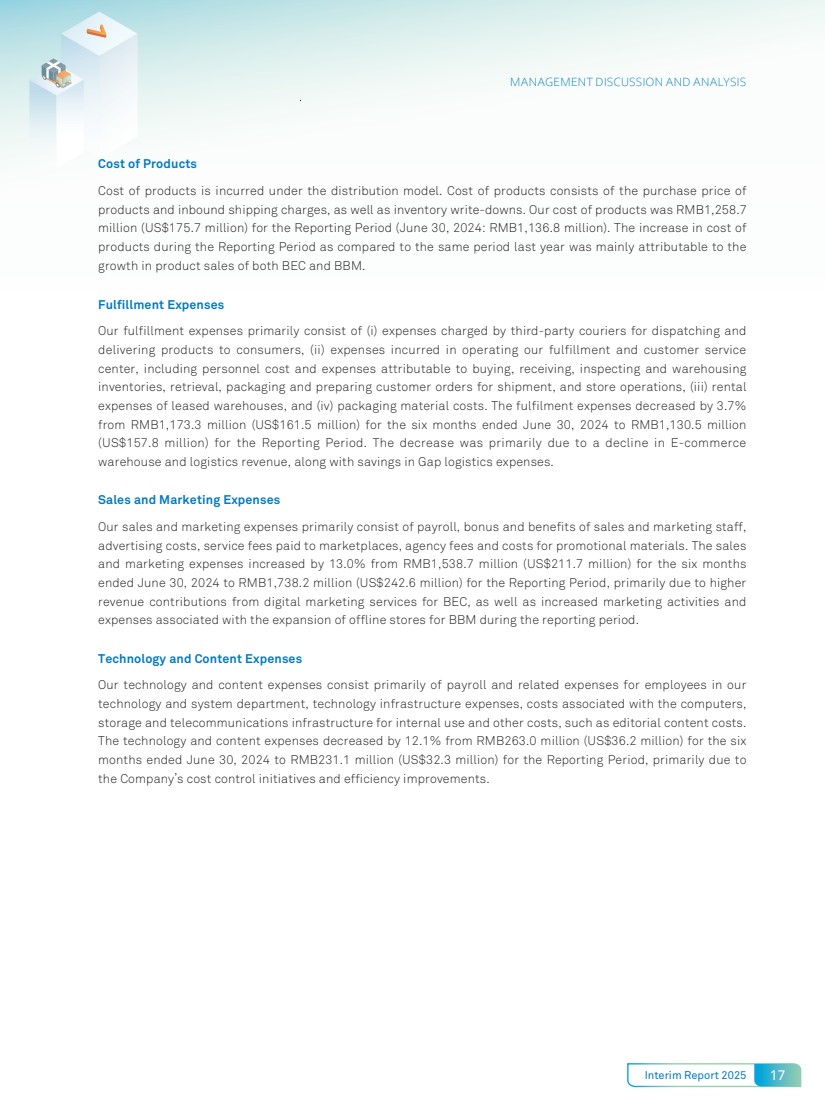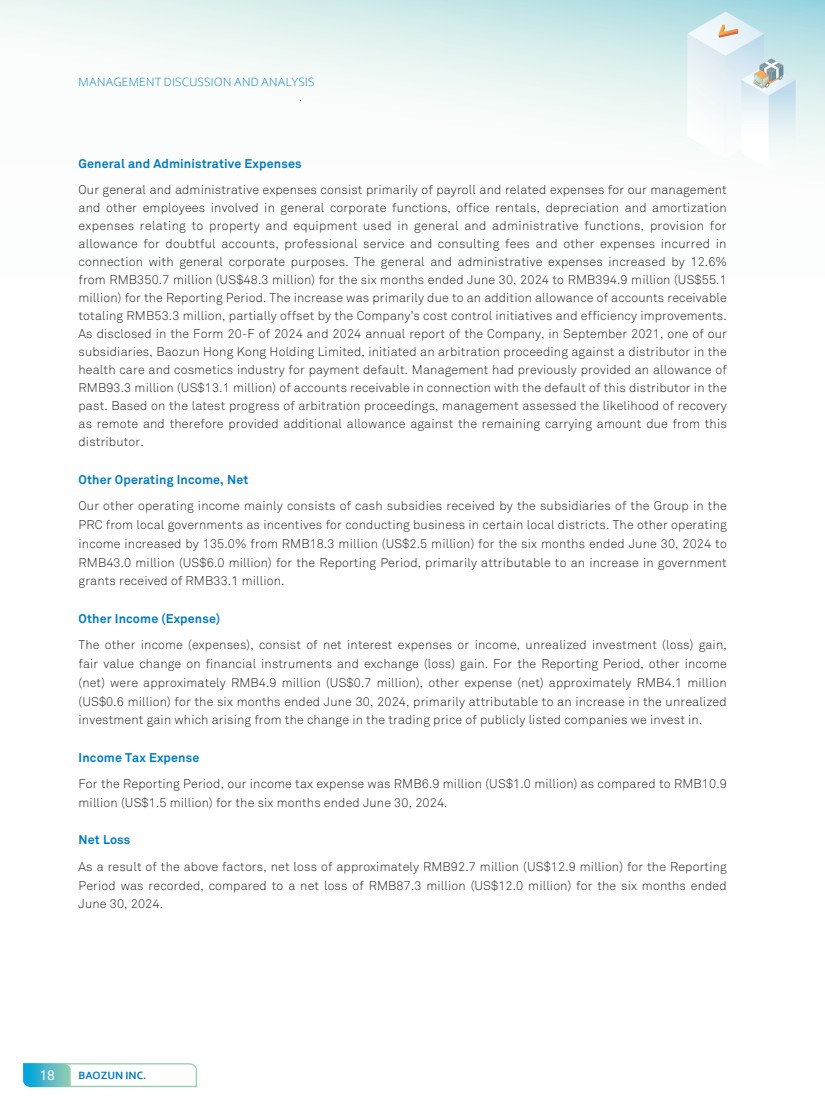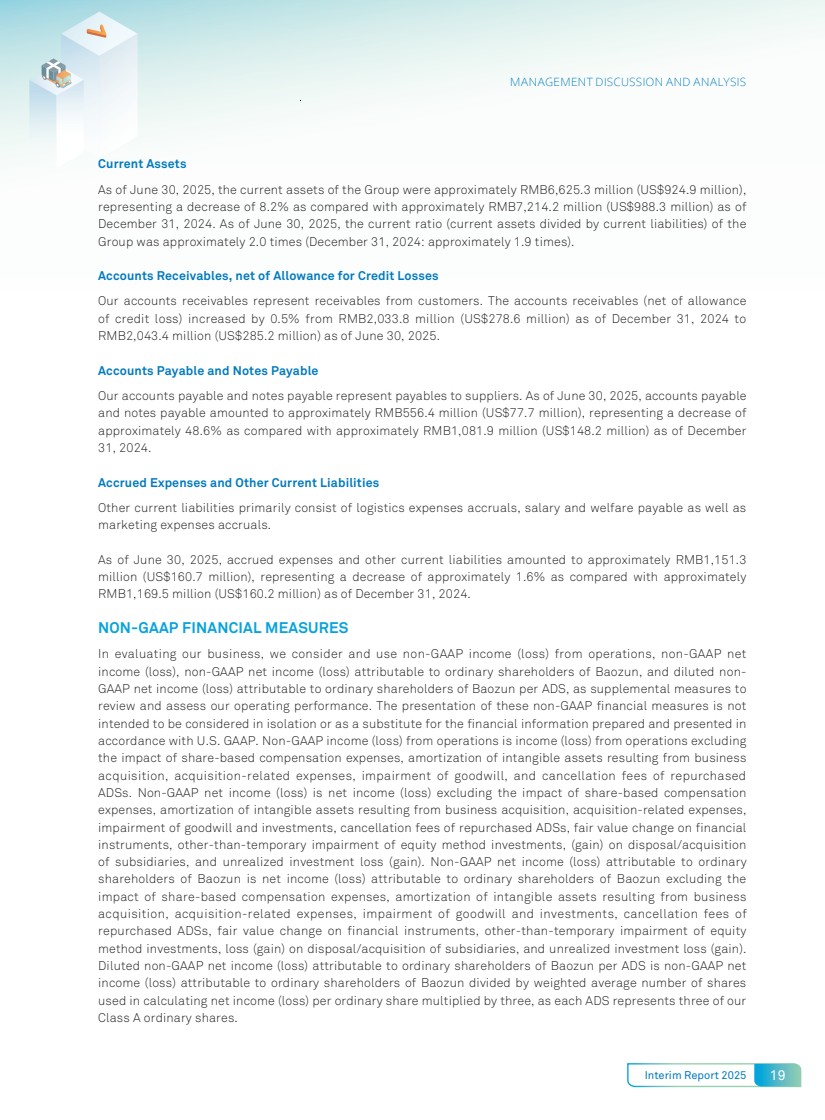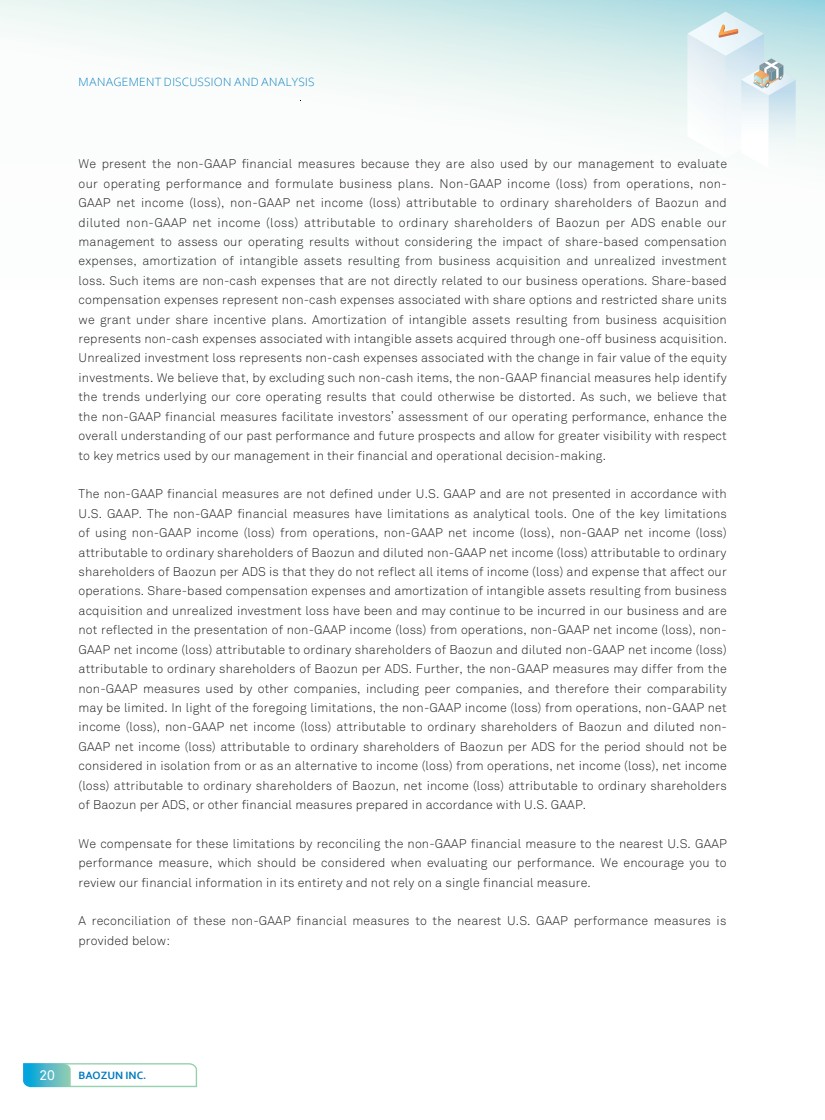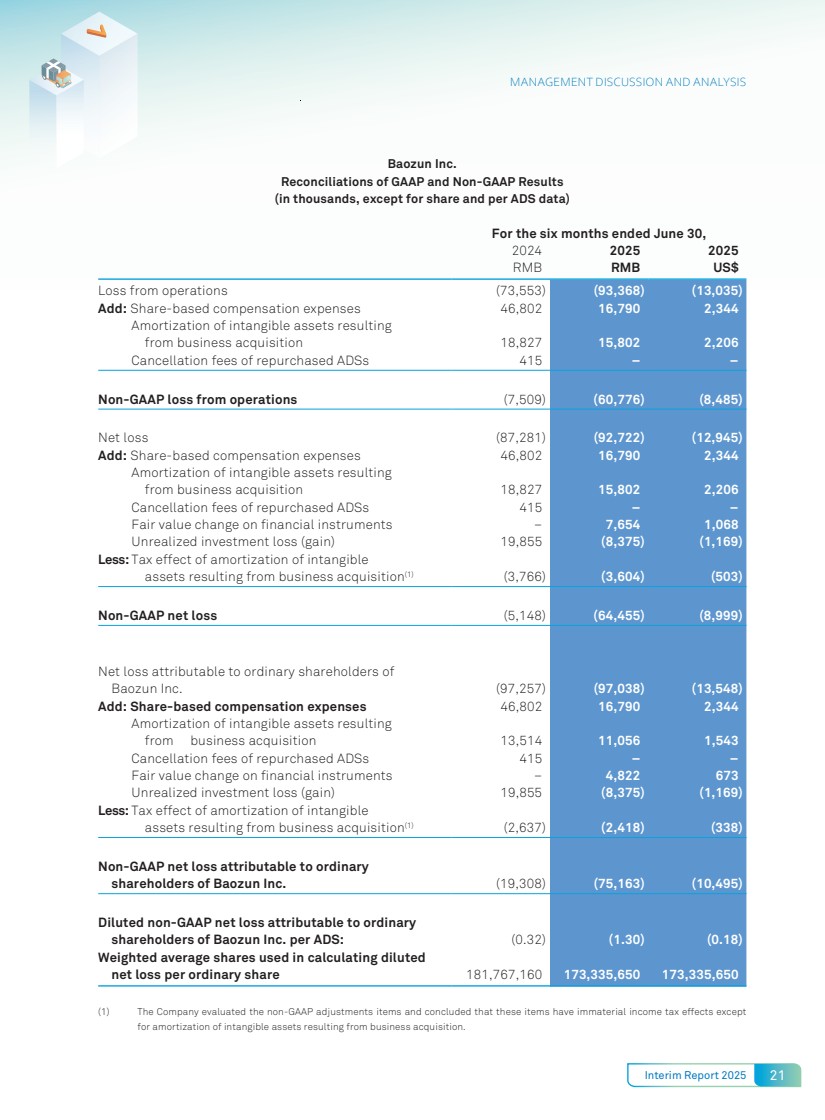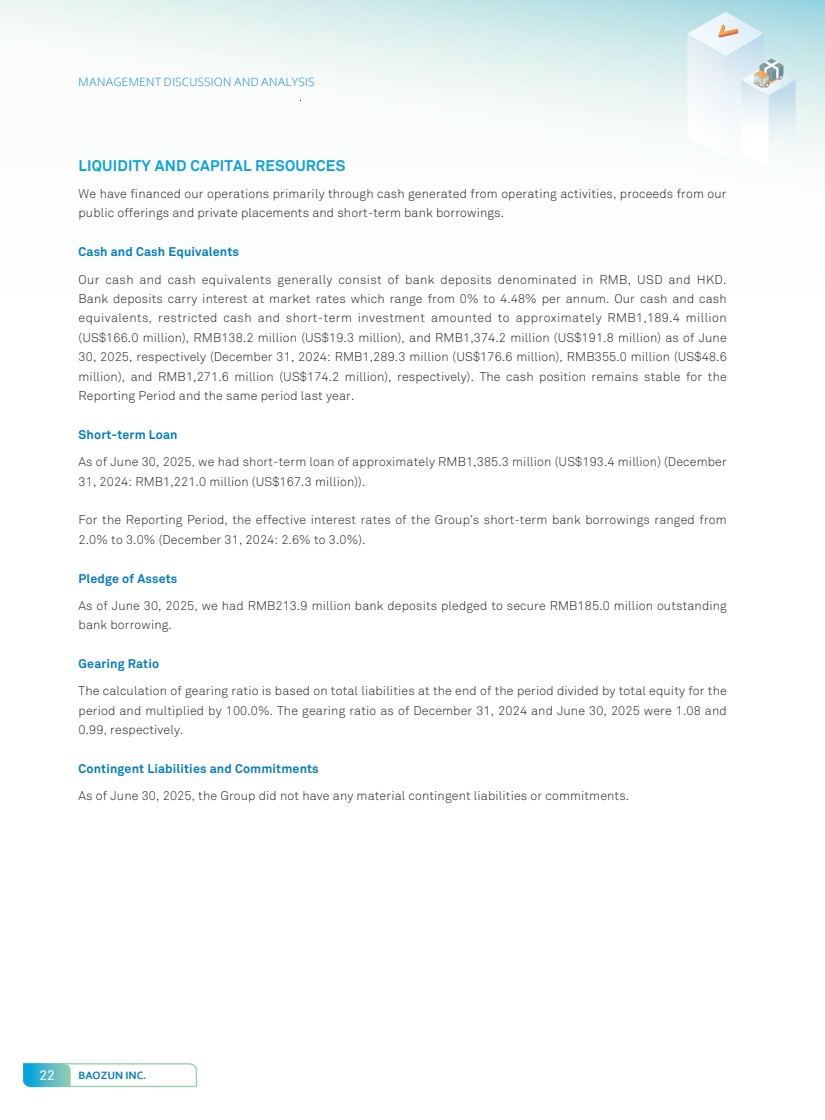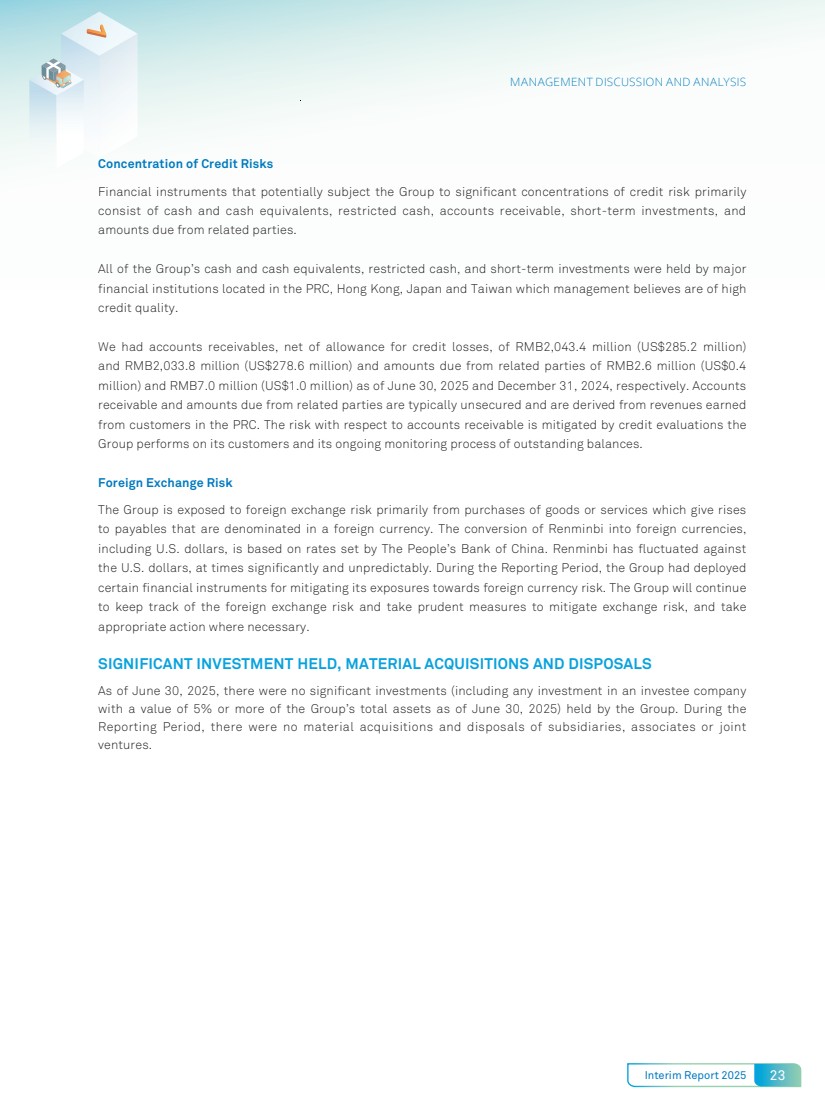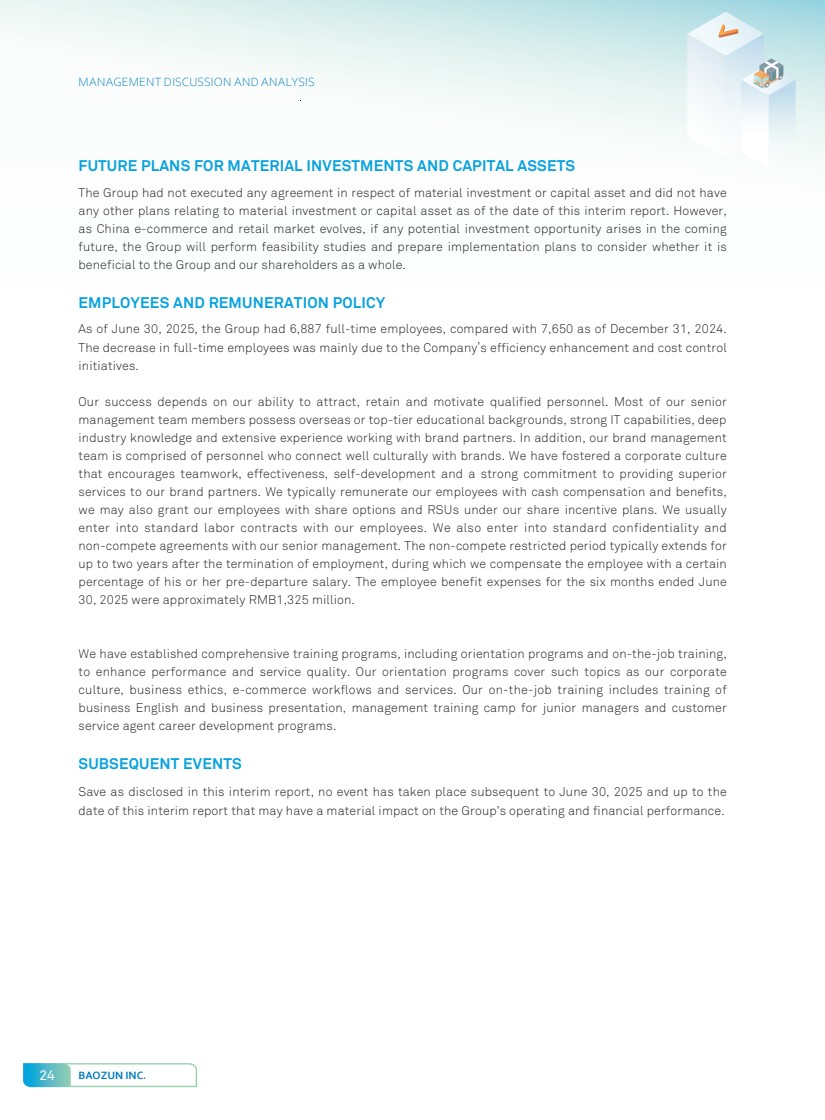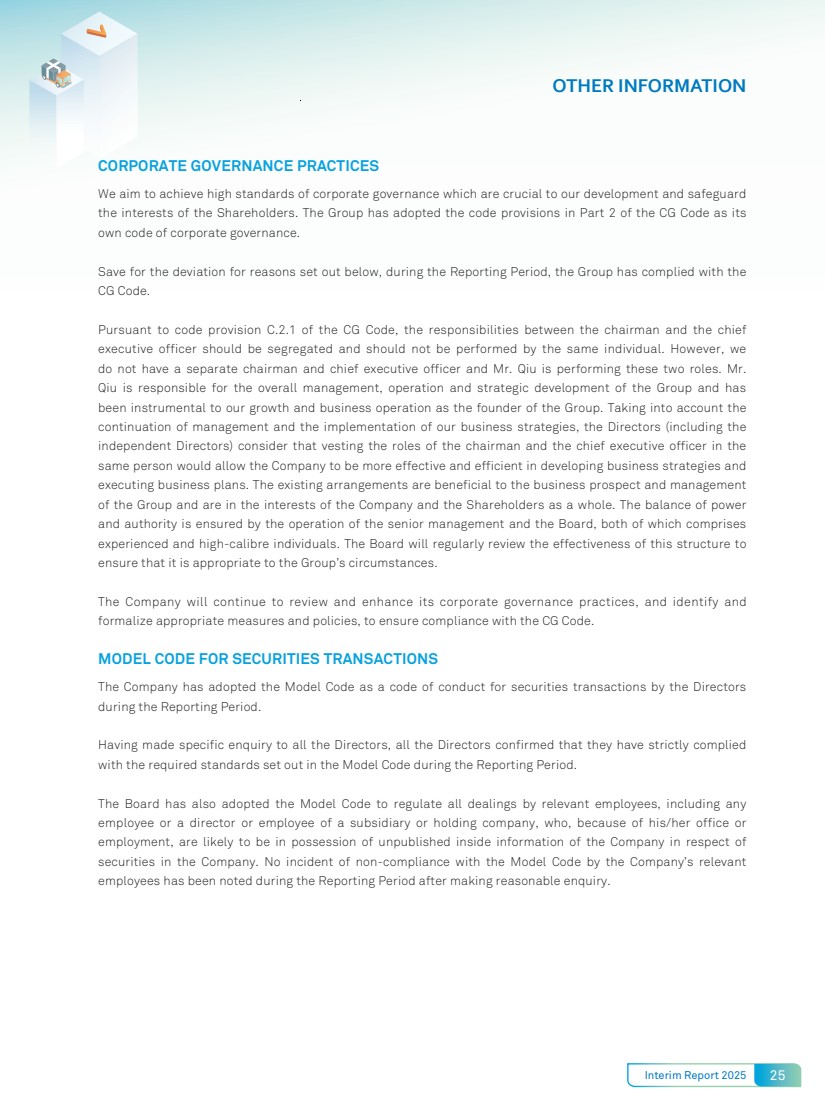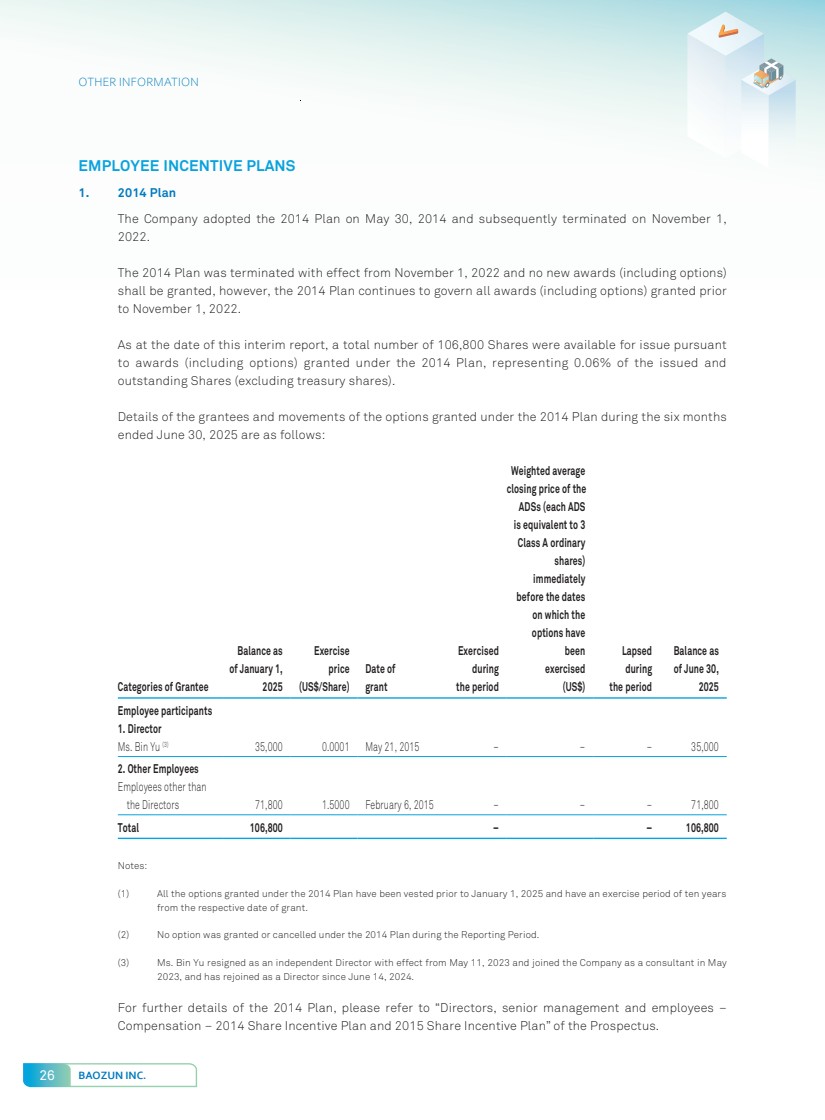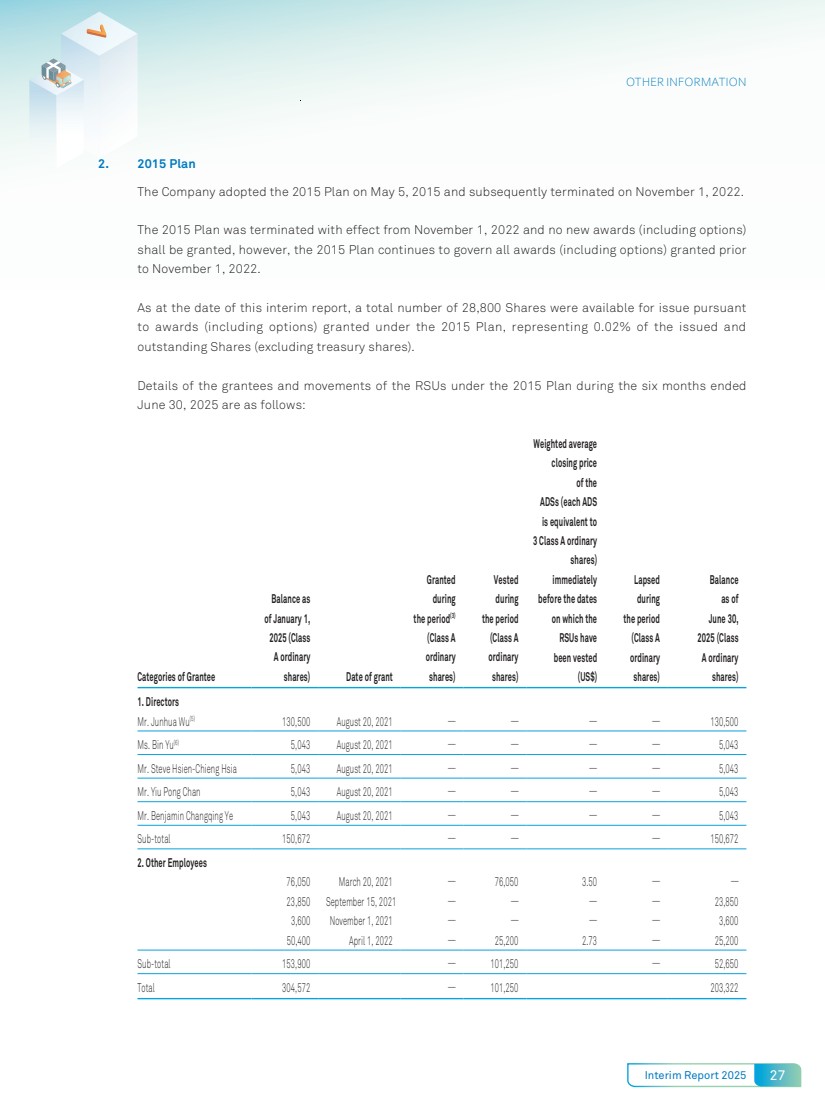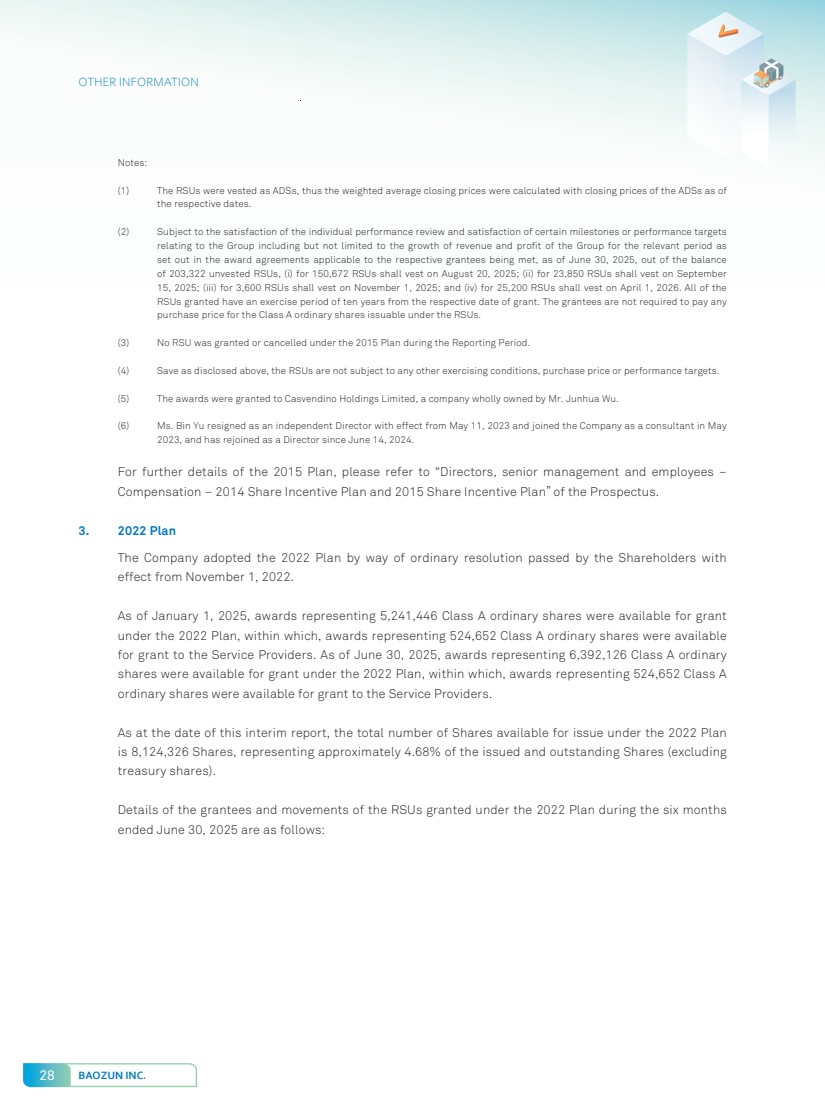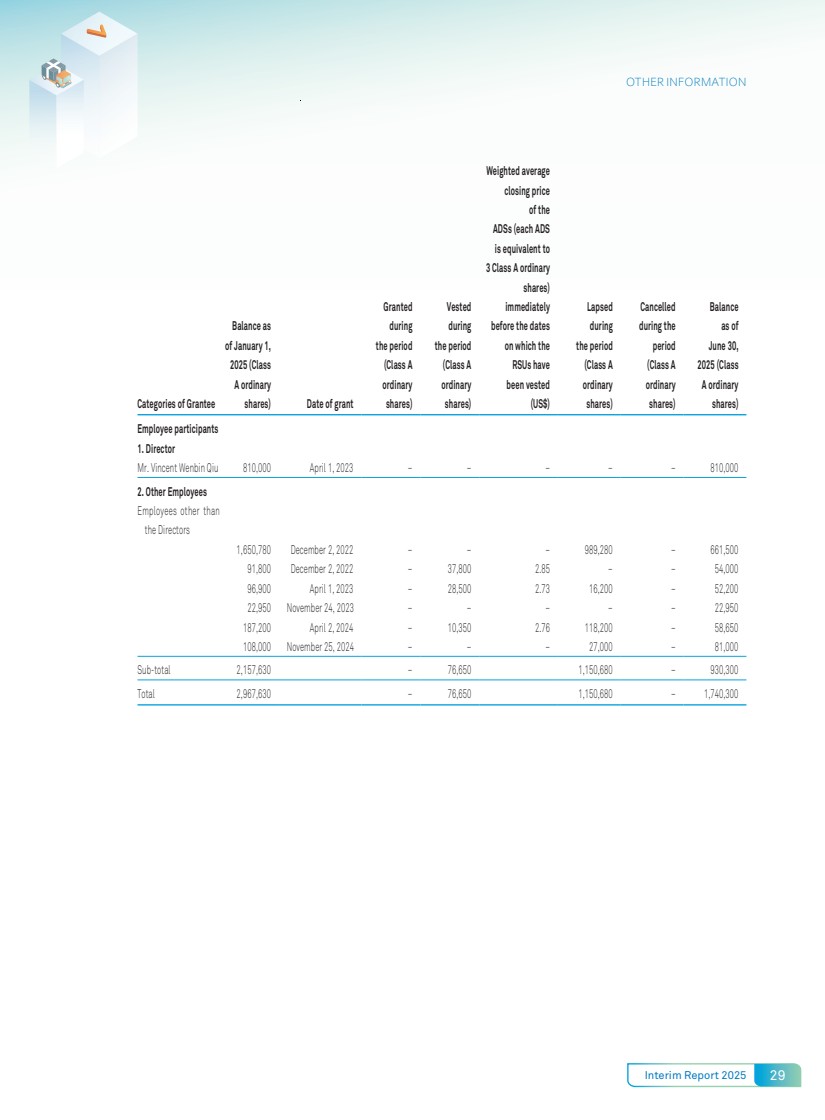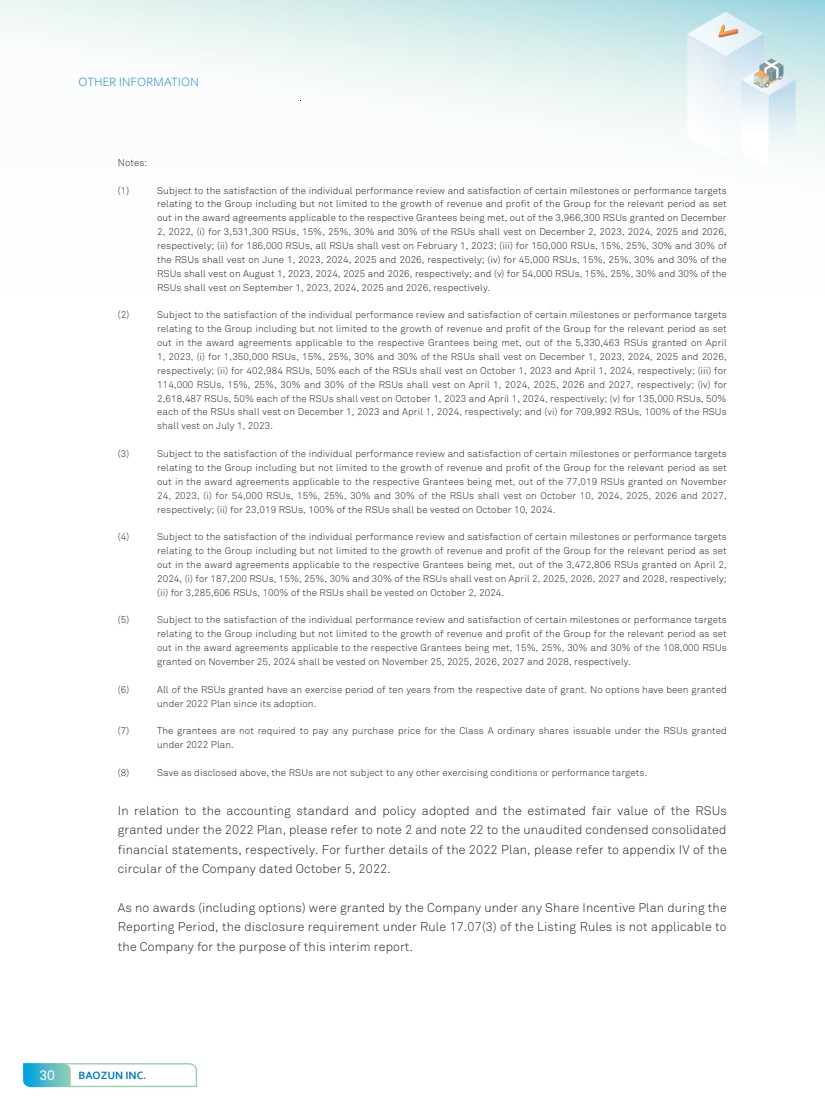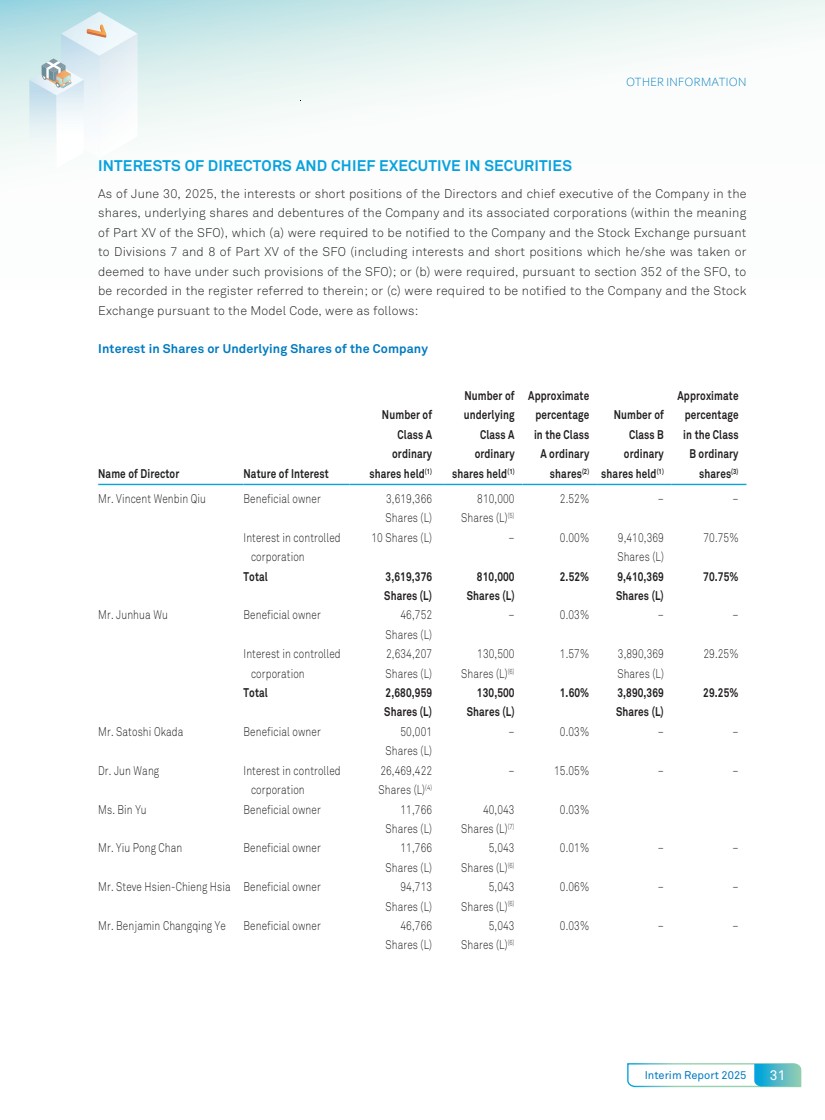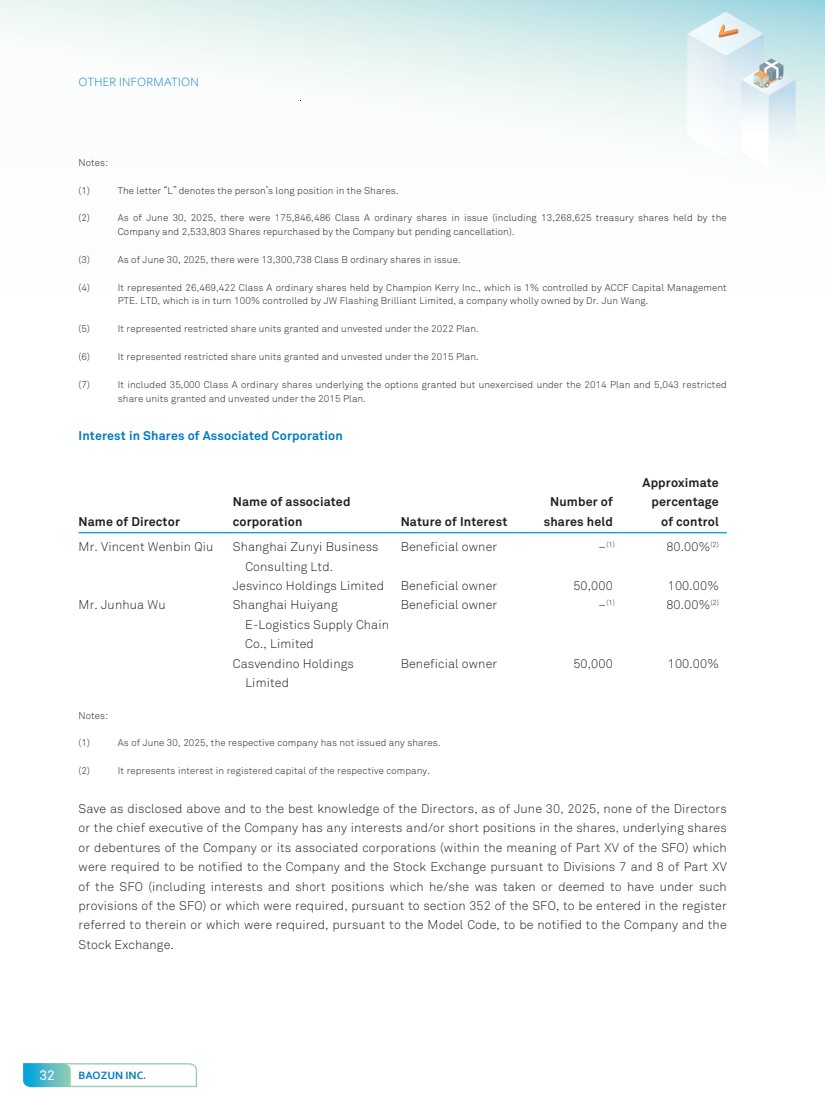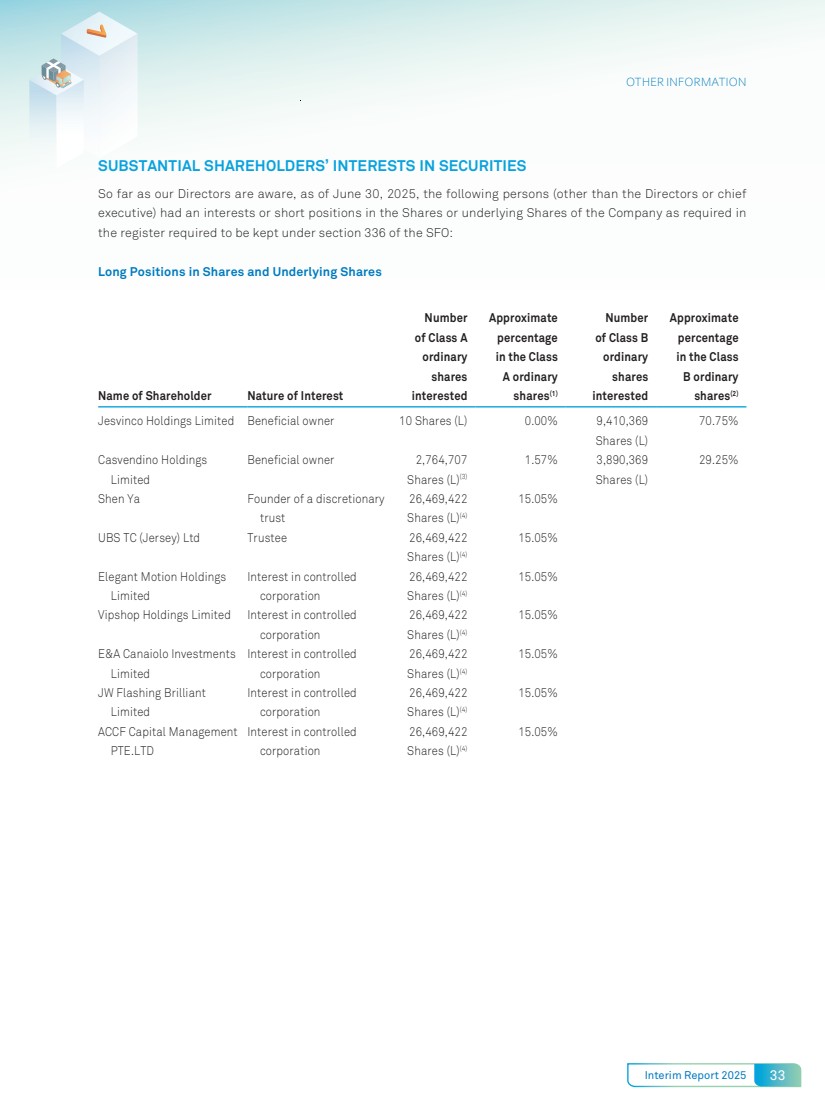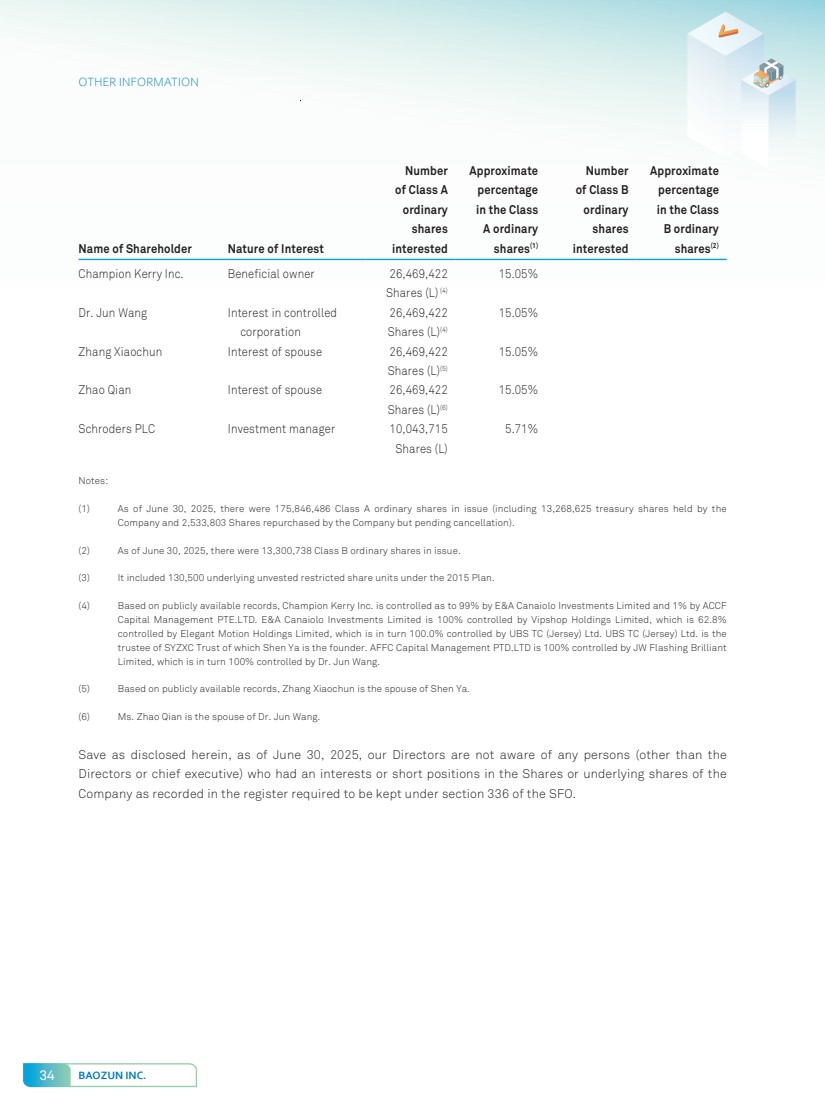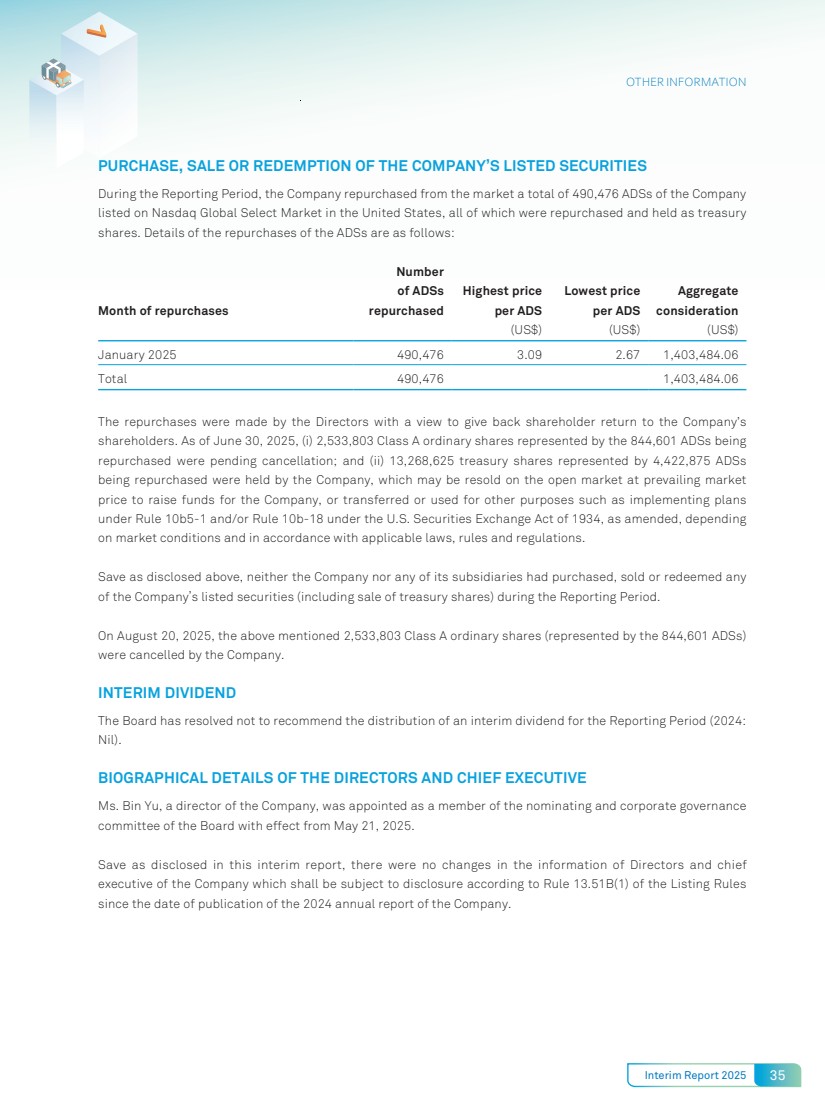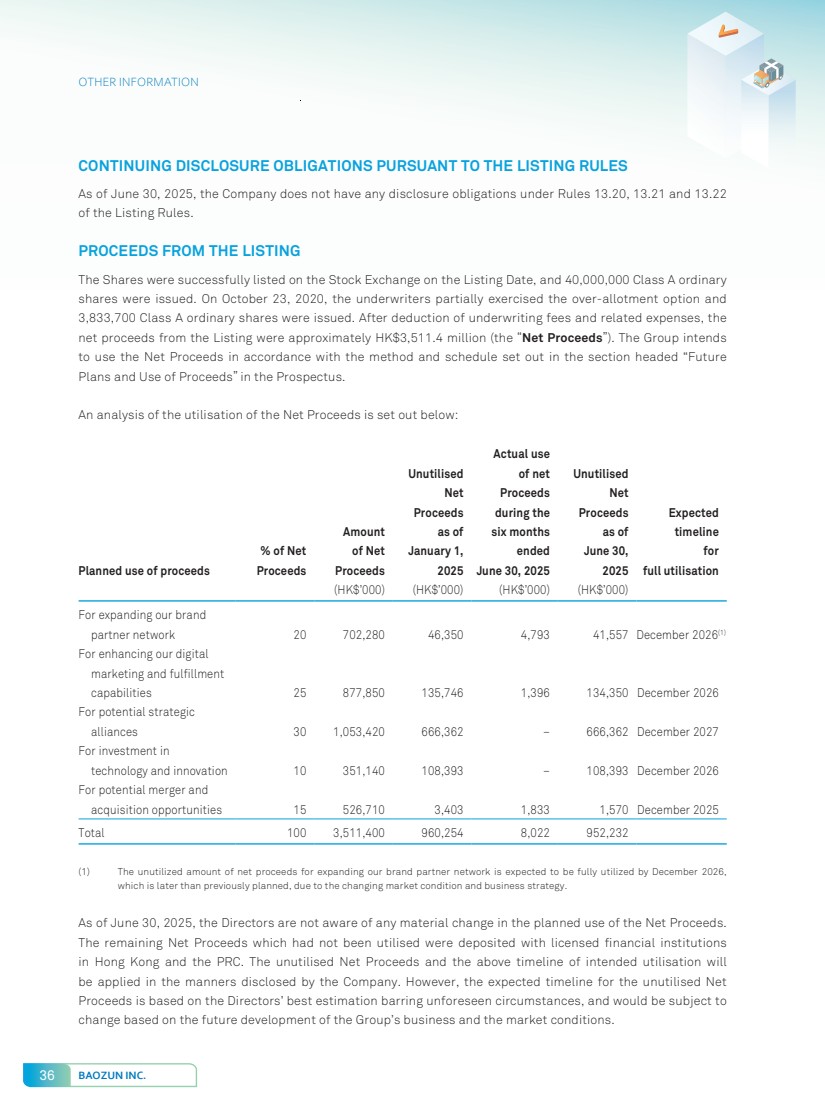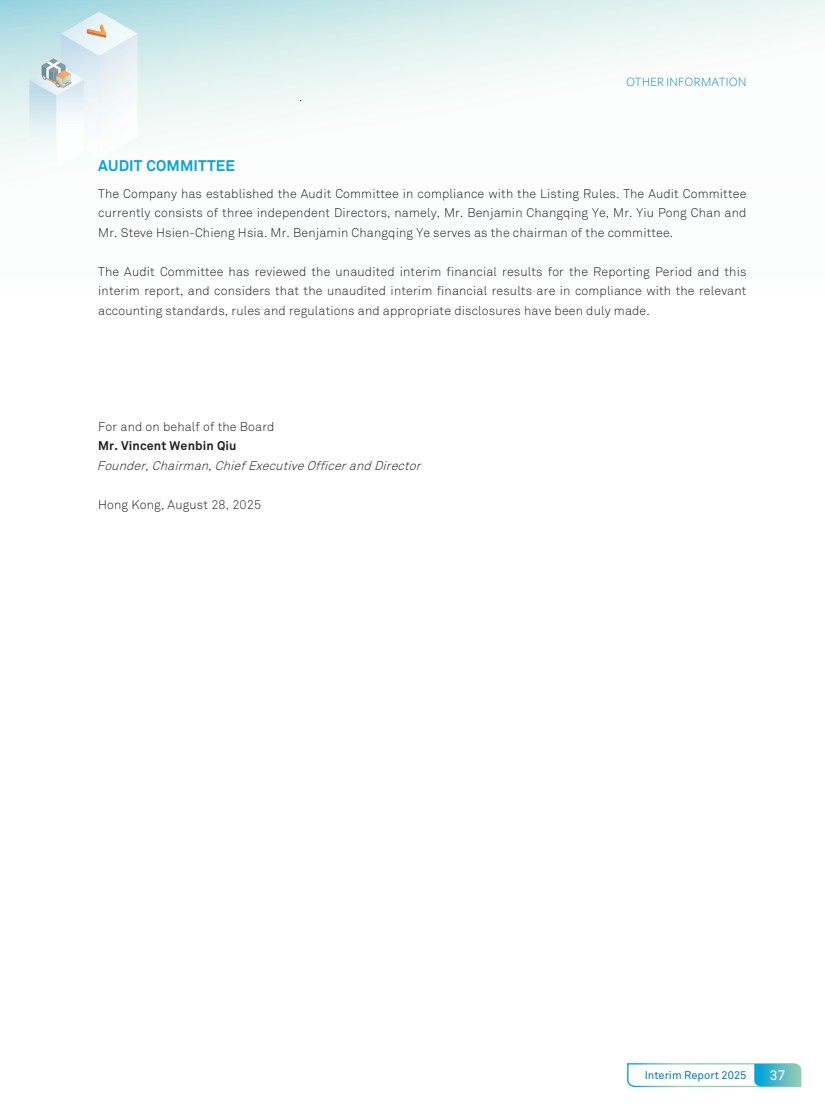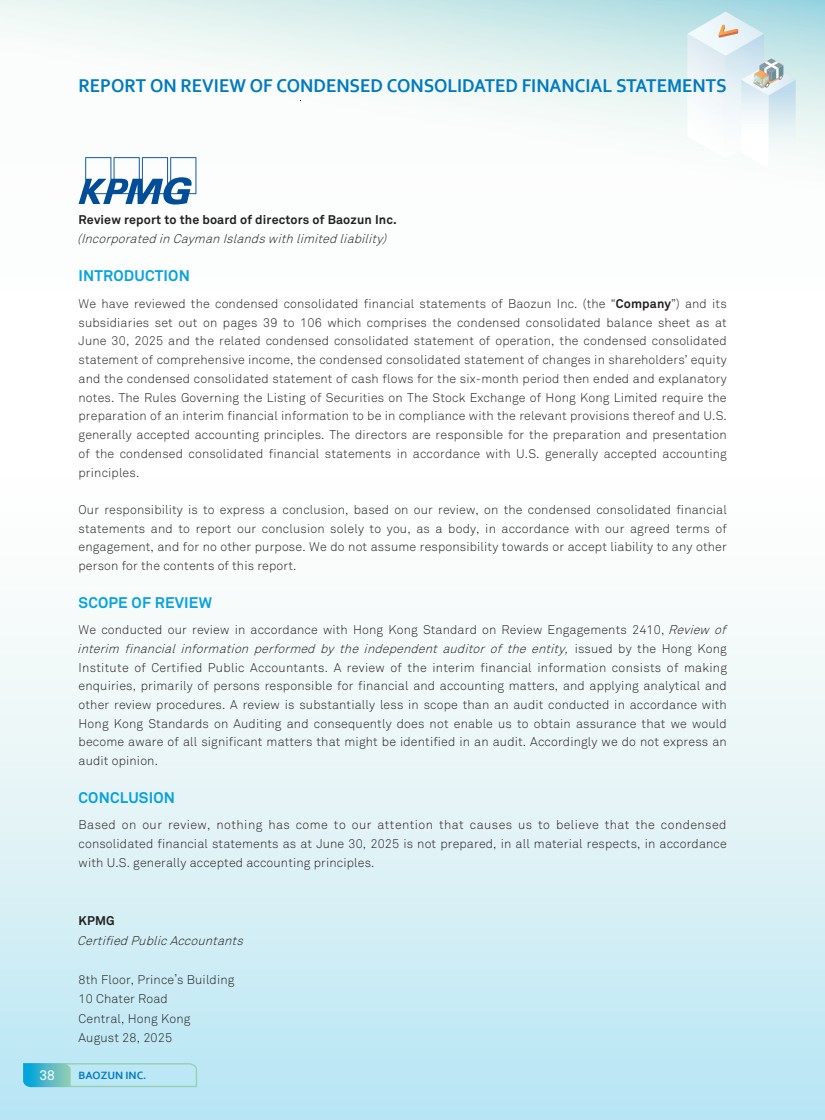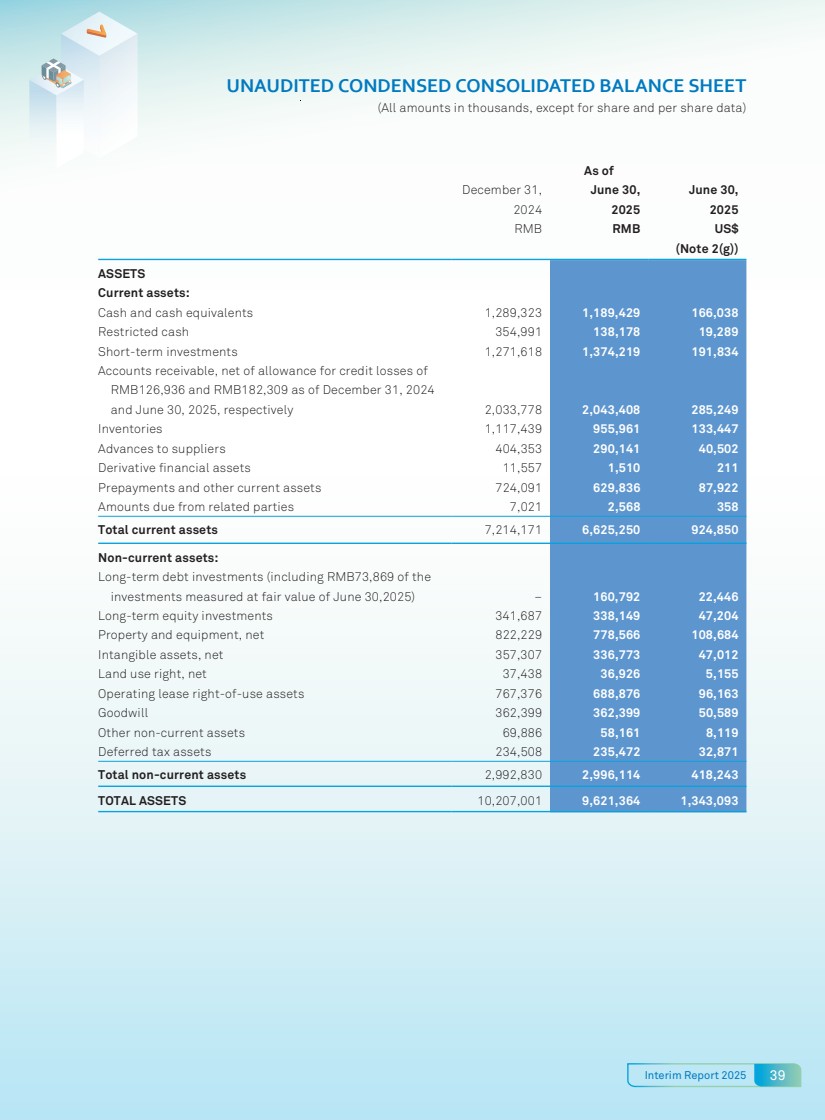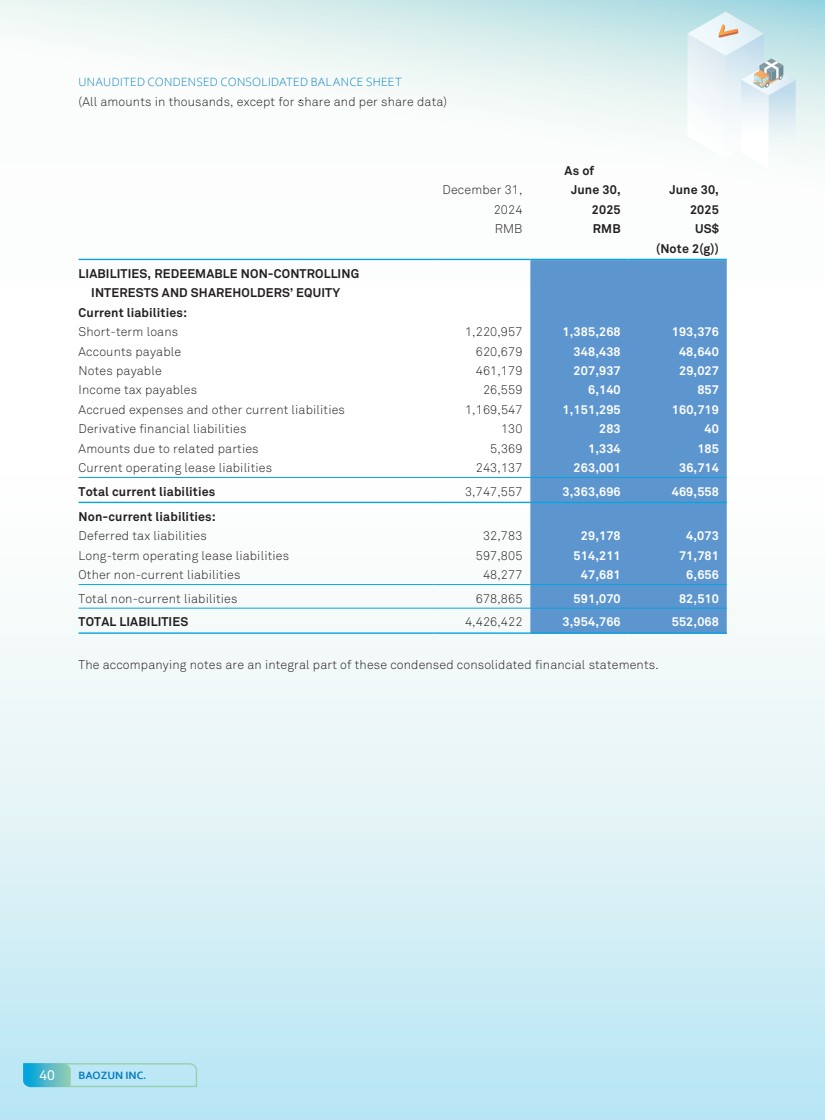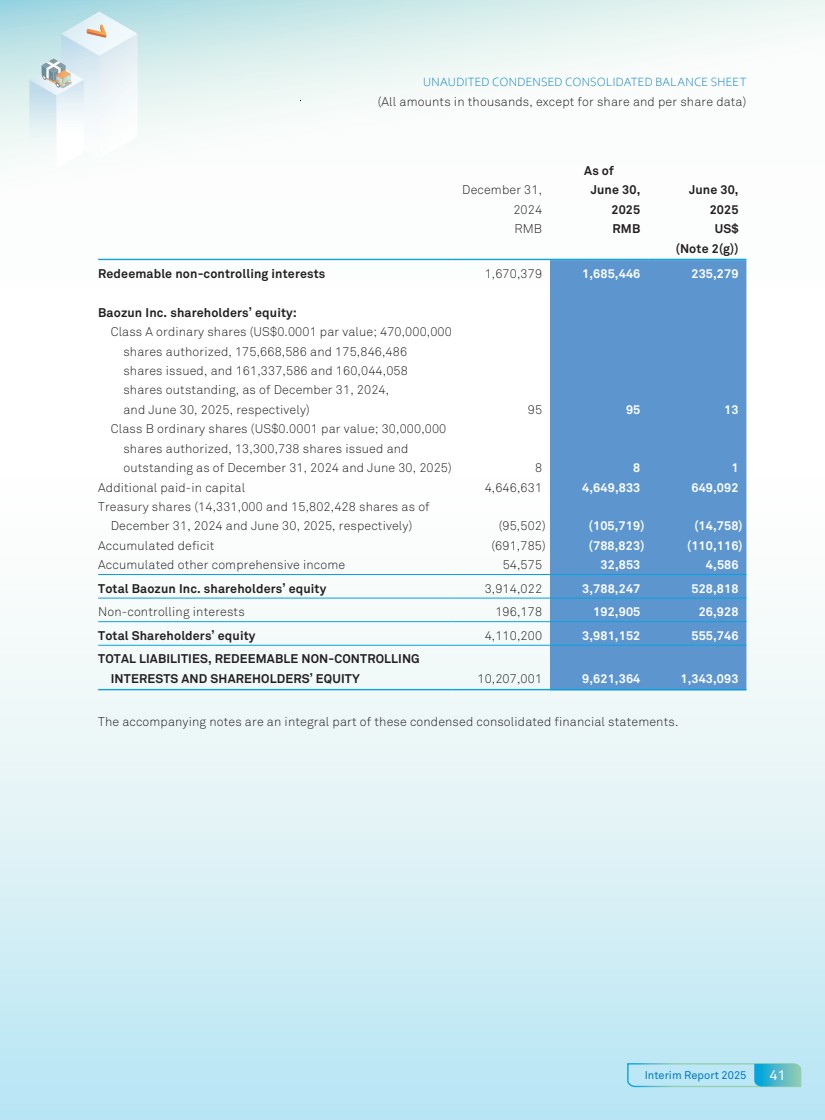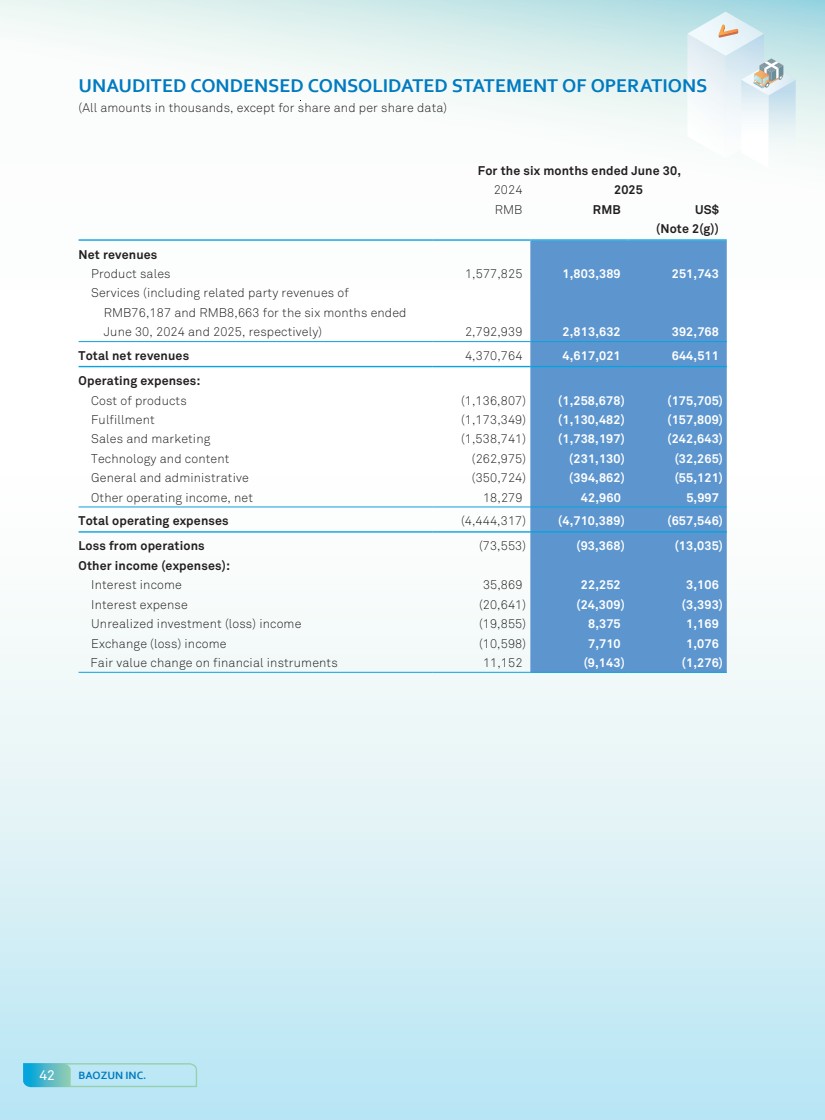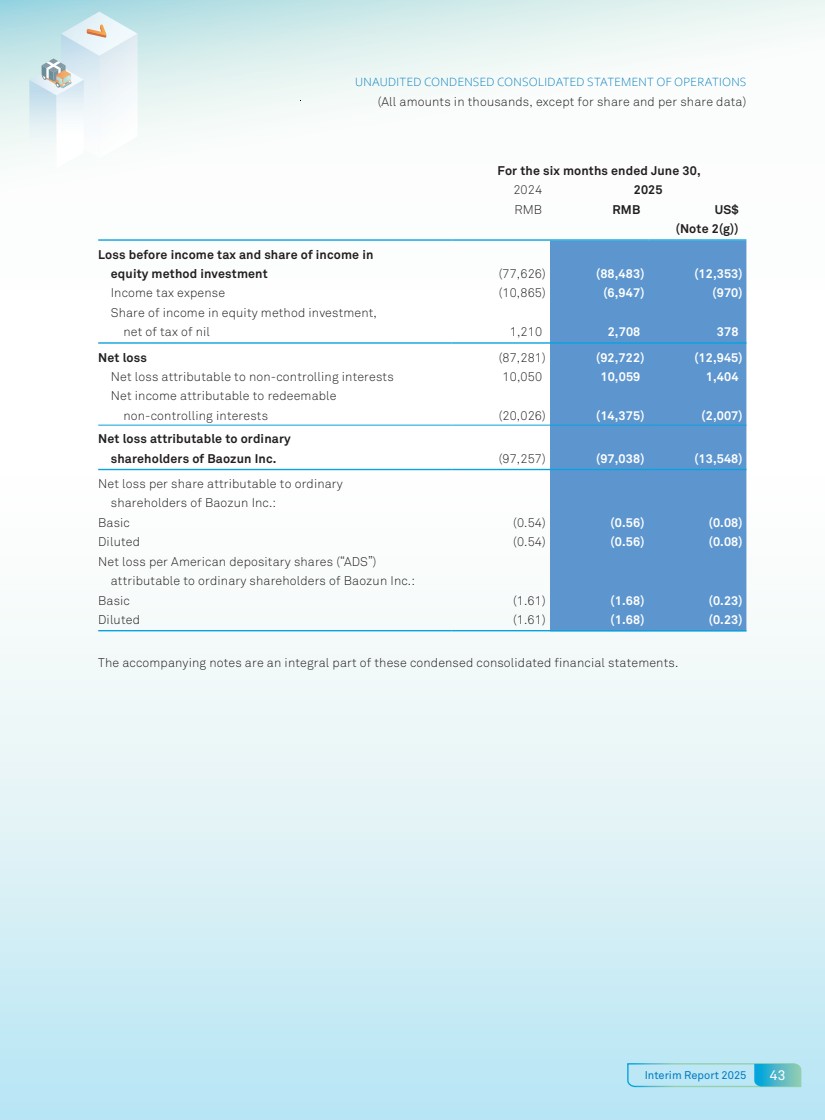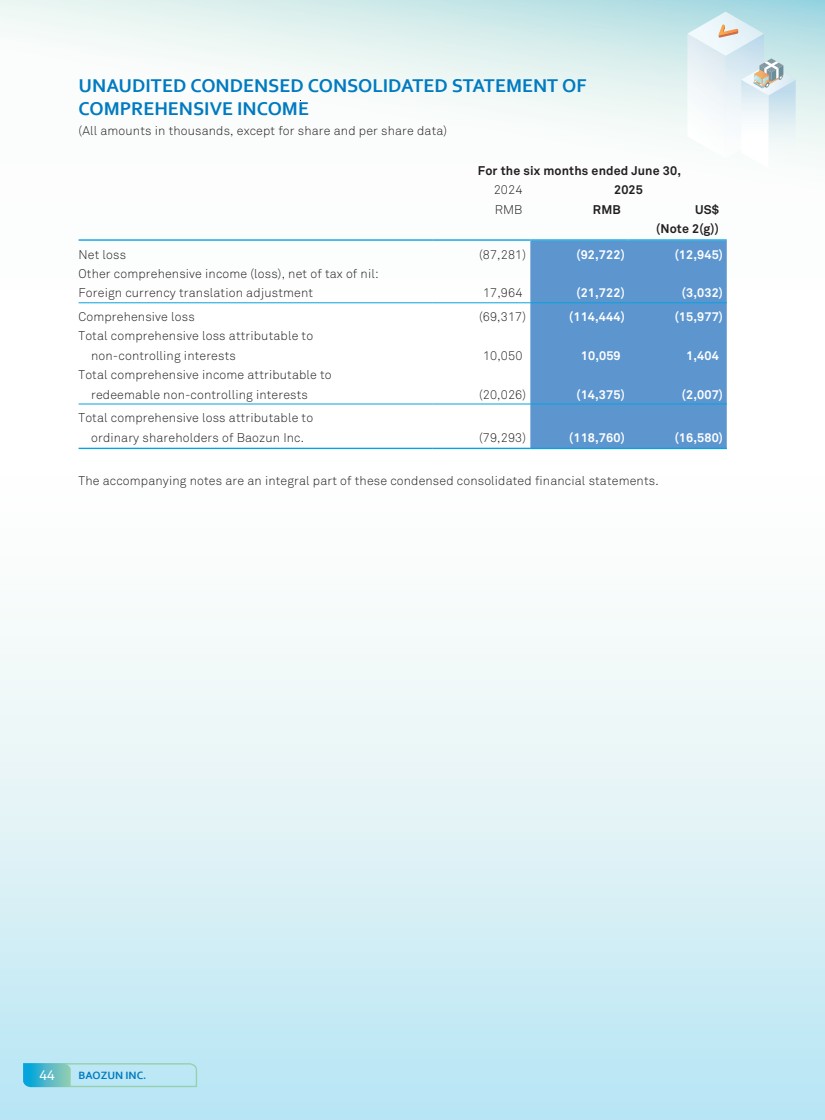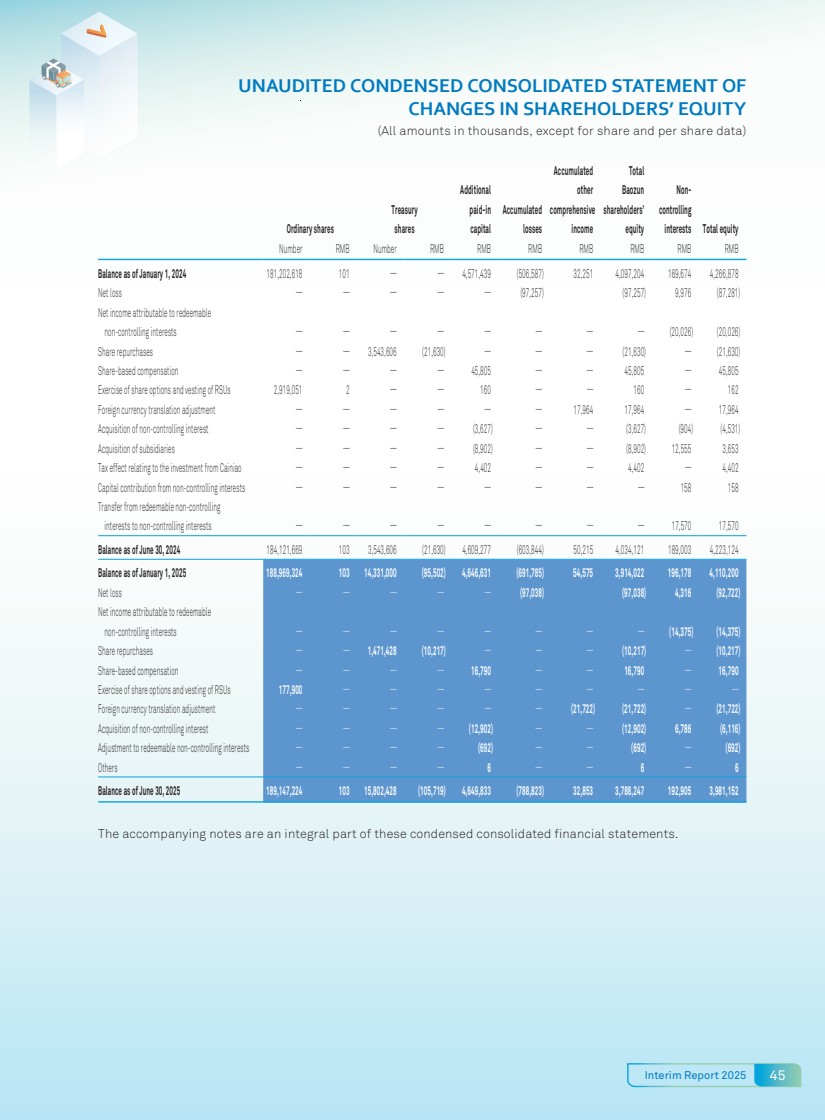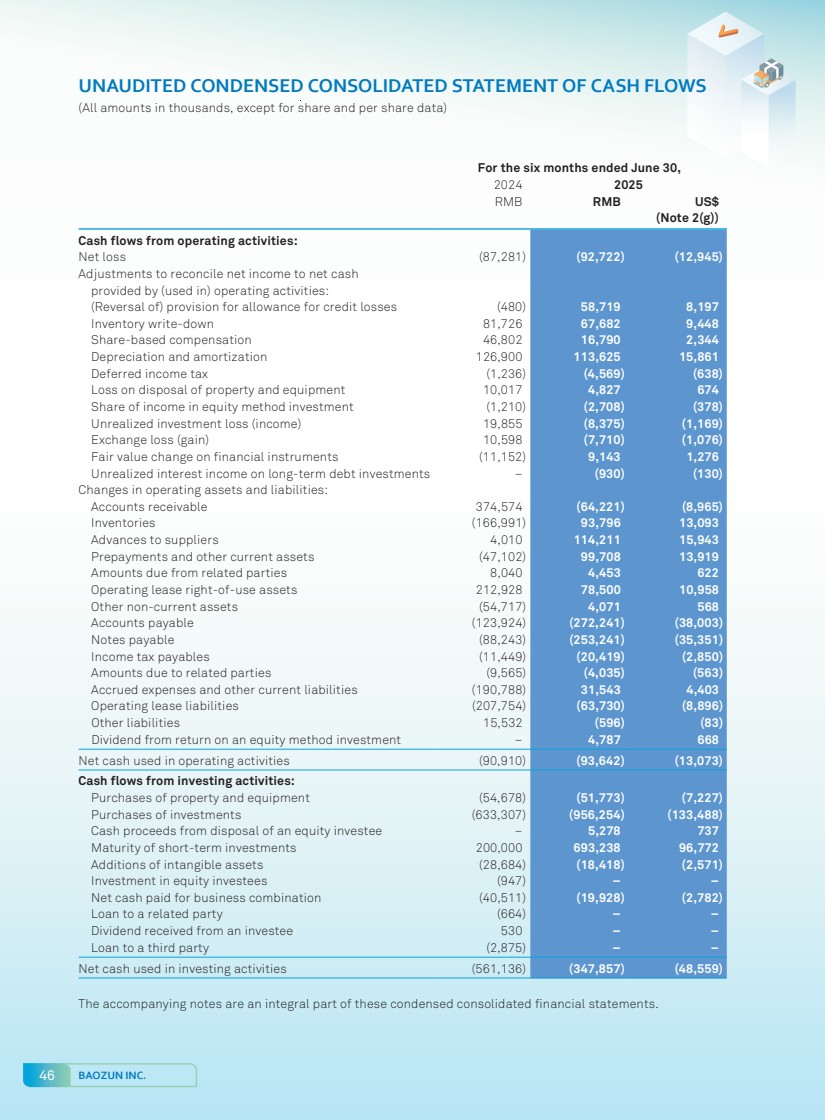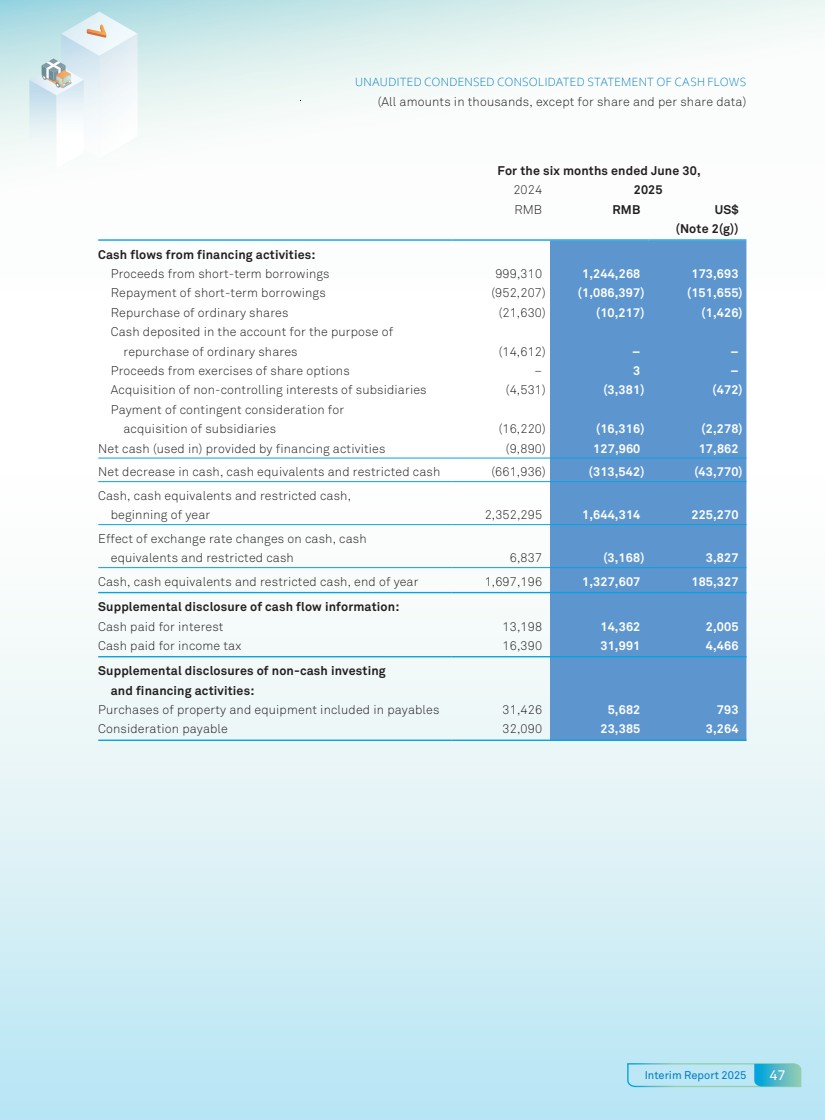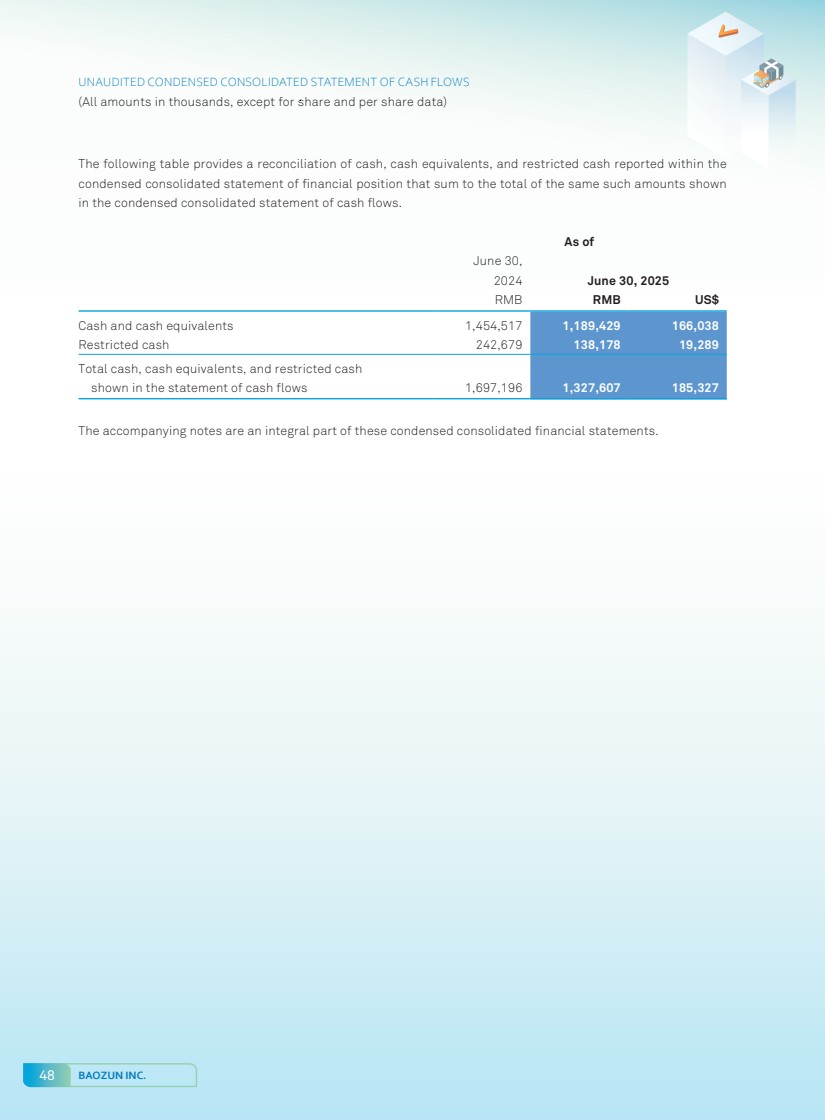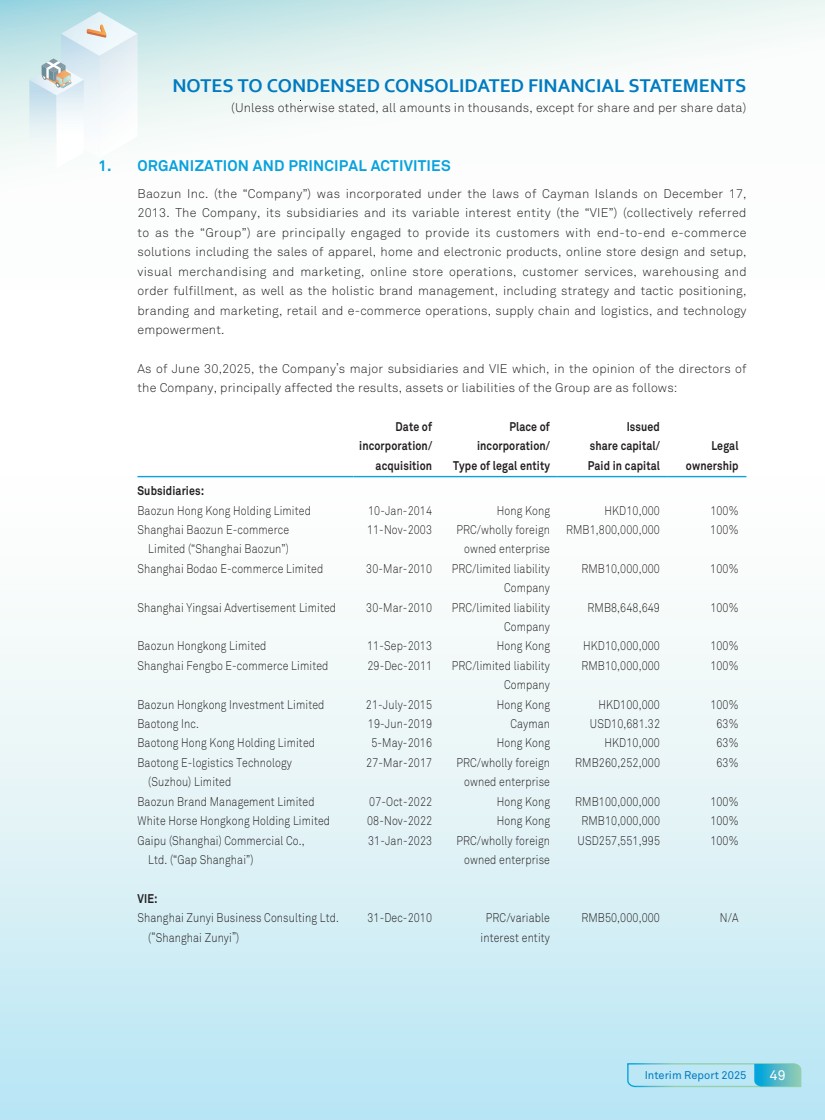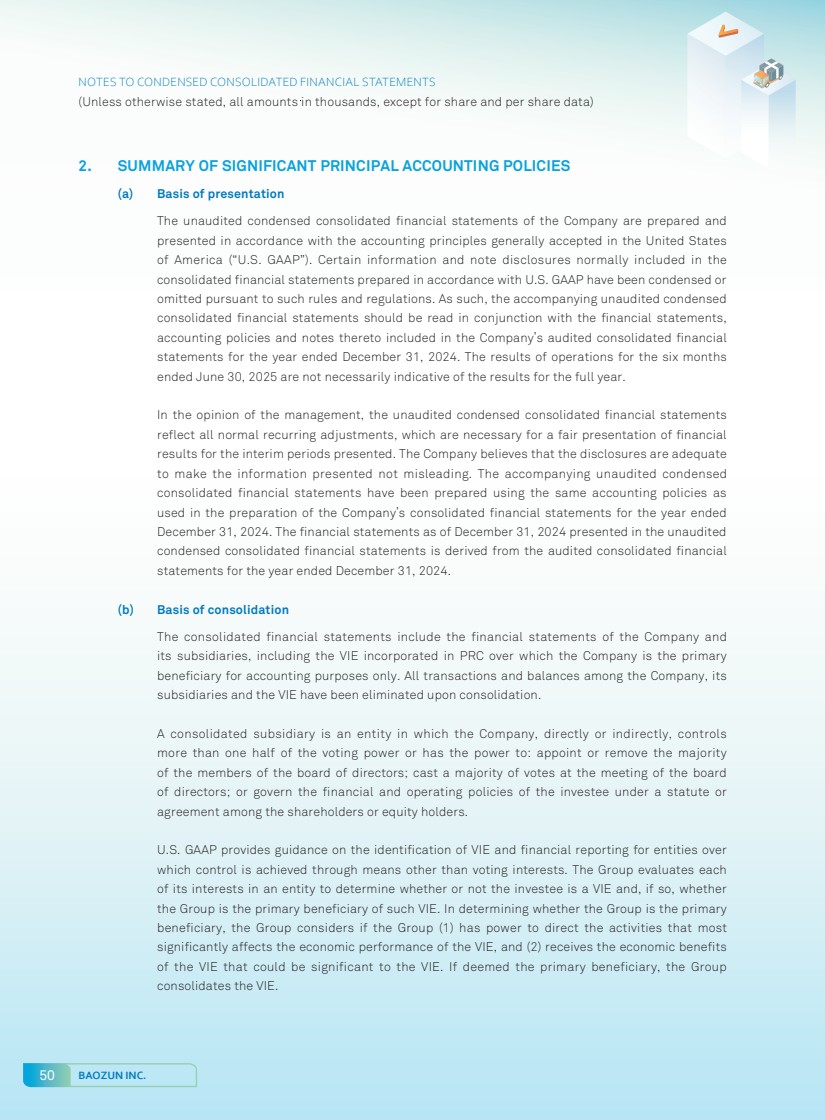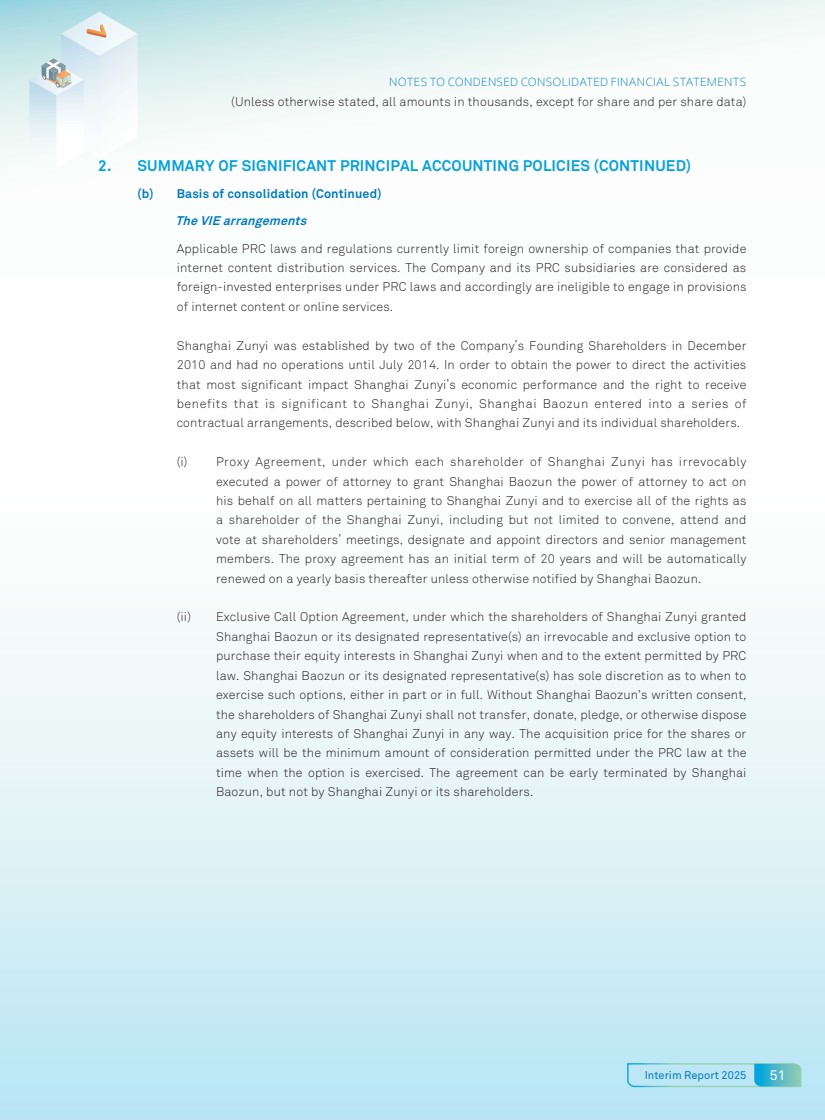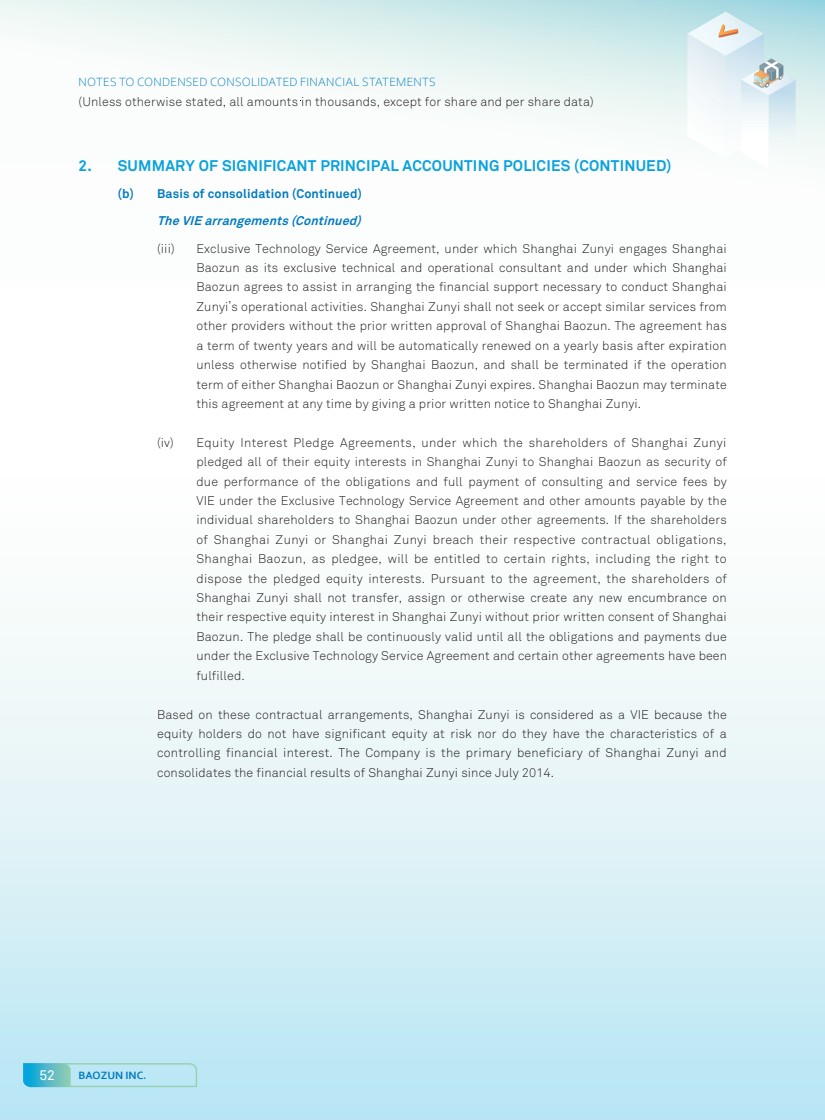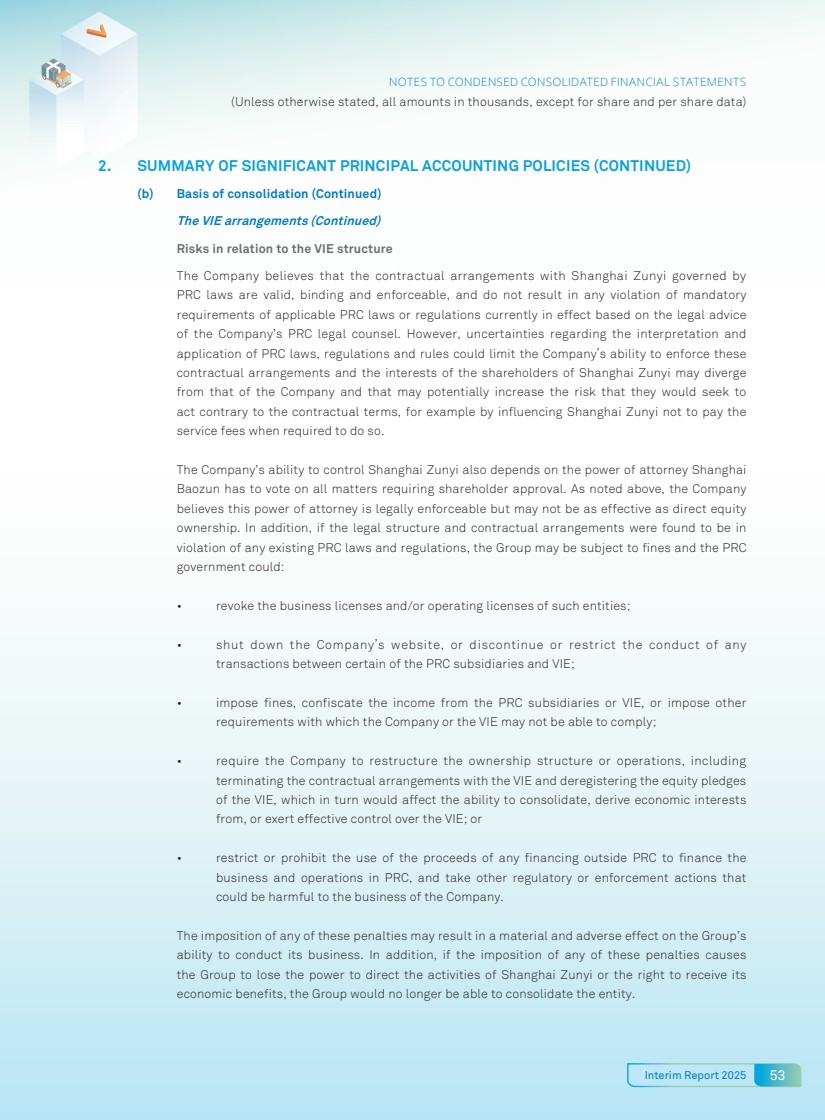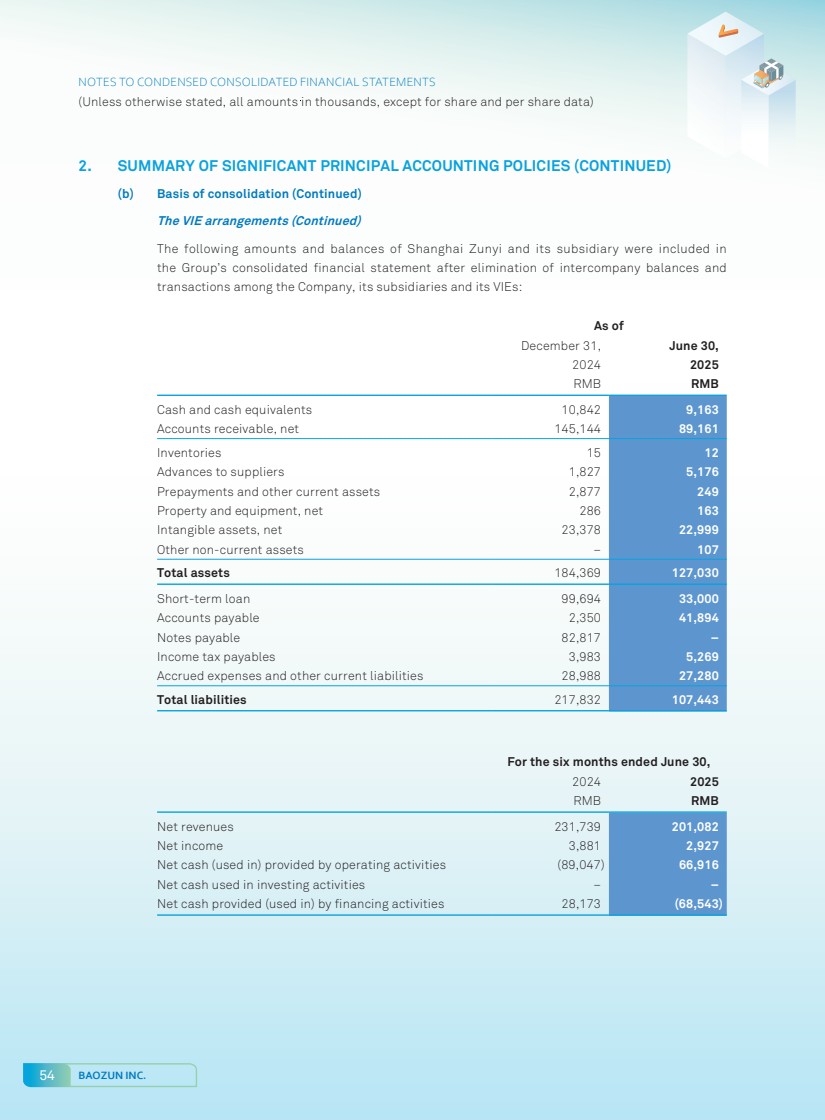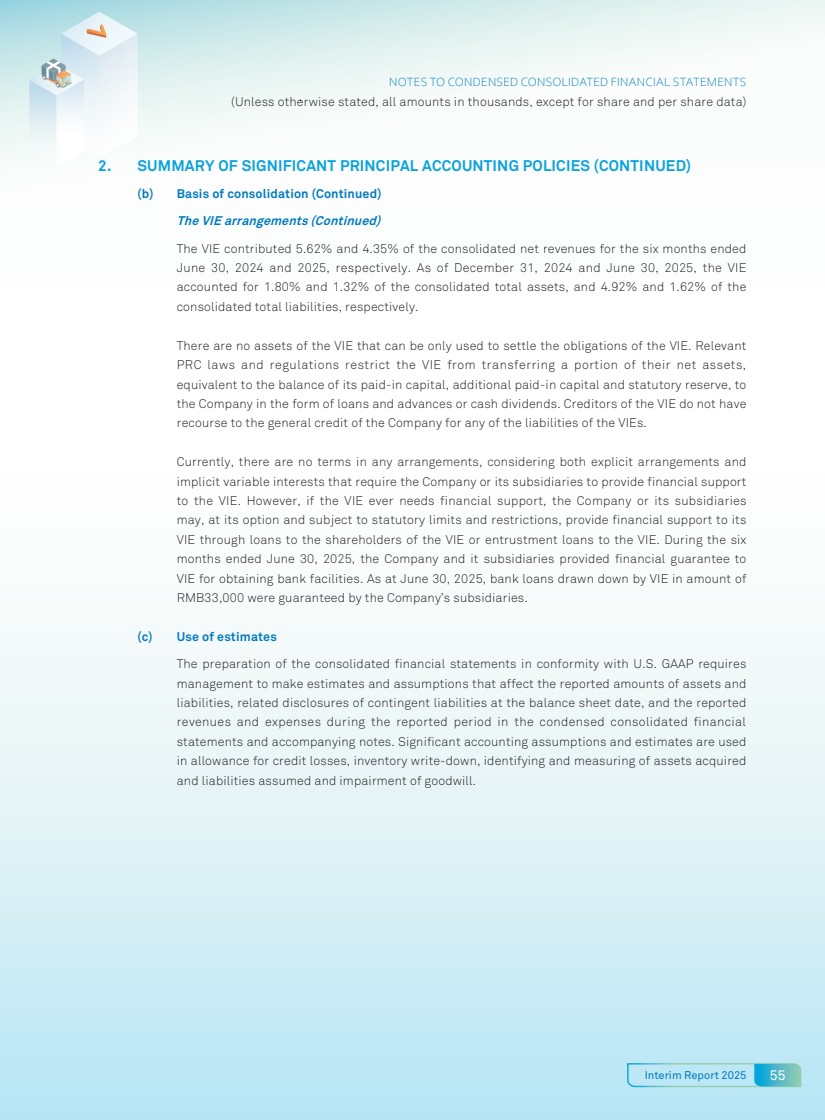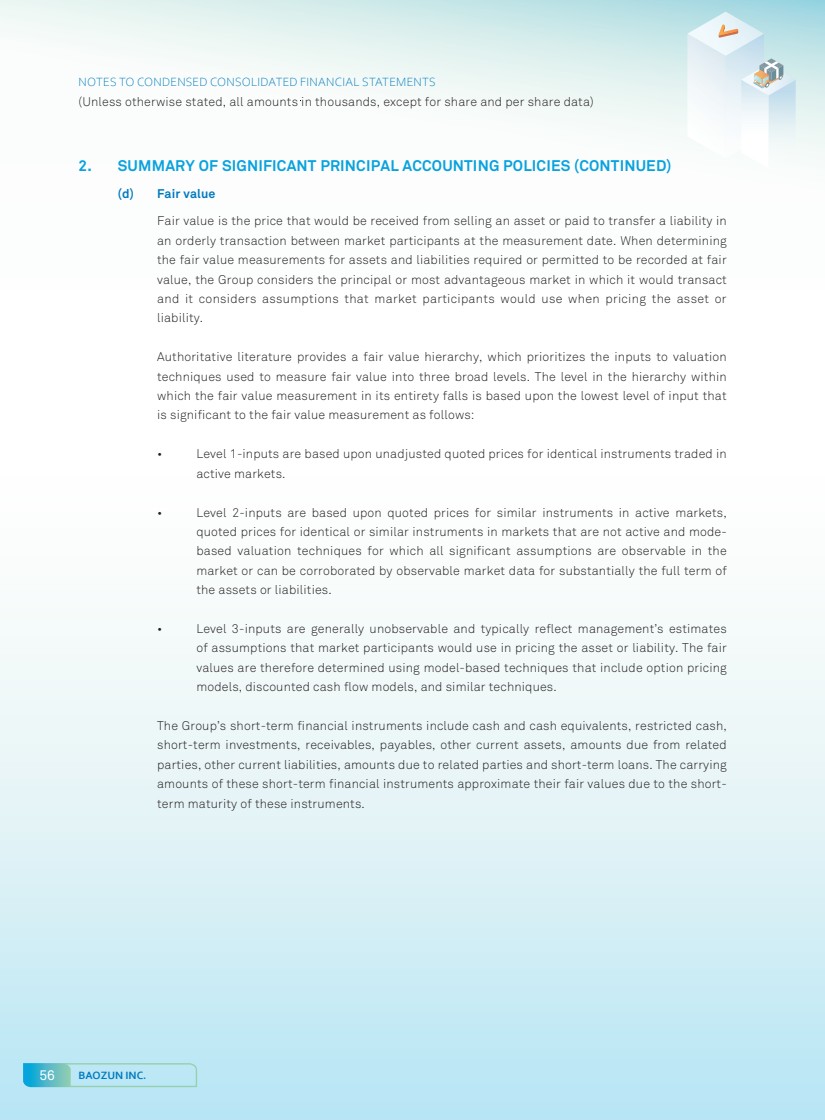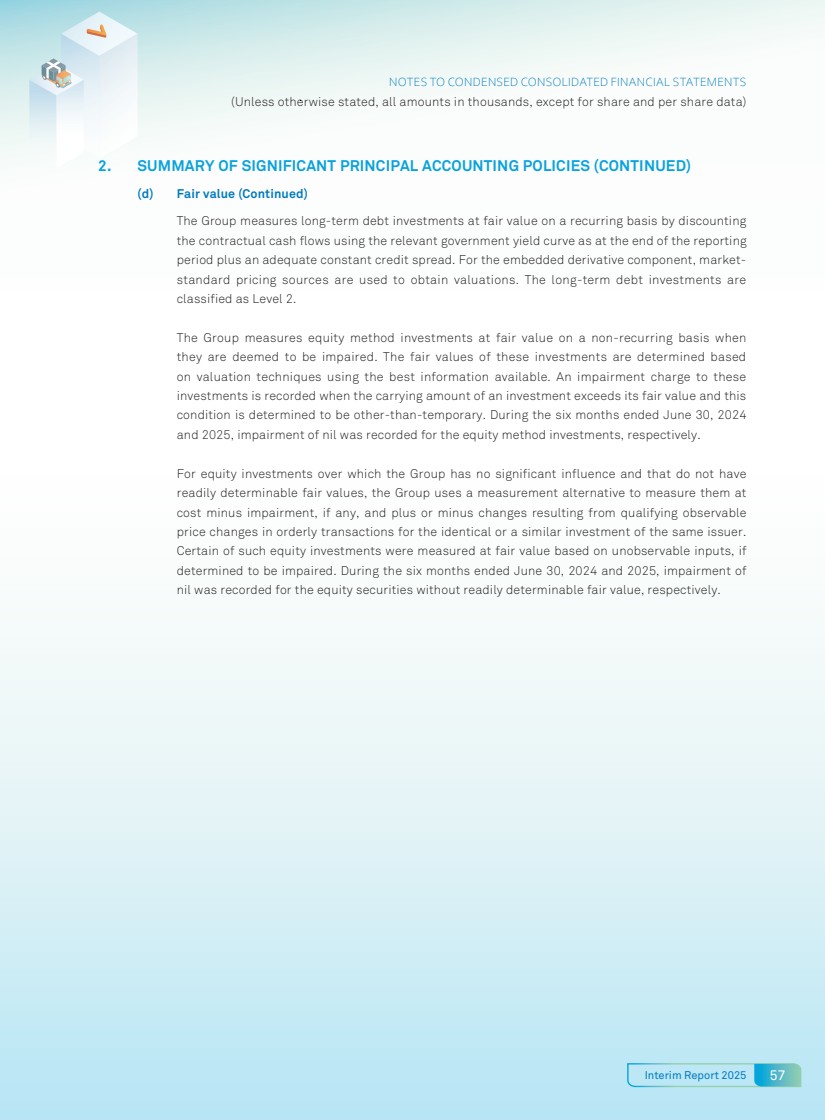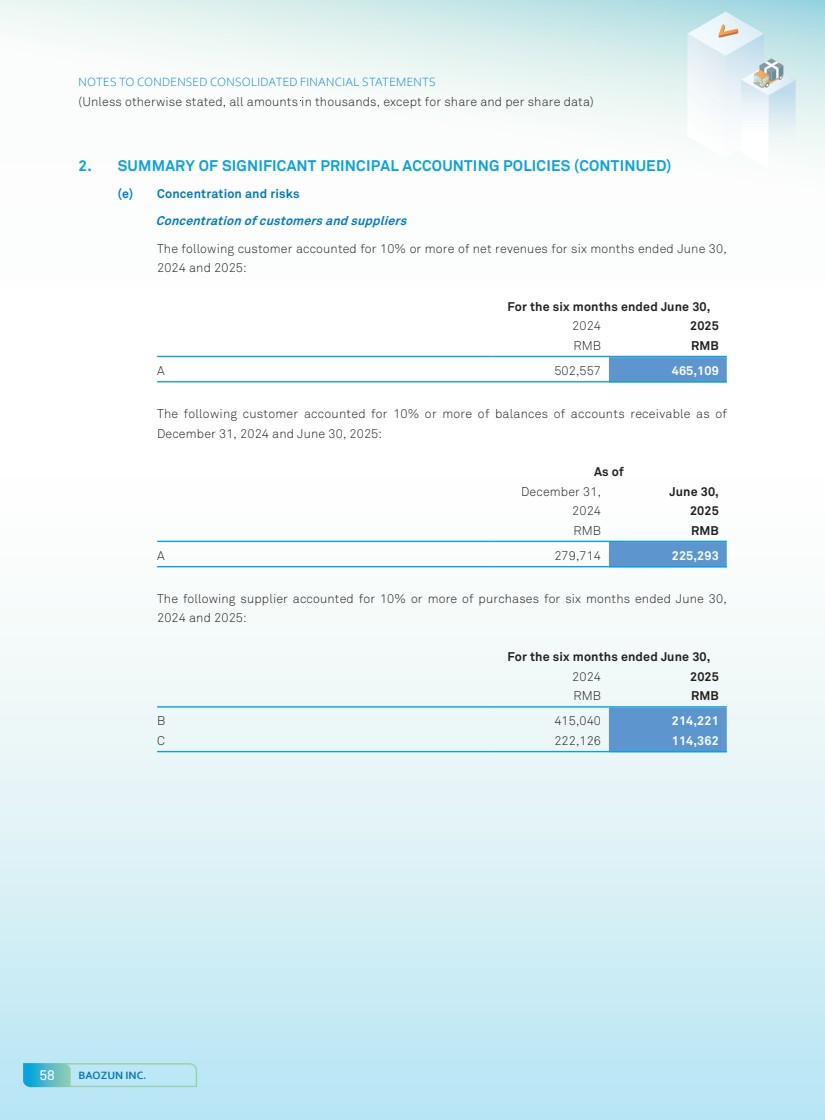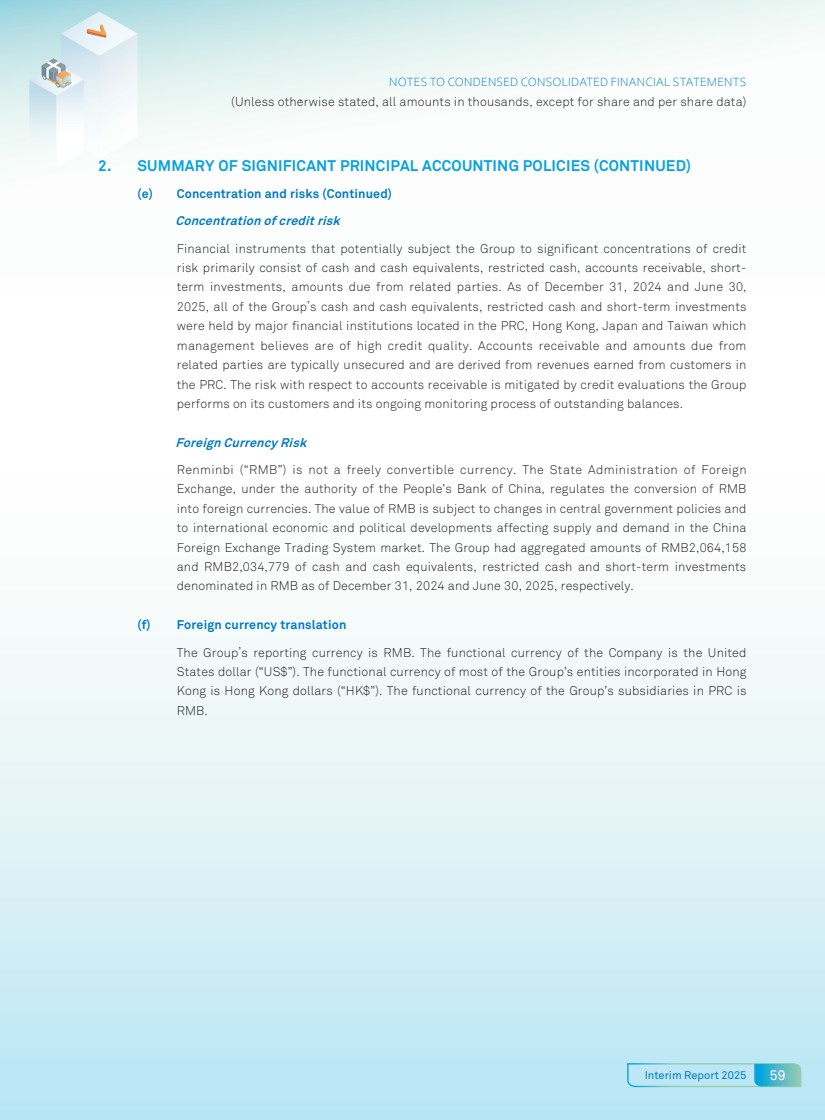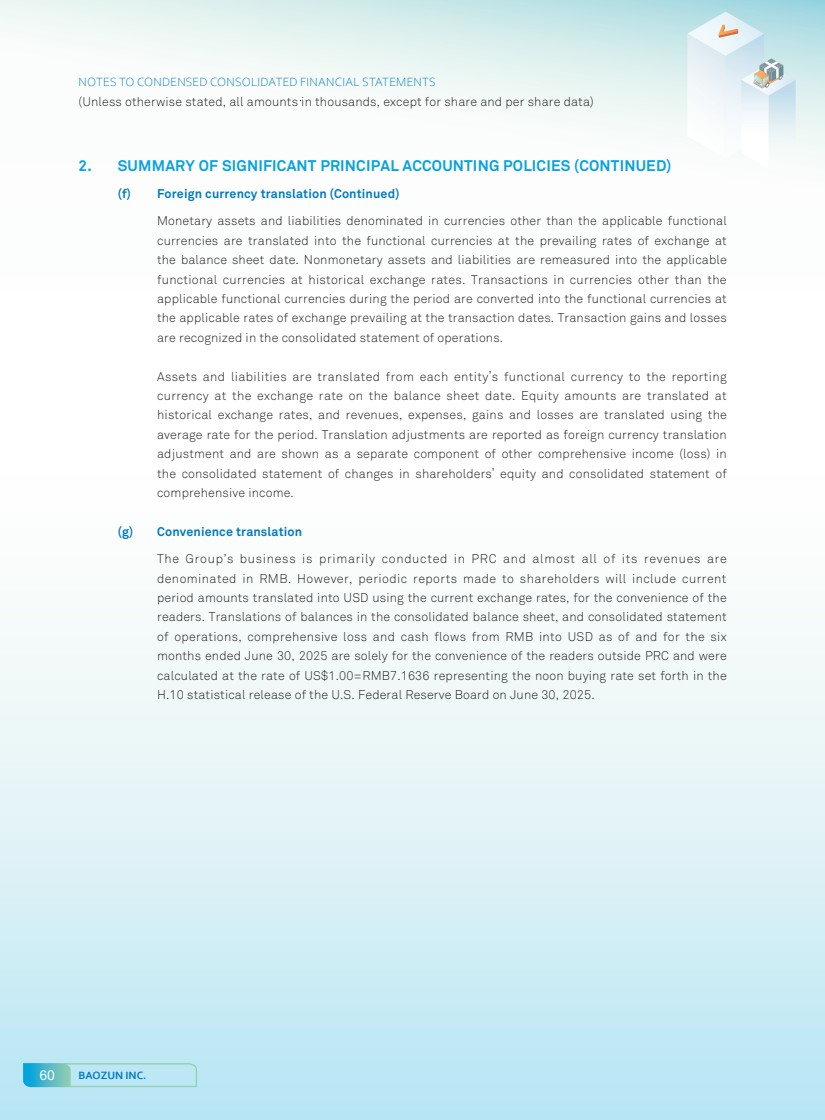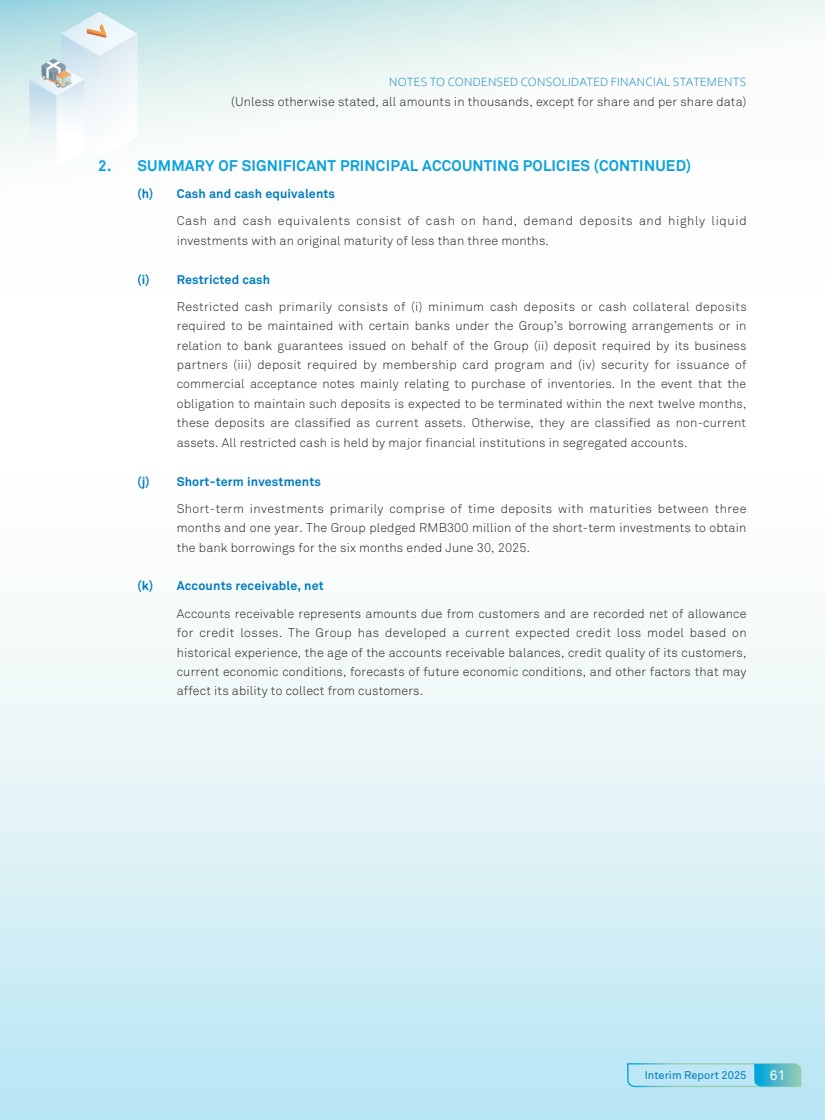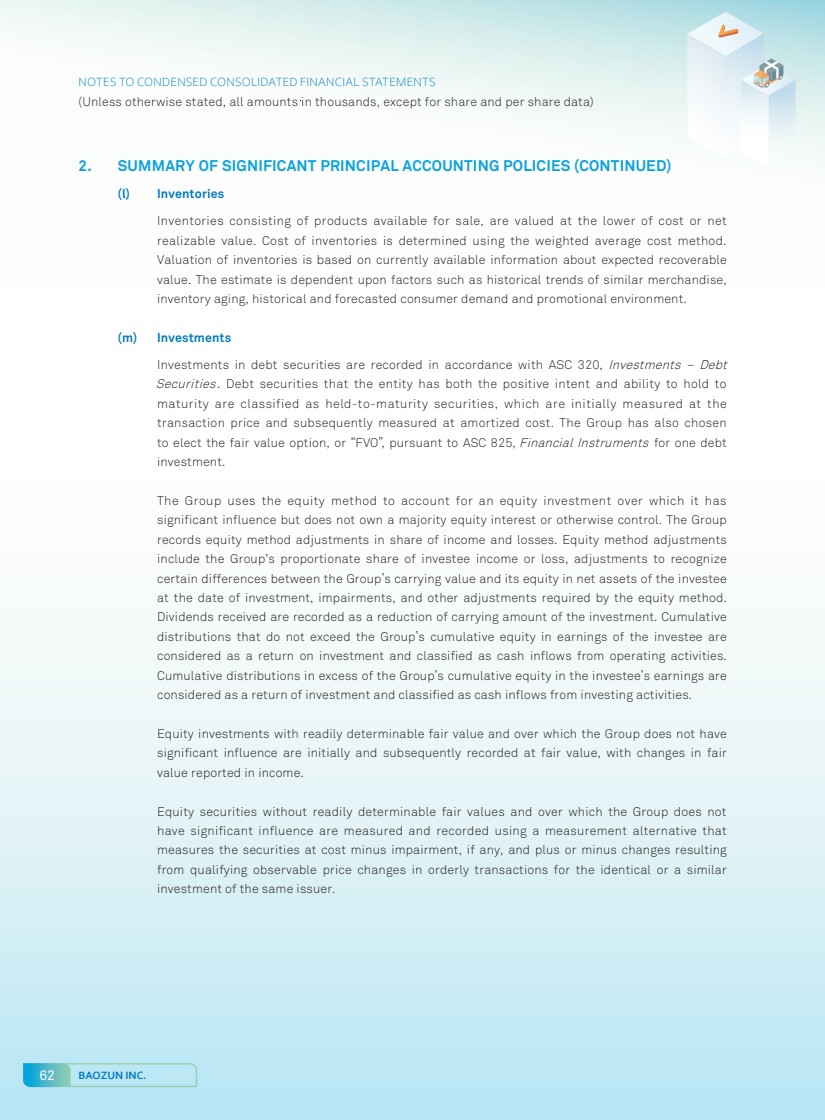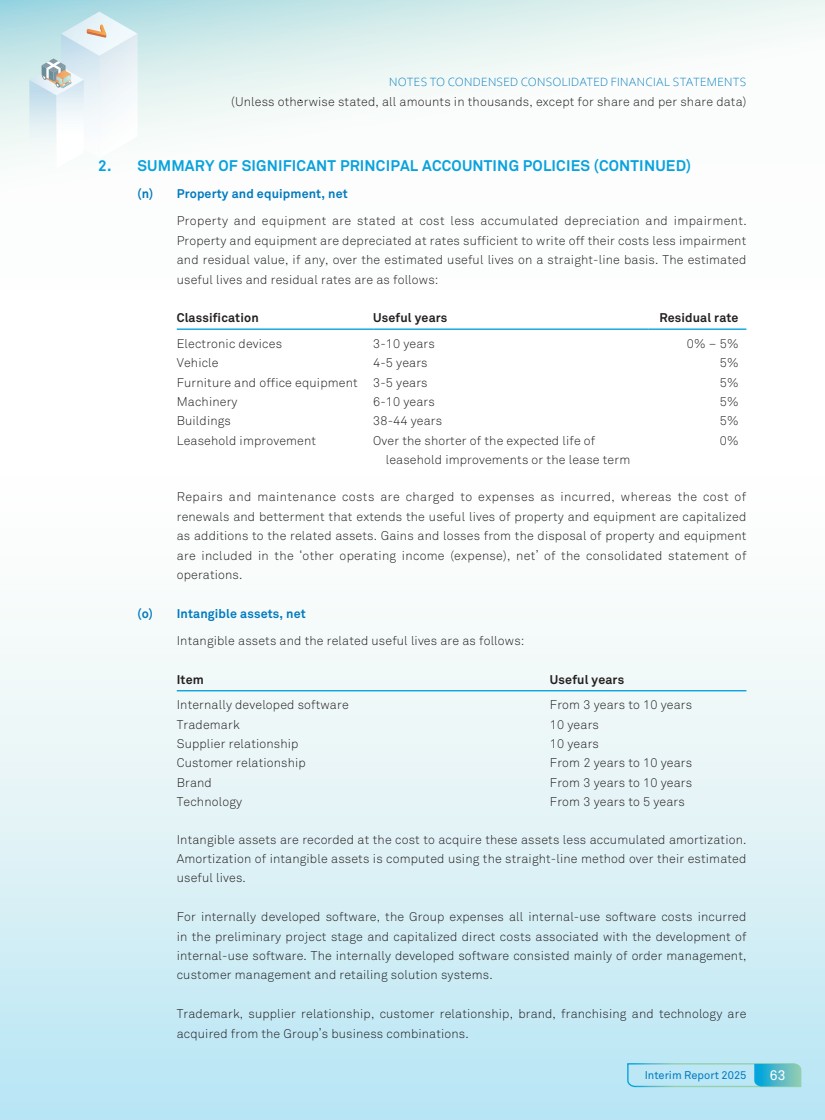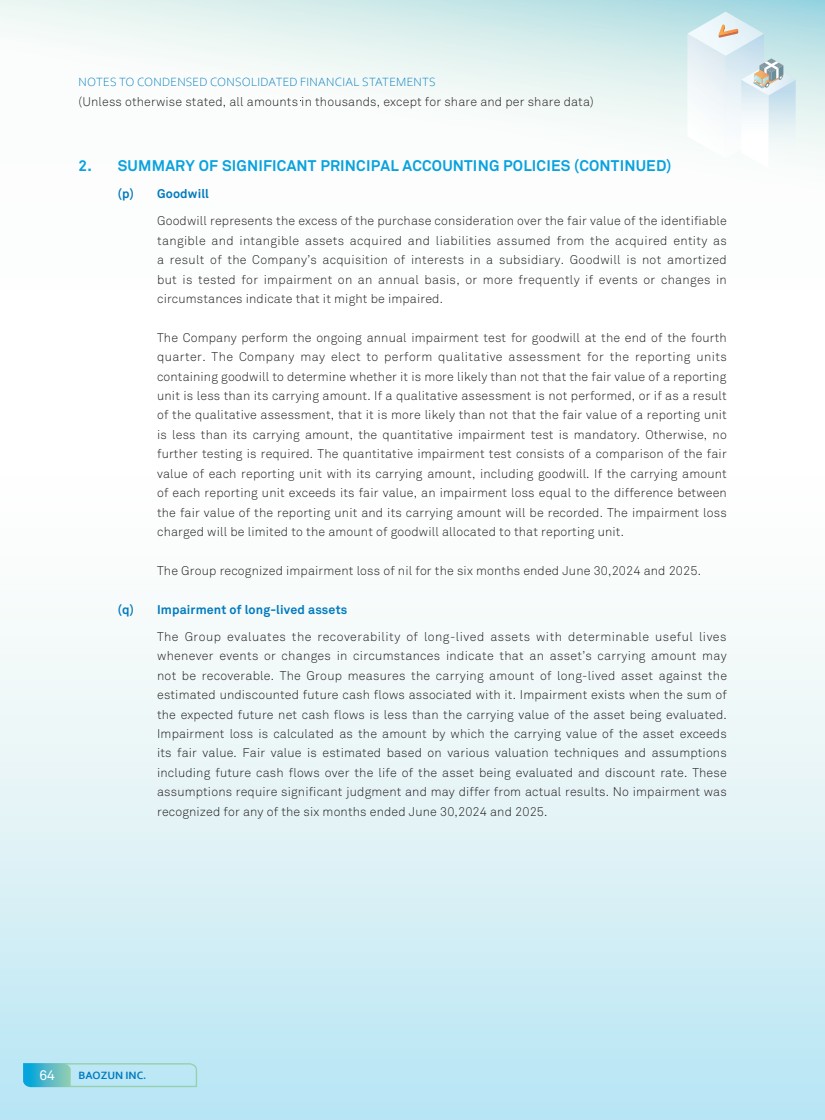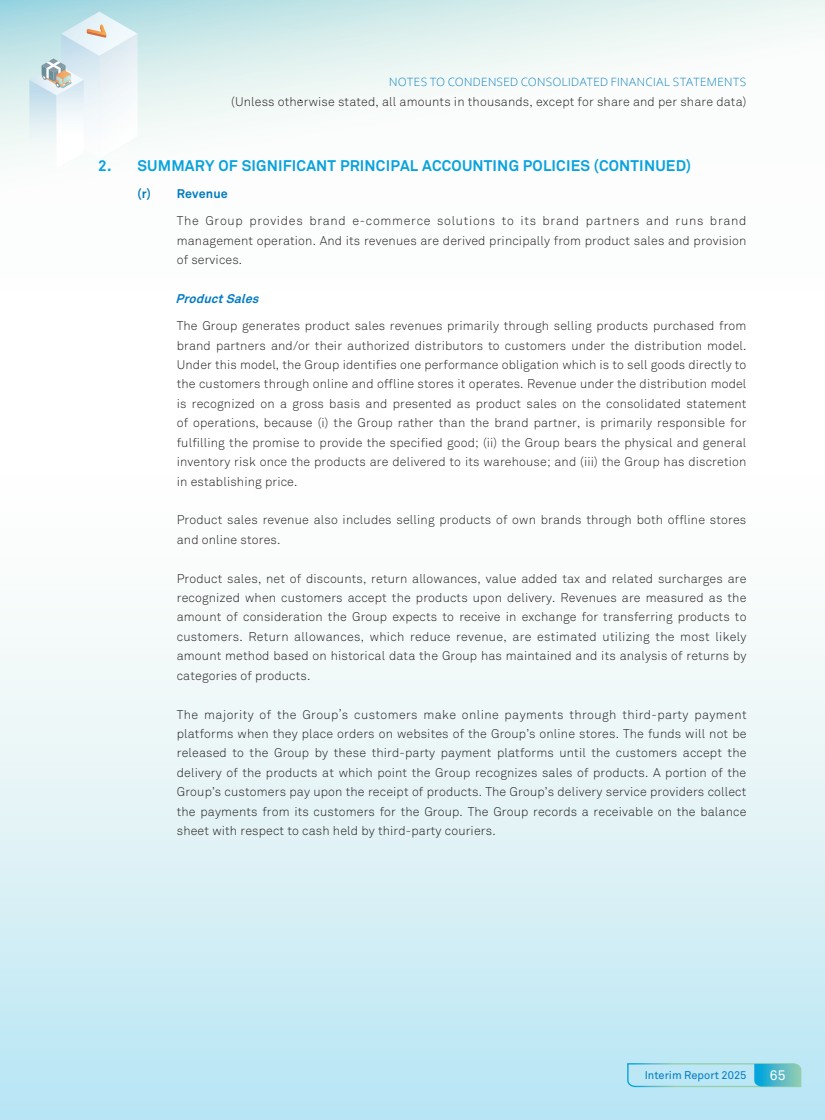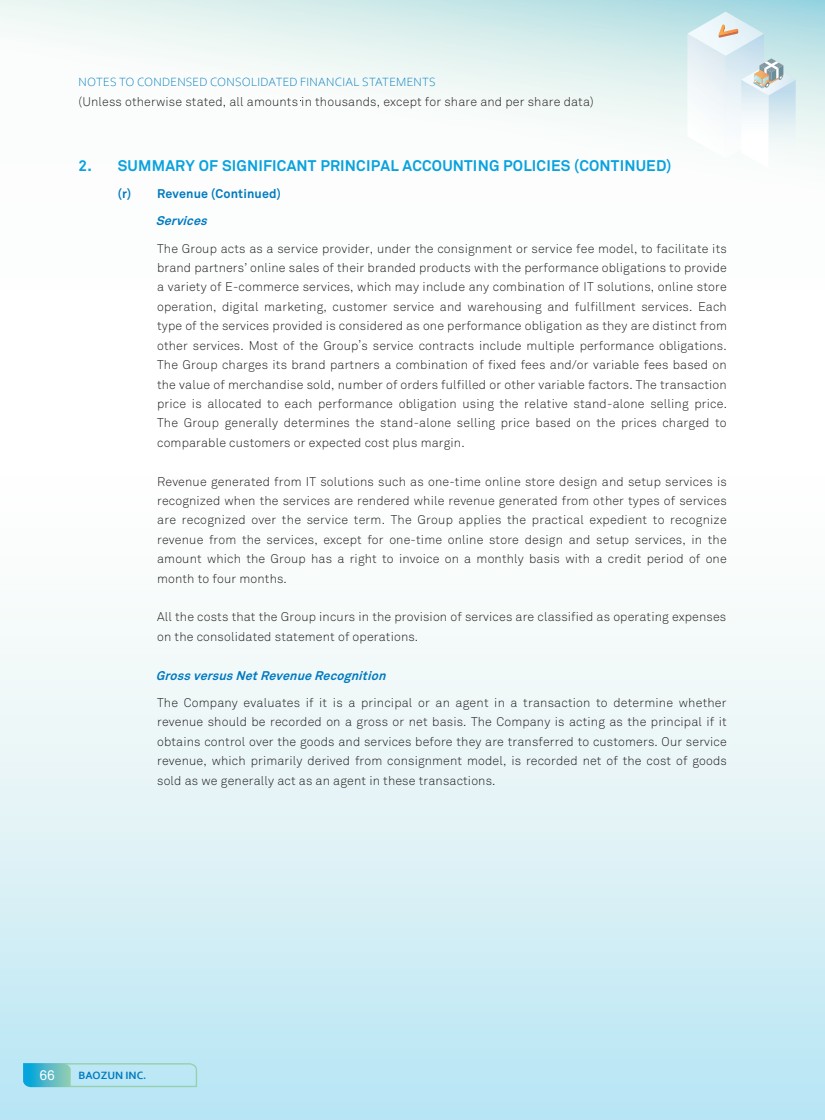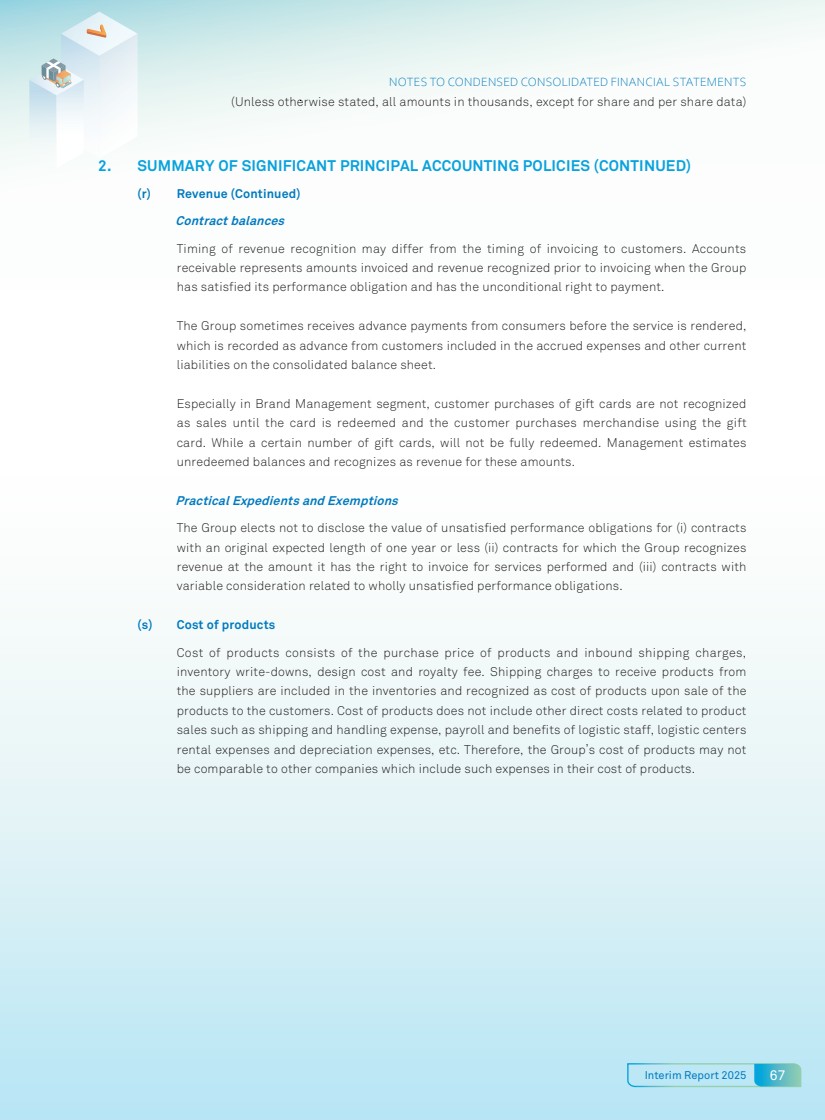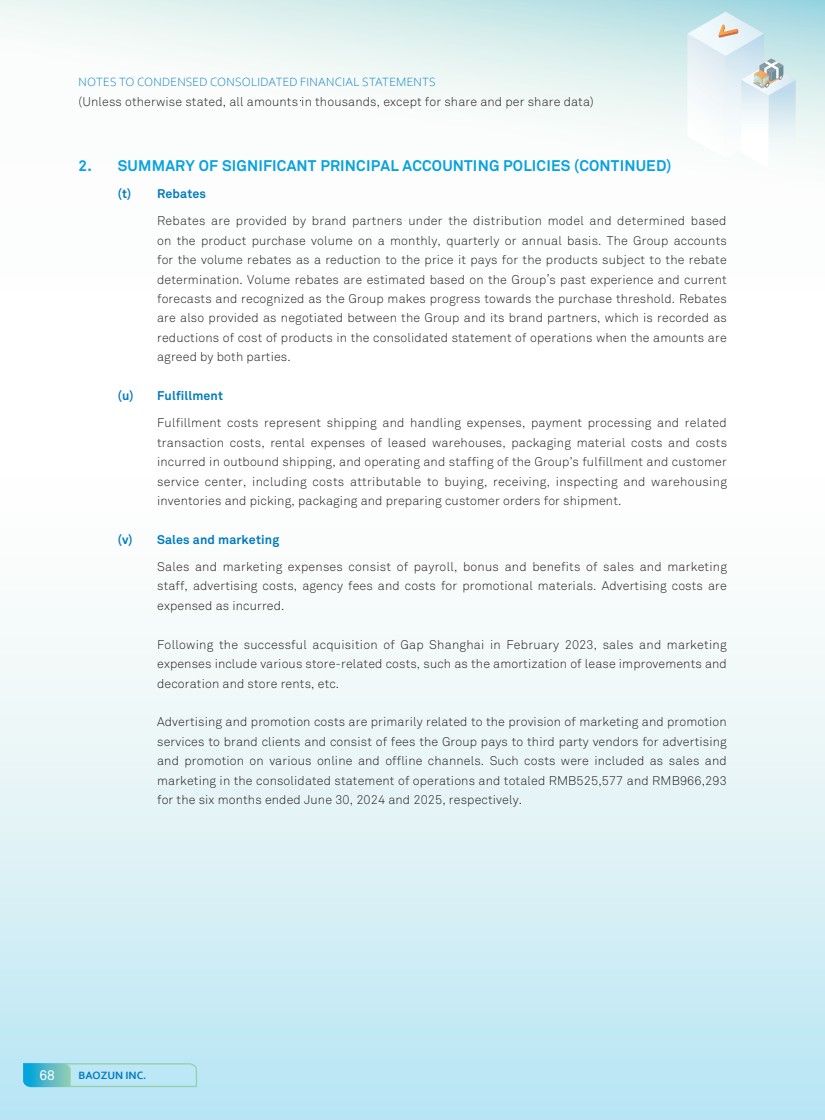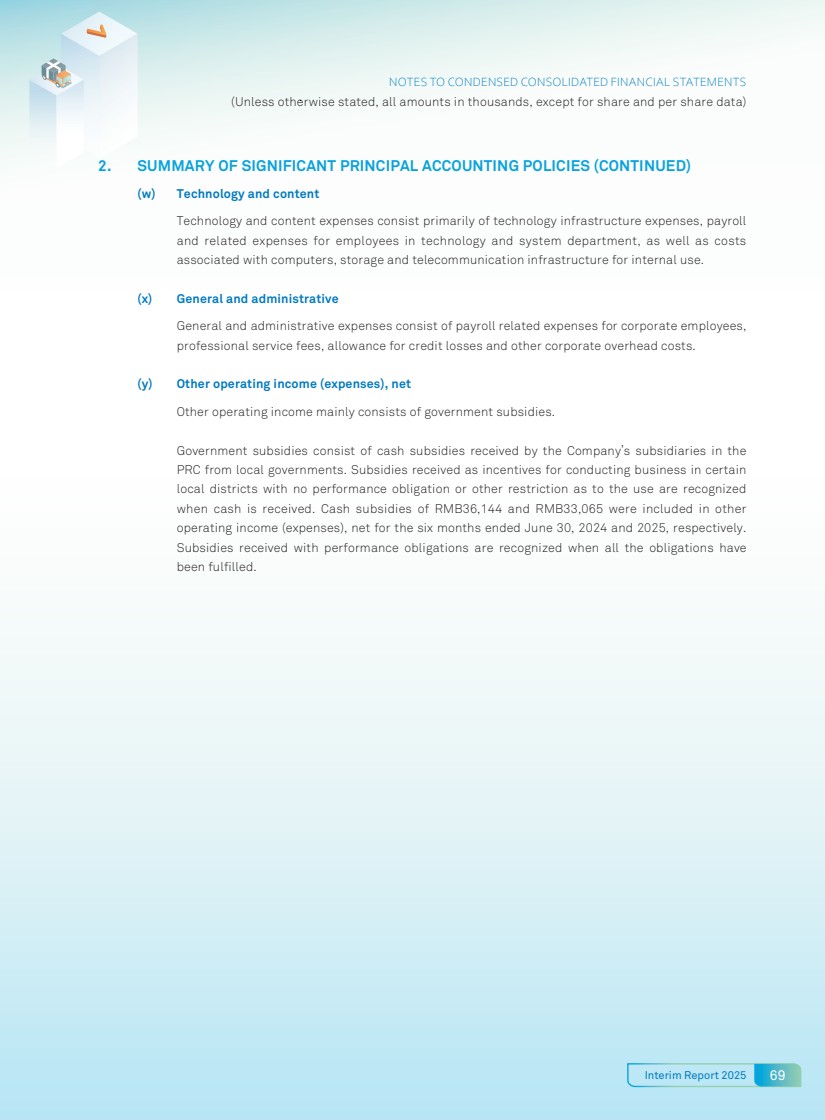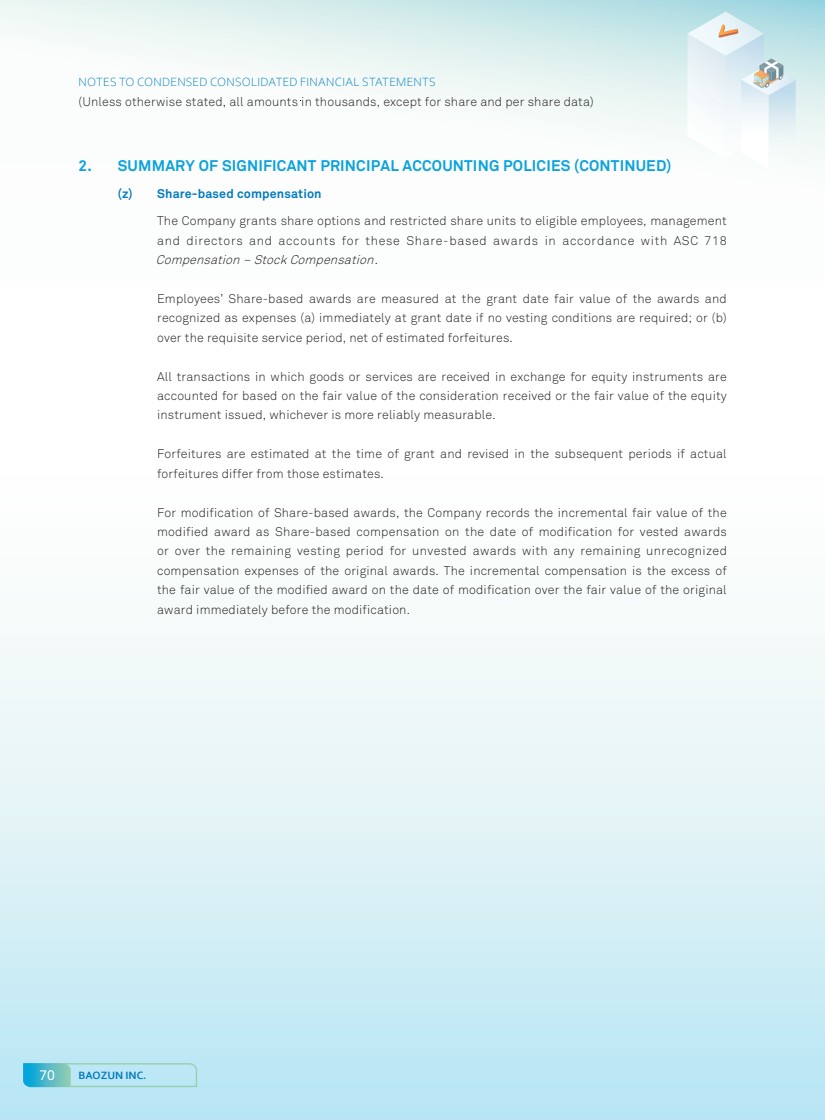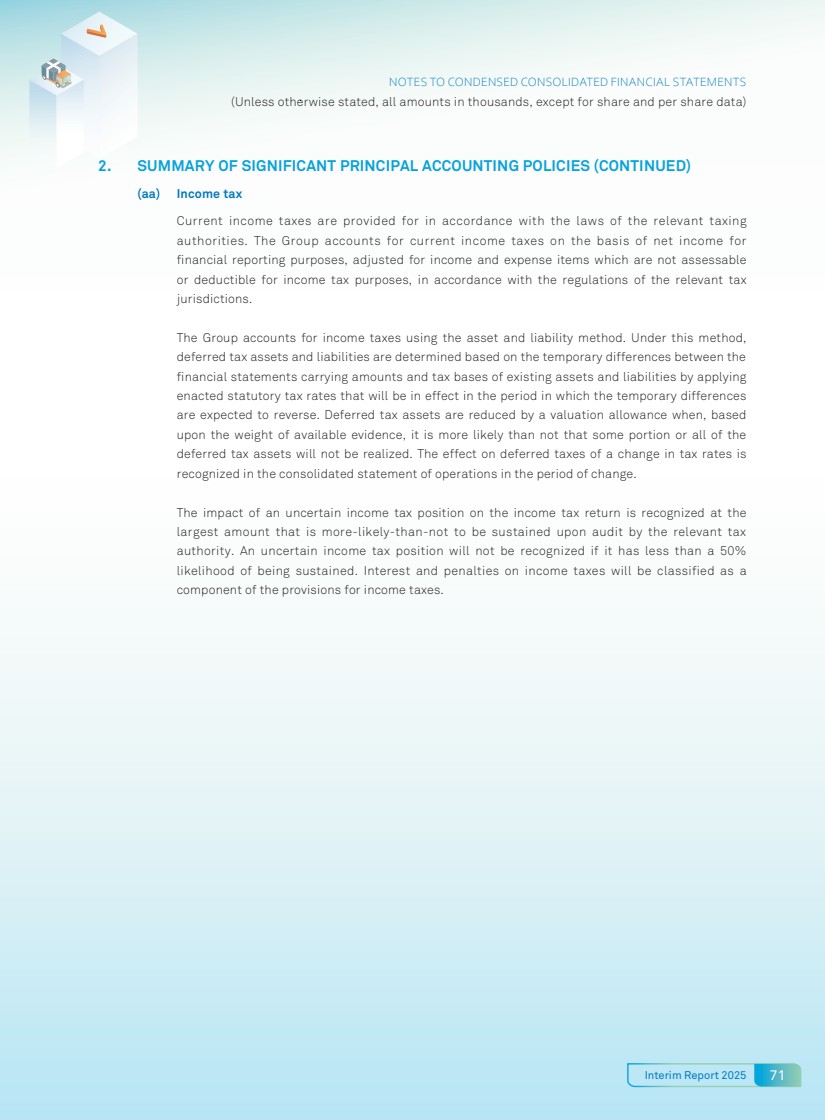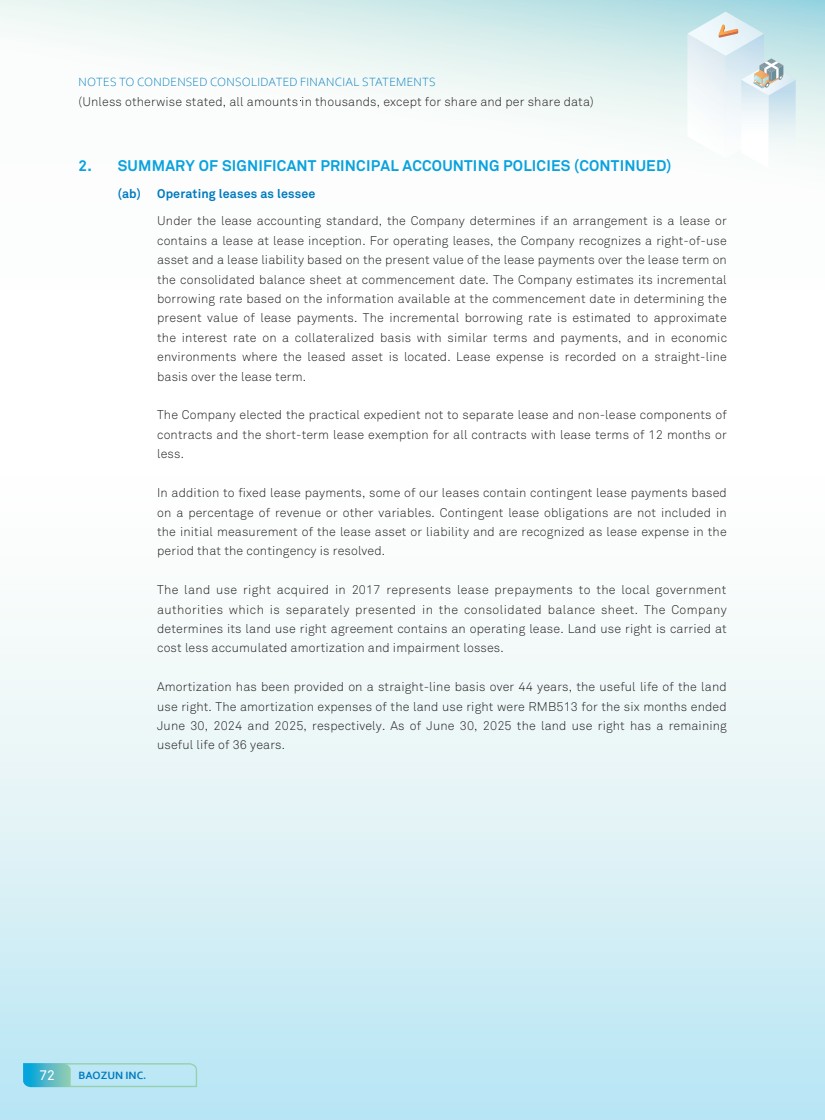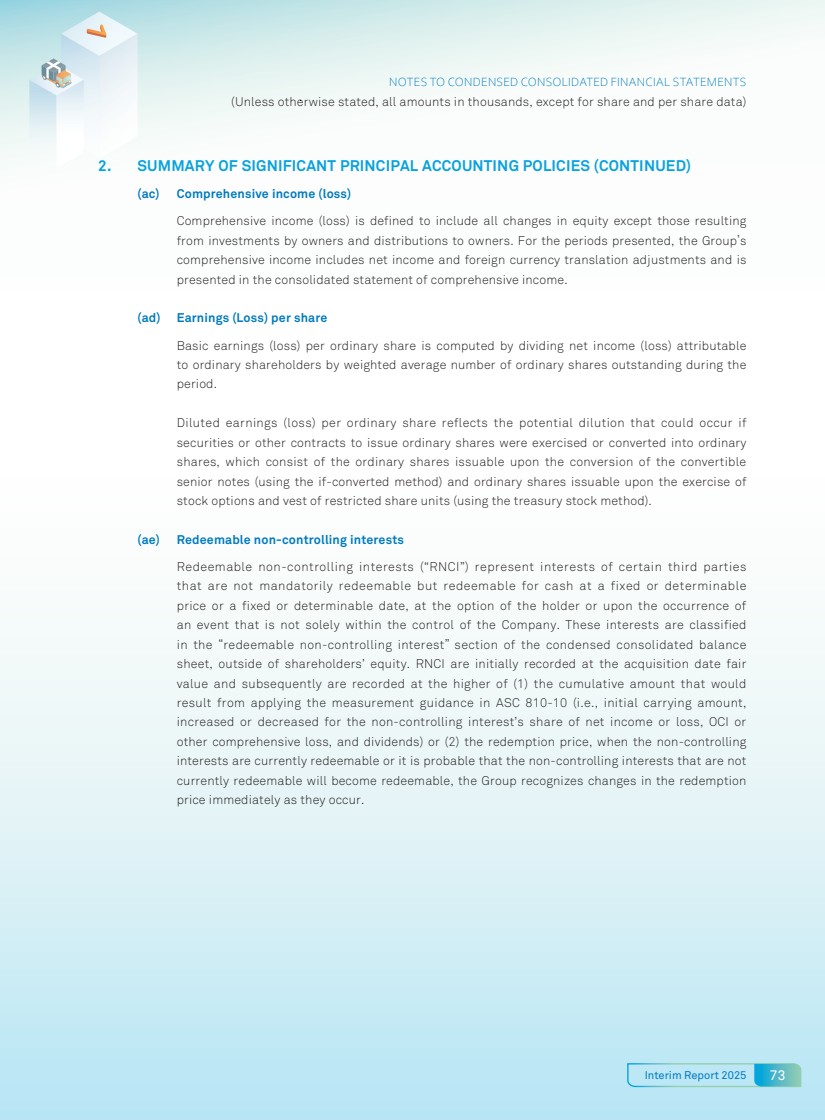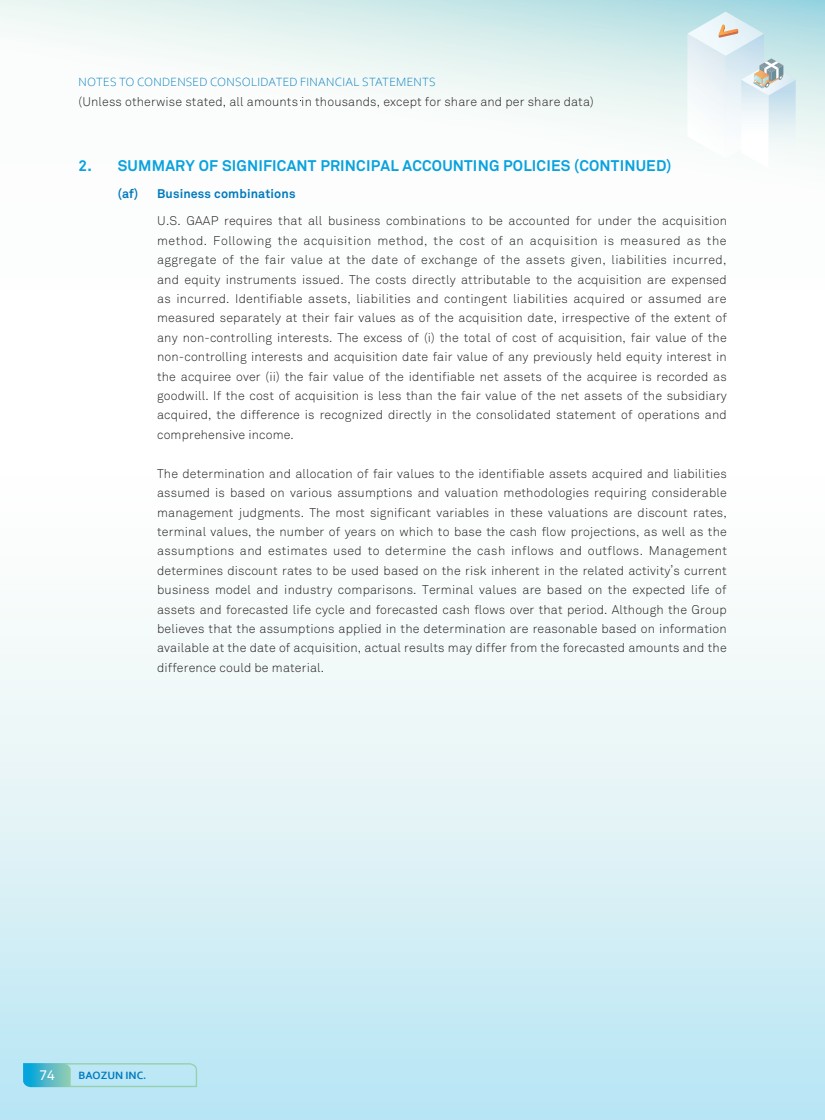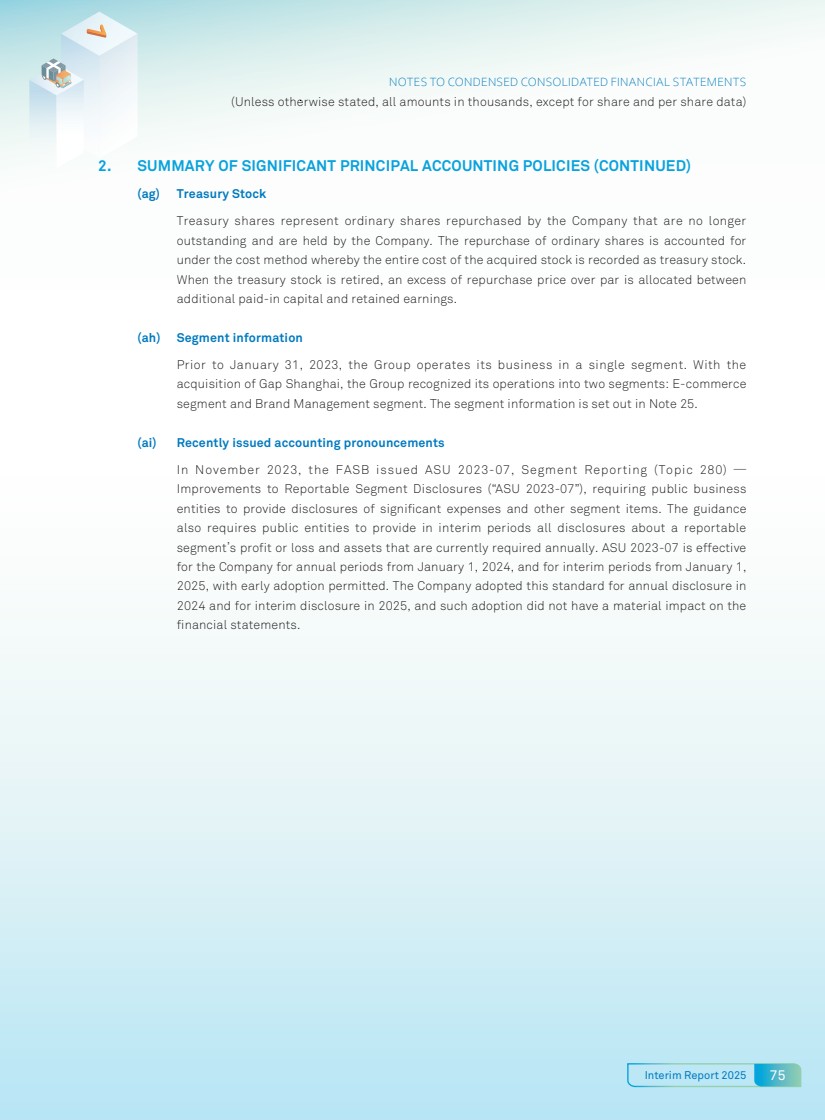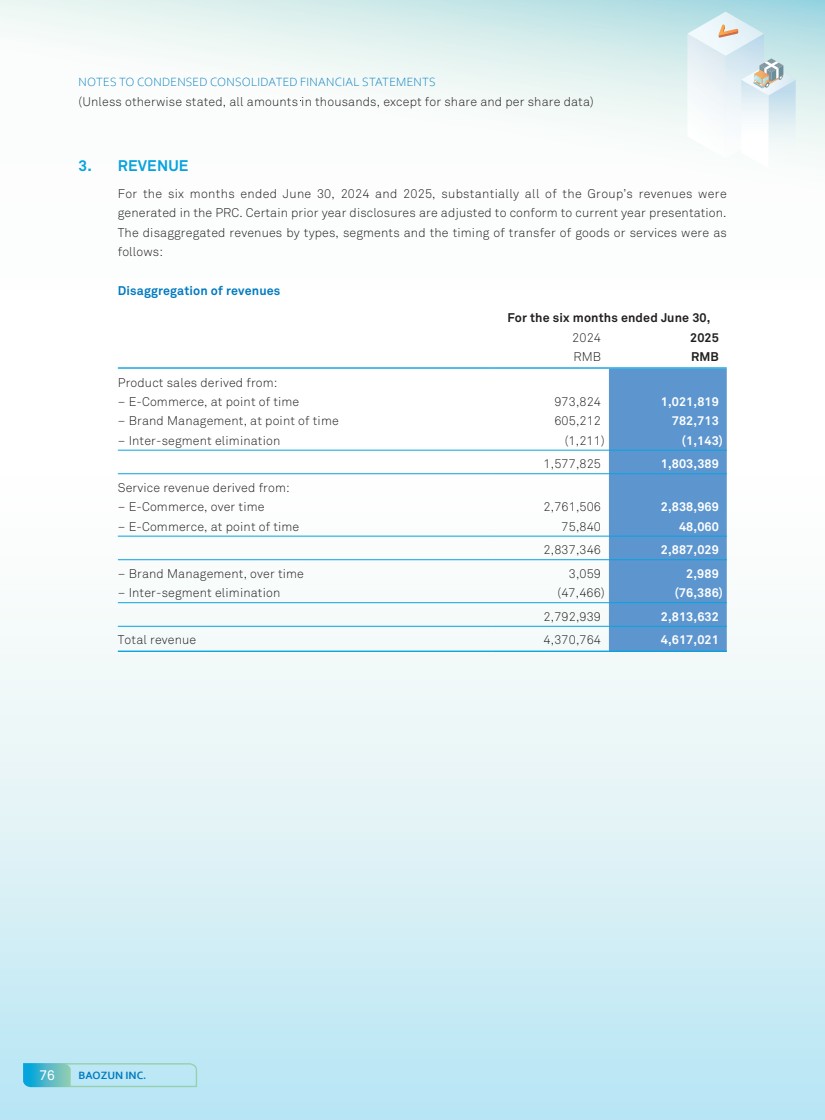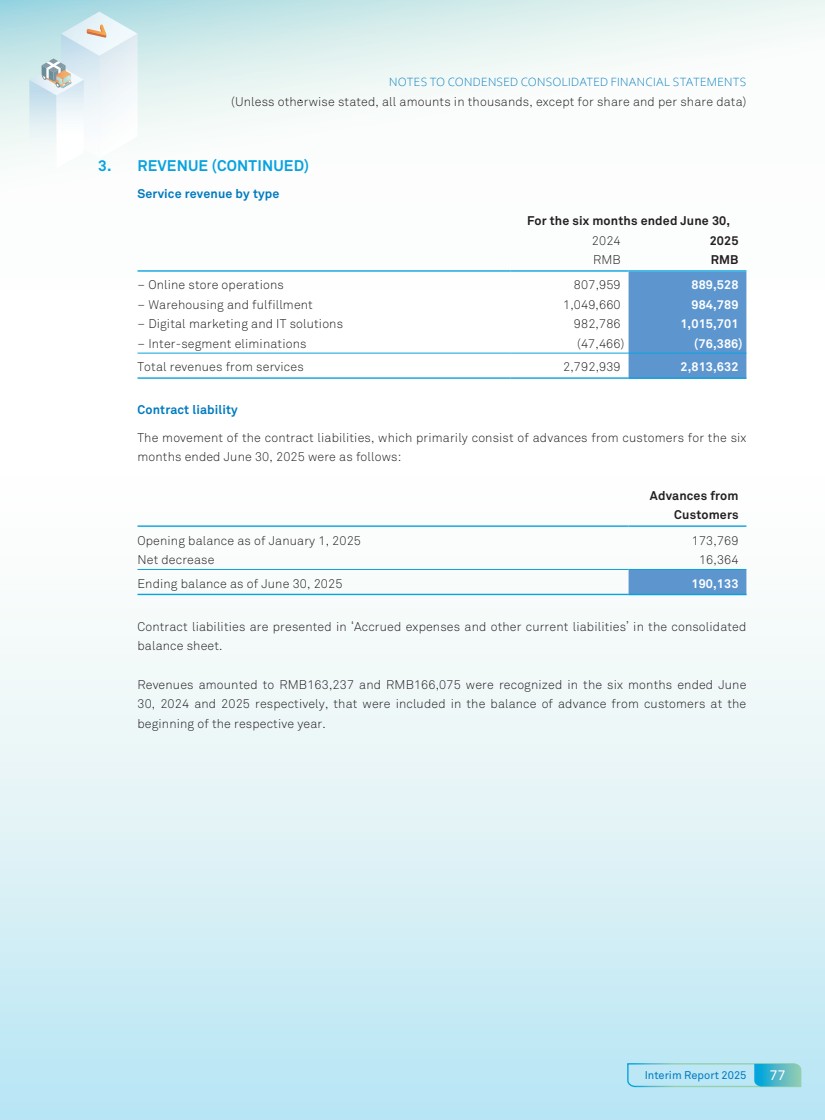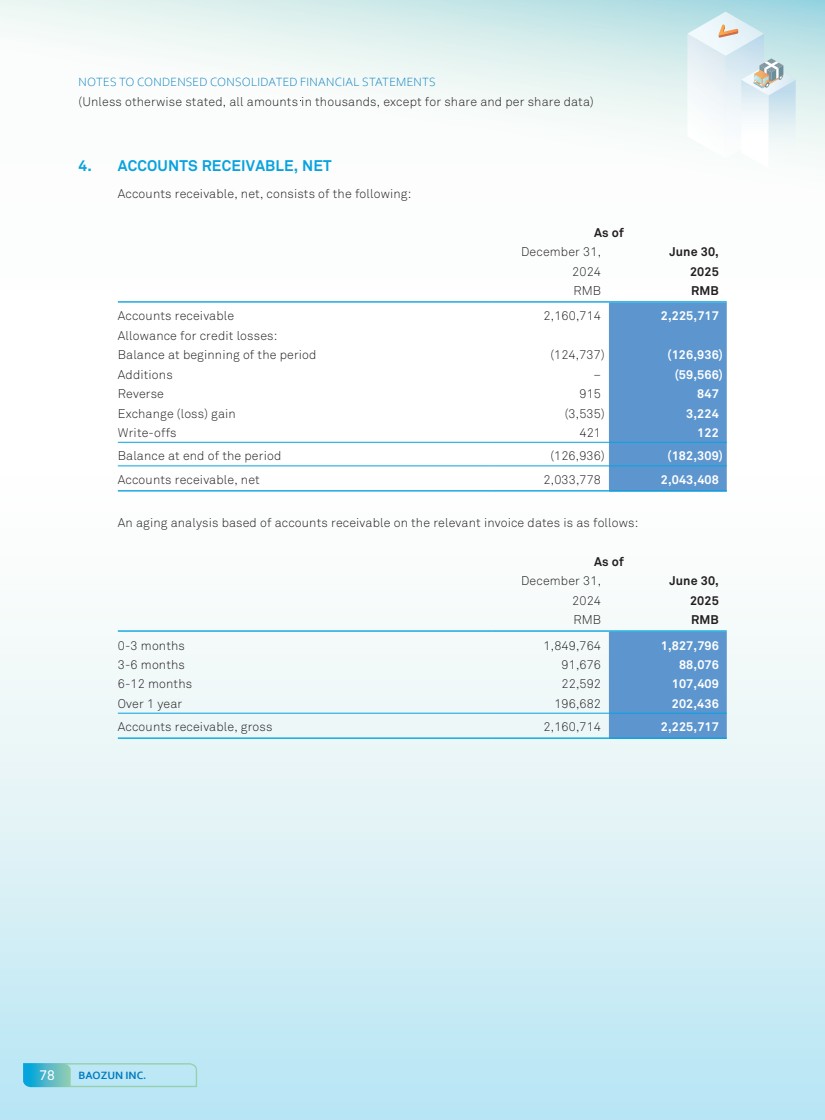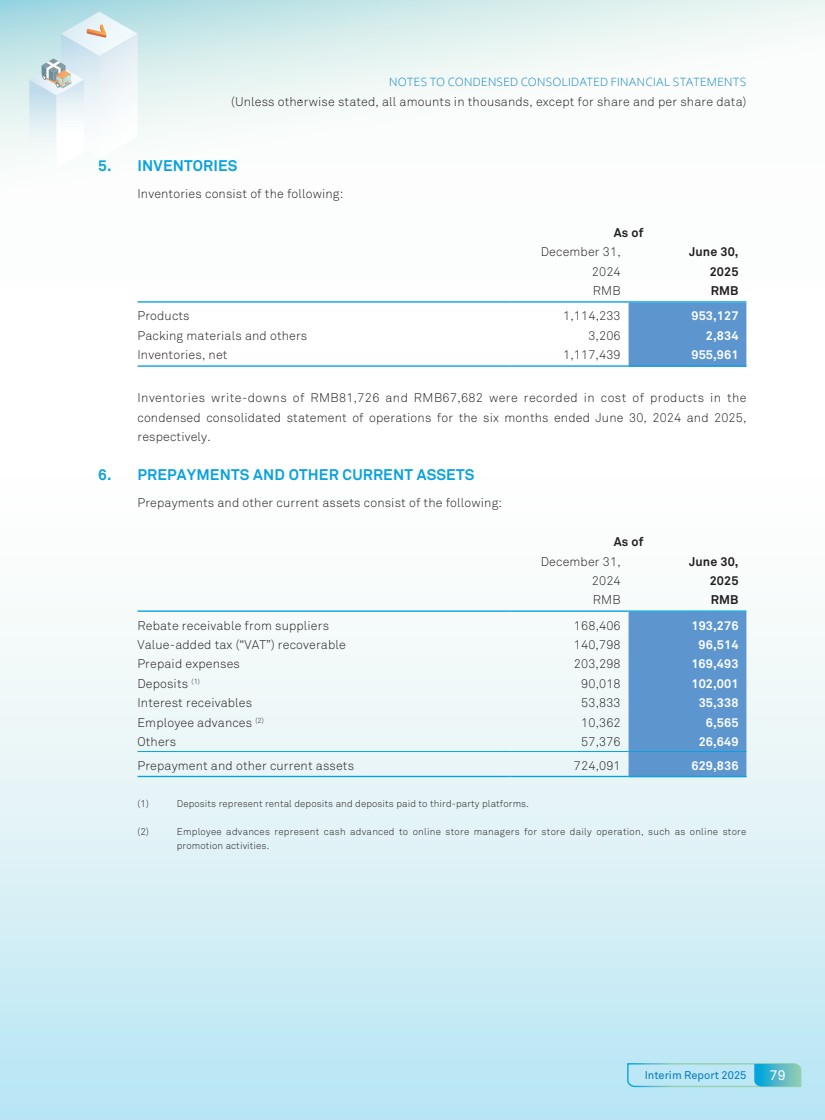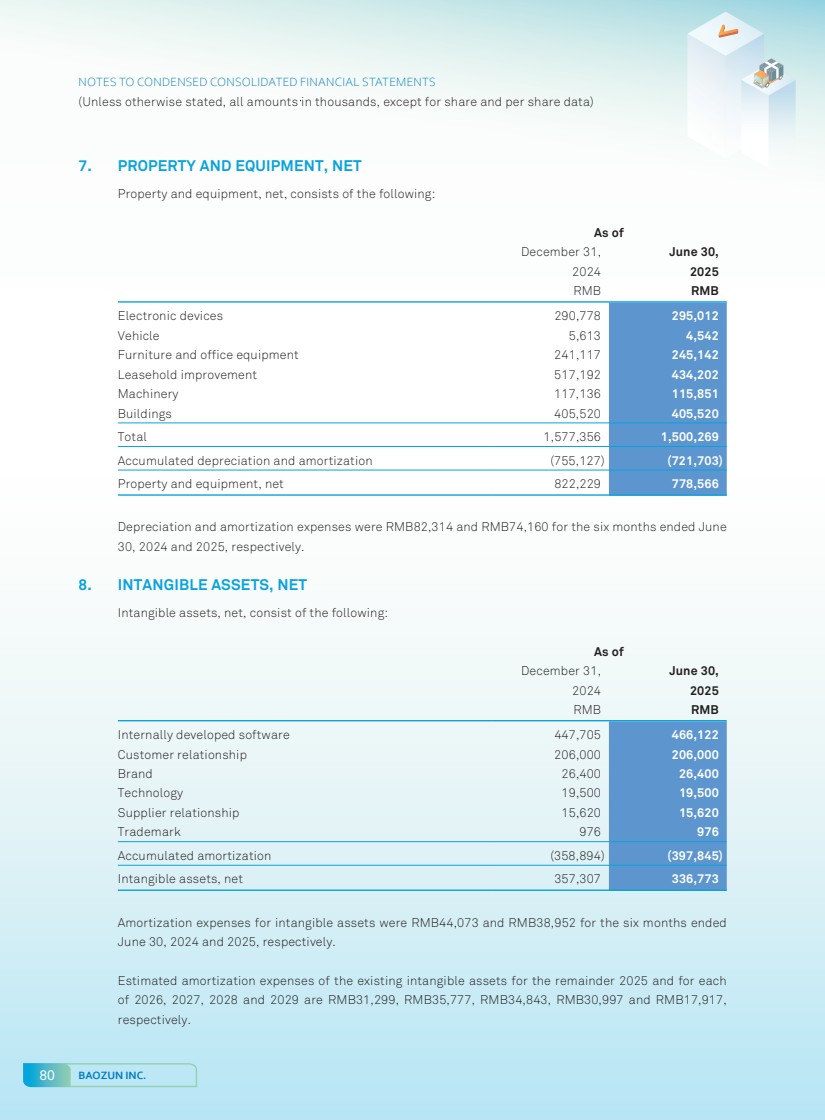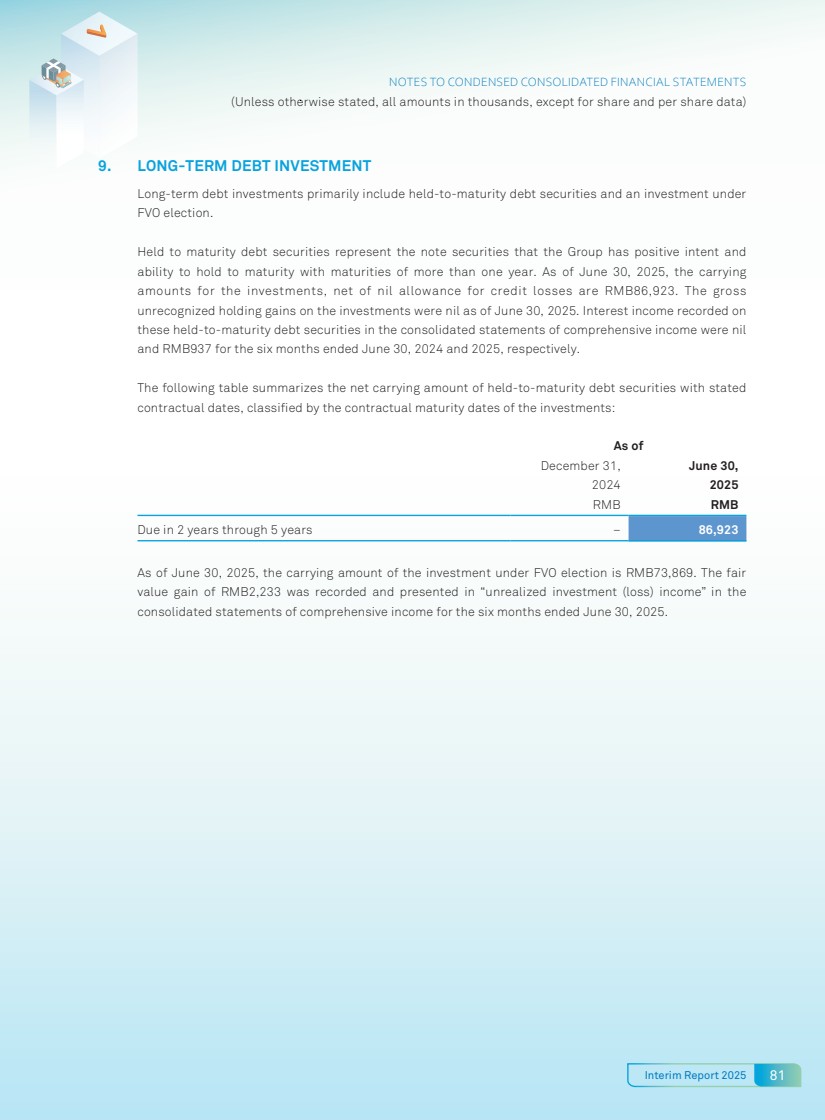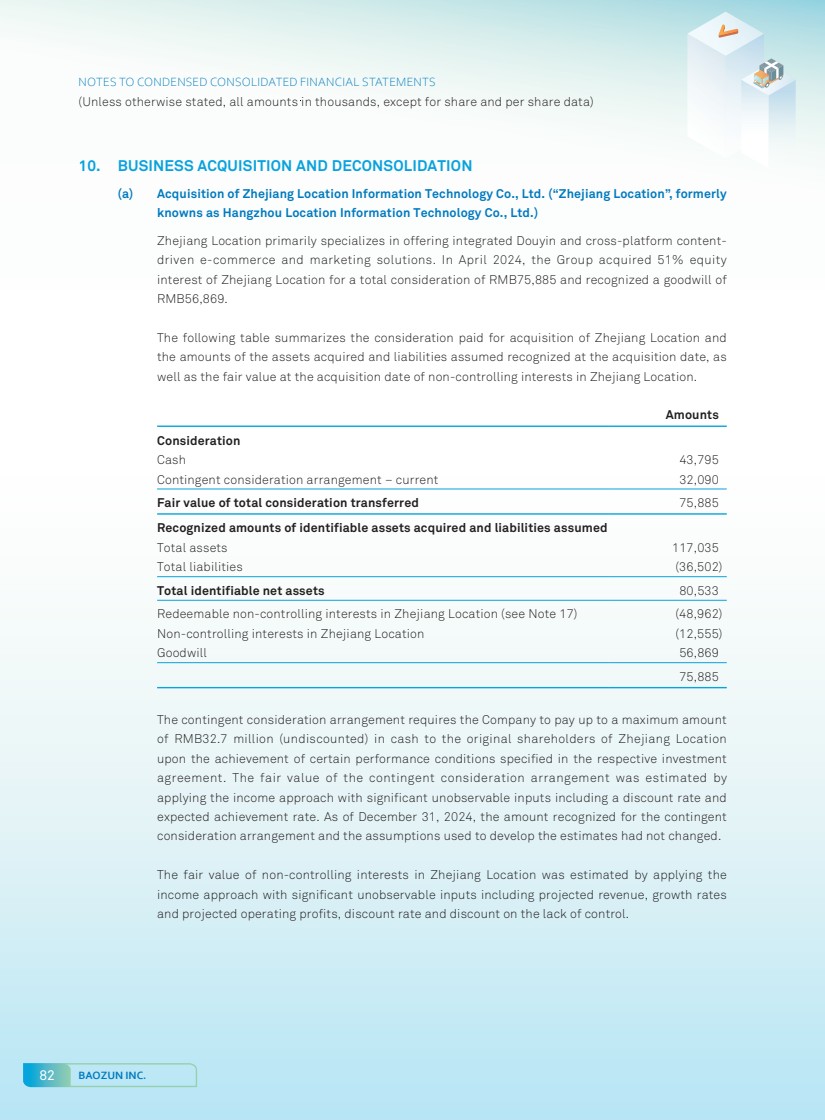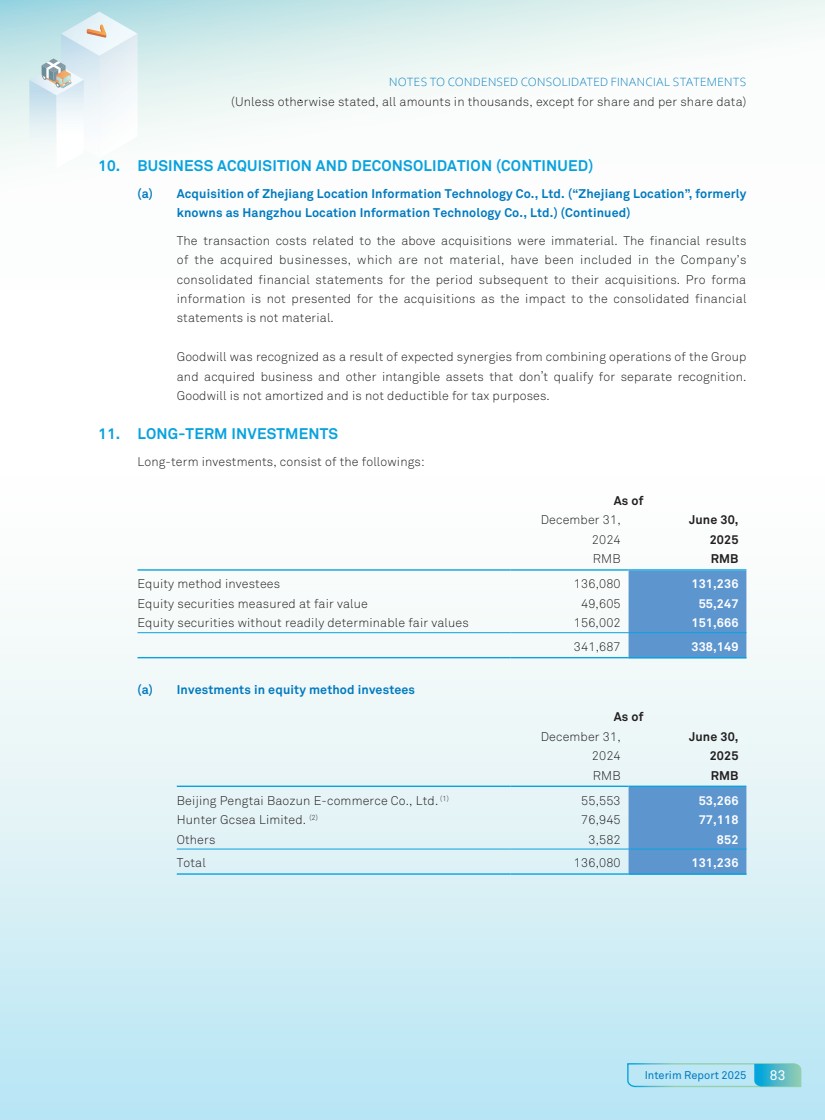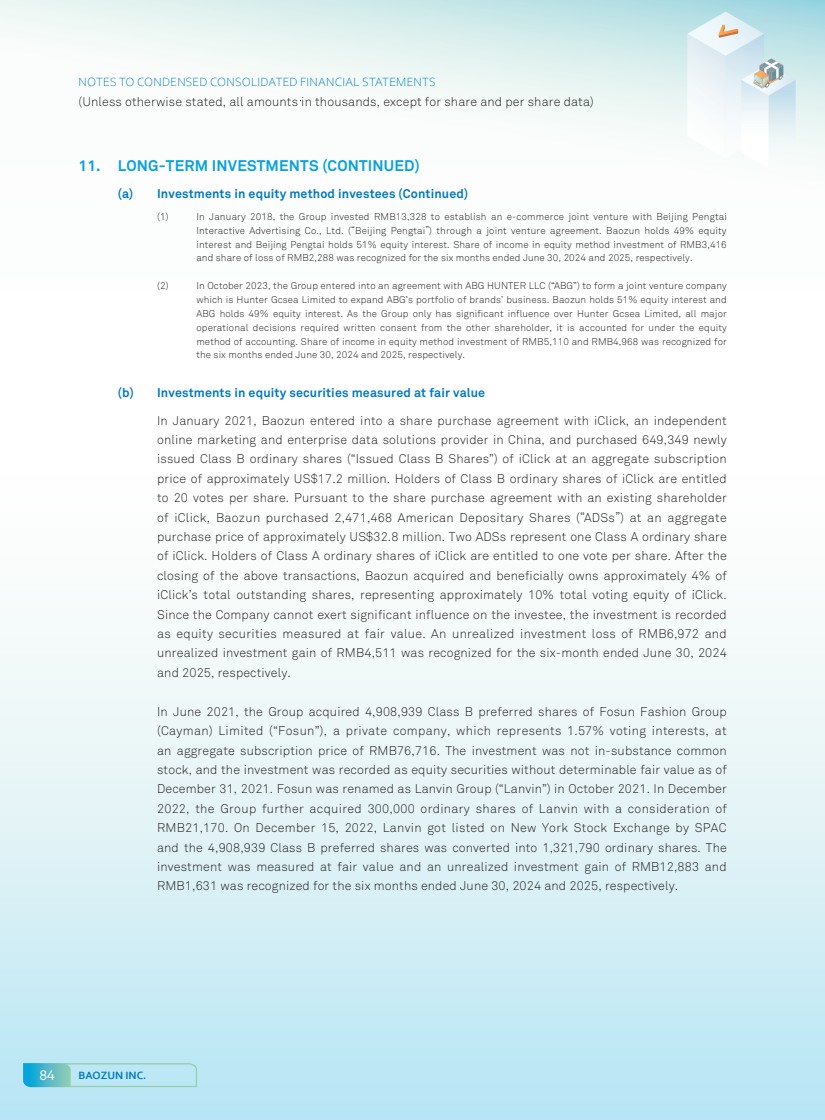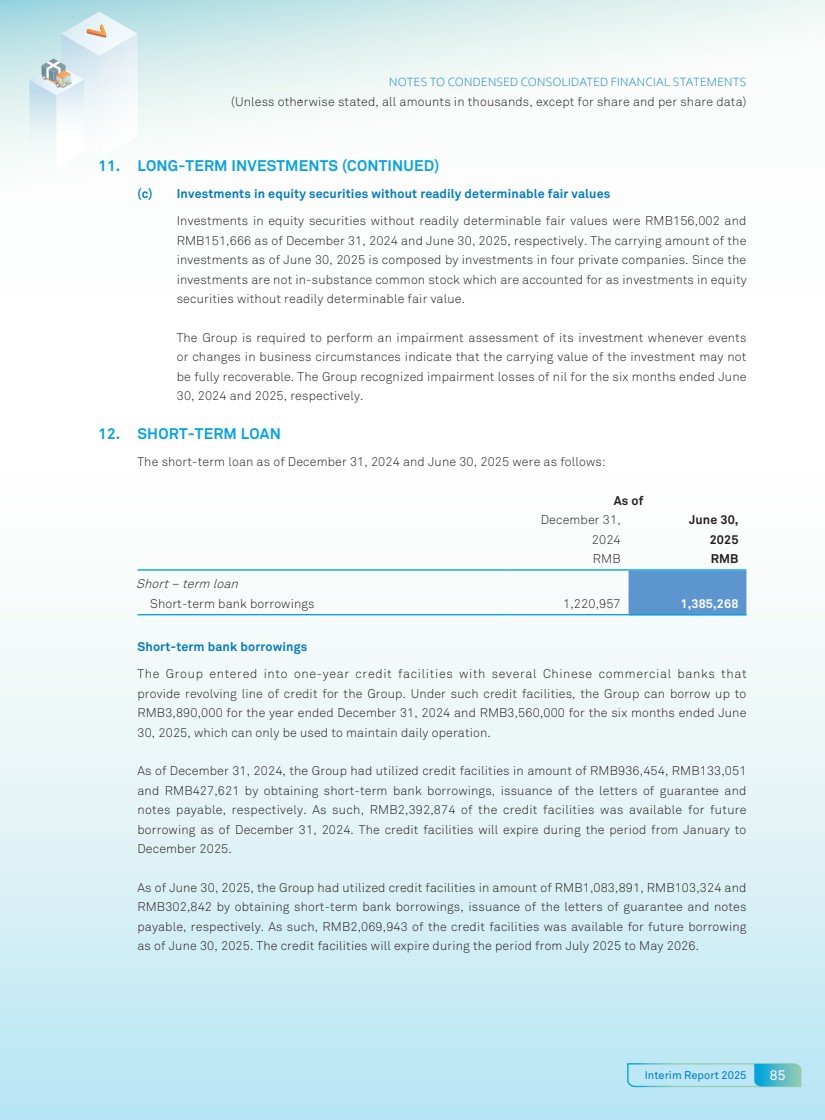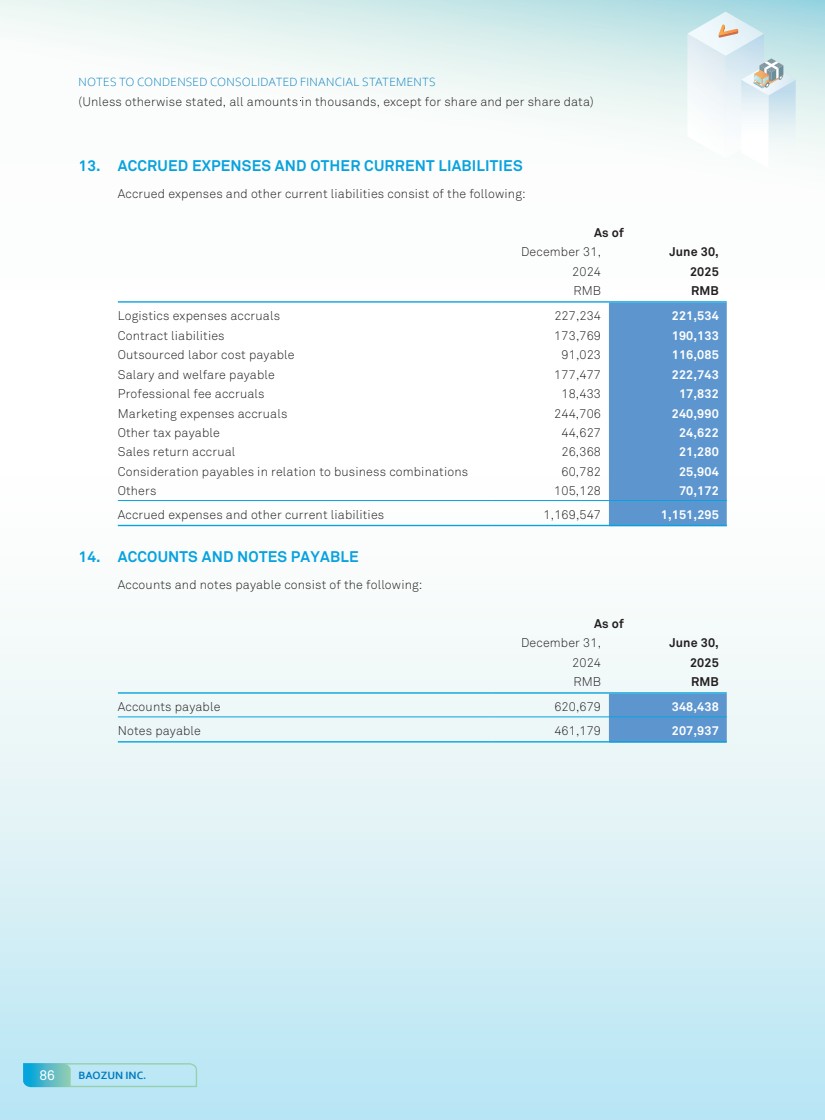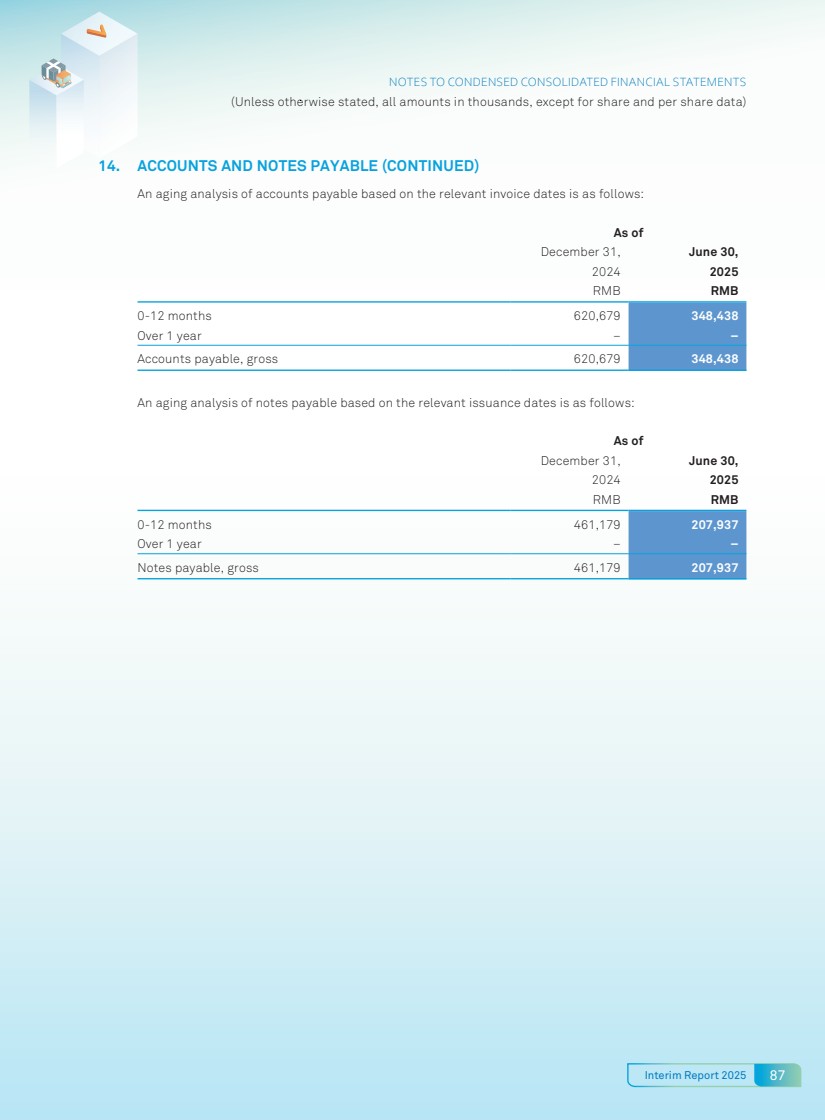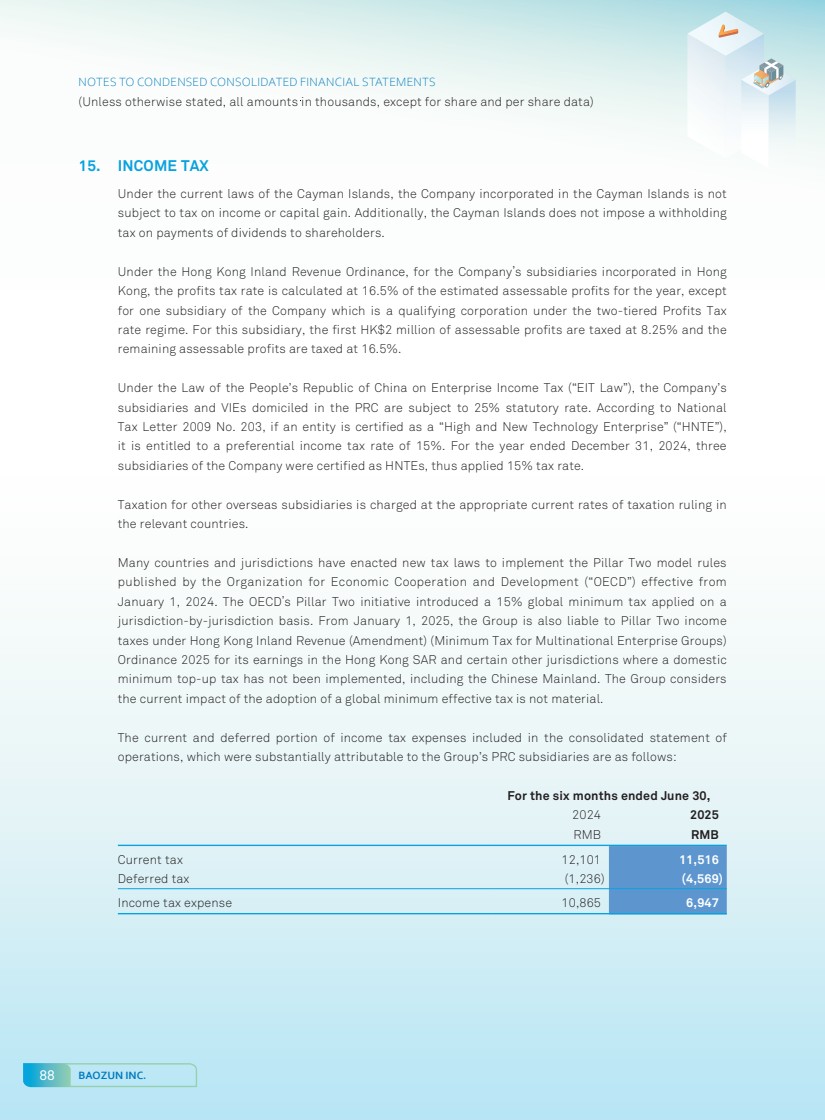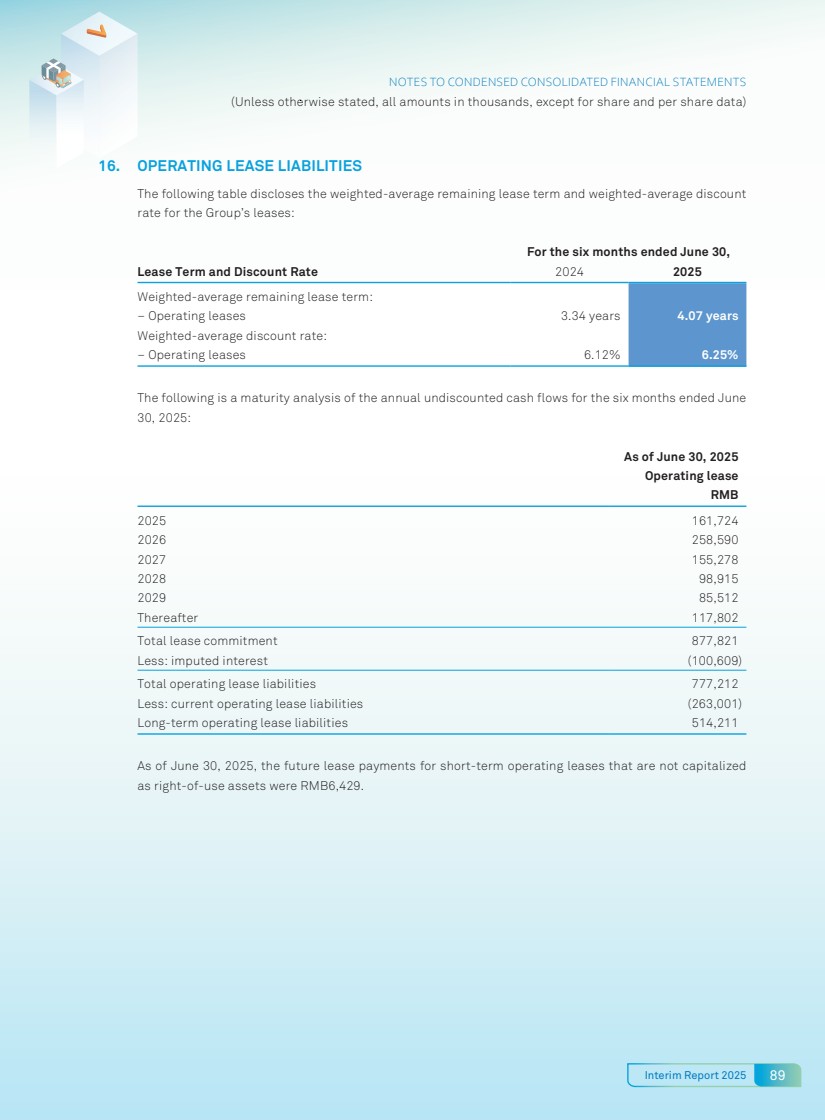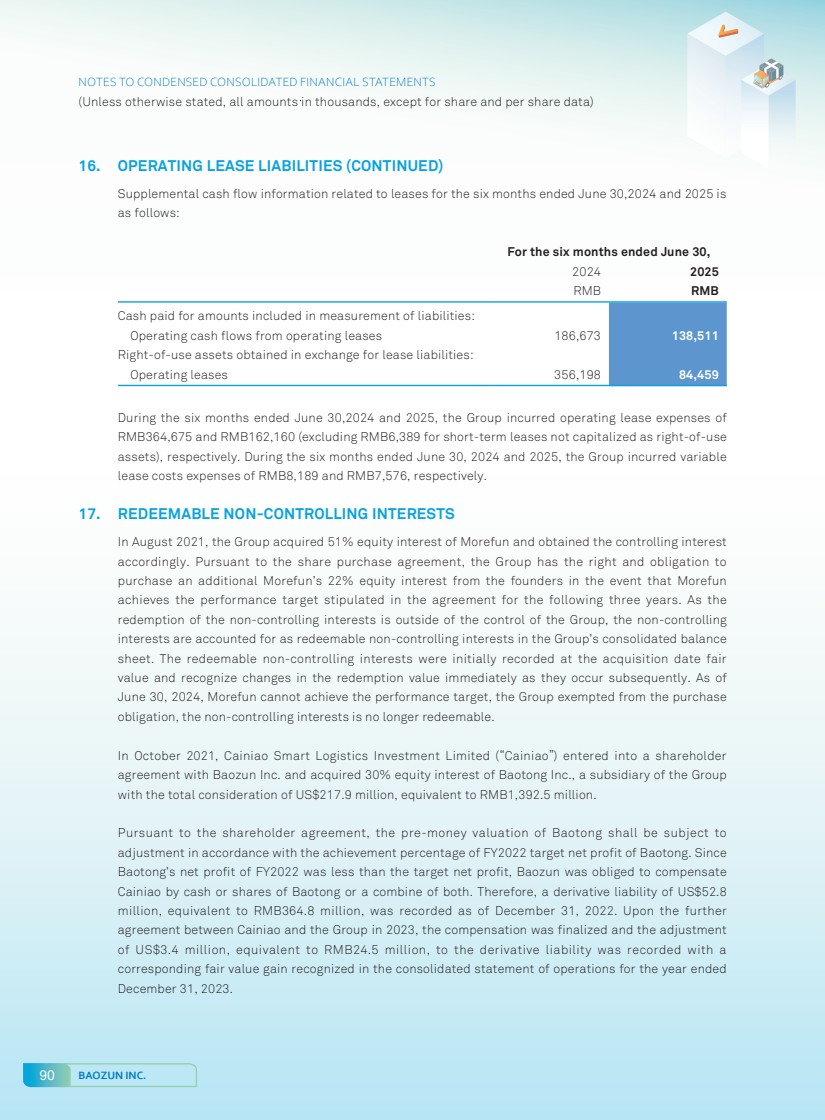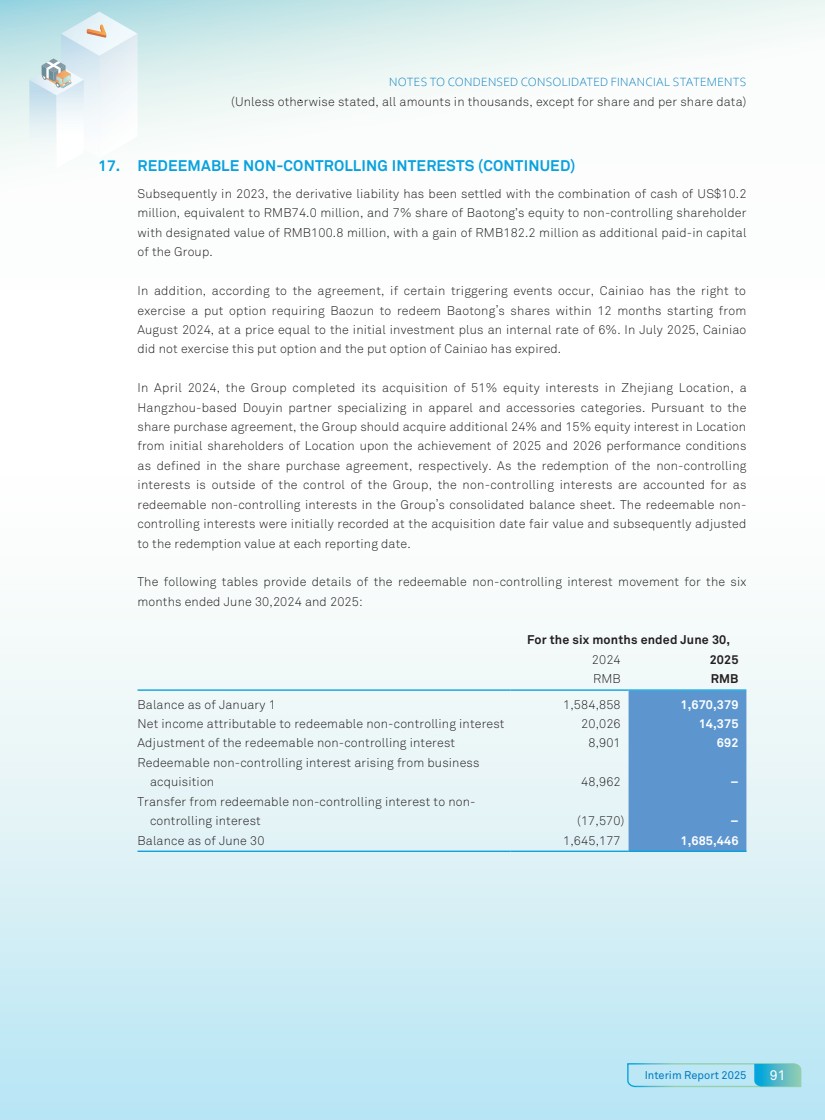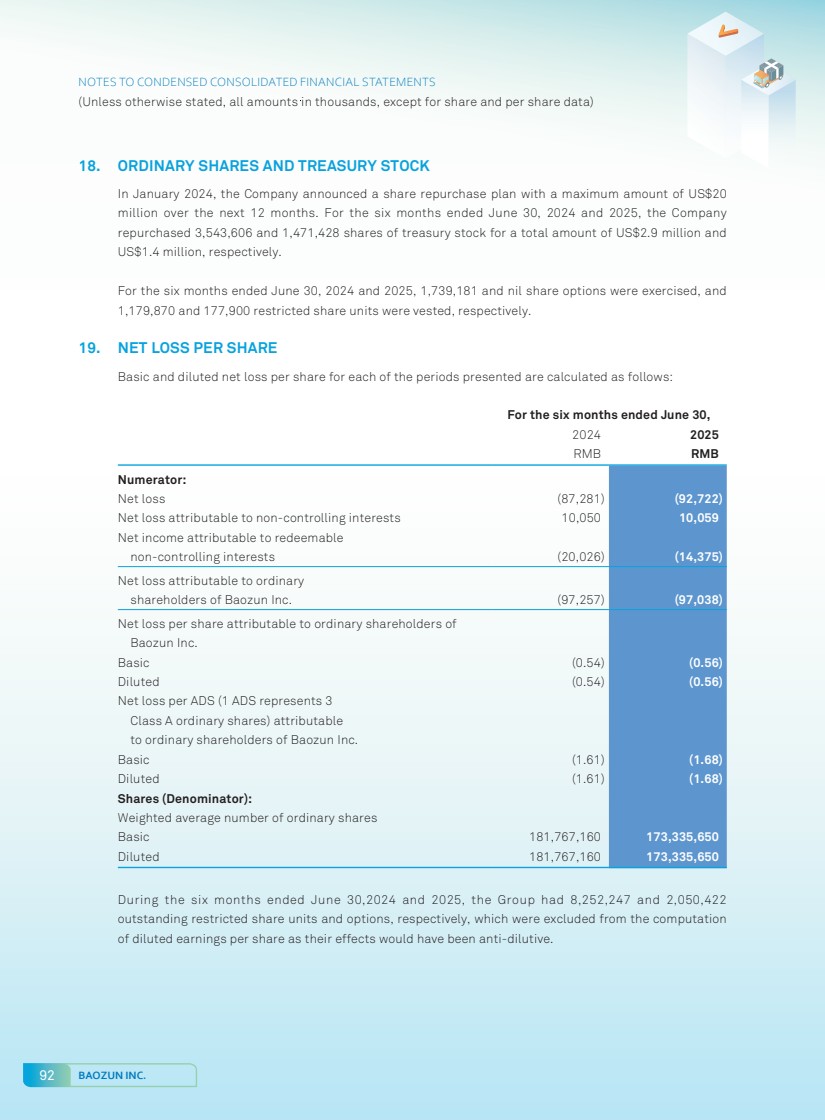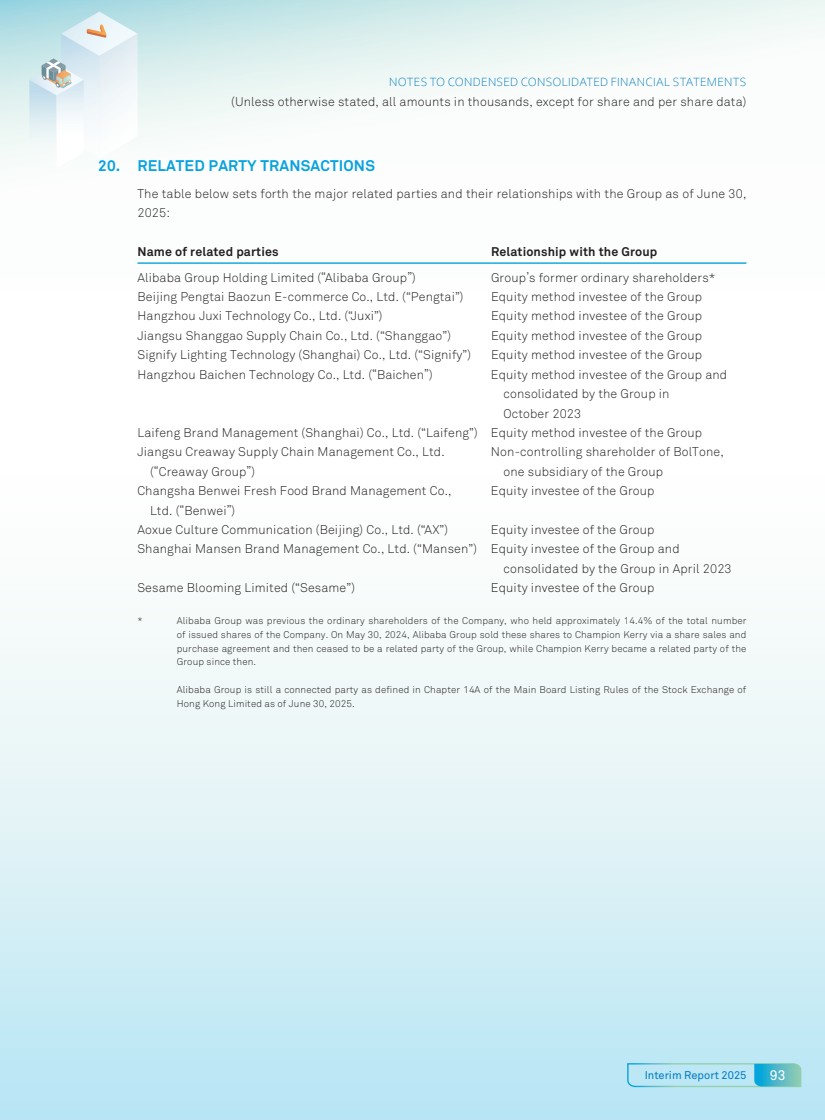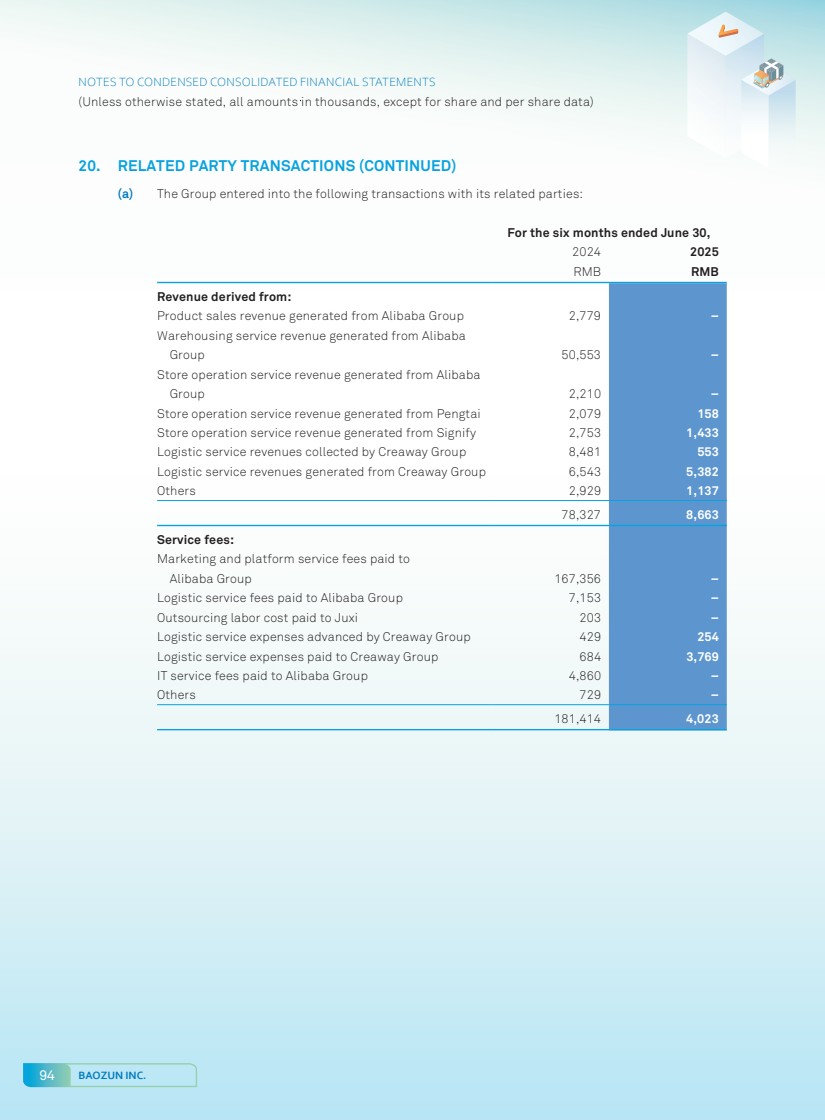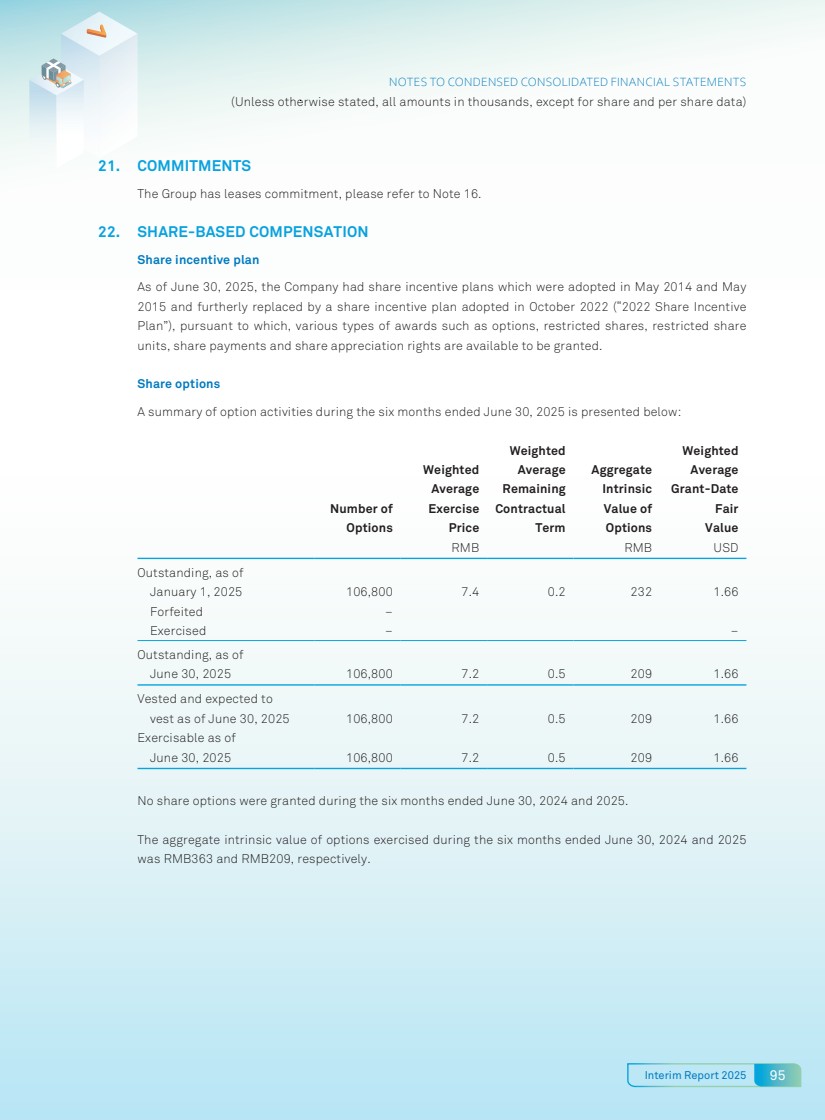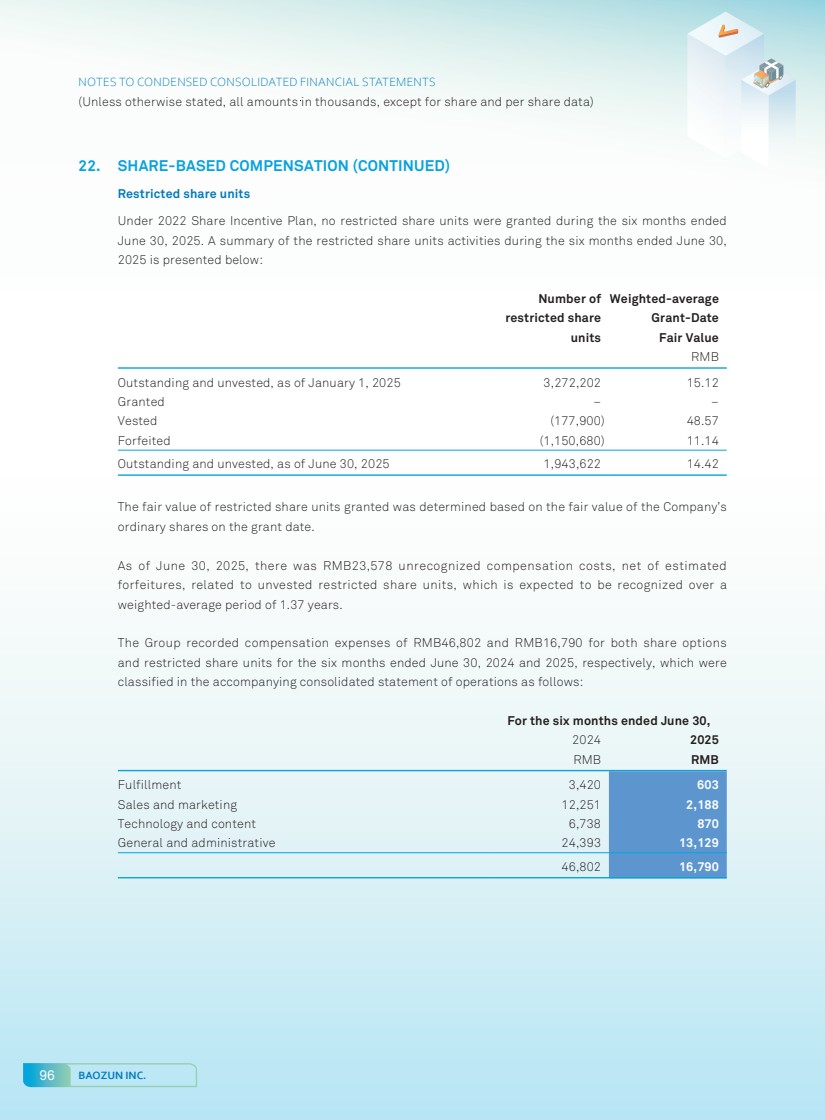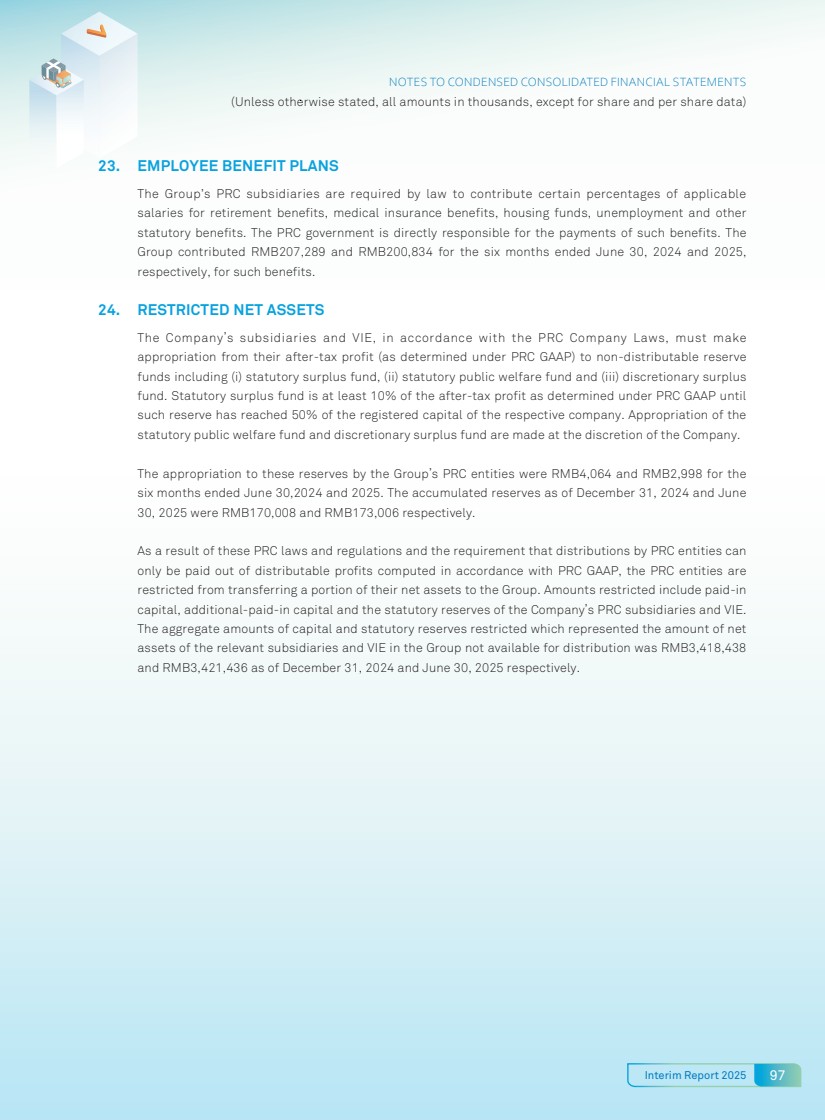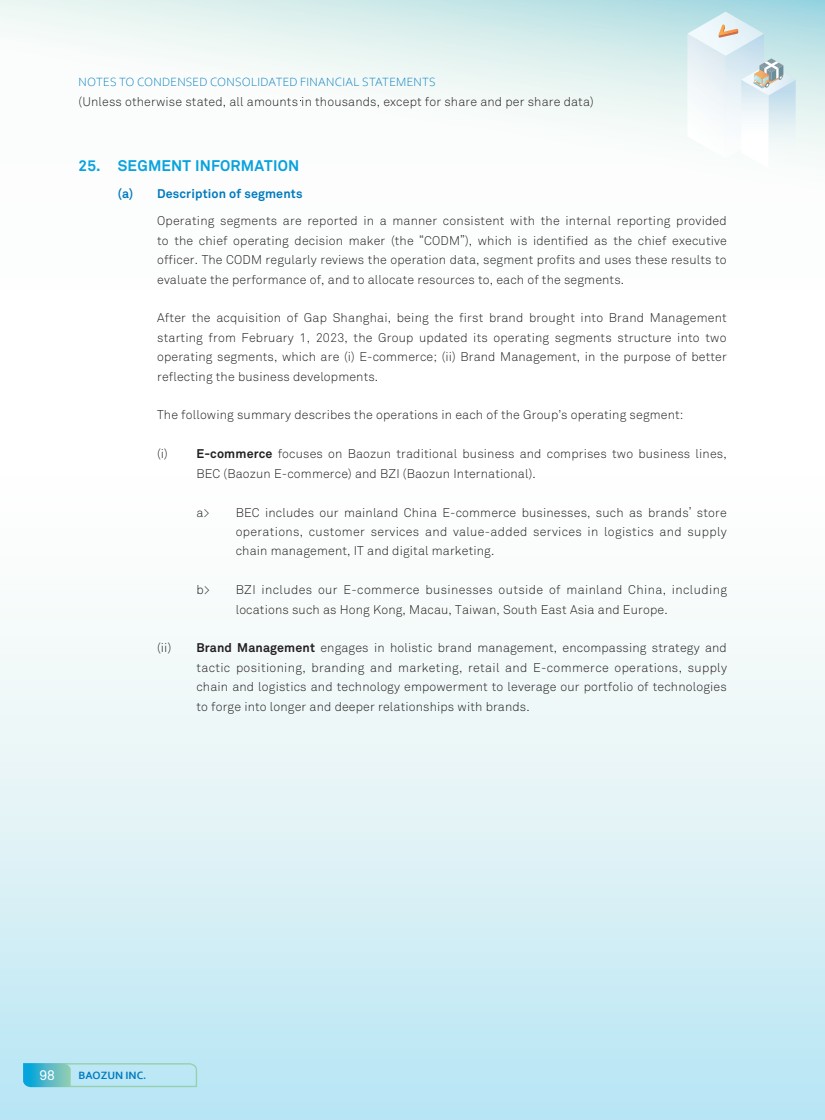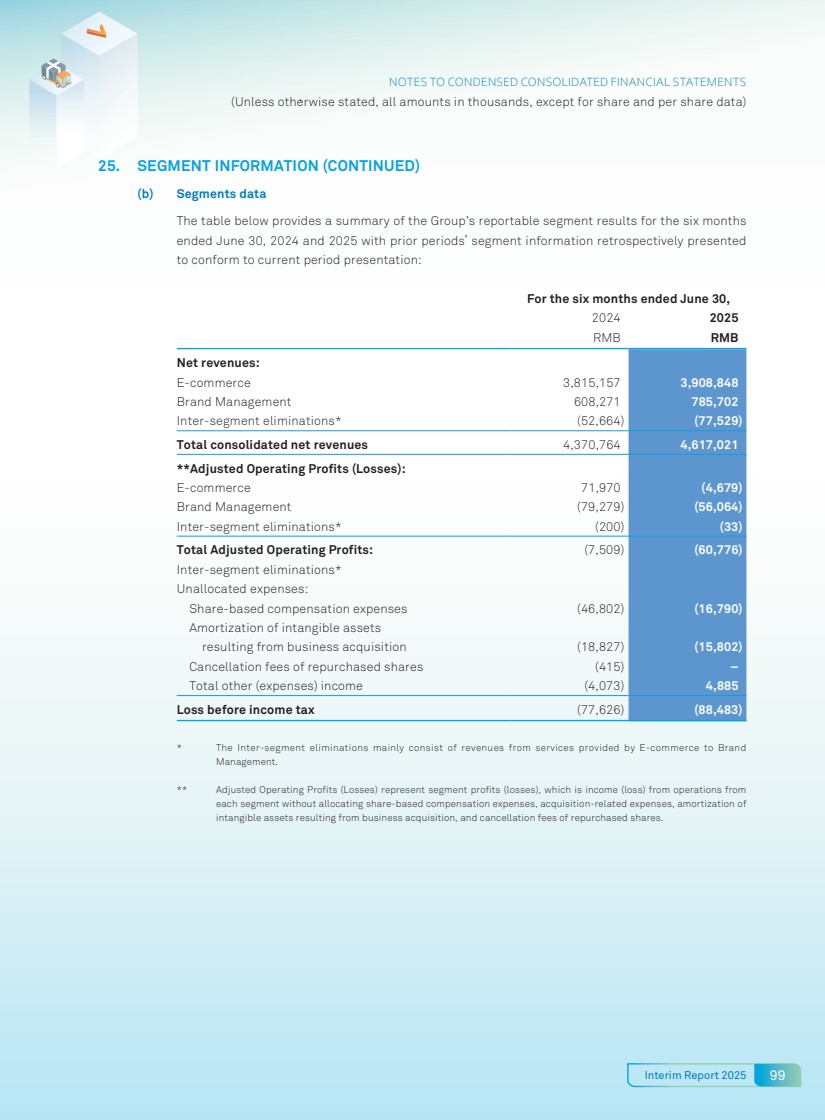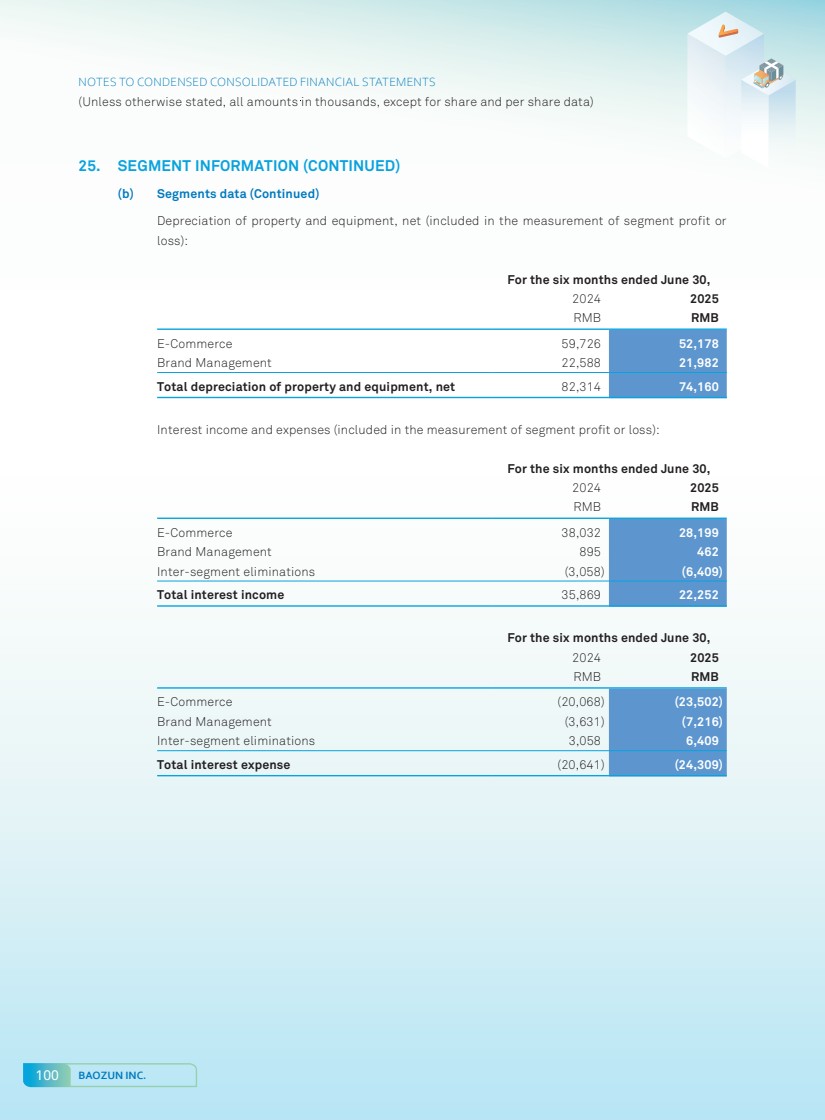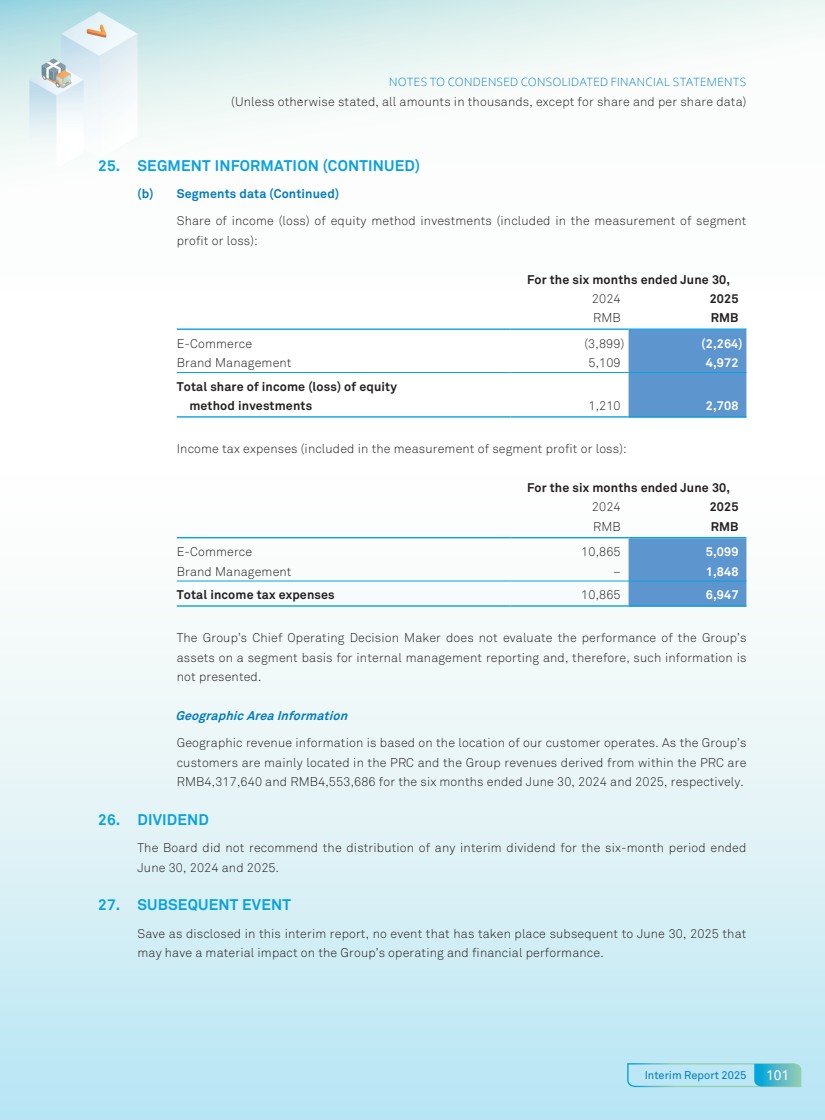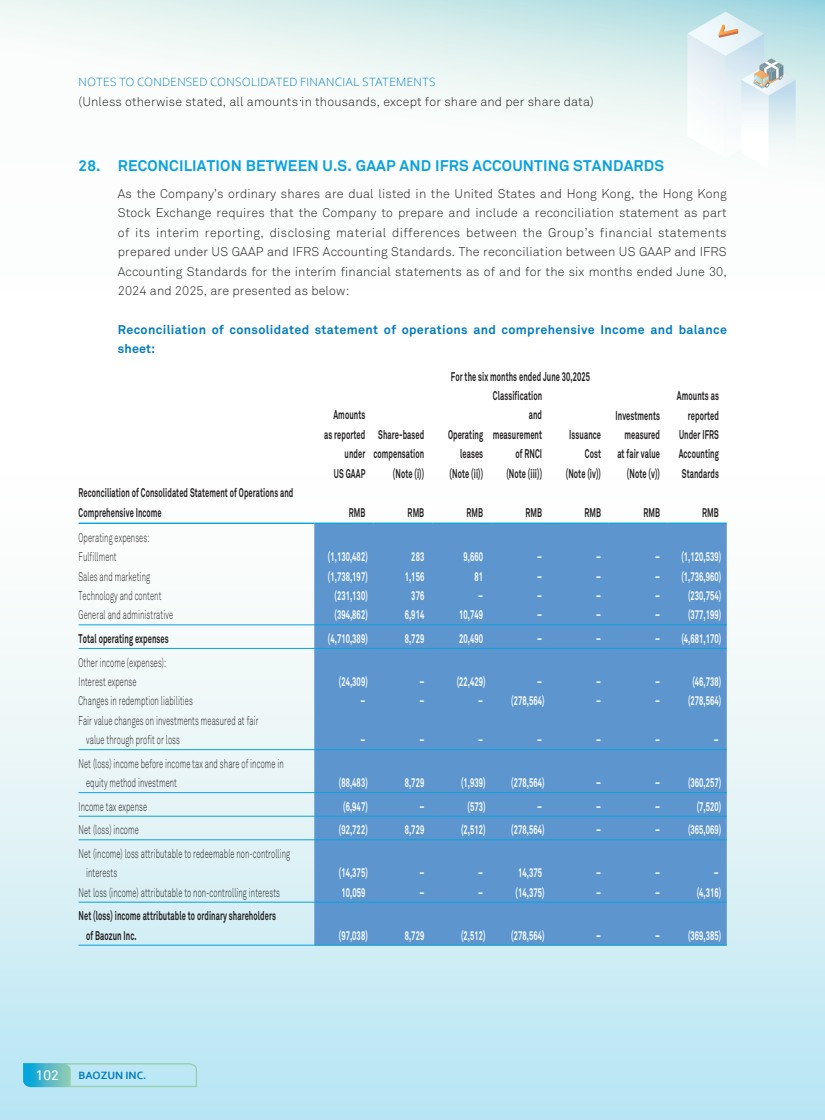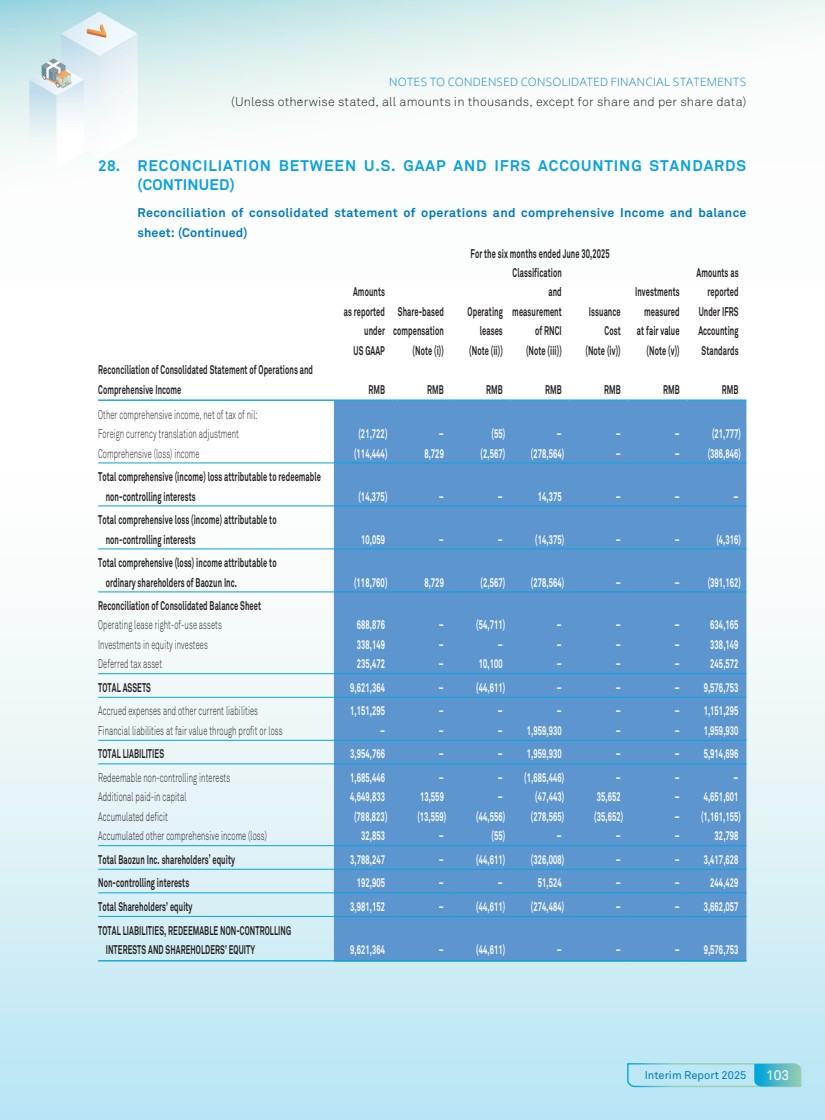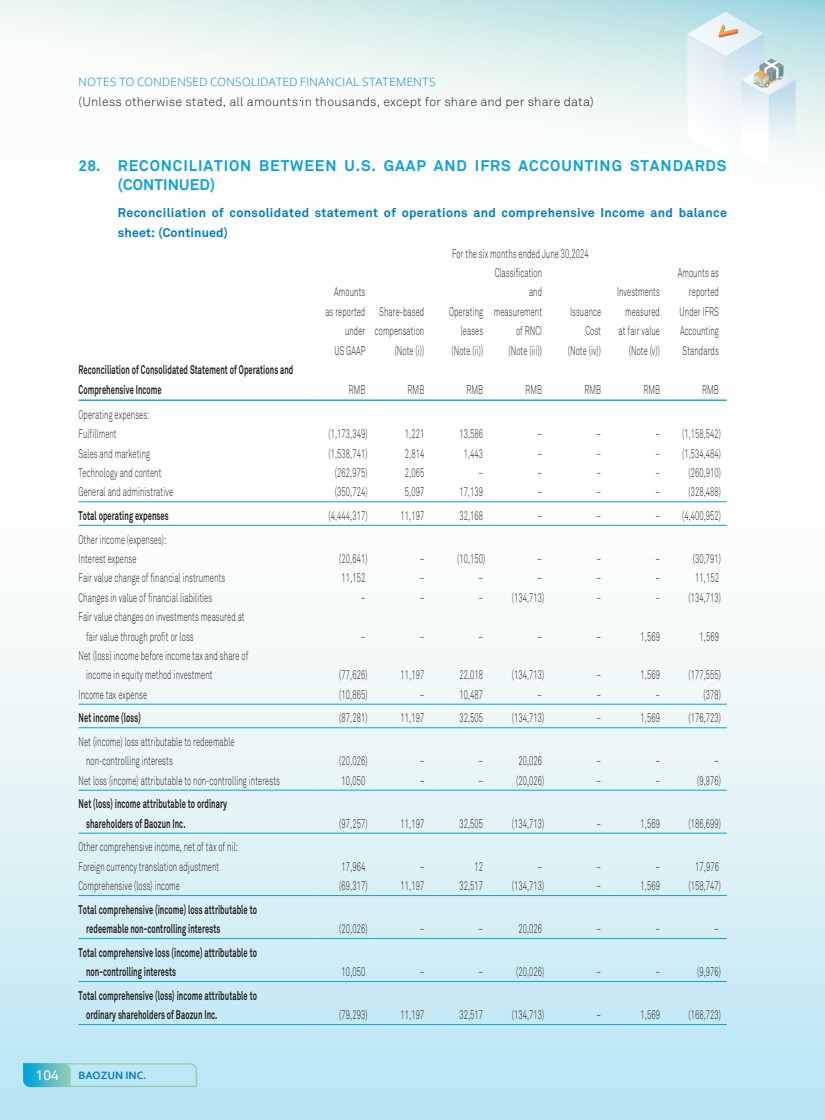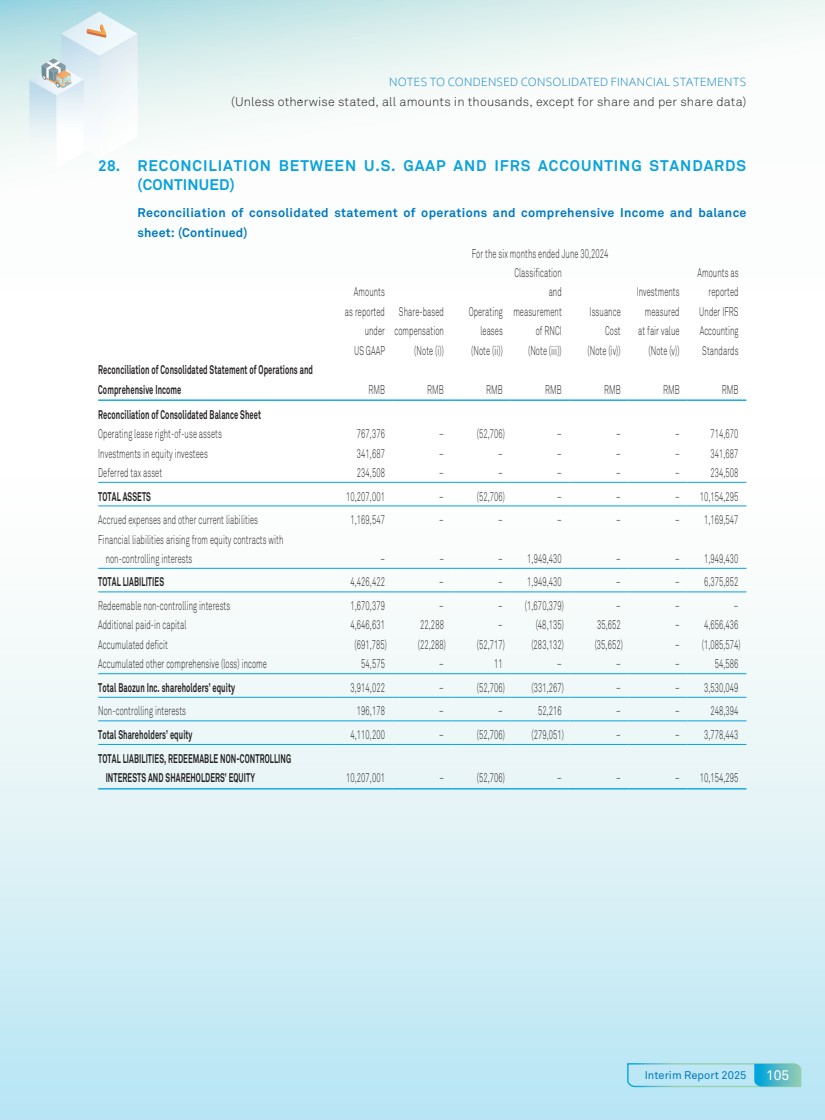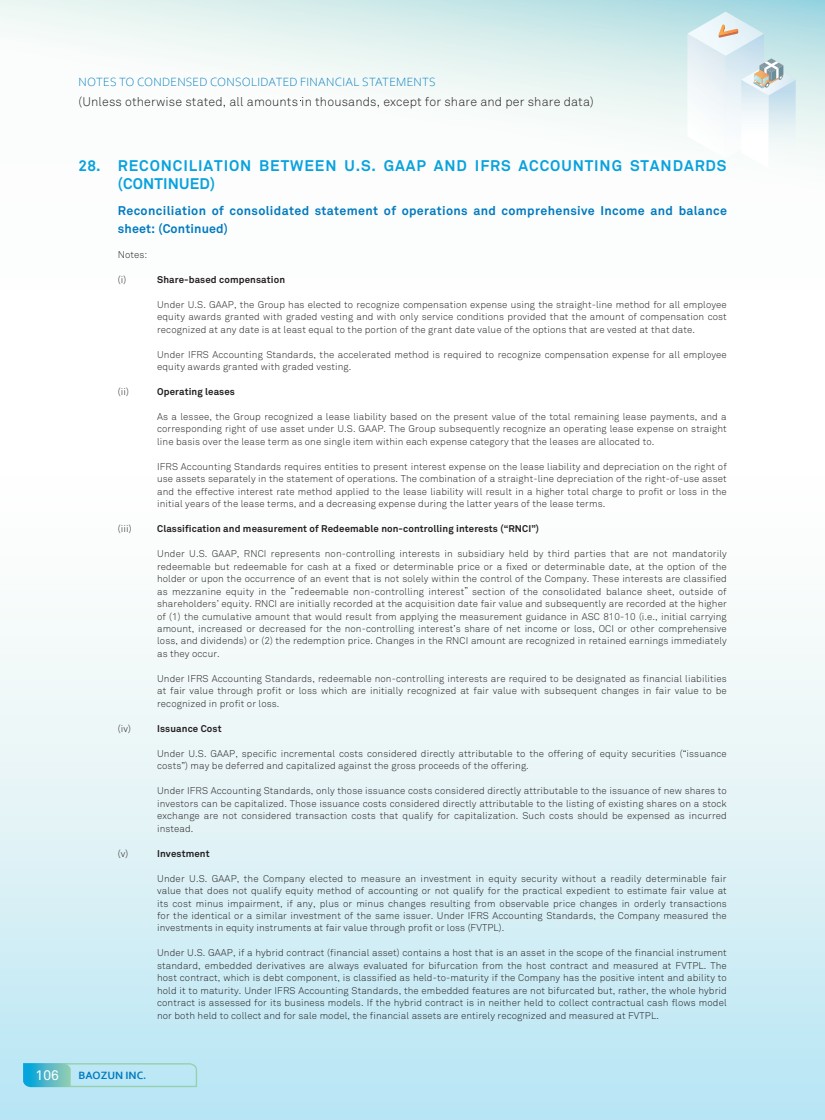| Baozun Inc. 寶尊電商有限公司* (A company controlled through weighted voting rights and incorporated in the Cayman Islands with limited liability) Stock Code : 9991 *For identification purposes only 2025 INTERIM REPORT |
| Definitions 2 Corporate Information 5 Information about Our Weighted Voting Rights 7 Management Discussion and Analysis 9 Other Information 25 Report on Review of Condensed Consolidated Financial Statements 38 Unaudited Condensed Consolidated Balance Sheet 39 Unaudited Condensed Consolidated Statement of Operations 42 Unaudited Condensed Consolidated Statement of Comprehensive Income 44 Unaudited Condensed Consolidated Statement of Changes in Shareholders’ Equity 45 Unaudited Condensed Consolidated Statement of Cash Flows 46 Notes to Condensed Consolidated Financial Statements 49 CONTENTS Interim Report 2025 1 |
| 2 BAOZUN INC. DEFINITIONS In this interim report, unless the context otherwise requires, the following expressions shall have the following meanings: “2014 Plan” the share incentive plan adopted by the Company in May 2014 and terminated in November 2022 “2015 Plan” the share incentive plan adopted by the Company in May 2015 and terminated in November 2022 “2022 Plan” the share incentive plan adopted by the Company in November 2022, as amended or supplemented from time to time “ADS(s)” American Depositary Shares (each representing three Class A ordinary shares) “associate(s)” has the meaning ascribed thereto under the Listing Rules “Audit Committee” the audit committee of the Board “Board” or “Board of Directors” the board of directors of the Company “CG Code” the Corporate Governance Code as set out in Appendix C1 to the Listing Rules, as amended from time to time “China” or “PRC” the People’s Republic of China “Class A ordinary shares” Class A ordinary shares in the share capital of the Company with a par value of US$0.0001 each, conferring a holder of a Class A ordinary share to one vote per share on any resolution tabled at the Company’s general meeting “Class B ordinary shares” Class B ordinary shares in the share capital of the Company with a par value of US$0.0001 each, conferring weighted voting rights in the Company such that a holder of a Class B ordinary share is entitled to ten votes per share on any resolution tabled at the Company’s general meeting “Company” Baozun Inc., a company incorporated in the Cayman Islands as an exempted company with limited liability on December 17, 2013, the Shares of which are listed on the Main Board of the Stock Exchange and the ADS of which are listed on the NASDAQ “Director(s)” director(s) of the Company |
| Interim Report 2025 3 DEFINITIONS “Group”, “we”, “us” or “our” the Company, consolidated subsidiaries and its affiliated consolidated entities, including its variable interest entity and its subsidiaries, from time to time “Hong Kong” or “HK” the Hong Kong Special Administrative Region of the PRC “Hong Kong dollars”, “HKD” or “HK$” Hong Kong dollars, the lawful currency of Hong Kong “U.S. dollars” United States dollar, the lawful currency of United States “Listing” the listing of the Shares on the Main Board “Listing Date” the date of Listing of the Company, i.e. September 29, 2020 “Listing Rules” the Rules Governing the Listing of Securities on the Stock Exchange of Hong Kong Limited, as amended, supplemented or otherwise modified from time to time “Main Board” the stock exchange (excluding the option market) operated by the Stock Exchange which is independent from and operated in parallel with GEM of the Stock Exchange “Model Code” the Model Code for Securities Transactions by Directors of Listed Issuers set out in Appendix C3 to the Listing Rules “Mr. Qiu” Mr. Vincent Wenbin Qiu, our founder, chairman of the Board and chief executive officer “Mr. Wu” Mr. Junhua Wu, one of our co-founders, our Director and chief strategy officer “NASDAQ” Nasdaq Global Select Market in the United States “Primary Conversion” the Company’s voluntary conversion of its secondary listing status in Hong Kong to primary listing on the Stock Exchange effective from November 1, 2022 “Prospectus” the prospectus of the Company dated September 18, 2020 “Renminbi” or “RMB” the lawful currency of the PRC “Reporting Period” the period from January 1, 2025 to June 30, 2025 “RSU(s)” restricted share unit(s) |
| 4 BAOZUN INC. DEFINITIONS “SEC” the Securities and Exchange Commission of the United States “Service Provider(s)” the consultants, dependent contractors or agents (excluding professional advisors and experts) of the Company or a subsidiary “SFO” the Securities and Futures Ordinance of Hong Kong (Chapter 571 of the Laws of Hong Kong), as amended, supplemented or otherwise modified from time to time “Share(s)” the Class A ordinary shares and Class B ordinary shares in the share capital of the Company, as the context so requires “Share Incentive Plans” the 2014 Plan, the 2015 Plan and the 2022 Plan “Shareholder(s)” holder(s) of the Share(s) “Stock Exchange” or “Hong Kong Stock Exchange” The Stock Exchange of Hong Kong Limited * For identification purposes only This interim report contains translations of certain Renminbi (RMB) amounts into U.S. dollars (US$) at a specified rate solely for the convenience of the reader. Unless otherwise noted, the translation of RMB into US$ has been made at RMB7.1636 to US$1.00 for the financial figures in relation to the Reporting Period, RMB7.2993 to US$1.00 for the financial figures in relation to the year ended December 31, 2024, and RMB7.2672 to US$1.00 for the financial figures in relation to the six months ended June 30, 2024, being the noon buying rate in effect on June 30, 2025, December 31, 2024 and June 28, 2024, respectively, as set forth in the H.10 Statistical Release of the Federal Reserve Board. LANGUAGE If there is any inconsistency between the English version and Chinese version of this interim report, the English version shall prevail, provided that if there is any inconsistency between the Chinese names of the entities or enterprises established in the PRC mentioned in this interim report and their English translations, the Chinese names shall prevail. |
| Interim Report 2025 5 CORPORATE INFORMATION BOARD OF DIRECTORS Directors Mr. Vincent Wenbin Qiu (仇文彬) (Founder, Chairperson and Chief Executive Officer) Mr. Junhua Wu (吳駿華) Mr. Satoshi Okada (岡田聡良) Dr. Jun Wang (王俊) Ms. Bin Yu (余濱) Independent Directors Mr. Yiu Pong Chan Mr. Steve Hsien-Chieng Hsia Mr. Benjamin Changqing Ye (葉長青) AUDIT COMMITTEE Mr. Benjamin Changqing Ye (葉長青) (Chairman) Mr. Yiu Pong Chan Mr. Steve Hsien-Chieng Hsia COMPENSATION COMMITTEE Mr. Yiu Pong Chan (Chairman) Mr. Steve Hsien-Chieng Hsia Mr. Benjamin Changqing Ye (葉長青) NOMINATING AND CORPORATE GOVERNANCE COMMITTEE Mr. Steve Hsien-Chieng Hsia (Chairman) Mr. Yiu Pong Chan Mr. Benjamin Changqing Ye (葉長青) Ms. Bin Yu (余濱) (appointed on May 21, 2025) JOINT COMPANY SECRETARIES Ms. Wendy Shu Sun (孫舒) (appointed on March 20, 2025) Mr. Arthur Yu (resigned on March 20, 2025) Ms. So Ka Man AUTHORISED REPRESENTATIVES Mr. Vincent Wenbin Qiu Ms. So Ka Man REGISTERED OFFICE Vistra (Cayman) Limited P.O. Box 31119 Grand Pavilion, Hibiscus Way 802 West Bay Road Grand Cayman, KY1-1205 Cayman Islands PRINCIPAL EXECUTIVE OFFICES OF MAIN OPERATIONS No. 1-9, Lane 510, West Jiangchang Road Shanghai 200436, China PRINCIPAL PLACE OF BUSINESS IN HONG KONG Room 1928, 19/F, Lee Garden One 33 Hysan Avenue Causeway Bay Hong Kong CAYMAN ISLANDS PRINCIPAL SHARE REGISTRAR AND TRANSFER OFFICE Vistra (Cayman) Limited P.O. Box 31119 Grand Pavilion, Hibiscus Way 802 West Bay Road Grand Cayman, KY1-1205 Cayman Islands HONG KONG BRANCH SHARE REGISTRAR Computershare Hong Kong Investor Services Limited Shops 1712-1716 17th Floor, Hopewell Centre 183 Queen’s Road East Wan Chai, Hong Kong AUDITOR KPMG Public Interest Entity Auditor registered under the Accounting and Financial Reporting Council Ordinance 8th Floor, Prince’s Building, 10 Chater Road Central, Hong Kong |
| 6 BAOZUN INC. CORPORATE INFORMATION LEGAL ADVISOR Davis Polk & Wardwell 10th Floor The Hong Kong Club Building 3A Chater Road Hong Kong PRINCIPAL BANKERS Ping An Bank Co., Ltd. 14/F, No. 5047 Shennan Road East Shenzhen PRC STOCK CODE HKEX: 9991 NASDAQ: BZUN WEBSITE www.baozun.com |
| Interim Report 2025 7 INFORMATION ABOUT OUR WEIGHTED VOTING RIGHTS WEIGHTED VOTING RIGHT STRUCTURE Under our weighted voting rights structure, our share capital comprises Class A ordinary shares and Class B ordinary shares. Each Class A ordinary share entitles the holder to exercise one vote, and each Class B ordinary share entitles the holder to exercise ten votes, respectively, on any resolution tabled at the Company’s general meetings, except as may otherwise required by law or by the Listing Rules or provided for in our Memorandum and Articles of Association. Shareholders and prospective investors should be aware of the potential risks of investing in a company with a weighted voting rights structure. Our American Depositary Shares, each representing three of our Class A ordinary shares, are listed on the Nasdaq Global Select Market in the United States under the symbol BZUN. Each Class B ordinary share is convertible into one Class A ordinary share at any time by the holder thereof. Upon the conversion of all the issued and outstanding Class B ordinary shares into Class A ordinary shares, the Company will issue 13,300,738 Class A ordinary shares, representing approximately 8.31% of the total number of issued and outstanding Class A ordinary shares or 7.67% of the enlarged issued and outstanding shares of the Company (without taking into account any shares to be issued underlying the unexercised options, the unvested RSUs or other awards may be granted from time to time pursuant to the 2014 Plan, the 2015 Plan and the 2022 Plan, and any Shares repurchased but pending cancellation and treasury shares) as of June 30, 2025. WVR BENEFICIARY As of June 30, 2025, the weighted voting rights (“WVR”) beneficiaries are Mr. Vincent Wenbin Qiu, our founder, chairman of the Board and chief executive officer and Mr. Junhua Wu, our co-founder, director and chief strategy officer. Mr. Vincent Wenbin Qiu Mr. Qiu is interested in and controls, through Jesvinco Holdings Limited, a company wholly owned by Mr. Qiu, 10 Class A ordinary shares and 9,410,369 Class B ordinary shares. Mr. Qiu also beneficially owns 4,429,366 Class A ordinary shares, comprising 810,000 Class A ordinary shares underlying unvested restricted share units under the 2022 Plan. As of June 30, 2025, Mr. Qiu controlled 33.35% of the aggregate voting power of our Company (excluding the treasury shares held by the Company and the Shares repurchased by the Company but pending cancellation). Mr. Junhua Wu Mr. Wu is interested in and controls, through Casvendino Holdings Limited, a company wholly owned by Mr. Wu, 2,764,707 Class A ordinary shares (comprising 130,500 Class A ordinary shares underlying unvested restricted share units under the 2015 Plan) and 3,890,369 Class B ordinary shares. Mr. Wu also beneficially owns 46,752 Class A ordinary shares. As of June 30, 2025, Mr. Wu controlled 14.19% of the aggregate voting power of our Company (excluding the treasury shares held by the Company and the Shares repurchased by the Company but pending cancellation). |
| 8 BAOZUN INC. INFORMATION ABOUT OUR WEIGHTED VOTING RIGHTS The Company’s WVR structure enables the WVR beneficiaries to exercise voting control over the Company notwithstanding that the WVR beneficiaries do not hold a majority economic interest in the share capital of the Company. This will enable the Company to benefit from the continuing vision and leadership of the WVR beneficiaries who will control the Company with a view to its long-term prospects and strategy. Prospective investors are advised to be aware of the potential risks of investing in companies with weighted voting rights structures, in particular that interests of the WVR beneficiaries may not necessarily always be aligned with those of our Shareholders as a whole, and that the WVR beneficiaries will be in a position to exert significant influence over the affairs of our Company and the outcome of Shareholders’ resolutions, irrespective of how other Shareholders vote. Prospective investors should make the decision to invest in the Company only after due and careful consideration. Upon any sale, transfer, assignment or disposition of beneficial ownership of any Class B ordinary shares by a holder thereof to any person or entity that is not an Affiliate (as defined in our Articles of Association) of such holder, such Class B ordinary shares will be automatically and immediately converted into an equal number of Class A ordinary shares. As the Company was initially listed as a grandfathered greater China issuer pursuant to Chapter 19C of the Listing Rules with a WVR structure, certain shareholder protection measures and governance safeguards under Chapter 8A of the Listing Rules do not apply to the Company pursuant to Rule 8A.46 of the Listing Rules. The relevant exemptions pursuant to Chapter 8A of the Listing Rules continue to apply after the Primary Conversion. |
| Interim Report 2025 9 MANAGEMENT DISCUSSION AND ANALYSIS BUSINESS OVERVIEW We are a leading pioneer in the brand e-commerce service industry and a digital commerce enabler in China. We empower a diverse range of brands to grow and succeed by leveraging our end-to-end e-commerce service capabilities, omni-channel expertise, and technology-driven solutions. Recognizing the growing convergence of online and offline commerce, we view this trend as a significant opportunity. Adhering to our vision of “Technology Empowers Future Success”, our advanced technology and operating platforms provide a unified and robust foundation that supports our expanded range of services and markets. In 2023, we expanded our businesses into three business lines – Baozun E-commerce (BEC), Baozun Brand Management (BBM) and Baozun International (BZI). Starting from the first quarter of 2023, we have two operating segments: E-Commerce (encompassing BEC and BZI) and Brand Management (representing BBM). Baozun e-Commerce includes our China e-commerce businesses, such as brands’ store operations, customer services and value-added services in logistics and supply chain management, IT, and digital marketing. Baozun Brand Management engages in holistic brand management, including strategy and tactic positioning, branding and marketing, retail and e-commerce operations, supply chain and logistics, and technology empowerment. We aim to leverage our portfolio of technologies to establish longer and deeper relationships with brands. Baozun International is a long-term opportunity that we will patiently invest in and explore. We have a distinct advantage to replicate our China e-commerce success. Baozun International will empower brands with local market insights and critical e-commerce infrastructure, serving local consumers through a wide product selection and differentiated customer experience. The expansion of Baozun group into three business lines – BEC, BBM and BZI, is aimed at creating a virtuous ecosystem in which each division brings value to the others. Our 18 years of expertise and technological advancements in the e-commerce industry have allowed us to rapidly increase our scale and establish deeper relationships with brand partners. Our strategy capitalizes on virtuous cycles and synergies across our business lines. Our revenue increased by 5.6% from RMB4,370.8 million for the six months end June 30, 2024 to RMB4,617.0 million for the same period in 2025, primarily driven by both of the Group’s two operating segments. Our non-GAAP operating loss increased from RMB7.5 million for the six months ended June 30, 2024 to RMB60.8 million for the same period in 2025, primarily due to write-down of accounts receivable totaling RMB53.3 million. Excluding this write-down, non-GAAP operating loss was flat year-over-year. |
| 10 BAOZUN INC. MANAGEMENT DISCUSSION AND ANALYSIS Baozun E-Commerce (BEC) Baozun e-Commerce includes our China e-commerce businesses, such as brands’ store operations, customer services and value-added services covering warehousing and fulfillment, IT, and digital marketing. We empower a broad and diverse range of brands to grow and succeed by leveraging our end-to-end e-commerce service capabilities, omni-channel expertise, and technology-driven solutions. Our competitive advantages have enabled us to achieve rapid growth in our brand partnerships. We collaborate with global leaders in their respective verticals, including brands like Philips, Nike, and Microsoft. Our ability to help brand partners navigate the challenges arising from the macroeconomy, by leveraging our efficient e-commerce operational capabilities and effective omni-channel solutions, demonstrates the value of our services. With our deep understanding of the needs of various brands, we are able to offer value propositions that set us apart from other market players. • Multi-category, multi-brand capabilities: Our capabilities extend across multiple categories and brands of different types, scales, and stages of development. We possess in-depth industry-specific domain knowledge that spans the entire e-commerce value chain. • Full-scope services: We provide integrated one-stop solutions to address all core aspects of e-commerce operations, including IT solutions, online store operations, digital marketing, customer service, and warehousing and fulfilment. Our ability to provide one-stop e-commerce solutions is backed by our proprietary and robust technology stack, including our Cloud-based System that enables efficient setup of official brand stores and official marketplace stores, ROSS that facilitates smooth and efficient online store operations; big data analytics and AI capabilities that drive our efficient and effective digital marketing solutions; customer relationship management, or CRM, that supports attentive real-time pre-sale and post-sale customer services and engagement; and order management system, or OMS, and warehouse management system, or WMS, that enable integrated and reliable multi-category warehousing and fulfillment services. We remain committed to investing in new technologies and infrastructure to provide innovative and reliable solutions to our brand partners. • Omni-channel coverage: We help brand partners adapt to and thrive in China’s complex e-commerce ecosystem and evolving e-commerce landscape. We enable brands to integrate online and offline operations. We help brand partners formulate and implement coherent e-commerce strategies, which require holistic performance analysis across channels and balanced tactics for different platforms. Based on the different needs of our brand partners, we operate under three business models: the distribution model, the service fee model, and the consignment model. We generate product sales revenues primarily through selling the products that we purchase from our brand partners and/or their authorized distributors to consumers under the distribution model, and derive services revenues primarily through charging brand partners and other customers fees under the service fee model and the consignment model. |
| Interim Report 2025 11 MANAGEMENT DISCUSSION AND ANALYSIS Our Business Models and Solutions Through our integrated brand e-commerce capabilities, we provide end-to-end brand e-commerce solutions that cater to our brand partners’ unique needs. We leverage our brand partners’ resources and seamlessly integrate with their back-end systems to enable data analytics for the entire transaction value chain, making our services a crucial part of our brand partners’ e-commerce functions. Our e-commerce capabilities encompass every aspect of the e-commerce value chain, including online store operations, customer service, IT solutions, digital marketing, warehousing, and fulfillment. Depending on each brand partner’s specific needs and the characteristics of its product category, our brand partners utilize one or a blend of our solutions under one or a combination of our business models: the distribution model, the service fee model, and the consignment model. Operational Highlights of BEC For the Six Months Ended June 30, 2025 During the first six months ended June 30, 2025, service revenue grew by 1.8%, primally driven by strong digital marketing demand from brand partners and strong performance of sportswear and apparel category. Omni-channel expansion remains a key theme for our brand partners. We continued to further enhance our omni-channel capabilities. As of June 30, 2025, approximately 48.5% of our brand partners engaged with us for store operations of at least two channels, compared to 45.8% at the end of same period of last year. |
| 12 BAOZUN INC. MANAGEMENT DISCUSSION AND ANALYSIS Baozun Brand Management (BBM) Baozun Brand Management engages in holistic brand management and serves as an all-rounded partner for global brands to further unlock their business potential in China. BBM offers expertise in strategy and tactic positioning, branding and marketing, retail and e-commerce operations, supply chain and logistics, and technology empowerment. We aim to leverage our portfolio of technologies to establish longer and deeper relationships with brands. BBM targets the mid-end and premium consumer lifestyle brands segment. Our first key acquisition was the Gap China business. On November 8, 2022, we entered into a share purchase agreement with The Gap, Inc. and Gap (UK Holdings) Ltd. for the acquisition of the entire equity interests in two of their operating entities – Gap (Shanghai) Commercial Co., Ltd. and Gap Taiwan Limited – which operate the full business of Gap in Greater China. Concurrently, we and The Gap, Inc. established a series of business arrangements under which The Gap, Inc. granted us the exclusive rights to manufacture, market, distribute, and sell Gap products in Greater China, including the ability to localize the offering. For details, please refer to the announcement made by the Company on November 8, 2022. The acquisition of Gap (Shanghai) Commercial Co., Ltd. was completed on January 31, 2023. As a result, we began operating The Gap, Inc.’s business in Mainland China, Hong Kong, and Macao starting February 1, 2023. For details, please refer to the announcement made by the Company on February 1, 2023. Meanwhile, we, together with The Gap, Inc. and Gap (UK Holdings) Ltd., have been working to complete the acquisition of Gap Taiwan Limited (the “TW Transfer”). However, due to a prolonged delay in obtaining necessary approvals, on August 27, 2025, after due and careful consideration, we reached agreement with The Gap, Inc. and Gap (UK Holdings) Ltd. not to proceed with the TW Transfer. The Company considers that the termination does not have any material adverse impact on the financial position and operations of the Group. Additionally, in 2023, we and ABG Hunter LLC, a subsidiary of Authentic Brands Group, entered into a Hunter Greater China and Southeast Asia Term Sheet for Baozun’s acquisition of 51% equity interest in a special purpose vehicle established by ABG Hunter LLC. This vehicle holds the relevant intellectual property of Hunter brands in Greater China and Southeast Asia. At the same time, an affiliate of Baozun entered into a license agreement with ABG Hunter LLC, under which ABG Hunter LLC grants Baozun’s affiliate the exclusive right to manufacture, market, distribute, and sell Hunter brand products in Greater China. Our technologies and insights enable us to forge a sustainable, symbiotic relationship between physical retail and online commerce. We aim to deliver the best-in-class, seamless omni-channel experience by integrating the digital and the physical at scale, and to excel where few have done so in retail. We are evolving into a leading brand management company of iconic brands through a combination of transformative acquisitions and the consistent growth of our brands in China across all channels. |
| Interim Report 2025 13 MANAGEMENT DISCUSSION AND ANALYSIS GAP overview GAP is one of the world’s most recognized lifestyle brands, uplifting and inspiring consumers since 1969. The brand creates iconic style, which builds on its heritage grounded in denim and khakis and comes alive at the intersection of the classic and the new. GAP is an authority on modern American style. GAP represents a good example for BBM to build its business model and achieve the target of integrating digital technology, retail, and brands. Our current priorities include ensuring a smooth post-acquisition transition, refining products and merchandizing strategies, building supply chain infrastructures, and upgrading back-end systems, including talents and technologies, to pursue our technology-empowered, China-for-China, and digitalized modern new retail model. Our key strategic pillars for 2025 focus on merchandising, channel expansion and marketing initiatives for Gap, aimed at building healthy topline momentum while continuing to improve profitability. As of June 30, 2025, we operated 156 offline stores for GAP in mainland China. While most stores are located in first- and second-tier cities, the brand continues to expand into other high-potential cities across China. We plan to open approximately 40 new stores in 2025 and will continue to optimize our store structure and locations. Product Management China-for-China products remain our core priority. It is essential for us to interpret the GAP’s brand DNA in a way that resonate with the Chinese market. Our designs are guided by data insights and executed through a much shorter supply chain cycle. In the first half of 2025, we also launched several successful IP collaborations, including Forbidden City and Melting Sadness. These collections showcased our ability to blend China’s rich cultural heritage and fashion trends with GAP’s brand DNA – emphasizing comfort, safety, and quality. Retail Management With a consumer-centric and retail-oriented strategy, we have successfully improved our competitiveness, store efficiency, and responsiveness to the ever-changing market. During the Reporting Period, we continued to optimize our retail management capabilities. We aimed to open more “quality” neighborhood stores, such as those in Shanghai POPC, Beijing Tongzhou MixC, Haikou Longfor. These strategically located stores not only drive business but also enhance profitability. Additionally, we co-opened stores in Shenyang, Guiyang, Xi’an and many other cities with our local strategic partners, creating mutual benefits. Strong partnerships facilitate faster store openings, particularly in second- and third-tier cities, and enhance investment efficiency. |
| 14 BAOZUN INC. MANAGEMENT DISCUSSION AND ANALYSIS Supply Chain Management Effective supply chain management is crucial for sustainable growth. We focus on product innovation, quality control, and ensuring our supply chain is responsive and cost-effective. During the Reporting Period, we enhanced our supply chain capabilities to better meet consumer demands. We will continue to develop strategies to enhance the operational efficiency of our supply chain and unlock gross margin opportunities. We believe improving our supply chain efficiencies and managing working capital through the effective use of our infrastructure will enable us to control costs better and provide superior service to our customers. Talent We believe that the talent, commitment, and passion of our teams will always be key to our competitive edge. We offer a unique fashion proposition, defined by creativity, innovation, design, and quality. We successfully filled critical positions in a short timeframe. Our new hires are local industry experts with vast experience in both well-known leading multinational corporations and local apparel companies. We believe this will accelerate our business transformation and enhance organizational efficiency. Baozun International (BZI) Baozun International (BZI) is a long-term opportunity that we will patiently invest in and explore. We have a distinct advantage to replicate our China e-commerce success. BZI will empower brands with local market insights and critical e-commerce infrastructure, in turn serving local consumers through wide product selection and differentiated customer experience. Despite the uncertainties and complexities in the global macro environment, we remain firmly committed to our globalization strategy. We work with brand partners to co-develop “Glocalization”. Glocalization is a term combining “global” and “local” and refers to our philosophy that while we pursue global opportunities, we will rely on local expertise and resources. We plan to build an ecosystem around our technology and businesses, consisting of consumers, brands, retailers, third-party service providers, strategic alliance partners, and other businesses. BZI offers brands across several countries and regions a localized experience within the country in which they operate. In addition, BZI manages localized storefronts in different countries, making cross-border commerce easier for brands. These tailored experiences are designed to increase brand partners’ confidence in new markets and enhance consumer conversion, enabling brand partners to enter these new geographies with ease. Starting with Southeast Asia, we aim to serve brands and consumers around the world through both a localized and an e-commerce experience. As of June 30, 2025, we have set up operational offices in 10 markets, including Hong Kong, Taiwan, Singapore, Malaysia, Philippines, Thailand, Korea, Japan, Vietnam and France. At the same time, we continue to recruit local talent with deep expertise. We aim to empower brand partners with our strong e-commerce operational capabilities, customized vertical-specific solutions, and localized services to better serve the digitalization needs overseas. |
| Interim Report 2025 15 MANAGEMENT DISCUSSION AND ANALYSIS PROSPECTS Looking ahead, we remain cautious about the macro uncertainties but confident that our on-going transformation has strengthened our business fundamentals and value proposition to brand owners. In 2025, our primary focus is to execute our plans diligently, patiently, and sustainably. For BEC, we remain committed to strengthening both the top and bottom lines, with a focus on refined management, value creation and organizational efficiency. Our strategic objective remains clear – delivering “customer-centric, high-quality, and sustainable business growth”. In the first half of 2025, we advanced BEC’s business transition across four key areas: enhancing customer-centric services, growing quality revenue, driving profitability through efficiency, and fostering a sustainable corporate culture. In the second half of 2025, we will further execute our business transition towards a quality- and value-driven, profit-centric framework, positioning BEC well to accelerate profit generation. We will further develop our omni-channel capabilities, with a strong focus on emerging channels, such as Douyin and Rednote. We believe leveraging this established network will extend our success across major e-commerce platforms and drive sustained growth. Amid ever-changing market dynamics, BEC has shown agility in adapting to the evolving needs of our brand partners. Additionally, we aim to grow our product sales business through a high-quality digitalized distribution model. We believe an integrated approach – linking channel management, pricing and inventory control, and marketing – is crucial for building sustainable distribution partnerships in today’s dynamic environment. Our goal is to integrate online and offline channels seamlessly, utilizing our digital capabilities to empower brands across all fronts. We believe this strategy not only elevates our role from distribution partner to comprehensive trade partner but also positions BEC to deliver long-term, value-driven growth. For BBM, our focus is to build on current momentum, strengthen our foundation and reignite growth for the GAP brand in China. We remain on track with merchandising, channel expansion, and marketing initiatives, delivering healthy topline growth alongside improved profitability. Our merchandising strategy, sharply aligned with market timing and segmentation, has driven consistent gains in store traffic and conversion, while reinforcing GAP’s core brand DNA. Hunter also reached a remarkable milestone in unit economics for its first three offline stores, opened in May 2025 and continues to make steady progress in category expansion. These achievements validate the effectiveness of our expansion strategy and our ability to execute with precision. We will continue driving Hunter’s growth by expanding into new categories and diversifying our distribution channels to unlock the brand’s full potential in China. We believe that our expertise in technology, applied to brand operations, is central to Baozun’s identity. Regardless of the business models we deploy, our technology and expertise provide a cohesive and robust foundation for our strategy. With strengthened business fundamentals, we remain focused on executing our plans. Supported by a healthy cash flow and balance sheet, we are well-positioned to seize new opportunities and deliver lasting value to our stakeholders. |
| 16 BAOZUN INC. MANAGEMENT DISCUSSION AND ANALYSIS FINANCIAL REVIEW Revenue The Group’s revenue principally derives from product sales and services. The following table sets out the breakdown of revenue during the indicated periods: Six months ended June 30, 2025 2024 Net Revenues RMB’000 % RMB’000 % Growth Rate % Product sales 1,803,389 39.1% 1,577,825 36.1% 14.3% Services 2,813,632 60.9% 2,792,939 63.9% 0.7% Total 4,617,021 100.0% 4,370,764 100.0% 5.6% For the Reporting Period, the total net revenues of the Group were approximately RMB4,617.0 million (US$644.5 million) (June 30, 2024: RMB4,370.8 million), representing an increase of approximately 5.6% as compared with the same period in 2024, mainly driven by both of the Group’s two operating segments. Revenue from product sales The increase in the revenue from product sales during the Reporting Period as compared with the same period last year was mainly driven by the Company’s optimization of its product portfolio in distribution model, especially in the beauty and cosmetics sector, as well as by higher sales from the Gap brand, as the Company continued to optimize merchandising plans, channel and marketing initiatives to boost sales. Product sales including product sales from E-Commerce and Brand Management of RMB1,021.8 million and RMB782.7 million for the six months period ended June 30, 2025, respectively, compared with product sales from E-Commerce and Brand Management of RMB973.8 million and RMB605.2 million for the six months period ended June 30, 2024. Revenue from services The revenue from services increased by RMB20.7 million compared with the same period last year, which was mainly due to an increase of RMB32.9 million from digital marketing and IT solutions. Excluding the impact of digital marketing and IT solutions, service revenue decreased by 0.7% year over year, basically remaining stable. |
| Interim Report 2025 17 MANAGEMENT DISCUSSION AND ANALYSIS Cost of Products Cost of products is incurred under the distribution model. Cost of products consists of the purchase price of products and inbound shipping charges, as well as inventory write-downs. Our cost of products was RMB1,258.7 million (US$175.7 million) for the Reporting Period (June 30, 2024: RMB1,136.8 million). The increase in cost of products during the Reporting Period as compared to the same period last year was mainly attributable to the growth in product sales of both BEC and BBM. Fulfillment Expenses Our fulfillment expenses primarily consist of (i) expenses charged by third-party couriers for dispatching and delivering products to consumers, (ii) expenses incurred in operating our fulfillment and customer service center, including personnel cost and expenses attributable to buying, receiving, inspecting and warehousing inventories, retrieval, packaging and preparing customer orders for shipment, and store operations, (iii) rental expenses of leased warehouses, and (iv) packaging material costs. The fulfilment expenses decreased by 3.7% from RMB1,173.3 million (US$161.5 million) for the six months ended June 30, 2024 to RMB1,130.5 million (US$157.8 million) for the Reporting Period. The decrease was primarily due to a decline in E-commerce warehouse and logistics revenue, along with savings in Gap logistics expenses. Sales and Marketing Expenses Our sales and marketing expenses primarily consist of payroll, bonus and benefits of sales and marketing staff, advertising costs, service fees paid to marketplaces, agency fees and costs for promotional materials. The sales and marketing expenses increased by 13.0% from RMB1,538.7 million (US$211.7 million) for the six months ended June 30, 2024 to RMB1,738.2 million (US$242.6 million) for the Reporting Period, primarily due to higher revenue contributions from digital marketing services for BEC, as well as increased marketing activities and expenses associated with the expansion of offline stores for BBM during the reporting period. Technology and Content Expenses Our technology and content expenses consist primarily of payroll and related expenses for employees in our technology and system department, technology infrastructure expenses, costs associated with the computers, storage and telecommunications infrastructure for internal use and other costs, such as editorial content costs. The technology and content expenses decreased by 12.1% from RMB263.0 million (US$36.2 million) for the six months ended June 30, 2024 to RMB231.1 million (US$32.3 million) for the Reporting Period, primarily due to the Company’s cost control initiatives and efficiency improvements. |
| 18 BAOZUN INC. MANAGEMENT DISCUSSION AND ANALYSIS General and Administrative Expenses Our general and administrative expenses consist primarily of payroll and related expenses for our management and other employees involved in general corporate functions, office rentals, depreciation and amortization expenses relating to property and equipment used in general and administrative functions, provision for allowance for doubtful accounts, professional service and consulting fees and other expenses incurred in connection with general corporate purposes. The general and administrative expenses increased by 12.6% from RMB350.7 million (US$48.3 million) for the six months ended June 30, 2024 to RMB394.9 million (US$55.1 million) for the Reporting Period. The increase was primarily due to an addition allowance of accounts receivable totaling RMB53.3 million, partially offset by the Company’s cost control initiatives and efficiency improvements. As disclosed in the Form 20-F of 2024 and 2024 annual report of the Company, in September 2021, one of our subsidiaries, Baozun Hong Kong Holding Limited, initiated an arbitration proceeding against a distributor in the health care and cosmetics industry for payment default. Management had previously provided an allowance of RMB93.3 million (US$13.1 million) of accounts receivable in connection with the default of this distributor in the past. Based on the latest progress of arbitration proceedings, management assessed the likelihood of recovery as remote and therefore provided additional allowance against the remaining carrying amount due from this distributor. Other Operating Income, Net Our other operating income mainly consists of cash subsidies received by the subsidiaries of the Group in the PRC from local governments as incentives for conducting business in certain local districts. The other operating income increased by 135.0% from RMB18.3 million (US$2.5 million) for the six months ended June 30, 2024 to RMB43.0 million (US$6.0 million) for the Reporting Period, primarily attributable to an increase in government grants received of RMB33.1 million. Other Income (Expense) The other income (expenses), consist of net interest expenses or income, unrealized investment (loss) gain, fair value change on financial instruments and exchange (loss) gain. For the Reporting Period, other income (net) were approximately RMB4.9 million (US$0.7 million), other expense (net) approximately RMB4.1 million (US$0.6 million) for the six months ended June 30, 2024, primarily attributable to an increase in the unrealized investment gain which arising from the change in the trading price of publicly listed companies we invest in. Income Tax Expense For the Reporting Period, our income tax expense was RMB6.9 million (US$1.0 million) as compared to RMB10.9 million (US$1.5 million) for the six months ended June 30, 2024. Net Loss As a result of the above factors, net loss of approximately RMB92.7 million (US$12.9 million) for the Reporting Period was recorded, compared to a net loss of RMB87.3 million (US$12.0 million) for the six months ended June 30, 2024. |
| Interim Report 2025 19 MANAGEMENT DISCUSSION AND ANALYSIS Current Assets As of June 30, 2025, the current assets of the Group were approximately RMB6,625.3 million (US$924.9 million), representing a decrease of 8.2% as compared with approximately RMB7,214.2 million (US$988.3 million) as of December 31, 2024. As of June 30, 2025, the current ratio (current assets divided by current liabilities) of the Group was approximately 2.0 times (December 31, 2024: approximately 1.9 times). Accounts Receivables, net of Allowance for Credit Losses Our accounts receivables represent receivables from customers. The accounts receivables (net of allowance of credit loss) increased by 0.5% from RMB2,033.8 million (US$278.6 million) as of December 31, 2024 to RMB2,043.4 million (US$285.2 million) as of June 30, 2025. Accounts Payable and Notes Payable Our accounts payable and notes payable represent payables to suppliers. As of June 30, 2025, accounts payable and notes payable amounted to approximately RMB556.4 million (US$77.7 million), representing a decrease of approximately 48.6% as compared with approximately RMB1,081.9 million (US$148.2 million) as of December 31, 2024. Accrued Expenses and Other Current Liabilities Other current liabilities primarily consist of logistics expenses accruals, salary and welfare payable as well as marketing expenses accruals. As of June 30, 2025, accrued expenses and other current liabilities amounted to approximately RMB1,151.3 million (US$160.7 million), representing a decrease of approximately 1.6% as compared with approximately RMB1,169.5 million (US$160.2 million) as of December 31, 2024. NON-GAAP FINANCIAL MEASURES In evaluating our business, we consider and use non-GAAP income (loss) from operations, non-GAAP net income (loss), non-GAAP net income (loss) attributable to ordinary shareholders of Baozun, and diluted non-GAAP net income (loss) attributable to ordinary shareholders of Baozun per ADS, as supplemental measures to review and assess our operating performance. The presentation of these non-GAAP financial measures is not intended to be considered in isolation or as a substitute for the financial information prepared and presented in accordance with U.S. GAAP. Non-GAAP income (loss) from operations is income (loss) from operations excluding the impact of share-based compensation expenses, amortization of intangible assets resulting from business acquisition, acquisition-related expenses, impairment of goodwill, and cancellation fees of repurchased ADSs. Non-GAAP net income (loss) is net income (loss) excluding the impact of share-based compensation expenses, amortization of intangible assets resulting from business acquisition, acquisition-related expenses, impairment of goodwill and investments, cancellation fees of repurchased ADSs, fair value change on financial instruments, other-than-temporary impairment of equity method investments, (gain) on disposal/acquisition of subsidiaries, and unrealized investment loss (gain). Non-GAAP net income (loss) attributable to ordinary shareholders of Baozun is net income (loss) attributable to ordinary shareholders of Baozun excluding the impact of share-based compensation expenses, amortization of intangible assets resulting from business acquisition, acquisition-related expenses, impairment of goodwill and investments, cancellation fees of repurchased ADSs, fair value change on financial instruments, other-than-temporary impairment of equity method investments, loss (gain) on disposal/acquisition of subsidiaries, and unrealized investment loss (gain). Diluted non-GAAP net income (loss) attributable to ordinary shareholders of Baozun per ADS is non-GAAP net income (loss) attributable to ordinary shareholders of Baozun divided by weighted average number of shares used in calculating net income (loss) per ordinary share multiplied by three, as each ADS represents three of our Class A ordinary shares. |
| 20 BAOZUN INC. MANAGEMENT DISCUSSION AND ANALYSIS We present the non-GAAP financial measures because they are also used by our management to evaluate our operating performance and formulate business plans. Non-GAAP income (loss) from operations, non-GAAP net income (loss), non-GAAP net income (loss) attributable to ordinary shareholders of Baozun and diluted non-GAAP net income (loss) attributable to ordinary shareholders of Baozun per ADS enable our management to assess our operating results without considering the impact of share-based compensation expenses, amortization of intangible assets resulting from business acquisition and unrealized investment loss. Such items are non-cash expenses that are not directly related to our business operations. Share-based compensation expenses represent non-cash expenses associated with share options and restricted share units we grant under share incentive plans. Amortization of intangible assets resulting from business acquisition represents non-cash expenses associated with intangible assets acquired through one-off business acquisition. Unrealized investment loss represents non-cash expenses associated with the change in fair value of the equity investments. We believe that, by excluding such non-cash items, the non-GAAP financial measures help identify the trends underlying our core operating results that could otherwise be distorted. As such, we believe that the non-GAAP financial measures facilitate investors’ assessment of our operating performance, enhance the overall understanding of our past performance and future prospects and allow for greater visibility with respect to key metrics used by our management in their financial and operational decision-making. The non-GAAP financial measures are not defined under U.S. GAAP and are not presented in accordance with U.S. GAAP. The non-GAAP financial measures have limitations as analytical tools. One of the key limitations of using non-GAAP income (loss) from operations, non-GAAP net income (loss), non-GAAP net income (loss) attributable to ordinary shareholders of Baozun and diluted non-GAAP net income (loss) attributable to ordinary shareholders of Baozun per ADS is that they do not reflect all items of income (loss) and expense that affect our operations. Share-based compensation expenses and amortization of intangible assets resulting from business acquisition and unrealized investment loss have been and may continue to be incurred in our business and are not reflected in the presentation of non-GAAP income (loss) from operations, non-GAAP net income (loss), non-GAAP net income (loss) attributable to ordinary shareholders of Baozun and diluted non-GAAP net income (loss) attributable to ordinary shareholders of Baozun per ADS. Further, the non-GAAP measures may differ from the non-GAAP measures used by other companies, including peer companies, and therefore their comparability may be limited. In light of the foregoing limitations, the non-GAAP income (loss) from operations, non-GAAP net income (loss), non-GAAP net income (loss) attributable to ordinary shareholders of Baozun and diluted non-GAAP net income (loss) attributable to ordinary shareholders of Baozun per ADS for the period should not be considered in isolation from or as an alternative to income (loss) from operations, net income (loss), net income (loss) attributable to ordinary shareholders of Baozun, net income (loss) attributable to ordinary shareholders of Baozun per ADS, or other financial measures prepared in accordance with U.S. GAAP. We compensate for these limitations by reconciling the non-GAAP financial measure to the nearest U.S. GAAP performance measure, which should be considered when evaluating our performance. We encourage you to review our financial information in its entirety and not rely on a single financial measure. A reconciliation of these non-GAAP financial measures to the nearest U.S. GAAP performance measures is provided below: |
| Interim Report 2025 21 MANAGEMENT DISCUSSION AND ANALYSIS Baozun Inc. Reconciliations of GAAP and Non-GAAP Results (in thousands, except for share and per ADS data) For the six months ended June 30, 2024 2025 2025 RMB RMB US$ Loss from operations (73,553) (93,368) (13,035) Add: Share-based compensation expenses 46,802 16,790 2,344 Amortization of intangible assets resulting from business acquisition 18,827 15,802 2,206 Cancellation fees of repurchased ADSs 415 – – Non-GAAP loss from operations (7,509) (60,776) (8,485) Net loss (87,281) (92,722) (12,945) Add: Share-based compensation expenses 46,802 16,790 2,344 Amortization of intangible assets resulting from business acquisition 18,827 15,802 2,206 Cancellation fees of repurchased ADSs 415 – – Fair value change on financial instruments – 7,654 1,068 Unrealized investment loss (gain) 19,855 (8,375) (1,169) Less: Tax effect of amortization of intangible assets resulting from business acquisition(1) (3,766) (3,604) (503) Non-GAAP net loss (5,148) (64,455) (8,999) Net loss attributable to ordinary shareholders of Baozun Inc. (97,257) (97,038) (13,548) Add: Share-based compensation expenses 46,802 16,790 2,344 Amortization of intangible assets resulting from business acquisition 13,514 11,056 1,543 Cancellation fees of repurchased ADSs 415 – – Fair value change on financial instruments – 4,822 673 Unrealized investment loss (gain) 19,855 (8,375) (1,169) Less: Tax effect of amortization of intangible assets resulting from business acquisition(1) (2,637) (2,418) (338) Non-GAAP net loss attributable to ordinary shareholders of Baozun Inc. (19,308) (75,163) (10,495) Diluted non-GAAP net loss attributable to ordinary shareholders of Baozun Inc. per ADS: (0.32) (1.30) (0.18) Weighted average shares used in calculating diluted net loss per ordinary share 181,767,160 173,335,650 173,335,650 (1) The Company evaluated the non-GAAP adjustments items and concluded that these items have immaterial income tax effects except for amortization of intangible assets resulting from business acquisition. |
| 22 BAOZUN INC. MANAGEMENT DISCUSSION AND ANALYSIS LIQUIDITY AND CAPITAL RESOURCES We have financed our operations primarily through cash generated from operating activities, proceeds from our public offerings and private placements and short-term bank borrowings. Cash and Cash Equivalents Our cash and cash equivalents generally consist of bank deposits denominated in RMB, USD and HKD. Bank deposits carry interest at market rates which range from 0% to 4.48% per annum. Our cash and cash equivalents, restricted cash and short-term investment amounted to approximately RMB1,189.4 million (US$166.0 million), RMB138.2 million (US$19.3 million), and RMB1,374.2 million (US$191.8 million) as of June 30, 2025, respectively (December 31, 2024: RMB1,289.3 million (US$176.6 million), RMB355.0 million (US$48.6 million), and RMB1,271.6 million (US$174.2 million), respectively). The cash position remains stable for the Reporting Period and the same period last year. Short-term Loan As of June 30, 2025, we had short-term loan of approximately RMB1,385.3 million (US$193.4 million) (December 31, 2024: RMB1,221.0 million (US$167.3 million)). For the Reporting Period, the effective interest rates of the Group’s short-term bank borrowings ranged from 2.0% to 3.0% (December 31, 2024: 2.6% to 3.0%). Pledge of Assets As of June 30, 2025, we had RMB213.9 million bank deposits pledged to secure RMB185.0 million outstanding bank borrowing. Gearing Ratio The calculation of gearing ratio is based on total liabilities at the end of the period divided by total equity for the period and multiplied by 100.0%. The gearing ratio as of December 31, 2024 and June 30, 2025 were 1.08 and 0.99, respectively. Contingent Liabilities and Commitments As of June 30, 2025, the Group did not have any material contingent liabilities or commitments. |
| Interim Report 2025 23 MANAGEMENT DISCUSSION AND ANALYSIS Concentration of Credit Risks Financial instruments that potentially subject the Group to significant concentrations of credit risk primarily consist of cash and cash equivalents, restricted cash, accounts receivable, short-term investments, and amounts due from related parties. All of the Group’s cash and cash equivalents, restricted cash, and short-term investments were held by major financial institutions located in the PRC, Hong Kong, Japan and Taiwan which management believes are of high credit quality. We had accounts receivables, net of allowance for credit losses, of RMB2,043.4 million (US$285.2 million) and RMB2,033.8 million (US$278.6 million) and amounts due from related parties of RMB2.6 million (US$0.4 million) and RMB7.0 million (US$1.0 million) as of June 30, 2025 and December 31, 2024, respectively. Accounts receivable and amounts due from related parties are typically unsecured and are derived from revenues earned from customers in the PRC. The risk with respect to accounts receivable is mitigated by credit evaluations the Group performs on its customers and its ongoing monitoring process of outstanding balances. Foreign Exchange Risk The Group is exposed to foreign exchange risk primarily from purchases of goods or services which give rises to payables that are denominated in a foreign currency. The conversion of Renminbi into foreign currencies, including U.S. dollars, is based on rates set by The People’s Bank of China. Renminbi has fluctuated against the U.S. dollars, at times significantly and unpredictably. During the Reporting Period, the Group had deployed certain financial instruments for mitigating its exposures towards foreign currency risk. The Group will continue to keep track of the foreign exchange risk and take prudent measures to mitigate exchange risk, and take appropriate action where necessary. SIGNIFICANT INVESTMENT HELD, MATERIAL ACQUISITIONS AND DISPOSALS As of June 30, 2025, there were no significant investments (including any investment in an investee company with a value of 5% or more of the Group’s total assets as of June 30, 2025) held by the Group. During the Reporting Period, there were no material acquisitions and disposals of subsidiaries, associates or joint ventures. |
| 24 BAOZUN INC. MANAGEMENT DISCUSSION AND ANALYSIS FUTURE PLANS FOR MATERIAL INVESTMENTS AND CAPITAL ASSETS The Group had not executed any agreement in respect of material investment or capital asset and did not have any other plans relating to material investment or capital asset as of the date of this interim report. However, as China e-commerce and retail market evolves, if any potential investment opportunity arises in the coming future, the Group will perform feasibility studies and prepare implementation plans to consider whether it is beneficial to the Group and our shareholders as a whole. EMPLOYEES AND REMUNERATION POLICY As of June 30, 2025, the Group had 6,887 full-time employees, compared with 7,650 as of December 31, 2024. The decrease in full-time employees was mainly due to the Company’s efficiency enhancement and cost control initiatives. Our success depends on our ability to attract, retain and motivate qualified personnel. Most of our senior management team members possess overseas or top-tier educational backgrounds, strong IT capabilities, deep industry knowledge and extensive experience working with brand partners. In addition, our brand management team is comprised of personnel who connect well culturally with brands. We have fostered a corporate culture that encourages teamwork, effectiveness, self-development and a strong commitment to providing superior services to our brand partners. We typically remunerate our employees with cash compensation and benefits, we may also grant our employees with share options and RSUs under our share incentive plans. We usually enter into standard labor contracts with our employees. We also enter into standard confidentiality and non-compete agreements with our senior management. The non-compete restricted period typically extends for up to two years after the termination of employment, during which we compensate the employee with a certain percentage of his or her pre-departure salary. The employee benefit expenses for the six months ended June 30, 2025 were approximately RMB1,325 million. We have established comprehensive training programs, including orientation programs and on-the-job training, to enhance performance and service quality. Our orientation programs cover such topics as our corporate culture, business ethics, e-commerce workflows and services. Our on-the-job training includes training of business English and business presentation, management training camp for junior managers and customer service agent career development programs. SUBSEQUENT EVENTS Save as disclosed in this interim report, no event has taken place subsequent to June 30, 2025 and up to the date of this interim report that may have a material impact on the Group’s operating and financial performance. |
| Interim Report 2025 25 OTHER INFORMATION CORPORATE GOVERNANCE PRACTICES We aim to achieve high standards of corporate governance which are crucial to our development and safeguard the interests of the Shareholders. The Group has adopted the code provisions in Part 2 of the CG Code as its own code of corporate governance. Save for the deviation for reasons set out below, during the Reporting Period, the Group has complied with the CG Code. Pursuant to code provision C.2.1 of the CG Code, the responsibilities between the chairman and the chief executive officer should be segregated and should not be performed by the same individual. However, we do not have a separate chairman and chief executive officer and Mr. Qiu is performing these two roles. Mr. Qiu is responsible for the overall management, operation and strategic development of the Group and has been instrumental to our growth and business operation as the founder of the Group. Taking into account the continuation of management and the implementation of our business strategies, the Directors (including the independent Directors) consider that vesting the roles of the chairman and the chief executive officer in the same person would allow the Company to be more effective and efficient in developing business strategies and executing business plans. The existing arrangements are beneficial to the business prospect and management of the Group and are in the interests of the Company and the Shareholders as a whole. The balance of power and authority is ensured by the operation of the senior management and the Board, both of which comprises experienced and high-calibre individuals. The Board will regularly review the effectiveness of this structure to ensure that it is appropriate to the Group’s circumstances. The Company will continue to review and enhance its corporate governance practices, and identify and formalize appropriate measures and policies, to ensure compliance with the CG Code. MODEL CODE FOR SECURITIES TRANSACTIONS The Company has adopted the Model Code as a code of conduct for securities transactions by the Directors during the Reporting Period. Having made specific enquiry to all the Directors, all the Directors confirmed that they have strictly complied with the required standards set out in the Model Code during the Reporting Period. The Board has also adopted the Model Code to regulate all dealings by relevant employees, including any employee or a director or employee of a subsidiary or holding company, who, because of his/her office or employment, are likely to be in possession of unpublished inside information of the Company in respect of securities in the Company. No incident of non-compliance with the Model Code by the Company’s relevant employees has been noted during the Reporting Period after making reasonable enquiry. |
| 26 BAOZUN INC. OTHER INFORMATION EMPLOYEE INCENTIVE PLANS 1. 2014 Plan The Company adopted the 2014 Plan on May 30, 2014 and subsequently terminated on November 1, 2022. The 2014 Plan was terminated with effect from November 1, 2022 and no new awards (including options) shall be granted, however, the 2014 Plan continues to govern all awards (including options) granted prior to November 1, 2022. As at the date of this interim report, a total number of 106,800 Shares were available for issue pursuant to awards (including options) granted under the 2014 Plan, representing 0.06% of the issued and outstanding Shares (excluding treasury shares). Details of the grantees and movements of the options granted under the 2014 Plan during the six months ended June 30, 2025 are as follows: Categories of Grantee Balance as of January 1, 2025 Exercise price (US$/Share) Date of grant Exercised during the period Weighted average closing price of the ADSs (each ADS is equivalent to 3 Class A ordinary shares) immediately before the dates on which the options have been exercised (US$) Lapsed during the period Balance as of June 30, 2025 Employee participants 1. Director Ms. Bin Yu (3) 35,000 0.0001 May 21, 2015 – – – 35,000 2. Other Employees Employees other than the Directors 71,800 1.5000 February 6, 2015 – – – 71,800 Total 106,800 – – 106,800 Notes: (1) All the options granted under the 2014 Plan have been vested prior to January 1, 2025 and have an exercise period of ten years from the respective date of grant. (2) No option was granted or cancelled under the 2014 Plan during the Reporting Period. (3) Ms. Bin Yu resigned as an independent Director with effect from May 11, 2023 and joined the Company as a consultant in May 2023, and has rejoined as a Director since June 14, 2024. For further details of the 2014 Plan, please refer to “Directors, senior management and employees – Compensation – 2014 Share Incentive Plan and 2015 Share Incentive Plan” of the Prospectus. |
| Interim Report 2025 27 OTHER INFORMATION 2. 2015 Plan The Company adopted the 2015 Plan on May 5, 2015 and subsequently terminated on November 1, 2022. The 2015 Plan was terminated with effect from November 1, 2022 and no new awards (including options) shall be granted, however, the 2015 Plan continues to govern all awards (including options) granted prior to November 1, 2022. As at the date of this interim report, a total number of 28,800 Shares were available for issue pursuant to awards (including options) granted under the 2015 Plan, representing 0.02% of the issued and outstanding Shares (excluding treasury shares). Details of the grantees and movements of the RSUs under the 2015 Plan during the six months ended June 30, 2025 are as follows: Categories of Grantee Balance as of January 1, 2025 (Class A ordinary shares) Date of grant Granted during the period(3) (Class A ordinary shares) Vested during the period (Class A ordinary shares) Weighted average closing price of the ADSs (each ADS is equivalent to 3 Class A ordinary shares) immediately before the dates on which the RSUs have been vested (US$) Lapsed during the period (Class A ordinary shares) Balance as of June 30, 2025 (Class A ordinary shares) 1. Directors Mr. Junhua Wu(5) 130,500 August 20, 2021 — — — — 130,500 Ms. Bin Yu(6) 5,043 August 20, 2021 — — — — 5,043 Mr. Steve Hsien-Chieng Hsia 5,043 August 20, 2021 — — — — 5,043 Mr. Yiu Pong Chan 5,043 August 20, 2021 — — — — 5,043 Mr. Benjamin Changqing Ye 5,043 August 20, 2021 — — — — 5,043 Sub-total 150,672 — — — 150,672 2. Other Employees 76,050 March 20, 2021 — 76,050 3.50 — — 23,850 September 15, 2021 — — — — 23,850 3,600 November 1, 2021 — — — — 3,600 50,400 April 1, 2022 — 25,200 2.73 — 25,200 Sub-total 153,900 — 101,250 — 52,650 Total 304,572 — 101,250 203,322 |
| 28 BAOZUN INC. OTHER INFORMATION Notes: (1) The RSUs were vested as ADSs, thus the weighted average closing prices were calculated with closing prices of the ADSs as of the respective dates. (2) Subject to the satisfaction of the individual performance review and satisfaction of certain milestones or performance targets relating to the Group including but not limited to the growth of revenue and profit of the Group for the relevant period as set out in the award agreements applicable to the respective grantees being met, as of June 30, 2025, out of the balance of 203,322 unvested RSUs, (i) for 150,672 RSUs shall vest on August 20, 2025; (ii) for 23,850 RSUs shall vest on September 15, 2025; (iii) for 3,600 RSUs shall vest on November 1, 2025; and (iv) for 25,200 RSUs shall vest on April 1, 2026. All of the RSUs granted have an exercise period of ten years from the respective date of grant. The grantees are not required to pay any purchase price for the Class A ordinary shares issuable under the RSUs. (3) No RSU was granted or cancelled under the 2015 Plan during the Reporting Period. (4) Save as disclosed above, the RSUs are not subject to any other exercising conditions, purchase price or performance targets. (5) The awards were granted to Casvendino Holdings Limited, a company wholly owned by Mr. Junhua Wu. (6) Ms. Bin Yu resigned as an independent Director with effect from May 11, 2023 and joined the Company as a consultant in May 2023, and has rejoined as a Director since June 14, 2024. For further details of the 2015 Plan, please refer to “Directors, senior management and employees – Compensation – 2014 Share Incentive Plan and 2015 Share Incentive Plan” of the Prospectus. 3. 2022 Plan The Company adopted the 2022 Plan by way of ordinary resolution passed by the Shareholders with effect from November 1, 2022. As of January 1, 2025, awards representing 5,241,446 Class A ordinary shares were available for grant under the 2022 Plan, within which, awards representing 524,652 Class A ordinary shares were available for grant to the Service Providers. As of June 30, 2025, awards representing 6,392,126 Class A ordinary shares were available for grant under the 2022 Plan, within which, awards representing 524,652 Class A ordinary shares were available for grant to the Service Providers. As at the date of this interim report, the total number of Shares available for issue under the 2022 Plan is 8,124,326 Shares, representing approximately 4.68% of the issued and outstanding Shares (excluding treasury shares). Details of the grantees and movements of the RSUs granted under the 2022 Plan during the six months ended June 30, 2025 are as follows: |
| Interim Report 2025 29 OTHER INFORMATION Categories of Grantee Balance as of January 1, 2025 (Class A ordinary shares) Date of grant Granted during the period (Class A ordinary shares) Vested during the period (Class A ordinary shares) Weighted average closing price of the ADSs (each ADS is equivalent to 3 Class A ordinary shares) immediately before the dates on which the RSUs have been vested (US$) Lapsed during the period (Class A ordinary shares) Cancelled during the period (Class A ordinary shares) Balance as of June 30, 2025 (Class A ordinary shares) Employee participants 1. Director Mr. Vincent Wenbin Qiu 810,000 April 1, 2023 – – – – – 810,000 2. Other Employees Employees other than the Directors 1,650,780 December 2, 2022 – – – 989,280 – 661,500 91,800 December 2, 2022 – 37,800 2.85 – – 54,000 96,900 April 1, 2023 – 28,500 2.73 16,200 – 52,200 22,950 November 24, 2023 – – – – – 22,950 187,200 April 2, 2024 – 10,350 2.76 118,200 – 58,650 108,000 November 25, 2024 – – – 27,000 – 81,000 Sub-total 2,157,630 – 76,650 1,150,680 – 930,300 Total 2,967,630 – 76,650 1,150,680 – 1,740,300 |
| 30 BAOZUN INC. OTHER INFORMATION Notes: (1) Subject to the satisfaction of the individual performance review and satisfaction of certain milestones or performance targets relating to the Group including but not limited to the growth of revenue and profit of the Group for the relevant period as set out in the award agreements applicable to the respective Grantees being met, out of the 3,966,300 RSUs granted on December 2, 2022, (i) for 3,531,300 RSUs, 15%, 25%, 30% and 30% of the RSUs shall vest on December 2, 2023, 2024, 2025 and 2026, respectively; (ii) for 186,000 RSUs, all RSUs shall vest on February 1, 2023; (iii) for 150,000 RSUs, 15%, 25%, 30% and 30% of the RSUs shall vest on June 1, 2023, 2024, 2025 and 2026, respectively; (iv) for 45,000 RSUs, 15%, 25%, 30% and 30% of the RSUs shall vest on August 1, 2023, 2024, 2025 and 2026, respectively; and (v) for 54,000 RSUs, 15%, 25%, 30% and 30% of the RSUs shall vest on September 1, 2023, 2024, 2025 and 2026, respectively. (2) Subject to the satisfaction of the individual performance review and satisfaction of certain milestones or performance targets relating to the Group including but not limited to the growth of revenue and profit of the Group for the relevant period as set out in the award agreements applicable to the respective Grantees being met, out of the 5,330,463 RSUs granted on April 1, 2023, (i) for 1,350,000 RSUs, 15%, 25%, 30% and 30% of the RSUs shall vest on December 1, 2023, 2024, 2025 and 2026, respectively; (ii) for 402,984 RSUs, 50% each of the RSUs shall vest on October 1, 2023 and April 1, 2024, respectively; (iii) for 114,000 RSUs, 15%, 25%, 30% and 30% of the RSUs shall vest on April 1, 2024, 2025, 2026 and 2027, respectively; (iv) for 2,618,487 RSUs, 50% each of the RSUs shall vest on October 1, 2023 and April 1, 2024, respectively; (v) for 135,000 RSUs, 50% each of the RSUs shall vest on December 1, 2023 and April 1, 2024, respectively; and (vi) for 709,992 RSUs, 100% of the RSUs shall vest on July 1, 2023. (3) Subject to the satisfaction of the individual performance review and satisfaction of certain milestones or performance targets relating to the Group including but not limited to the growth of revenue and profit of the Group for the relevant period as set out in the award agreements applicable to the respective Grantees being met, out of the 77,019 RSUs granted on November 24, 2023, (i) for 54,000 RSUs, 15%, 25%, 30% and 30% of the RSUs shall vest on October 10, 2024, 2025, 2026 and 2027, respectively; (ii) for 23,019 RSUs, 100% of the RSUs shall be vested on October 10, 2024. (4) Subject to the satisfaction of the individual performance review and satisfaction of certain milestones or performance targets relating to the Group including but not limited to the growth of revenue and profit of the Group for the relevant period as set out in the award agreements applicable to the respective Grantees being met, out of the 3,472,806 RSUs granted on April 2, 2024, (i) for 187,200 RSUs, 15%, 25%, 30% and 30% of the RSUs shall vest on April 2, 2025, 2026, 2027 and 2028, respectively; (ii) for 3,285,606 RSUs, 100% of the RSUs shall be vested on October 2, 2024. (5) Subject to the satisfaction of the individual performance review and satisfaction of certain milestones or performance targets relating to the Group including but not limited to the growth of revenue and profit of the Group for the relevant period as set out in the award agreements applicable to the respective Grantees being met, 15%, 25%, 30% and 30% of the 108,000 RSUs granted on November 25, 2024 shall be vested on November 25, 2025, 2026, 2027 and 2028, respectively. (6) All of the RSUs granted have an exercise period of ten years from the respective date of grant. No options have been granted under 2022 Plan since its adoption. (7) The grantees are not required to pay any purchase price for the Class A ordinary shares issuable under the RSUs granted under 2022 Plan. (8) Save as disclosed above, the RSUs are not subject to any other exercising conditions or performance targets. In relation to the accounting standard and policy adopted and the estimated fair value of the RSUs granted under the 2022 Plan, please refer to note 2 and note 22 to the unaudited condensed consolidated financial statements, respectively. For further details of the 2022 Plan, please refer to appendix IV of the circular of the Company dated October 5, 2022. As no awards (including options) were granted by the Company under any Share Incentive Plan during the Reporting Period, the disclosure requirement under Rule 17.07(3) of the Listing Rules is not applicable to the Company for the purpose of this interim report. |
| Interim Report 2025 31 OTHER INFORMATION INTERESTS OF DIRECTORS AND CHIEF EXECUTIVE IN SECURITIES As of June 30, 2025, the interests or short positions of the Directors and chief executive of the Company in the shares, underlying shares and debentures of the Company and its associated corporations (within the meaning of Part XV of the SFO), which (a) were required to be notified to the Company and the Stock Exchange pursuant to Divisions 7 and 8 of Part XV of the SFO (including interests and short positions which he/she was taken or deemed to have under such provisions of the SFO); or (b) were required, pursuant to section 352 of the SFO, to be recorded in the register referred to therein; or (c) were required to be notified to the Company and the Stock Exchange pursuant to the Model Code, were as follows: Interest in Shares or Underlying Shares of the Company Name of Director Nature of Interest Number of Class A ordinary shares held(1) Number of underlying Class A ordinary shares held(1) Approximate percentage in the Class A ordinary shares(2) Number of Class B ordinary shares held(1) Approximate percentage in the Class B ordinary shares(3) Mr. Vincent Wenbin Qiu Beneficial owner 3,619,366 Shares (L) 810,000 Shares (L)(5) 2.52% – – Interest in controlled corporation 10 Shares (L) – 0.00% 9,410,369 Shares (L) 70.75% Total 3,619,376 Shares (L) 810,000 Shares (L) 2.52% 9,410,369 Shares (L) 70.75% Mr. Junhua Wu Beneficial owner 46,752 Shares (L) – 0.03% – – Interest in controlled corporation 2,634,207 Shares (L) 130,500 Shares (L)(6) 1.57% 3,890,369 Shares (L) 29.25% Total 2,680,959 Shares (L) 130,500 Shares (L) 1.60% 3,890,369 Shares (L) 29.25% Mr. Satoshi Okada Beneficial owner 50,001 Shares (L) – 0.03% – – Dr. Jun Wang Interest in controlled corporation 26,469,422 Shares (L)(4) – 15.05% – – Ms. Bin Yu Beneficial owner 11,766 Shares (L) 40,043 Shares (L)(7) 0.03% Mr. Yiu Pong Chan Beneficial owner 11,766 Shares (L) 5,043 Shares (L)(6) 0.01% – – Mr. Steve Hsien-Chieng Hsia Beneficial owner 94,713 Shares (L) 5,043 Shares (L)(6) 0.06% – – Mr. Benjamin Changqing Ye Beneficial owner 46,766 Shares (L) 5,043 Shares (L)(6) 0.03% – – |
| 32 BAOZUN INC. OTHER INFORMATION Notes: (1) The letter “L” denotes the person’s long position in the Shares. (2) As of June 30, 2025, there were 175,846,486 Class A ordinary shares in issue (including 13,268,625 treasury shares held by the Company and 2,533,803 Shares repurchased by the Company but pending cancellation). (3) As of June 30, 2025, there were 13,300,738 Class B ordinary shares in issue. (4) It represented 26,469,422 Class A ordinary shares held by Champion Kerry Inc., which is 1% controlled by ACCF Capital Management PTE. LTD, which is in turn 100% controlled by JW Flashing Brilliant Limited, a company wholly owned by Dr. Jun Wang. (5) It represented restricted share units granted and unvested under the 2022 Plan. (6) It represented restricted share units granted and unvested under the 2015 Plan. (7) It included 35,000 Class A ordinary shares underlying the options granted but unexercised under the 2014 Plan and 5,043 restricted share units granted and unvested under the 2015 Plan. Interest in Shares of Associated Corporation Name of Director Name of associated corporation Nature of Interest Number of shares held Approximate percentage of control Mr. Vincent Wenbin Qiu Shanghai Zunyi Business Consulting Ltd. Beneficial owner –(1) 80.00%(2) Jesvinco Holdings Limited Beneficial owner 50,000 100.00% Mr. Junhua Wu Shanghai Huiyang E-Logistics Supply Chain Co., Limited Beneficial owner –(1) 80.00%(2) Casvendino Holdings Limited Beneficial owner 50,000 100.00% Notes: (1) As of June 30, 2025, the respective company has not issued any shares. (2) It represents interest in registered capital of the respective company. Save as disclosed above and to the best knowledge of the Directors, as of June 30, 2025, none of the Directors or the chief executive of the Company has any interests and/or short positions in the shares, underlying shares or debentures of the Company or its associated corporations (within the meaning of Part XV of the SFO) which were required to be notified to the Company and the Stock Exchange pursuant to Divisions 7 and 8 of Part XV of the SFO (including interests and short positions which he/she was taken or deemed to have under such provisions of the SFO) or which were required, pursuant to section 352 of the SFO, to be entered in the register referred to therein or which were required, pursuant to the Model Code, to be notified to the Company and the Stock Exchange. |
| Interim Report 2025 33 OTHER INFORMATION SUBSTANTIAL SHAREHOLDERS’ INTERESTS IN SECURITIES So far as our Directors are aware, as of June 30, 2025, the following persons (other than the Directors or chief executive) had an interests or short positions in the Shares or underlying Shares of the Company as required in the register required to be kept under section 336 of the SFO: Long Positions in Shares and Underlying Shares Name of Shareholder Nature of Interest Number of Class A ordinary shares interested Approximate percentage in the Class A ordinary shares(1) Number of Class B ordinary shares interested Approximate percentage in the Class B ordinary shares(2) Jesvinco Holdings Limited Beneficial owner 10 Shares (L) 0.00% 9,410,369 Shares (L) 70.75% Casvendino Holdings Limited Beneficial owner 2,764,707 Shares (L)(3) 1.57% 3,890,369 Shares (L) 29.25% Shen Ya Founder of a discretionary trust 26,469,422 Shares (L)(4) 15.05% UBS TC (Jersey) Ltd Trustee 26,469,422 Shares (L)(4) 15.05% Elegant Motion Holdings Limited Interest in controlled corporation 26,469,422 Shares (L)(4) 15.05% Vipshop Holdings Limited Interest in controlled corporation 26,469,422 Shares (L)(4) 15.05% E&A Canaiolo Investments Limited Interest in controlled corporation 26,469,422 Shares (L)(4) 15.05% JW Flashing Brilliant Limited Interest in controlled corporation 26,469,422 Shares (L)(4) 15.05% ACCF Capital Management PTE.LTD Interest in controlled corporation 26,469,422 Shares (L)(4) 15.05% |
| 34 BAOZUN INC. OTHER INFORMATION Name of Shareholder Nature of Interest Number of Class A ordinary shares interested Approximate percentage in the Class A ordinary shares(1) Number of Class B ordinary shares interested Approximate percentage in the Class B ordinary shares(2) Champion Kerry Inc. Beneficial owner 26,469,422 Shares (L) (4) 15.05% Dr. Jun Wang Interest in controlled corporation 26,469,422 Shares (L)(4) 15.05% Zhang Xiaochun Interest of spouse 26,469,422 Shares (L)(5) 15.05% Zhao Qian Interest of spouse 26,469,422 Shares (L)(6) 15.05% Schroders PLC Investment manager 10,043,715 Shares (L) 5.71% Notes: (1) As of June 30, 2025, there were 175,846,486 Class A ordinary shares in issue (including 13,268,625 treasury shares held by the Company and 2,533,803 Shares repurchased by the Company but pending cancellation). (2) As of June 30, 2025, there were 13,300,738 Class B ordinary shares in issue. (3) It included 130,500 underlying unvested restricted share units under the 2015 Plan. (4) Based on publicly available records, Champion Kerry Inc. is controlled as to 99% by E&A Canaiolo Investments Limited and 1% by ACCF Capital Management PTE.LTD. E&A Canaiolo Investments Limited is 100% controlled by Vipshop Holdings Limited, which is 62.8% controlled by Elegant Motion Holdings Limited, which is in turn 100.0% controlled by UBS TC (Jersey) Ltd. UBS TC (Jersey) Ltd. is the trustee of SYZXC Trust of which Shen Ya is the founder. AFFC Capital Management PTD.LTD is 100% controlled by JW Flashing Brilliant Limited, which is in turn 100% controlled by Dr. Jun Wang. (5) Based on publicly available records, Zhang Xiaochun is the spouse of Shen Ya. (6) Ms. Zhao Qian is the spouse of Dr. Jun Wang. Save as disclosed herein, as of June 30, 2025, our Directors are not aware of any persons (other than the Directors or chief executive) who had an interests or short positions in the Shares or underlying shares of the Company as recorded in the register required to be kept under section 336 of the SFO. |
| Interim Report 2025 35 OTHER INFORMATION PURCHASE, SALE OR REDEMPTION OF THE COMPANY’S LISTED SECURITIES During the Reporting Period, the Company repurchased from the market a total of 490,476 ADSs of the Company listed on Nasdaq Global Select Market in the United States, all of which were repurchased and held as treasury shares. Details of the repurchases of the ADSs are as follows: Month of repurchases Number of ADSs repurchased Highest price per ADS Lowest price per ADS Aggregate consideration (US$) (US$) (US$) January 2025 490,476 3.09 2.67 1,403,484.06 Total 490,476 1,403,484.06 The repurchases were made by the Directors with a view to give back shareholder return to the Company’s shareholders. As of June 30, 2025, (i) 2,533,803 Class A ordinary shares represented by the 844,601 ADSs being repurchased were pending cancellation; and (ii) 13,268,625 treasury shares represented by 4,422,875 ADSs being repurchased were held by the Company, which may be resold on the open market at prevailing market price to raise funds for the Company, or transferred or used for other purposes such as implementing plans under Rule 10b5-1 and/or Rule 10b-18 under the U.S. Securities Exchange Act of 1934, as amended, depending on market conditions and in accordance with applicable laws, rules and regulations. Save as disclosed above, neither the Company nor any of its subsidiaries had purchased, sold or redeemed any of the Company’s listed securities (including sale of treasury shares) during the Reporting Period. On August 20, 2025, the above mentioned 2,533,803 Class A ordinary shares (represented by the 844,601 ADSs) were cancelled by the Company. INTERIM DIVIDEND The Board has resolved not to recommend the distribution of an interim dividend for the Reporting Period (2024: Nil). BIOGRAPHICAL DETAILS OF THE DIRECTORS AND CHIEF EXECUTIVE Ms. Bin Yu, a director of the Company, was appointed as a member of the nominating and corporate governance committee of the Board with effect from May 21, 2025. Save as disclosed in this interim report, there were no changes in the information of Directors and chief executive of the Company which shall be subject to disclosure according to Rule 13.51B(1) of the Listing Rules since the date of publication of the 2024 annual report of the Company. |
| 36 BAOZUN INC. OTHER INFORMATION CONTINUING DISCLOSURE OBLIGATIONS PURSUANT TO THE LISTING RULES As of June 30, 2025, the Company does not have any disclosure obligations under Rules 13.20, 13.21 and 13.22 of the Listing Rules. PROCEEDS FROM THE LISTING The Shares were successfully listed on the Stock Exchange on the Listing Date, and 40,000,000 Class A ordinary shares were issued. On October 23, 2020, the underwriters partially exercised the over-allotment option and 3,833,700 Class A ordinary shares were issued. After deduction of underwriting fees and related expenses, the net proceeds from the Listing were approximately HK$3,511.4 million (the “Net Proceeds”). The Group intends to use the Net Proceeds in accordance with the method and schedule set out in the section headed “Future Plans and Use of Proceeds” in the Prospectus. An analysis of the utilisation of the Net Proceeds is set out below: Planned use of proceeds % of Net Proceeds Amount of Net Proceeds Unutilised Net Proceeds as of January 1, 2025 Actual use of net Proceeds during the six months ended June 30, 2025 Unutilised Net Proceeds as of June 30, 2025 Expected timeline for full utilisation (HK$’000) (HK$’000) (HK$’000) (HK$’000) For expanding our brand partner network 20 702,280 46,350 4,793 41,557 December 2026(1) For enhancing our digital marketing and fulfillment capabilities 25 877,850 135,746 1,396 134,350 December 2026 For potential strategic alliances 30 1,053,420 666,362 – 666,362 December 2027 For investment in technology and innovation 10 351,140 108,393 – 108,393 December 2026 For potential merger and acquisition opportunities 15 526,710 3,403 1,833 1,570 December 2025 Total 100 3,511,400 960,254 8,022 952,232 (1) The unutilized amount of net proceeds for expanding our brand partner network is expected to be fully utilized by December 2026, which is later than previously planned, due to the changing market condition and business strategy. As of June 30, 2025, the Directors are not aware of any material change in the planned use of the Net Proceeds. The remaining Net Proceeds which had not been utilised were deposited with licensed financial institutions in Hong Kong and the PRC. The unutilised Net Proceeds and the above timeline of intended utilisation will be applied in the manners disclosed by the Company. However, the expected timeline for the unutilised Net Proceeds is based on the Directors’ best estimation barring unforeseen circumstances, and would be subject to change based on the future development of the Group’s business and the market conditions. |
| Interim Report 2025 37 OTHER INFORMATION AUDIT COMMITTEE The Company has established the Audit Committee in compliance with the Listing Rules. The Audit Committee currently consists of three independent Directors, namely, Mr. Benjamin Changqing Ye, Mr. Yiu Pong Chan and Mr. Steve Hsien-Chieng Hsia. Mr. Benjamin Changqing Ye serves as the chairman of the committee. The Audit Committee has reviewed the unaudited interim financial results for the Reporting Period and this interim report, and considers that the unaudited interim financial results are in compliance with the relevant accounting standards, rules and regulations and appropriate disclosures have been duly made. For and on behalf of the Board Mr. Vincent Wenbin Qiu Founder, Chairman, Chief Executive Officer and Director Hong Kong, August 28, 2025 |
| 38 BAOZUN INC. REPORT ON REVIEW OF CONDENSED CONSOLIDATED FINANCIAL STATEMENTS Review report to the board of directors of Baozun Inc. (Incorporated in Cayman Islands with limited liability) INTRODUCTION We have reviewed the condensed consolidated financial statements of Baozun Inc. (the “Company”) and its subsidiaries set out on pages 39 to 106 which comprises the condensed consolidated balance sheet as at June 30, 2025 and the related condensed consolidated statement of operation, the condensed consolidated statement of comprehensive income, the condensed consolidated statement of changes in shareholders’ equity and the condensed consolidated statement of cash flows for the six-month period then ended and explanatory notes. The Rules Governing the Listing of Securities on The Stock Exchange of Hong Kong Limited require the preparation of an interim financial information to be in compliance with the relevant provisions thereof and U.S. generally accepted accounting principles. The directors are responsible for the preparation and presentation of the condensed consolidated financial statements in accordance with U.S. generally accepted accounting principles. Our responsibility is to express a conclusion, based on our review, on the condensed consolidated financial statements and to report our conclusion solely to you, as a body, in accordance with our agreed terms of engagement, and for no other purpose. We do not assume responsibility towards or accept liability to any other person for the contents of this report. SCOPE OF REVIEW We conducted our review in accordance with Hong Kong Standard on Review Engagements 2410, Review of interim financial information performed by the independent auditor of the entity, issued by the Hong Kong Institute of Certified Public Accountants. A review of the interim financial information consists of making enquiries, primarily of persons responsible for financial and accounting matters, and applying analytical and other review procedures. A review is substantially less in scope than an audit conducted in accordance with Hong Kong Standards on Auditing and consequently does not enable us to obtain assurance that we would become aware of all significant matters that might be identified in an audit. Accordingly we do not express an audit opinion. CONCLUSION Based on our review, nothing has come to our attention that causes us to believe that the condensed consolidated financial statements as at June 30, 2025 is not prepared, in all material respects, in accordance with U.S. generally accepted accounting principles. KPMG Certified Public Accountants 8th Floor, Prince’s Building 10 Chater Road Central, Hong Kong August 28, 2025 |
| Interim Report 2025 39 UNAUDITED CONDENSED CONSOLIDATED BALANCE SHEET (All amounts in thousands, except for share and per share data) As of December 31, 2024 June 30, 2025 June 30, 2025 RMB RMB US$ (Note 2(g)) ASSETS Current assets: Cash and cash equivalents 1,289,323 1,189,429 166,038 Restricted cash 354,991 138,178 19,289 Short-term investments 1,271,618 1,374,219 191,834 Accounts receivable, net of allowance for credit losses of RMB126,936 and RMB182,309 as of December 31, 2024 and June 30, 2025, respectively 2,033,778 2,043,408 285,249 Inventories 1,117,439 955,961 133,447 Advances to suppliers 404,353 290,141 40,502 Derivative financial assets 11,557 1,510 211 Prepayments and other current assets 724,091 629,836 87,922 Amounts due from related parties 7,021 2,568 358 Total current assets 7,214,171 6,625,250 924,850 Non-current assets: Long-term debt investments (including RMB73,869 of the investments measured at fair value of June 30,2025) – 160,792 22,446 Long-term equity investments 341,687 338,149 47,204 Property and equipment, net 822,229 778,566 108,684 Intangible assets, net 357,307 336,773 47,012 Land use right, net 37,438 36,926 5,155 Operating lease right-of-use assets 767,376 688,876 96,163 Goodwill 362,399 362,399 50,589 Other non-current assets 69,886 58,161 8,119 Deferred tax assets 234,508 235,472 32,871 Total non-current assets 2,992,830 2,996,114 418,243 TOTAL ASSETS 10,207,001 9,621,364 1,343,093 |
| 40 BAOZUN INC. UNAUDITED CONDENSED CONSOLIDATED BALANCE SHEET (All amounts in thousands, except for share and per share data) As of December 31, 2024 June 30, 2025 June 30, 2025 RMB RMB US$ (Note 2(g)) LIABILITIES, REDEEMABLE NON-CONTROLLING INTERESTS AND SHAREHOLDERS’ EQUITY Current liabilities: Short-term loans 1,220,957 1,385,268 193,376 Accounts payable 620,679 348,438 48,640 Notes payable 461,179 207,937 29,027 Income tax payables 26,559 6,140 857 Accrued expenses and other current liabilities 1,169,547 1,151,295 160,719 Derivative financial liabilities 130 283 40 Amounts due to related parties 5,369 1,334 185 Current operating lease liabilities 243,137 263,001 36,714 Total current liabilities 3,747,557 3,363,696 469,558 Non-current liabilities: Deferred tax liabilities 32,783 29,178 4,073 Long-term operating lease liabilities 597,805 514,211 71,781 Other non-current liabilities 48,277 47,681 6,656 Total non-current liabilities 678,865 591,070 82,510 TOTAL LIABILITIES 4,426,422 3,954,766 552,068 The accompanying notes are an integral part of these condensed consolidated financial statements. |
| Interim Report 2025 41 UNAUDITED CONDENSED CONSOLIDATED BALANCE SHEET (All amounts in thousands, except for share and per share data) As of December 31, 2024 June 30, 2025 June 30, 2025 RMB RMB US$ (Note 2(g)) Redeemable non-controlling interests 1,670,379 1,685,446 235,279 Baozun Inc. shareholders’ equity: Class A ordinary shares (US$0.0001 par value; 470,000,000 shares authorized, 175,668,586 and 175,846,486 shares issued, and 161,337,586 and 160,044,058 shares outstanding, as of December 31, 2024, and June 30, 2025, respectively) 95 95 13 Class B ordinary shares (US$0.0001 par value; 30,000,000 shares authorized, 13,300,738 shares issued and outstanding as of December 31, 2024 and June 30, 2025) 8 8 1 Additional paid-in capital 4,646,631 4,649,833 649,092 Treasury shares (14,331,000 and 15,802,428 shares as of December 31, 2024 and June 30, 2025, respectively) (95,502) (105,719) (14,758) Accumulated deficit (691,785) (788,823) (110,116) Accumulated other comprehensive income 54,575 32,853 4,586 Total Baozun Inc. shareholders’ equity 3,914,022 3,788,247 528,818 Non-controlling interests 196,178 192,905 26,928 Total Shareholders’ equity 4,110,200 3,981,152 555,746 TOTAL LIABILITIES, REDEEMABLE NON-CONTROLLING INTERESTS AND SHAREHOLDERS’ EQUITY 10,207,001 9,621,364 1,343,093 The accompanying notes are an integral part of these condensed consolidated financial statements. |
| 42 BAOZUN INC. UNAUDITED CONDENSED CONSOLIDATED STATEMENT OF OPERATIONS (All amounts in thousands, except for share and per share data) For the six months ended June 30, 2024 2025 RMB RMB US$ (Note 2(g)) Net revenues Product sales 1,577,825 1,803,389 251,743 Services (including related party revenues of RMB76,187 and RMB8,663 for the six months ended June 30, 2024 and 2025, respectively) 2,792,939 2,813,632 392,768 Total net revenues 4,370,764 4,617,021 644,511 Operating expenses: Cost of products (1,136,807) (1,258,678) (175,705) Fulfillment (1,173,349) (1,130,482) (157,809) Sales and marketing (1,538,741) (1,738,197) (242,643) Technology and content (262,975) (231,130) (32,265) General and administrative (350,724) (394,862) (55,121) Other operating income, net 18,279 42,960 5,997 Total operating expenses (4,444,317) (4,710,389) (657,546) Loss from operations (73,553) (93,368) (13,035) Other income (expenses): Interest income 35,869 22,252 3,106 Interest expense (20,641) (24,309) (3,393) Unrealized investment (loss) income (19,855) 8,375 1,169 Exchange (loss) income (10,598) 7,710 1,076 Fair value change on financial instruments 11,152 (9,143) (1,276) |
| Interim Report 2025 43 UNAUDITED CONDENSED CONSOLIDATED STATEMENT OF OPERATIONS (All amounts in thousands, except for share and per share data) For the six months ended June 30, 2024 2025 RMB RMB US$ (Note 2(g)) Loss before income tax and share of income in equity method investment (77,626) (88,483) (12,353) Income tax expense (10,865) (6,947) (970) Share of income in equity method investment, net of tax of nil 1,210 2,708 378 Net loss (87,281) (92,722) (12,945) Net loss attributable to non-controlling interests 10,050 10,059 1,404 Net income attributable to redeemable non-controlling interests (20,026) (14,375) (2,007) Net loss attributable to ordinary shareholders of Baozun Inc. (97,257) (97,038) (13,548) Net loss per share attributable to ordinary shareholders of Baozun Inc.: Basic (0.54) (0.56) (0.08) Diluted (0.54) (0.56) (0.08) Net loss per American depositary shares (“ADS”) attributable to ordinary shareholders of Baozun Inc.: Basic (1.61) (1.68) (0.23) Diluted (1.61) (1.68) (0.23) The accompanying notes are an integral part of these condensed consolidated financial statements. |
| 44 BAOZUN INC. UNAUDITED CONDENSED CONSOLIDATED STATEMENT OF COMPREHENSIVE INCOME (All amounts in thousands, except for share and per share data) For the six months ended June 30, 2024 2025 RMB RMB US$ (Note 2(g)) Net loss (87,281) (92,722) (12,945) Other comprehensive income (loss), net of tax of nil: Foreign currency translation adjustment 17,964 (21,722) (3,032) Comprehensive loss (69,317) (114,444) (15,977) Total comprehensive loss attributable to non-controlling interests 10,050 10,059 1,404 Total comprehensive income attributable to redeemable non-controlling interests (20,026) (14,375) (2,007) Total comprehensive loss attributable to ordinary shareholders of Baozun Inc. (79,293) (118,760) (16,580) The accompanying notes are an integral part of these condensed consolidated financial statements. |
| Interim Report 2025 45 UNAUDITED CONDENSED CONSOLIDATED STATEMENT OF CHANGES IN SHAREHOLDERS’ EQUITY (All amounts in thousands, except for share and per share data) Ordinary shares Treasury shares Additional paid-in capital Accumulated losses Accumulated other comprehensive income Total Baozun shareholders’ equity Non-controlling interests Total equity Number RMB Number RMB RMB RMB RMB RMB RMB RMB Balance as of January 1, 2024 181,202,618 101 — — 4,571,439 (506,587) 32,251 4,097,204 169,674 4,266,878 Net loss — — — — — (97,257) (97,257) 9,976 (87,281) Net income attributable to redeemable non-controlling interests — — — — — — — — (20,026) (20,026) Share repurchases — — 3,543,606 (21,630) — — — (21,630) — (21,630) Share-based compensation — — — — 45,805 — — 45,805 — 45,805 Exercise of share options and vesting of RSUs 2,919,051 2 — — 160 — — 160 — 162 Foreign currency translation adjustment — — — — — — 17,964 17,964 — 17,964 Acquisition of non-controlling interest — — — — (3,627) — — (3,627) (904) (4,531) Acquisition of subsidiaries — — — — (8,902) — — (8,902) 12,555 3,653 Tax effect relating to the investment from Cainiao — — — — 4,402 — — 4,402 — 4,402 Capital contribution from non-controlling interests — — — — — — — — 158 158 Transfer from redeemable non-controlling interests to non-controlling interests — — — — — — — — 17,570 17,570 Balance as of June 30, 2024 184,121,669 103 3,543,606 (21,630) 4,609,277 (603,844) 50,215 4,034,121 189,003 4,223,124 Balance as of January 1, 2025 188,969,324 103 14,331,000 (95,502) 4,646,631 (691,785) 54,575 3,914,022 196,178 4,110,200 Net loss — — — — — (97,038) (97,038) 4,316 (92,722) Net income attributable to redeemable non-controlling interests — — — — — — — — (14,375) (14,375) Share repurchases — — 1,471,428 (10,217) — — — (10,217) — (10,217) Share-based compensation — — — — 16,790 — — 16,790 — 16,790 Exercise of share options and vesting of RSUs 177,900 — — — — — — — — — Foreign currency translation adjustment — — — — — — (21,722) (21,722) — (21,722) Acquisition of non-controlling interest — — — — (12,902) — — (12,902) 6,786 (6,116) Adjustment to redeemable non-controlling interests — — — — (692) — — (692) — (692) Others — — — — 6 — — 6 — 6 Balance as of June 30, 2025 189,147,224 103 15,802,428 (105,719) 4,649,833 (788,823) 32,853 3,788,247 192,905 3,981,152 The accompanying notes are an integral part of these condensed consolidated financial statements. |
| 46 BAOZUN INC. UNAUDITED CONDENSED CONSOLIDATED STATEMENT OF CASH FLOWS (All amounts in thousands, except for share and per share data) For the six months ended June 30, 2024 2025 RMB RMB US$ (Note 2(g)) Cash flows from operating activities: Net loss (87,281) (92,722) (12,945) Adjustments to reconcile net income to net cash provided by (used in) operating activities: (Reversal of) provision for allowance for credit losses (480) 58,719 8,197 Inventory write-down 81,726 67,682 9,448 Share-based compensation 46,802 16,790 2,344 Depreciation and amortization 126,900 113,625 15,861 Deferred income tax (1,236) (4,569) (638) Loss on disposal of property and equipment 10,017 4,827 674 Share of income in equity method investment (1,210) (2,708) (378) Unrealized investment loss (income) 19,855 (8,375) (1,169) Exchange loss (gain) 10,598 (7,710) (1,076) Fair value change on financial instruments (11,152) 9,143 1,276 Unrealized interest income on long-term debt investments – (930) (130) Changes in operating assets and liabilities: Accounts receivable 374,574 (64,221) (8,965) Inventories (166,991) 93,796 13,093 Advances to suppliers 4,010 114,211 15,943 Prepayments and other current assets (47,102) 99,708 13,919 Amounts due from related parties 8,040 4,453 622 Operating lease right-of-use assets 212,928 78,500 10,958 Other non-current assets (54,717) 4,071 568 Accounts payable (123,924) (272,241) (38,003) Notes payable (88,243) (253,241) (35,351) Income tax payables (11,449) (20,419) (2,850) Amounts due to related parties (9,565) (4,035) (563) Accrued expenses and other current liabilities (190,788) 31,543 4,403 Operating lease liabilities (207,754) (63,730) (8,896) Other liabilities 15,532 (596) (83) Dividend from return on an equity method investment – 4,787 668 Net cash used in operating activities (90,910) (93,642) (13,073) Cash flows from investing activities: Purchases of property and equipment (54,678) (51,773) (7,227) Purchases of investments (633,307) (956,254) (133,488) Cash proceeds from disposal of an equity investee – 5,278 737 Maturity of short-term investments 200,000 693,238 96,772 Additions of intangible assets (28,684) (18,418) (2,571) Investment in equity investees (947) – – Net cash paid for business combination (40,511) (19,928) (2,782) Loan to a related party (664) – – Dividend received from an investee 530 – – Loan to a third party (2,875) – – Net cash used in investing activities (561,136) (347,857) (48,559) The accompanying notes are an integral part of these condensed consolidated financial statements. |
| Interim Report 2025 47 UNAUDITED CONDENSED CONSOLIDATED STATEMENT OF CASH FLOWS (All amounts in thousands, except for share and per share data) For the six months ended June 30, 2024 2025 RMB RMB US$ (Note 2(g)) Cash flows from financing activities: Proceeds from short-term borrowings 999,310 1,244,268 173,693 Repayment of short-term borrowings (952,207) (1,086,397) (151,655) Repurchase of ordinary shares (21,630) (10,217) (1,426) Cash deposited in the account for the purpose of repurchase of ordinary shares (14,612) – – Proceeds from exercises of share options – 3 – Acquisition of non-controlling interests of subsidiaries (4,531) (3,381) (472) Payment of contingent consideration for acquisition of subsidiaries (16,220) (16,316) (2,278) Net cash (used in) provided by financing activities (9,890) 127,960 17,862 Net decrease in cash, cash equivalents and restricted cash (661,936) (313,542) (43,770) Cash, cash equivalents and restricted cash, beginning of year 2,352,295 1,644,314 225,270 Effect of exchange rate changes on cash, cash equivalents and restricted cash 6,837 (3,168) 3,827 Cash, cash equivalents and restricted cash, end of year 1,697,196 1,327,607 185,327 Supplemental disclosure of cash flow information: Cash paid for interest 13,198 14,362 2,005 Cash paid for income tax 16,390 31,991 4,466 Supplemental disclosures of non-cash investing and financing activities: Purchases of property and equipment included in payables 31,426 5,682 793 Consideration payable 32,090 23,385 3,264 |
| 48 BAOZUN INC. UNAUDITED CONDENSED CONSOLIDATED STATEMENT OF CASH FLOWS (All amounts in thousands, except for share and per share data) The following table provides a reconciliation of cash, cash equivalents, and restricted cash reported within the condensed consolidated statement of financial position that sum to the total of the same such amounts shown in the condensed consolidated statement of cash flows. As of June 30, 2024 June 30, 2025 RMB RMB US$ Cash and cash equivalents 1,454,517 1,189,429 166,038 Restricted cash 242,679 138,178 19,289 Total cash, cash equivalents, and restricted cash shown in the statement of cash flows 1,697,196 1,327,607 185,327 The accompanying notes are an integral part of these condensed consolidated financial statements. |
| Interim Report 2025 49 NOTES TO CONDENSED CONSOLIDATED FINANCIAL STATEMENTS (Unless otherwise stated, all amounts in thousands, except for share and per share data) 1. ORGANIZATION AND PRINCIPAL ACTIVITIES Baozun Inc. (the “Company”) was incorporated under the laws of Cayman Islands on December 17, 2013. The Company, its subsidiaries and its variable interest entity (the “VIE”) (collectively referred to as the “Group”) are principally engaged to provide its customers with end-to-end e-commerce solutions including the sales of apparel, home and electronic products, online store design and setup, visual merchandising and marketing, online store operations, customer services, warehousing and order fulfillment, as well as the holistic brand management, including strategy and tactic positioning, branding and marketing, retail and e-commerce operations, supply chain and logistics, and technology empowerment. As of June 30,2025, the Company’s major subsidiaries and VIE which, in the opinion of the directors of the Company, principally affected the results, assets or liabilities of the Group are as follows: Date of incorporation/ acquisition Place of incorporation/ Type of legal entity Issued share capital/ Paid in capital Legal ownership Subsidiaries: Baozun Hong Kong Holding Limited 10-Jan-2014 Hong Kong HKD10,000 100% Shanghai Baozun E-commerce Limited (“Shanghai Baozun”) 11-Nov-2003 PRC/wholly foreign owned enterprise RMB1,800,000,000 100% Shanghai Bodao E-commerce Limited 30-Mar-2010 PRC/limited liability Company RMB10,000,000 100% Shanghai Yingsai Advertisement Limited 30-Mar-2010 PRC/limited liability Company RMB8,648,649 100% Baozun Hongkong Limited 11-Sep-2013 Hong Kong HKD10,000,000 100% Shanghai Fengbo E-commerce Limited 29-Dec-2011 PRC/limited liability Company RMB10,000,000 100% Baozun Hongkong Investment Limited 21-July-2015 Hong Kong HKD100,000 100% Baotong Inc. 19-Jun-2019 Cayman USD10,681.32 63% Baotong Hong Kong Holding Limited 5-May-2016 Hong Kong HKD10,000 63% Baotong E-logistics Technology (Suzhou) Limited 27-Mar-2017 PRC/wholly foreign owned enterprise RMB260,252,000 63% Baozun Brand Management Limited 07-Oct-2022 Hong Kong RMB100,000,000 100% White Horse Hongkong Holding Limited 08-Nov-2022 Hong Kong RMB10,000,000 100% Gaipu (Shanghai) Commercial Co., Ltd. (“Gap Shanghai”) 31-Jan-2023 PRC/wholly foreign owned enterprise USD257,551,995 100% VIE: Shanghai Zunyi Business Consulting Ltd. (“Shanghai Zunyi”) 31-Dec-2010 PRC/variable interest entity RMB50,000,000 N/A |
| 50 BAOZUN INC. NOTES TO CONDENSED CONSOLIDATED FINANCIAL STATEMENTS (Unless otherwise stated, all amounts in thousands, except for share and per share data) 2. SUMMARY OF SIGNIFICANT PRINCIPAL ACCOUNTING POLICIES (a) Basis of presentation The unaudited condensed consolidated financial statements of the Company are prepared and presented in accordance with the accounting principles generally accepted in the United States of America (“U.S. GAAP”). Certain information and note disclosures normally included in the consolidated financial statements prepared in accordance with U.S. GAAP have been condensed or omitted pursuant to such rules and regulations. As such, the accompanying unaudited condensed consolidated financial statements should be read in conjunction with the financial statements, accounting policies and notes thereto included in the Company’s audited consolidated financial statements for the year ended December 31, 2024. The results of operations for the six months ended June 30, 2025 are not necessarily indicative of the results for the full year. In the opinion of the management, the unaudited condensed consolidated financial statements reflect all normal recurring adjustments, which are necessary for a fair presentation of financial results for the interim periods presented. The Company believes that the disclosures are adequate to make the information presented not misleading. The accompanying unaudited condensed consolidated financial statements have been prepared using the same accounting policies as used in the preparation of the Company’s consolidated financial statements for the year ended December 31, 2024. The financial statements as of December 31, 2024 presented in the unaudited condensed consolidated financial statements is derived from the audited consolidated financial statements for the year ended December 31, 2024. (b) Basis of consolidation The consolidated financial statements include the financial statements of the Company and its subsidiaries, including the VIE incorporated in PRC over which the Company is the primary beneficiary for accounting purposes only. All transactions and balances among the Company, its subsidiaries and the VIE have been eliminated upon consolidation. A consolidated subsidiary is an entity in which the Company, directly or indirectly, controls more than one half of the voting power or has the power to: appoint or remove the majority of the members of the board of directors; cast a majority of votes at the meeting of the board of directors; or govern the financial and operating policies of the investee under a statute or agreement among the shareholders or equity holders. U.S. GAAP provides guidance on the identification of VIE and financial reporting for entities over which control is achieved through means other than voting interests. The Group evaluates each of its interests in an entity to determine whether or not the investee is a VIE and, if so, whether the Group is the primary beneficiary of such VIE. In determining whether the Group is the primary beneficiary, the Group considers if the Group (1) has power to direct the activities that most significantly affects the economic performance of the VIE, and (2) receives the economic benefits of the VIE that could be significant to the VIE. If deemed the primary beneficiary, the Group consolidates the VIE. |
| Interim Report 2025 51 NOTES TO CONDENSED CONSOLIDATED FINANCIAL STATEMENTS (Unless otherwise stated, all amounts in thousands, except for share and per share data) 2. SUMMARY OF SIGNIFICANT PRINCIPAL ACCOUNTING POLICIES (CONTINUED) (b) Basis of consolidation (Continued) The VIE arrangements Applicable PRC laws and regulations currently limit foreign ownership of companies that provide internet content distribution services. The Company and its PRC subsidiaries are considered as foreign-invested enterprises under PRC laws and accordingly are ineligible to engage in provisions of internet content or online services. Shanghai Zunyi was established by two of the Company’s Founding Shareholders in December 2010 and had no operations until July 2014. In order to obtain the power to direct the activities that most significant impact Shanghai Zunyi’s economic performance and the right to receive benefits that is significant to Shanghai Zunyi, Shanghai Baozun entered into a series of contractual arrangements, described below, with Shanghai Zunyi and its individual shareholders. (i) Proxy Agreement, under which each shareholder of Shanghai Zunyi has irrevocably executed a power of attorney to grant Shanghai Baozun the power of attorney to act on his behalf on all matters pertaining to Shanghai Zunyi and to exercise all of the rights as a shareholder of the Shanghai Zunyi, including but not limited to convene, attend and vote at shareholders’ meetings, designate and appoint directors and senior management members. The proxy agreement has an initial term of 20 years and will be automatically renewed on a yearly basis thereafter unless otherwise notified by Shanghai Baozun. (ii) Exclusive Call Option Agreement, under which the shareholders of Shanghai Zunyi granted Shanghai Baozun or its designated representative(s) an irrevocable and exclusive option to purchase their equity interests in Shanghai Zunyi when and to the extent permitted by PRC law. Shanghai Baozun or its designated representative(s) has sole discretion as to when to exercise such options, either in part or in full. Without Shanghai Baozun’s written consent, the shareholders of Shanghai Zunyi shall not transfer, donate, pledge, or otherwise dispose any equity interests of Shanghai Zunyi in any way. The acquisition price for the shares or assets will be the minimum amount of consideration permitted under the PRC law at the time when the option is exercised. The agreement can be early terminated by Shanghai Baozun, but not by Shanghai Zunyi or its shareholders. |
| 52 BAOZUN INC. NOTES TO CONDENSED CONSOLIDATED FINANCIAL STATEMENTS (Unless otherwise stated, all amounts in thousands, except for share and per share data) 2. SUMMARY OF SIGNIFICANT PRINCIPAL ACCOUNTING POLICIES (CONTINUED) (b) Basis of consolidation (Continued) The VIE arrangements (Continued) (iii) Exclusive Technology Service Agreement, under which Shanghai Zunyi engages Shanghai Baozun as its exclusive technical and operational consultant and under which Shanghai Baozun agrees to assist in arranging the financial support necessary to conduct Shanghai Zunyi’s operational activities. Shanghai Zunyi shall not seek or accept similar services from other providers without the prior written approval of Shanghai Baozun. The agreement has a term of twenty years and will be automatically renewed on a yearly basis after expiration unless otherwise notified by Shanghai Baozun, and shall be terminated if the operation term of either Shanghai Baozun or Shanghai Zunyi expires. Shanghai Baozun may terminate this agreement at any time by giving a prior written notice to Shanghai Zunyi. (iv) Equity Interest Pledge Agreements, under which the shareholders of Shanghai Zunyi pledged all of their equity interests in Shanghai Zunyi to Shanghai Baozun as security of due performance of the obligations and full payment of consulting and service fees by VIE under the Exclusive Technology Service Agreement and other amounts payable by the individual shareholders to Shanghai Baozun under other agreements. If the shareholders of Shanghai Zunyi or Shanghai Zunyi breach their respective contractual obligations, Shanghai Baozun, as pledgee, will be entitled to certain rights, including the right to dispose the pledged equity interests. Pursuant to the agreement, the shareholders of Shanghai Zunyi shall not transfer, assign or otherwise create any new encumbrance on their respective equity interest in Shanghai Zunyi without prior written consent of Shanghai Baozun. The pledge shall be continuously valid until all the obligations and payments due under the Exclusive Technology Service Agreement and certain other agreements have been fulfilled. Based on these contractual arrangements, Shanghai Zunyi is considered as a VIE because the equity holders do not have significant equity at risk nor do they have the characteristics of a controlling financial interest. The Company is the primary beneficiary of Shanghai Zunyi and consolidates the financial results of Shanghai Zunyi since July 2014. |
| Interim Report 2025 53 NOTES TO CONDENSED CONSOLIDATED FINANCIAL STATEMENTS (Unless otherwise stated, all amounts in thousands, except for share and per share data) 2. SUMMARY OF SIGNIFICANT PRINCIPAL ACCOUNTING POLICIES (CONTINUED) (b) Basis of consolidation (Continued) The VIE arrangements (Continued) Risks in relation to the VIE structure The Company believes that the contractual arrangements with Shanghai Zunyi governed by PRC laws are valid, binding and enforceable, and do not result in any violation of mandatory requirements of applicable PRC laws or regulations currently in effect based on the legal advice of the Company’s PRC legal counsel. However, uncertainties regarding the interpretation and application of PRC laws, regulations and rules could limit the Company’s ability to enforce these contractual arrangements and the interests of the shareholders of Shanghai Zunyi may diverge from that of the Company and that may potentially increase the risk that they would seek to act contrary to the contractual terms, for example by influencing Shanghai Zunyi not to pay the service fees when required to do so. The Company’s ability to control Shanghai Zunyi also depends on the power of attorney Shanghai Baozun has to vote on all matters requiring shareholder approval. As noted above, the Company believes this power of attorney is legally enforceable but may not be as effective as direct equity ownership. In addition, if the legal structure and contractual arrangements were found to be in violation of any existing PRC laws and regulations, the Group may be subject to fines and the PRC government could: • revoke the business licenses and/or operating licenses of such entities; • shut down the Company’s website, or discontinue or restrict the conduct of any transactions between certain of the PRC subsidiaries and VIE; • impose fines, confiscate the income from the PRC subsidiaries or VIE, or impose other requirements with which the Company or the VIE may not be able to comply; • require the Company to restructure the ownership structure or operations, including terminating the contractual arrangements with the VIE and deregistering the equity pledges of the VIE, which in turn would affect the ability to consolidate, derive economic interests from, or exert effective control over the VIE; or • restrict or prohibit the use of the proceeds of any financing outside PRC to finance the business and operations in PRC, and take other regulatory or enforcement actions that could be harmful to the business of the Company. The imposition of any of these penalties may result in a material and adverse effect on the Group’s ability to conduct its business. In addition, if the imposition of any of these penalties causes the Group to lose the power to direct the activities of Shanghai Zunyi or the right to receive its economic benefits, the Group would no longer be able to consolidate the entity. |
| 54 BAOZUN INC. NOTES TO CONDENSED CONSOLIDATED FINANCIAL STATEMENTS (Unless otherwise stated, all amounts in thousands, except for share and per share data) 2. SUMMARY OF SIGNIFICANT PRINCIPAL ACCOUNTING POLICIES (CONTINUED) (b) Basis of consolidation (Continued) The VIE arrangements (Continued) The following amounts and balances of Shanghai Zunyi and its subsidiary were included in the Group’s consolidated financial statement after elimination of intercompany balances and transactions among the Company, its subsidiaries and its VIEs: As of December 31, 2024 June 30, 2025 RMB RMB Cash and cash equivalents 10,842 9,163 Accounts receivable, net 145,144 89,161 Inventories 15 12 Advances to suppliers 1,827 5,176 Prepayments and other current assets 2,877 249 Property and equipment, net 286 163 Intangible assets, net 23,378 22,999 Other non-current assets – 107 Total assets 184,369 127,030 Short-term loan 99,694 33,000 Accounts payable 2,350 41,894 Notes payable 82,817 – Income tax payables 3,983 5,269 Accrued expenses and other current liabilities 28,988 27,280 Total liabilities 217,832 107,443 For the six months ended June 30, 2024 2025 RMB RMB Net revenues 231,739 201,082 Net income 3,881 2,927 Net cash (used in) provided by operating activities (89,047) 66,916 Net cash used in investing activities – – Net cash provided (used in) by financing activities 28,173 (68,543) |
| Interim Report 2025 55 NOTES TO CONDENSED CONSOLIDATED FINANCIAL STATEMENTS (Unless otherwise stated, all amounts in thousands, except for share and per share data) 2. SUMMARY OF SIGNIFICANT PRINCIPAL ACCOUNTING POLICIES (CONTINUED) (b) Basis of consolidation (Continued) The VIE arrangements (Continued) The VIE contributed 5.62% and 4.35% of the consolidated net revenues for the six months ended June 30, 2024 and 2025, respectively. As of December 31, 2024 and June 30, 2025, the VIE accounted for 1.80% and 1.32% of the consolidated total assets, and 4.92% and 1.62% of the consolidated total liabilities, respectively. There are no assets of the VIE that can be only used to settle the obligations of the VIE. Relevant PRC laws and regulations restrict the VIE from transferring a portion of their net assets, equivalent to the balance of its paid-in capital, additional paid-in capital and statutory reserve, to the Company in the form of loans and advances or cash dividends. Creditors of the VIE do not have recourse to the general credit of the Company for any of the liabilities of the VIEs. Currently, there are no terms in any arrangements, considering both explicit arrangements and implicit variable interests that require the Company or its subsidiaries to provide financial support to the VIE. However, if the VIE ever needs financial support, the Company or its subsidiaries may, at its option and subject to statutory limits and restrictions, provide financial support to its VIE through loans to the shareholders of the VIE or entrustment loans to the VIE. During the six months ended June 30, 2025, the Company and it subsidiaries provided financial guarantee to VIE for obtaining bank facilities. As at June 30, 2025, bank loans drawn down by VIE in amount of RMB33,000 were guaranteed by the Company’s subsidiaries. (c) Use of estimates The preparation of the consolidated financial statements in conformity with U.S. GAAP requires management to make estimates and assumptions that affect the reported amounts of assets and liabilities, related disclosures of contingent liabilities at the balance sheet date, and the reported revenues and expenses during the reported period in the condensed consolidated financial statements and accompanying notes. Significant accounting assumptions and estimates are used in allowance for credit losses, inventory write-down, identifying and measuring of assets acquired and liabilities assumed and impairment of goodwill. |
| 56 BAOZUN INC. NOTES TO CONDENSED CONSOLIDATED FINANCIAL STATEMENTS (Unless otherwise stated, all amounts in thousands, except for share and per share data) 2. SUMMARY OF SIGNIFICANT PRINCIPAL ACCOUNTING POLICIES (CONTINUED) (d) Fair value Fair value is the price that would be received from selling an asset or paid to transfer a liability in an orderly transaction between market participants at the measurement date. When determining the fair value measurements for assets and liabilities required or permitted to be recorded at fair value, the Group considers the principal or most advantageous market in which it would transact and it considers assumptions that market participants would use when pricing the asset or liability. Authoritative literature provides a fair value hierarchy, which prioritizes the inputs to valuation techniques used to measure fair value into three broad levels. The level in the hierarchy within which the fair value measurement in its entirety falls is based upon the lowest level of input that is significant to the fair value measurement as follows: • Level 1-inputs are based upon unadjusted quoted prices for identical instruments traded in active markets. • Level 2-inputs are based upon quoted prices for similar instruments in active markets, quoted prices for identical or similar instruments in markets that are not active and mode-based valuation techniques for which all significant assumptions are observable in the market or can be corroborated by observable market data for substantially the full term of the assets or liabilities. • Level 3-inputs are generally unobservable and typically reflect management’s estimates of assumptions that market participants would use in pricing the asset or liability. The fair values are therefore determined using model-based techniques that include option pricing models, discounted cash flow models, and similar techniques. The Group’s short-term financial instruments include cash and cash equivalents, restricted cash, short-term investments, receivables, payables, other current assets, amounts due from related parties, other current liabilities, amounts due to related parties and short-term loans. The carrying amounts of these short-term financial instruments approximate their fair values due to the short-term maturity of these instruments. |
| Interim Report 2025 57 NOTES TO CONDENSED CONSOLIDATED FINANCIAL STATEMENTS (Unless otherwise stated, all amounts in thousands, except for share and per share data) 2. SUMMARY OF SIGNIFICANT PRINCIPAL ACCOUNTING POLICIES (CONTINUED) (d) Fair value (Continued) The Group measures long-term debt investments at fair value on a recurring basis by discounting the contractual cash flows using the relevant government yield curve as at the end of the reporting period plus an adequate constant credit spread. For the embedded derivative component, market-standard pricing sources are used to obtain valuations. The long-term debt investments are classified as Level 2. The Group measures equity method investments at fair value on a non-recurring basis when they are deemed to be impaired. The fair values of these investments are determined based on valuation techniques using the best information available. An impairment charge to these investments is recorded when the carrying amount of an investment exceeds its fair value and this condition is determined to be other-than-temporary. During the six months ended June 30, 2024 and 2025, impairment of nil was recorded for the equity method investments, respectively. For equity investments over which the Group has no significant influence and that do not have readily determinable fair values, the Group uses a measurement alternative to measure them at cost minus impairment, if any, and plus or minus changes resulting from qualifying observable price changes in orderly transactions for the identical or a similar investment of the same issuer. Certain of such equity investments were measured at fair value based on unobservable inputs, if determined to be impaired. During the six months ended June 30, 2024 and 2025, impairment of nil was recorded for the equity securities without readily determinable fair value, respectively. |
| 58 BAOZUN INC. NOTES TO CONDENSED CONSOLIDATED FINANCIAL STATEMENTS (Unless otherwise stated, all amounts in thousands, except for share and per share data) 2. SUMMARY OF SIGNIFICANT PRINCIPAL ACCOUNTING POLICIES (CONTINUED) (e) Concentration and risks Concentration of customers and suppliers The following customer accounted for 10% or more of net revenues for six months ended June 30, 2024 and 2025: For the six months ended June 30, 2024 2025 RMB RMB A 502,557 465,109 The following customer accounted for 10% or more of balances of accounts receivable as of December 31, 2024 and June 30, 2025: As of December 31, 2024 June 30, 2025 RMB RMB A 279,714 225,293 The following supplier accounted for 10% or more of purchases for six months ended June 30, 2024 and 2025: For the six months ended June 30, 2024 2025 RMB RMB B 415,040 214,221 C 222,126 114,362 |
| Interim Report 2025 59 NOTES TO CONDENSED CONSOLIDATED FINANCIAL STATEMENTS (Unless otherwise stated, all amounts in thousands, except for share and per share data) 2. SUMMARY OF SIGNIFICANT PRINCIPAL ACCOUNTING POLICIES (CONTINUED) (e) Concentration and risks (Continued) Concentration of credit risk Financial instruments that potentially subject the Group to significant concentrations of credit risk primarily consist of cash and cash equivalents, restricted cash, accounts receivable, short-term investments, amounts due from related parties. As of December 31, 2024 and June 30, 2025, all of the Group’s cash and cash equivalents, restricted cash and short-term investments were held by major financial institutions located in the PRC, Hong Kong, Japan and Taiwan which management believes are of high credit quality. Accounts receivable and amounts due from related parties are typically unsecured and are derived from revenues earned from customers in the PRC. The risk with respect to accounts receivable is mitigated by credit evaluations the Group performs on its customers and its ongoing monitoring process of outstanding balances. Foreign Currency Risk Renminbi (“RMB”) is not a freely convertible currency. The State Administration of Foreign Exchange, under the authority of the People’s Bank of China, regulates the conversion of RMB into foreign currencies. The value of RMB is subject to changes in central government policies and to international economic and political developments affecting supply and demand in the China Foreign Exchange Trading System market. The Group had aggregated amounts of RMB2,064,158 and RMB2,034,779 of cash and cash equivalents, restricted cash and short-term investments denominated in RMB as of December 31, 2024 and June 30, 2025, respectively. (f) Foreign currency translation The Group’s reporting currency is RMB. The functional currency of the Company is the United States dollar (“US$”). The functional currency of most of the Group’s entities incorporated in Hong Kong is Hong Kong dollars (“HK$”). The functional currency of the Group’s subsidiaries in PRC is RMB. |
| 60 BAOZUN INC. NOTES TO CONDENSED CONSOLIDATED FINANCIAL STATEMENTS (Unless otherwise stated, all amounts in thousands, except for share and per share data) 2. SUMMARY OF SIGNIFICANT PRINCIPAL ACCOUNTING POLICIES (CONTINUED) (f) Foreign currency translation (Continued) Monetary assets and liabilities denominated in currencies other than the applicable functional currencies are translated into the functional currencies at the prevailing rates of exchange at the balance sheet date. Nonmonetary assets and liabilities are remeasured into the applicable functional currencies at historical exchange rates. Transactions in currencies other than the applicable functional currencies during the period are converted into the functional currencies at the applicable rates of exchange prevailing at the transaction dates. Transaction gains and losses are recognized in the consolidated statement of operations. Assets and liabilities are translated from each entity’s functional currency to the reporting currency at the exchange rate on the balance sheet date. Equity amounts are translated at historical exchange rates, and revenues, expenses, gains and losses are translated using the average rate for the period. Translation adjustments are reported as foreign currency translation adjustment and are shown as a separate component of other comprehensive income (loss) in the consolidated statement of changes in shareholders’ equity and consolidated statement of comprehensive income. (g) Convenience translation The Group’s business is primarily conducted in PRC and almost all of its revenues are denominated in RMB. However, periodic reports made to shareholders will include current period amounts translated into USD using the current exchange rates, for the convenience of the readers. Translations of balances in the consolidated balance sheet, and consolidated statement of operations, comprehensive loss and cash flows from RMB into USD as of and for the six months ended June 30, 2025 are solely for the convenience of the readers outside PRC and were calculated at the rate of US$1.00=RMB7.1636 representing the noon buying rate set forth in the H.10 statistical release of the U.S. Federal Reserve Board on June 30, 2025. |
| Interim Report 2025 61 NOTES TO CONDENSED CONSOLIDATED FINANCIAL STATEMENTS (Unless otherwise stated, all amounts in thousands, except for share and per share data) 2. SUMMARY OF SIGNIFICANT PRINCIPAL ACCOUNTING POLICIES (CONTINUED) (h) Cash and cash equivalents Cash and cash equivalents consist of cash on hand, demand deposits and highly liquid investments with an original maturity of less than three months. (i) Restricted cash Restricted cash primarily consists of (i) minimum cash deposits or cash collateral deposits required to be maintained with certain banks under the Group’s borrowing arrangements or in relation to bank guarantees issued on behalf of the Group (ii) deposit required by its business partners (iii) deposit required by membership card program and (iv) security for issuance of commercial acceptance notes mainly relating to purchase of inventories. In the event that the obligation to maintain such deposits is expected to be terminated within the next twelve months, these deposits are classified as current assets. Otherwise, they are classified as non-current assets. All restricted cash is held by major financial institutions in segregated accounts. (j) Short-term investments Short-term investments primarily comprise of time deposits with maturities between three months and one year. The Group pledged RMB300 million of the short-term investments to obtain the bank borrowings for the six months ended June 30, 2025. (k) Accounts receivable, net Accounts receivable represents amounts due from customers and are recorded net of allowance for credit losses. The Group has developed a current expected credit loss model based on historical experience, the age of the accounts receivable balances, credit quality of its customers, current economic conditions, forecasts of future economic conditions, and other factors that may affect its ability to collect from customers. |
| 62 BAOZUN INC. NOTES TO CONDENSED CONSOLIDATED FINANCIAL STATEMENTS (Unless otherwise stated, all amounts in thousands, except for share and per share data) 2. SUMMARY OF SIGNIFICANT PRINCIPAL ACCOUNTING POLICIES (CONTINUED) (l) Inventories Inventories consisting of products available for sale, are valued at the lower of cost or net realizable value. Cost of inventories is determined using the weighted average cost method. Valuation of inventories is based on currently available information about expected recoverable value. The estimate is dependent upon factors such as historical trends of similar merchandise, inventory aging, historical and forecasted consumer demand and promotional environment. (m) Investments Investments in debt securities are recorded in accordance with ASC 320, Investments – Debt Securities . Debt securities that the entity has both the positive intent and ability to hold to maturity are classified as held-to-maturity securities, which are initially measured at the transaction price and subsequently measured at amortized cost. The Group has also chosen to elect the fair value option, or “FVO”, pursuant to ASC 825, Financial Instruments for one debt investment. The Group uses the equity method to account for an equity investment over which it has significant influence but does not own a majority equity interest or otherwise control. The Group records equity method adjustments in share of income and losses. Equity method adjustments include the Group’s proportionate share of investee income or loss, adjustments to recognize certain differences between the Group’s carrying value and its equity in net assets of the investee at the date of investment, impairments, and other adjustments required by the equity method. Dividends received are recorded as a reduction of carrying amount of the investment. Cumulative distributions that do not exceed the Group’s cumulative equity in earnings of the investee are considered as a return on investment and classified as cash inflows from operating activities. Cumulative distributions in excess of the Group’s cumulative equity in the investee’s earnings are considered as a return of investment and classified as cash inflows from investing activities. Equity investments with readily determinable fair value and over which the Group does not have significant influence are initially and subsequently recorded at fair value, with changes in fair value reported in income. Equity securities without readily determinable fair values and over which the Group does not have significant influence are measured and recorded using a measurement alternative that measures the securities at cost minus impairment, if any, and plus or minus changes resulting from qualifying observable price changes in orderly transactions for the identical or a similar investment of the same issuer. |
| Interim Report 2025 63 NOTES TO CONDENSED CONSOLIDATED FINANCIAL STATEMENTS (Unless otherwise stated, all amounts in thousands, except for share and per share data) 2. SUMMARY OF SIGNIFICANT PRINCIPAL ACCOUNTING POLICIES (CONTINUED) (n) Property and equipment, net Property and equipment are stated at cost less accumulated depreciation and impairment. Property and equipment are depreciated at rates sufficient to write off their costs less impairment and residual value, if any, over the estimated useful lives on a straight-line basis. The estimated useful lives and residual rates are as follows: Classification Useful years Residual rate Electronic devices 3-10 years 0% – 5% Vehicle 4-5 years 5% Furniture and office equipment 3-5 years 5% Machinery 6-10 years 5% Buildings 38-44 years 5% Leasehold improvement Over the shorter of the expected life of leasehold improvements or the lease term 0% Repairs and maintenance costs are charged to expenses as incurred, whereas the cost of renewals and betterment that extends the useful lives of property and equipment are capitalized as additions to the related assets. Gains and losses from the disposal of property and equipment are included in the ‘other operating income (expense), net’ of the consolidated statement of operations. (o) Intangible assets, net Intangible assets and the related useful lives are as follows: Item Useful years Internally developed software From 3 years to 10 years Trademark 10 years Supplier relationship 10 years Customer relationship From 2 years to 10 years Brand From 3 years to 10 years Technology From 3 years to 5 years Intangible assets are recorded at the cost to acquire these assets less accumulated amortization. Amortization of intangible assets is computed using the straight-line method over their estimated useful lives. For internally developed software, the Group expenses all internal-use software costs incurred in the preliminary project stage and capitalized direct costs associated with the development of internal-use software. The internally developed software consisted mainly of order management, customer management and retailing solution systems. Trademark, supplier relationship, customer relationship, brand, franchising and technology are acquired from the Group’s business combinations. |
| 64 BAOZUN INC. NOTES TO CONDENSED CONSOLIDATED FINANCIAL STATEMENTS (Unless otherwise stated, all amounts in thousands, except for share and per share data) 2. SUMMARY OF SIGNIFICANT PRINCIPAL ACCOUNTING POLICIES (CONTINUED) (p) Goodwill Goodwill represents the excess of the purchase consideration over the fair value of the identifiable tangible and intangible assets acquired and liabilities assumed from the acquired entity as a result of the Company’s acquisition of interests in a subsidiary. Goodwill is not amortized but is tested for impairment on an annual basis, or more frequently if events or changes in circumstances indicate that it might be impaired. The Company perform the ongoing annual impairment test for goodwill at the end of the fourth quarter. The Company may elect to perform qualitative assessment for the reporting units containing goodwill to determine whether it is more likely than not that the fair value of a reporting unit is less than its carrying amount. If a qualitative assessment is not performed, or if as a result of the qualitative assessment, that it is more likely than not that the fair value of a reporting unit is less than its carrying amount, the quantitative impairment test is mandatory. Otherwise, no further testing is required. The quantitative impairment test consists of a comparison of the fair value of each reporting unit with its carrying amount, including goodwill. If the carrying amount of each reporting unit exceeds its fair value, an impairment loss equal to the difference between the fair value of the reporting unit and its carrying amount will be recorded. The impairment loss charged will be limited to the amount of goodwill allocated to that reporting unit. The Group recognized impairment loss of nil for the six months ended June 30,2024 and 2025. (q) Impairment of long-lived assets The Group evaluates the recoverability of long-lived assets with determinable useful lives whenever events or changes in circumstances indicate that an asset’s carrying amount may not be recoverable. The Group measures the carrying amount of long-lived asset against the estimated undiscounted future cash flows associated with it. Impairment exists when the sum of the expected future net cash flows is less than the carrying value of the asset being evaluated. Impairment loss is calculated as the amount by which the carrying value of the asset exceeds its fair value. Fair value is estimated based on various valuation techniques and assumptions including future cash flows over the life of the asset being evaluated and discount rate. These assumptions require significant judgment and may differ from actual results. No impairment was recognized for any of the six months ended June 30,2024 and 2025. |
| Interim Report 2025 65 NOTES TO CONDENSED CONSOLIDATED FINANCIAL STATEMENTS (Unless otherwise stated, all amounts in thousands, except for share and per share data) 2. SUMMARY OF SIGNIFICANT PRINCIPAL ACCOUNTING POLICIES (CONTINUED) (r) Revenue The Group provides brand e-commerce solutions to its brand partners and runs brand management operation. And its revenues are derived principally from product sales and provision of services. Product Sales The Group generates product sales revenues primarily through selling products purchased from brand partners and/or their authorized distributors to customers under the distribution model. Under this model, the Group identifies one performance obligation which is to sell goods directly to the customers through online and offline stores it operates. Revenue under the distribution model is recognized on a gross basis and presented as product sales on the consolidated statement of operations, because (i) the Group rather than the brand partner, is primarily responsible for fulfilling the promise to provide the specified good; (ii) the Group bears the physical and general inventory risk once the products are delivered to its warehouse; and (iii) the Group has discretion in establishing price. Product sales revenue also includes selling products of own brands through both offline stores and online stores. Product sales, net of discounts, return allowances, value added tax and related surcharges are recognized when customers accept the products upon delivery. Revenues are measured as the amount of consideration the Group expects to receive in exchange for transferring products to customers. Return allowances, which reduce revenue, are estimated utilizing the most likely amount method based on historical data the Group has maintained and its analysis of returns by categories of products. The majority of the Group’s customers make online payments through third-party payment platforms when they place orders on websites of the Group’s online stores. The funds will not be released to the Group by these third-party payment platforms until the customers accept the delivery of the products at which point the Group recognizes sales of products. A portion of the Group’s customers pay upon the receipt of products. The Group’s delivery service providers collect the payments from its customers for the Group. The Group records a receivable on the balance sheet with respect to cash held by third-party couriers. |
| 66 BAOZUN INC. NOTES TO CONDENSED CONSOLIDATED FINANCIAL STATEMENTS (Unless otherwise stated, all amounts in thousands, except for share and per share data) 2. SUMMARY OF SIGNIFICANT PRINCIPAL ACCOUNTING POLICIES (CONTINUED) (r) Revenue (Continued) Services The Group acts as a service provider, under the consignment or service fee model, to facilitate its brand partners’ online sales of their branded products with the performance obligations to provide a variety of E-commerce services, which may include any combination of IT solutions, online store operation, digital marketing, customer service and warehousing and fulfillment services. Each type of the services provided is considered as one performance obligation as they are distinct from other services. Most of the Group’s service contracts include multiple performance obligations. The Group charges its brand partners a combination of fixed fees and/or variable fees based on the value of merchandise sold, number of orders fulfilled or other variable factors. The transaction price is allocated to each performance obligation using the relative stand-alone selling price. The Group generally determines the stand-alone selling price based on the prices charged to comparable customers or expected cost plus margin. Revenue generated from IT solutions such as one-time online store design and setup services is recognized when the services are rendered while revenue generated from other types of services are recognized over the service term. The Group applies the practical expedient to recognize revenue from the services, except for one-time online store design and setup services, in the amount which the Group has a right to invoice on a monthly basis with a credit period of one month to four months. All the costs that the Group incurs in the provision of services are classified as operating expenses on the consolidated statement of operations. Gross versus Net Revenue Recognition The Company evaluates if it is a principal or an agent in a transaction to determine whether revenue should be recorded on a gross or net basis. The Company is acting as the principal if it obtains control over the goods and services before they are transferred to customers. Our service revenue, which primarily derived from consignment model, is recorded net of the cost of goods sold as we generally act as an agent in these transactions. |
| Interim Report 2025 67 NOTES TO CONDENSED CONSOLIDATED FINANCIAL STATEMENTS (Unless otherwise stated, all amounts in thousands, except for share and per share data) 2. SUMMARY OF SIGNIFICANT PRINCIPAL ACCOUNTING POLICIES (CONTINUED) (r) Revenue (Continued) Contract balances Timing of revenue recognition may differ from the timing of invoicing to customers. Accounts receivable represents amounts invoiced and revenue recognized prior to invoicing when the Group has satisfied its performance obligation and has the unconditional right to payment. The Group sometimes receives advance payments from consumers before the service is rendered, which is recorded as advance from customers included in the accrued expenses and other current liabilities on the consolidated balance sheet. Especially in Brand Management segment, customer purchases of gift cards are not recognized as sales until the card is redeemed and the customer purchases merchandise using the gift card. While a certain number of gift cards, will not be fully redeemed. Management estimates unredeemed balances and recognizes as revenue for these amounts. Practical Expedients and Exemptions The Group elects not to disclose the value of unsatisfied performance obligations for (i) contracts with an original expected length of one year or less (ii) contracts for which the Group recognizes revenue at the amount it has the right to invoice for services performed and (iii) contracts with variable consideration related to wholly unsatisfied performance obligations. (s) Cost of products Cost of products consists of the purchase price of products and inbound shipping charges, inventory write-downs, design cost and royalty fee. Shipping charges to receive products from the suppliers are included in the inventories and recognized as cost of products upon sale of the products to the customers. Cost of products does not include other direct costs related to product sales such as shipping and handling expense, payroll and benefits of logistic staff, logistic centers rental expenses and depreciation expenses, etc. Therefore, the Group’s cost of products may not be comparable to other companies which include such expenses in their cost of products. |
| 68 BAOZUN INC. NOTES TO CONDENSED CONSOLIDATED FINANCIAL STATEMENTS (Unless otherwise stated, all amounts in thousands, except for share and per share data) 2. SUMMARY OF SIGNIFICANT PRINCIPAL ACCOUNTING POLICIES (CONTINUED) (t) Rebates Rebates are provided by brand partners under the distribution model and determined based on the product purchase volume on a monthly, quarterly or annual basis. The Group accounts for the volume rebates as a reduction to the price it pays for the products subject to the rebate determination. Volume rebates are estimated based on the Group’s past experience and current forecasts and recognized as the Group makes progress towards the purchase threshold. Rebates are also provided as negotiated between the Group and its brand partners, which is recorded as reductions of cost of products in the consolidated statement of operations when the amounts are agreed by both parties. (u) Fulfillment Fulfillment costs represent shipping and handling expenses, payment processing and related transaction costs, rental expenses of leased warehouses, packaging material costs and costs incurred in outbound shipping, and operating and staffing of the Group’s fulfillment and customer service center, including costs attributable to buying, receiving, inspecting and warehousing inventories and picking, packaging and preparing customer orders for shipment. (v) Sales and marketing Sales and marketing expenses consist of payroll, bonus and benefits of sales and marketing staff, advertising costs, agency fees and costs for promotional materials. Advertising costs are expensed as incurred. Following the successful acquisition of Gap Shanghai in February 2023, sales and marketing expenses include various store-related costs, such as the amortization of lease improvements and decoration and store rents, etc. Advertising and promotion costs are primarily related to the provision of marketing and promotion services to brand clients and consist of fees the Group pays to third party vendors for advertising and promotion on various online and offline channels. Such costs were included as sales and marketing in the consolidated statement of operations and totaled RMB525,577 and RMB966,293 for the six months ended June 30, 2024 and 2025, respectively. |
| Interim Report 2025 69 NOTES TO CONDENSED CONSOLIDATED FINANCIAL STATEMENTS (Unless otherwise stated, all amounts in thousands, except for share and per share data) 2. SUMMARY OF SIGNIFICANT PRINCIPAL ACCOUNTING POLICIES (CONTINUED) (w) Technology and content Technology and content expenses consist primarily of technology infrastructure expenses, payroll and related expenses for employees in technology and system department, as well as costs associated with computers, storage and telecommunication infrastructure for internal use. (x) General and administrative General and administrative expenses consist of payroll related expenses for corporate employees, professional service fees, allowance for credit losses and other corporate overhead costs. (y) Other operating income (expenses), net Other operating income mainly consists of government subsidies. Government subsidies consist of cash subsidies received by the Company’s subsidiaries in the PRC from local governments. Subsidies received as incentives for conducting business in certain local districts with no performance obligation or other restriction as to the use are recognized when cash is received. Cash subsidies of RMB36,144 and RMB33,065 were included in other operating income (expenses), net for the six months ended June 30, 2024 and 2025, respectively. Subsidies received with performance obligations are recognized when all the obligations have been fulfilled. |
| 70 BAOZUN INC. NOTES TO CONDENSED CONSOLIDATED FINANCIAL STATEMENTS (Unless otherwise stated, all amounts in thousands, except for share and per share data) 2. SUMMARY OF SIGNIFICANT PRINCIPAL ACCOUNTING POLICIES (CONTINUED) (z) Share-based compensation The Company grants share options and restricted share units to eligible employees, management and directors and accounts for these Share-based awards in accordance with ASC 718 Compensation – Stock Compensation. Employees’ Share-based awards are measured at the grant date fair value of the awards and recognized as expenses (a) immediately at grant date if no vesting conditions are required; or (b) over the requisite service period, net of estimated forfeitures. All transactions in which goods or services are received in exchange for equity instruments are accounted for based on the fair value of the consideration received or the fair value of the equity instrument issued, whichever is more reliably measurable. Forfeitures are estimated at the time of grant and revised in the subsequent periods if actual forfeitures differ from those estimates. For modification of Share-based awards, the Company records the incremental fair value of the modified award as Share-based compensation on the date of modification for vested awards or over the remaining vesting period for unvested awards with any remaining unrecognized compensation expenses of the original awards. The incremental compensation is the excess of the fair value of the modified award on the date of modification over the fair value of the original award immediately before the modification. |
| Interim Report 2025 71 NOTES TO CONDENSED CONSOLIDATED FINANCIAL STATEMENTS (Unless otherwise stated, all amounts in thousands, except for share and per share data) 2. SUMMARY OF SIGNIFICANT PRINCIPAL ACCOUNTING POLICIES (CONTINUED) (aa) Income tax Current income taxes are provided for in accordance with the laws of the relevant taxing authorities. The Group accounts for current income taxes on the basis of net income for financial reporting purposes, adjusted for income and expense items which are not assessable or deductible for income tax purposes, in accordance with the regulations of the relevant tax jurisdictions. The Group accounts for income taxes using the asset and liability method. Under this method, deferred tax assets and liabilities are determined based on the temporary differences between the financial statements carrying amounts and tax bases of existing assets and liabilities by applying enacted statutory tax rates that will be in effect in the period in which the temporary differences are expected to reverse. Deferred tax assets are reduced by a valuation allowance when, based upon the weight of available evidence, it is more likely than not that some portion or all of the deferred tax assets will not be realized. The effect on deferred taxes of a change in tax rates is recognized in the consolidated statement of operations in the period of change. The impact of an uncertain income tax position on the income tax return is recognized at the largest amount that is more-likely-than-not to be sustained upon audit by the relevant tax authority. An uncertain income tax position will not be recognized if it has less than a 50% likelihood of being sustained. Interest and penalties on income taxes will be classified as a component of the provisions for income taxes. |
| 72 BAOZUN INC. NOTES TO CONDENSED CONSOLIDATED FINANCIAL STATEMENTS (Unless otherwise stated, all amounts in thousands, except for share and per share data) 2. SUMMARY OF SIGNIFICANT PRINCIPAL ACCOUNTING POLICIES (CONTINUED) (ab) Operating leases as lessee Under the lease accounting standard, the Company determines if an arrangement is a lease or contains a lease at lease inception. For operating leases, the Company recognizes a right-of-use asset and a lease liability based on the present value of the lease payments over the lease term on the consolidated balance sheet at commencement date. The Company estimates its incremental borrowing rate based on the information available at the commencement date in determining the present value of lease payments. The incremental borrowing rate is estimated to approximate the interest rate on a collateralized basis with similar terms and payments, and in economic environments where the leased asset is located. Lease expense is recorded on a straight-line basis over the lease term. The Company elected the practical expedient not to separate lease and non-lease components of contracts and the short-term lease exemption for all contracts with lease terms of 12 months or less. In addition to fixed lease payments, some of our leases contain contingent lease payments based on a percentage of revenue or other variables. Contingent lease obligations are not included in the initial measurement of the lease asset or liability and are recognized as lease expense in the period that the contingency is resolved. The land use right acquired in 2017 represents lease prepayments to the local government authorities which is separately presented in the consolidated balance sheet. The Company determines its land use right agreement contains an operating lease. Land use right is carried at cost less accumulated amortization and impairment losses. Amortization has been provided on a straight-line basis over 44 years, the useful life of the land use right. The amortization expenses of the land use right were RMB513 for the six months ended June 30, 2024 and 2025, respectively. As of June 30, 2025 the land use right has a remaining useful life of 36 years. |
| Interim Report 2025 73 NOTES TO CONDENSED CONSOLIDATED FINANCIAL STATEMENTS (Unless otherwise stated, all amounts in thousands, except for share and per share data) 2. SUMMARY OF SIGNIFICANT PRINCIPAL ACCOUNTING POLICIES (CONTINUED) (ac) Comprehensive income (loss) Comprehensive income (loss) is defined to include all changes in equity except those resulting from investments by owners and distributions to owners. For the periods presented, the Group’s comprehensive income includes net income and foreign currency translation adjustments and is presented in the consolidated statement of comprehensive income. (ad) Earnings (Loss) per share Basic earnings (loss) per ordinary share is computed by dividing net income (loss) attributable to ordinary shareholders by weighted average number of ordinary shares outstanding during the period. Diluted earnings (loss) per ordinary share reflects the potential dilution that could occur if securities or other contracts to issue ordinary shares were exercised or converted into ordinary shares, which consist of the ordinary shares issuable upon the conversion of the convertible senior notes (using the if-converted method) and ordinary shares issuable upon the exercise of stock options and vest of restricted share units (using the treasury stock method). (ae) Redeemable non-controlling interests Redeemable non-controlling interests (“RNCI”) represent interests of certain third parties that are not mandatorily redeemable but redeemable for cash at a fixed or determinable price or a fixed or determinable date, at the option of the holder or upon the occurrence of an event that is not solely within the control of the Company. These interests are classified in the “redeemable non-controlling interest” section of the condensed consolidated balance sheet, outside of shareholders’ equity. RNCI are initially recorded at the acquisition date fair value and subsequently are recorded at the higher of (1) the cumulative amount that would result from applying the measurement guidance in ASC 810-10 (i.e., initial carrying amount, increased or decreased for the non-controlling interest’s share of net income or loss, OCI or other comprehensive loss, and dividends) or (2) the redemption price, when the non-controlling interests are currently redeemable or it is probable that the non-controlling interests that are not currently redeemable will become redeemable, the Group recognizes changes in the redemption price immediately as they occur. |
| 74 BAOZUN INC. NOTES TO CONDENSED CONSOLIDATED FINANCIAL STATEMENTS (Unless otherwise stated, all amounts in thousands, except for share and per share data) 2. SUMMARY OF SIGNIFICANT PRINCIPAL ACCOUNTING POLICIES (CONTINUED) (af) Business combinations U.S. GAAP requires that all business combinations to be accounted for under the acquisition method. Following the acquisition method, the cost of an acquisition is measured as the aggregate of the fair value at the date of exchange of the assets given, liabilities incurred, and equity instruments issued. The costs directly attributable to the acquisition are expensed as incurred. Identifiable assets, liabilities and contingent liabilities acquired or assumed are measured separately at their fair values as of the acquisition date, irrespective of the extent of any non-controlling interests. The excess of (i) the total of cost of acquisition, fair value of the non-controlling interests and acquisition date fair value of any previously held equity interest in the acquiree over (ii) the fair value of the identifiable net assets of the acquiree is recorded as goodwill. If the cost of acquisition is less than the fair value of the net assets of the subsidiary acquired, the difference is recognized directly in the consolidated statement of operations and comprehensive income. The determination and allocation of fair values to the identifiable assets acquired and liabilities assumed is based on various assumptions and valuation methodologies requiring considerable management judgments. The most significant variables in these valuations are discount rates, terminal values, the number of years on which to base the cash flow projections, as well as the assumptions and estimates used to determine the cash inflows and outflows. Management determines discount rates to be used based on the risk inherent in the related activity’s current business model and industry comparisons. Terminal values are based on the expected life of assets and forecasted life cycle and forecasted cash flows over that period. Although the Group believes that the assumptions applied in the determination are reasonable based on information available at the date of acquisition, actual results may differ from the forecasted amounts and the difference could be material. |
| Interim Report 2025 75 NOTES TO CONDENSED CONSOLIDATED FINANCIAL STATEMENTS (Unless otherwise stated, all amounts in thousands, except for share and per share data) 2. SUMMARY OF SIGNIFICANT PRINCIPAL ACCOUNTING POLICIES (CONTINUED) (ag) Treasury Stock Treasury shares represent ordinary shares repurchased by the Company that are no longer outstanding and are held by the Company. The repurchase of ordinary shares is accounted for under the cost method whereby the entire cost of the acquired stock is recorded as treasury stock. When the treasury stock is retired, an excess of repurchase price over par is allocated between additional paid-in capital and retained earnings. (ah) Segment information Prior to January 31, 2023, the Group operates its business in a single segment. With the acquisition of Gap Shanghai, the Group recognized its operations into two segments: E-commerce segment and Brand Management segment. The segment information is set out in Note 25. (ai) Recently issued accounting pronouncements In November 2023, the FASB issued ASU 2023-07, Segment Reporting (Topic 280) — Improvements to Reportable Segment Disclosures (“ASU 2023-07”), requiring public business entities to provide disclosures of significant expenses and other segment items. The guidance also requires public entities to provide in interim periods all disclosures about a reportable segment’s profit or loss and assets that are currently required annually. ASU 2023-07 is effective for the Company for annual periods from January 1, 2024, and for interim periods from January 1, 2025, with early adoption permitted. The Company adopted this standard for annual disclosure in 2024 and for interim disclosure in 2025, and such adoption did not have a material impact on the financial statements. |
| 76 BAOZUN INC. NOTES TO CONDENSED CONSOLIDATED FINANCIAL STATEMENTS (Unless otherwise stated, all amounts in thousands, except for share and per share data) 3. REVENUE For the six months ended June 30, 2024 and 2025, substantially all of the Group’s revenues were generated in the PRC. Certain prior year disclosures are adjusted to conform to current year presentation. The disaggregated revenues by types, segments and the timing of transfer of goods or services were as follows: Disaggregation of revenues For the six months ended June 30, 2024 2025 RMB RMB Product sales derived from: – E-Commerce, at point of time 973,824 1,021,819 – Brand Management, at point of time 605,212 782,713 – Inter-segment elimination (1,211) (1,143) 1,577,825 1,803,389 Service revenue derived from: – E-Commerce, over time 2,761,506 2,838,969 – E-Commerce, at point of time 75,840 48,060 2,837,346 2,887,029 – Brand Management, over time 3,059 2,989 – Inter-segment elimination (47,466) (76,386) 2,792,939 2,813,632 Total revenue 4,370,764 4,617,021 |
| Interim Report 2025 77 NOTES TO CONDENSED CONSOLIDATED FINANCIAL STATEMENTS (Unless otherwise stated, all amounts in thousands, except for share and per share data) 3. REVENUE (CONTINUED) Service revenue by type For the six months ended June 30, 2024 2025 RMB RMB – Online store operations 807,959 889,528 – Warehousing and fulfillment 1,049,660 984,789 – Digital marketing and IT solutions 982,786 1,015,701 – Inter-segment eliminations (47,466) (76,386) Total revenues from services 2,792,939 2,813,632 Contract liability The movement of the contract liabilities, which primarily consist of advances from customers for the six months ended June 30, 2025 were as follows: Advances from Customers Opening balance as of January 1, 2025 173,769 Net decrease 16,364 Ending balance as of June 30, 2025 190,133 Contract liabilities are presented in ‘Accrued expenses and other current liabilities’ in the consolidated balance sheet. Revenues amounted to RMB163,237 and RMB166,075 were recognized in the six months ended June 30, 2024 and 2025 respectively, that were included in the balance of advance from customers at the beginning of the respective year. |
| 78 BAOZUN INC. NOTES TO CONDENSED CONSOLIDATED FINANCIAL STATEMENTS (Unless otherwise stated, all amounts in thousands, except for share and per share data) 4. ACCOUNTS RECEIVABLE, NET Accounts receivable, net, consists of the following: As of December 31, 2024 June 30, 2025 RMB RMB Accounts receivable 2,160,714 2,225,717 Allowance for credit losses: Balance at beginning of the period (124,737) (126,936) Additions – (59,566) Reverse 915 847 Exchange (loss) gain (3,535) 3,224 Write-offs 421 122 Balance at end of the period (126,936) (182,309) Accounts receivable, net 2,033,778 2,043,408 An aging analysis based of accounts receivable on the relevant invoice dates is as follows: As of December 31, 2024 June 30, 2025 RMB RMB 0-3 months 1,849,764 1,827,796 3-6 months 91,676 88,076 6-12 months 22,592 107,409 Over 1 year 196,682 202,436 Accounts receivable, gross 2,160,714 2,225,717 |
| Interim Report 2025 79 NOTES TO CONDENSED CONSOLIDATED FINANCIAL STATEMENTS (Unless otherwise stated, all amounts in thousands, except for share and per share data) 5. INVENTORIES Inventories consist of the following: As of December 31, 2024 June 30, 2025 RMB RMB Products 1,114,233 953,127 Packing materials and others 3,206 2,834 Inventories, net 1,117,439 955,961 Inventories write-downs of RMB81,726 and RMB67,682 were recorded in cost of products in the condensed consolidated statement of operations for the six months ended June 30, 2024 and 2025, respectively. 6. PREPAYMENTS AND OTHER CURRENT ASSETS Prepayments and other current assets consist of the following: As of December 31, 2024 June 30, 2025 RMB RMB Rebate receivable from suppliers 168,406 193,276 Value-added tax (“VAT”) recoverable 140,798 96,514 Prepaid expenses 203,298 169,493 Deposits (1) 90,018 102,001 Interest receivables 53,833 35,338 Employee advances (2) 10,362 6,565 Others 57,376 26,649 Prepayment and other current assets 724,091 629,836 (1) Deposits represent rental deposits and deposits paid to third-party platforms. (2) Employee advances represent cash advanced to online store managers for store daily operation, such as online store promotion activities. |
| 80 BAOZUN INC. NOTES TO CONDENSED CONSOLIDATED FINANCIAL STATEMENTS (Unless otherwise stated, all amounts in thousands, except for share and per share data) 7. PROPERTY AND EQUIPMENT, NET Property and equipment, net, consists of the following: As of December 31, 2024 June 30, 2025 RMB RMB Electronic devices 290,778 295,012 Vehicle 5,613 4,542 Furniture and office equipment 241,117 245,142 Leasehold improvement 517,192 434,202 Machinery 117,136 115,851 Buildings 405,520 405,520 Total 1,577,356 1,500,269 Accumulated depreciation and amortization (755,127) (721,703) Property and equipment, net 822,229 778,566 Depreciation and amortization expenses were RMB82,314 and RMB74,160 for the six months ended June 30, 2024 and 2025, respectively. 8. INTANGIBLE ASSETS, NET Intangible assets, net, consist of the following: As of December 31, 2024 June 30, 2025 RMB RMB Internally developed software 447,705 466,122 Customer relationship 206,000 206,000 Brand 26,400 26,400 Technology 19,500 19,500 Supplier relationship 15,620 15,620 Trademark 976 976 Accumulated amortization (358,894) (397,845) Intangible assets, net 357,307 336,773 Amortization expenses for intangible assets were RMB44,073 and RMB38,952 for the six months ended June 30, 2024 and 2025, respectively. Estimated amortization expenses of the existing intangible assets for the remainder 2025 and for each of 2026, 2027, 2028 and 2029 are RMB31,299, RMB35,777, RMB34,843, RMB30,997 and RMB17,917, respectively. |
| Interim Report 2025 81 NOTES TO CONDENSED CONSOLIDATED FINANCIAL STATEMENTS (Unless otherwise stated, all amounts in thousands, except for share and per share data) 9. LONG-TERM DEBT INVESTMENT Long-term debt investments primarily include held-to-maturity debt securities and an investment under FVO election. Held to maturity debt securities represent the note securities that the Group has positive intent and ability to hold to maturity with maturities of more than one year. As of June 30, 2025, the carrying amounts for the investments, net of nil allowance for credit losses are RMB86,923. The gross unrecognized holding gains on the investments were nil as of June 30, 2025. Interest income recorded on these held-to-maturity debt securities in the consolidated statements of comprehensive income were nil and RMB937 for the six months ended June 30, 2024 and 2025, respectively. The following table summarizes the net carrying amount of held-to-maturity debt securities with stated contractual dates, classified by the contractual maturity dates of the investments: As of December 31, 2024 June 30, 2025 RMB RMB Due in 2 years through 5 years – 86,923 As of June 30, 2025, the carrying amount of the investment under FVO election is RMB73,869. The fair value gain of RMB2,233 was recorded and presented in “unrealized investment (loss) income” in the consolidated statements of comprehensive income for the six months ended June 30, 2025. |
| 82 BAOZUN INC. NOTES TO CONDENSED CONSOLIDATED FINANCIAL STATEMENTS (Unless otherwise stated, all amounts in thousands, except for share and per share data) 10. BUSINESS ACQUISITION AND DECONSOLIDATION (a) Acquisition of Zhejiang Location Information Technology Co., Ltd. (“Zhejiang Location”, formerly knowns as Hangzhou Location Information Technology Co., Ltd.) Zhejiang Location primarily specializes in offering integrated Douyin and cross-platform content-driven e-commerce and marketing solutions. In April 2024, the Group acquired 51% equity interest of Zhejiang Location for a total consideration of RMB75,885 and recognized a goodwill of RMB56,869. The following table summarizes the consideration paid for acquisition of Zhejiang Location and the amounts of the assets acquired and liabilities assumed recognized at the acquisition date, as well as the fair value at the acquisition date of non-controlling interests in Zhejiang Location. Amounts Consideration Cash 43,795 Contingent consideration arrangement – current 32,090 Fair value of total consideration transferred 75,885 Recognized amounts of identifiable assets acquired and liabilities assumed Total assets 117,035 Total liabilities (36,502) Total identifiable net assets 80,533 Redeemable non-controlling interests in Zhejiang Location (see Note 17) (48,962) Non-controlling interests in Zhejiang Location (12,555) Goodwill 56,869 75,885 The contingent consideration arrangement requires the Company to pay up to a maximum amount of RMB32.7 million (undiscounted) in cash to the original shareholders of Zhejiang Location upon the achievement of certain performance conditions specified in the respective investment agreement. The fair value of the contingent consideration arrangement was estimated by applying the income approach with significant unobservable inputs including a discount rate and expected achievement rate. As of December 31, 2024, the amount recognized for the contingent consideration arrangement and the assumptions used to develop the estimates had not changed. The fair value of non-controlling interests in Zhejiang Location was estimated by applying the income approach with significant unobservable inputs including projected revenue, growth rates and projected operating profits, discount rate and discount on the lack of control. |
| Interim Report 2025 83 NOTES TO CONDENSED CONSOLIDATED FINANCIAL STATEMENTS (Unless otherwise stated, all amounts in thousands, except for share and per share data) 10. BUSINESS ACQUISITION AND DECONSOLIDATION (CONTINUED) (a) Acquisition of Zhejiang Location Information Technology Co., Ltd. (“Zhejiang Location”, formerly knowns as Hangzhou Location Information Technology Co., Ltd.) (Continued) The transaction costs related to the above acquisitions were immaterial. The financial results of the acquired businesses, which are not material, have been included in the Company’s consolidated financial statements for the period subsequent to their acquisitions. Pro forma information is not presented for the acquisitions as the impact to the consolidated financial statements is not material. Goodwill was recognized as a result of expected synergies from combining operations of the Group and acquired business and other intangible assets that don’t qualify for separate recognition. Goodwill is not amortized and is not deductible for tax purposes. 11. LONG-TERM INVESTMENTS Long-term investments, consist of the followings: As of December 31, 2024 June 30, 2025 RMB RMB Equity method investees 136,080 131,236 Equity securities measured at fair value 49,605 55,247 Equity securities without readily determinable fair values 156,002 151,666 341,687 338,149 (a) Investments in equity method investees As of December 31, 2024 June 30, 2025 RMB RMB Beijing Pengtai Baozun E-commerce Co., Ltd. (1) 55,553 53,266 Hunter Gcsea Limited. (2) 76,945 77,118 Others 3,582 852 Total 136,080 131,236 |
| 84 BAOZUN INC. NOTES TO CONDENSED CONSOLIDATED FINANCIAL STATEMENTS (Unless otherwise stated, all amounts in thousands, except for share and per share data) 11. LONG-TERM INVESTMENTS (CONTINUED) (a) Investments in equity method investees (Continued) (1) In January 2018, the Group invested RMB13,328 to establish an e-commerce joint venture with Beijing Pengtai Interactive Advertising Co., Ltd. (“Beijing Pengtai”) through a joint venture agreement. Baozun holds 49% equity interest and Beijing Pengtai holds 51% equity interest. Share of income in equity method investment of RMB3,416 and share of loss of RMB2,288 was recognized for the six months ended June 30, 2024 and 2025, respectively. (2) In October 2023, the Group entered into an agreement with ABG HUNTER LLC (“ABG”) to form a joint venture company which is Hunter Gcsea Limited to expand ABG’s portfolio of brands’ business. Baozun holds 51% equity interest and ABG holds 49% equity interest. As the Group only has significant influence over Hunter Gcsea Limited, all major operational decisions required written consent from the other shareholder, it is accounted for under the equity method of accounting. Share of income in equity method investment of RMB5,110 and RMB4,968 was recognized for the six months ended June 30, 2024 and 2025, respectively. (b) Investments in equity securities measured at fair value In January 2021, Baozun entered into a share purchase agreement with iClick, an independent online marketing and enterprise data solutions provider in China, and purchased 649,349 newly issued Class B ordinary shares (“Issued Class B Shares”) of iClick at an aggregate subscription price of approximately US$17.2 million. Holders of Class B ordinary shares of iClick are entitled to 20 votes per share. Pursuant to the share purchase agreement with an existing shareholder of iClick, Baozun purchased 2,471,468 American Depositary Shares (“ADSs”) at an aggregate purchase price of approximately US$32.8 million. Two ADSs represent one Class A ordinary share of iClick. Holders of Class A ordinary shares of iClick are entitled to one vote per share. After the closing of the above transactions, Baozun acquired and beneficially owns approximately 4% of iClick’s total outstanding shares, representing approximately 10% total voting equity of iClick. Since the Company cannot exert significant influence on the investee, the investment is recorded as equity securities measured at fair value. An unrealized investment loss of RMB6,972 and unrealized investment gain of RMB4,511 was recognized for the six-month ended June 30, 2024 and 2025, respectively. In June 2021, the Group acquired 4,908,939 Class B preferred shares of Fosun Fashion Group (Cayman) Limited (“Fosun”), a private company, which represents 1.57% voting interests, at an aggregate subscription price of RMB76,716. The investment was not in-substance common stock, and the investment was recorded as equity securities without determinable fair value as of December 31, 2021. Fosun was renamed as Lanvin Group (“Lanvin”) in October 2021. In December 2022, the Group further acquired 300,000 ordinary shares of Lanvin with a consideration of RMB21,170. On December 15, 2022, Lanvin got listed on New York Stock Exchange by SPAC and the 4,908,939 Class B preferred shares was converted into 1,321,790 ordinary shares. The investment was measured at fair value and an unrealized investment gain of RMB12,883 and RMB1,631 was recognized for the six months ended June 30, 2024 and 2025, respectively. |
| Interim Report 2025 85 NOTES TO CONDENSED CONSOLIDATED FINANCIAL STATEMENTS (Unless otherwise stated, all amounts in thousands, except for share and per share data) 11. LONG-TERM INVESTMENTS (CONTINUED) (c) Investments in equity securities without readily determinable fair values Investments in equity securities without readily determinable fair values were RMB156,002 and RMB151,666 as of December 31, 2024 and June 30, 2025, respectively. The carrying amount of the investments as of June 30, 2025 is composed by investments in four private companies. Since the investments are not in-substance common stock which are accounted for as investments in equity securities without readily determinable fair value. The Group is required to perform an impairment assessment of its investment whenever events or changes in business circumstances indicate that the carrying value of the investment may not be fully recoverable. The Group recognized impairment losses of nil for the six months ended June 30, 2024 and 2025, respectively. 12. SHORT-TERM LOAN The short-term loan as of December 31, 2024 and June 30, 2025 were as follows: As of December 31, 2024 June 30, 2025 RMB RMB Short – term loan Short-term bank borrowings 1,220,957 1,385,268 Short-term bank borrowings The Group entered into one-year credit facilities with several Chinese commercial banks that provide revolving line of credit for the Group. Under such credit facilities, the Group can borrow up to RMB3,890,000 for the year ended December 31, 2024 and RMB3,560,000 for the six months ended June 30, 2025, which can only be used to maintain daily operation. As of December 31, 2024, the Group had utilized credit facilities in amount of RMB936,454, RMB133,051 and RMB427,621 by obtaining short-term bank borrowings, issuance of the letters of guarantee and notes payable, respectively. As such, RMB2,392,874 of the credit facilities was available for future borrowing as of December 31, 2024. The credit facilities will expire during the period from January to December 2025. As of June 30, 2025, the Group had utilized credit facilities in amount of RMB1,083,891, RMB103,324 and RMB302,842 by obtaining short-term bank borrowings, issuance of the letters of guarantee and notes payable, respectively. As such, RMB2,069,943 of the credit facilities was available for future borrowing as of June 30, 2025. The credit facilities will expire during the period from July 2025 to May 2026. |
| 86 BAOZUN INC. NOTES TO CONDENSED CONSOLIDATED FINANCIAL STATEMENTS (Unless otherwise stated, all amounts in thousands, except for share and per share data) 13. ACCRUED EXPENSES AND OTHER CURRENT LIABILITIES Accrued expenses and other current liabilities consist of the following: As of December 31, 2024 June 30, 2025 RMB RMB Logistics expenses accruals 227,234 221,534 Contract liabilities 173,769 190,133 Outsourced labor cost payable 91,023 116,085 Salary and welfare payable 177,477 222,743 Professional fee accruals 18,433 17,832 Marketing expenses accruals 244,706 240,990 Other tax payable 44,627 24,622 Sales return accrual 26,368 21,280 Consideration payables in relation to business combinations 60,782 25,904 Others 105,128 70,172 Accrued expenses and other current liabilities 1,169,547 1,151,295 14. ACCOUNTS AND NOTES PAYABLE Accounts and notes payable consist of the following: As of December 31, 2024 June 30, 2025 RMB RMB Accounts payable 620,679 348,438 Notes payable 461,179 207,937 |
| Interim Report 2025 87 NOTES TO CONDENSED CONSOLIDATED FINANCIAL STATEMENTS (Unless otherwise stated, all amounts in thousands, except for share and per share data) 14. ACCOUNTS AND NOTES PAYABLE (CONTINUED) An aging analysis of accounts payable based on the relevant invoice dates is as follows: As of December 31, 2024 June 30, 2025 RMB RMB 0-12 months 620,679 348,438 Over 1 year – – Accounts payable, gross 620,679 348,438 An aging analysis of notes payable based on the relevant issuance dates is as follows: As of December 31, 2024 June 30, 2025 RMB RMB 0-12 months 461,179 207,937 Over 1 year – – Notes payable, gross 461,179 207,937 |
| 88 BAOZUN INC. NOTES TO CONDENSED CONSOLIDATED FINANCIAL STATEMENTS (Unless otherwise stated, all amounts in thousands, except for share and per share data) 15. INCOME TAX Under the current laws of the Cayman Islands, the Company incorporated in the Cayman Islands is not subject to tax on income or capital gain. Additionally, the Cayman Islands does not impose a withholding tax on payments of dividends to shareholders. Under the Hong Kong Inland Revenue Ordinance, for the Company’s subsidiaries incorporated in Hong Kong, the profits tax rate is calculated at 16.5% of the estimated assessable profits for the year, except for one subsidiary of the Company which is a qualifying corporation under the two-tiered Profits Tax rate regime. For this subsidiary, the first HK$2 million of assessable profits are taxed at 8.25% and the remaining assessable profits are taxed at 16.5%. Under the Law of the People’s Republic of China on Enterprise Income Tax (“EIT Law”), the Company’s subsidiaries and VIEs domiciled in the PRC are subject to 25% statutory rate. According to National Tax Letter 2009 No. 203, if an entity is certified as a “High and New Technology Enterprise” (“HNTE”), it is entitled to a preferential income tax rate of 15%. For the year ended December 31, 2024, three subsidiaries of the Company were certified as HNTEs, thus applied 15% tax rate. Taxation for other overseas subsidiaries is charged at the appropriate current rates of taxation ruling in the relevant countries. Many countries and jurisdictions have enacted new tax laws to implement the Pillar Two model rules published by the Organization for Economic Cooperation and Development (“OECD”) effective from January 1, 2024. The OECD’s Pillar Two initiative introduced a 15% global minimum tax applied on a jurisdiction-by-jurisdiction basis. From January 1, 2025, the Group is also liable to Pillar Two income taxes under Hong Kong Inland Revenue (Amendment) (Minimum Tax for Multinational Enterprise Groups) Ordinance 2025 for its earnings in the Hong Kong SAR and certain other jurisdictions where a domestic minimum top-up tax has not been implemented, including the Chinese Mainland. The Group considers the current impact of the adoption of a global minimum effective tax is not material. The current and deferred portion of income tax expenses included in the consolidated statement of operations, which were substantially attributable to the Group’s PRC subsidiaries are as follows: For the six months ended June 30, 2024 2025 RMB RMB Current tax 12,101 11,516 Deferred tax (1,236) (4,569) Income tax expense 10,865 6,947 |
| Interim Report 2025 89 NOTES TO CONDENSED CONSOLIDATED FINANCIAL STATEMENTS (Unless otherwise stated, all amounts in thousands, except for share and per share data) 16. OPERATING LEASE LIABILITIES The following table discloses the weighted-average remaining lease term and weighted-average discount rate for the Group’s leases: For the six months ended June 30, Lease Term and Discount Rate 2024 2025 Weighted-average remaining lease term: – Operating leases 3.34 years 4.07 years Weighted-average discount rate: – Operating leases 6.12% 6.25% The following is a maturity analysis of the annual undiscounted cash flows for the six months ended June 30, 2025: As of June 30, 2025 Operating lease RMB 2025 161,724 2026 258,590 2027 155,278 2028 98,915 2029 85,512 Thereafter 117,802 Total lease commitment 877,821 Less: imputed interest (100,609) Total operating lease liabilities 777,212 Less: current operating lease liabilities (263,001) Long-term operating lease liabilities 514,211 As of June 30, 2025, the future lease payments for short-term operating leases that are not capitalized as right-of-use assets were RMB6,429. |
| 90 BAOZUN INC. NOTES TO CONDENSED CONSOLIDATED FINANCIAL STATEMENTS (Unless otherwise stated, all amounts in thousands, except for share and per share data) 16. OPERATING LEASE LIABILITIES (CONTINUED) Supplemental cash flow information related to leases for the six months ended June 30,2024 and 2025 is as follows: For the six months ended June 30, 2024 2025 RMB RMB Cash paid for amounts included in measurement of liabilities: Operating cash flows from operating leases 186,673 138,511 Right-of-use assets obtained in exchange for lease liabilities: Operating leases 356,198 84,459 During the six months ended June 30,2024 and 2025, the Group incurred operating lease expenses of RMB364,675 and RMB162,160 (excluding RMB6,389 for short-term leases not capitalized as right-of-use assets), respectively. During the six months ended June 30, 2024 and 2025, the Group incurred variable lease costs expenses of RMB8,189 and RMB7,576, respectively. 17. REDEEMABLE NON-CONTROLLING INTERESTS In August 2021, the Group acquired 51% equity interest of Morefun and obtained the controlling interest accordingly. Pursuant to the share purchase agreement, the Group has the right and obligation to purchase an additional Morefun’s 22% equity interest from the founders in the event that Morefun achieves the performance target stipulated in the agreement for the following three years. As the redemption of the non-controlling interests is outside of the control of the Group, the non-controlling interests are accounted for as redeemable non-controlling interests in the Group’s consolidated balance sheet. The redeemable non-controlling interests were initially recorded at the acquisition date fair value and recognize changes in the redemption value immediately as they occur subsequently. As of June 30, 2024, Morefun cannot achieve the performance target, the Group exempted from the purchase obligation, the non-controlling interests is no longer redeemable. In October 2021, Cainiao Smart Logistics Investment Limited (“Cainiao”) entered into a shareholder agreement with Baozun Inc. and acquired 30% equity interest of Baotong Inc., a subsidiary of the Group with the total consideration of US$217.9 million, equivalent to RMB1,392.5 million. Pursuant to the shareholder agreement, the pre-money valuation of Baotong shall be subject to adjustment in accordance with the achievement percentage of FY2022 target net profit of Baotong. Since Baotong’s net profit of FY2022 was less than the target net profit, Baozun was obliged to compensate Cainiao by cash or shares of Baotong or a combine of both. Therefore, a derivative liability of US$52.8 million, equivalent to RMB364.8 million, was recorded as of December 31, 2022. Upon the further agreement between Cainiao and the Group in 2023, the compensation was finalized and the adjustment of US$3.4 million, equivalent to RMB24.5 million, to the derivative liability was recorded with a corresponding fair value gain recognized in the consolidated statement of operations for the year ended December 31, 2023. |
| Interim Report 2025 91 NOTES TO CONDENSED CONSOLIDATED FINANCIAL STATEMENTS (Unless otherwise stated, all amounts in thousands, except for share and per share data) 17. REDEEMABLE NON-CONTROLLING INTERESTS (CONTINUED) Subsequently in 2023, the derivative liability has been settled with the combination of cash of US$10.2 million, equivalent to RMB74.0 million, and 7% share of Baotong’s equity to non-controlling shareholder with designated value of RMB100.8 million, with a gain of RMB182.2 million as additional paid-in capital of the Group. In addition, according to the agreement, if certain triggering events occur, Cainiao has the right to exercise a put option requiring Baozun to redeem Baotong’s shares within 12 months starting from August 2024, at a price equal to the initial investment plus an internal rate of 6%. In July 2025, Cainiao did not exercise this put option and the put option of Cainiao has expired. In April 2024, the Group completed its acquisition of 51% equity interests in Zhejiang Location, a Hangzhou-based Douyin partner specializing in apparel and accessories categories. Pursuant to the share purchase agreement, the Group should acquire additional 24% and 15% equity interest in Location from initial shareholders of Location upon the achievement of 2025 and 2026 performance conditions as defined in the share purchase agreement, respectively. As the redemption of the non-controlling interests is outside of the control of the Group, the non-controlling interests are accounted for as redeemable non-controlling interests in the Group’s consolidated balance sheet. The redeemable non-controlling interests were initially recorded at the acquisition date fair value and subsequently adjusted to the redemption value at each reporting date. The following tables provide details of the redeemable non-controlling interest movement for the six months ended June 30,2024 and 2025: For the six months ended June 30, 2024 2025 RMB RMB Balance as of January 1 1,584,858 1,670,379 Net income attributable to redeemable non-controlling interest 20,026 14,375 Adjustment of the redeemable non-controlling interest 8,901 692 Redeemable non-controlling interest arising from business acquisition 48,962 – Transfer from redeemable non-controlling interest to non-controlling interest (17,570) – Balance as of June 30 1,645,177 1,685,446 |
| 92 BAOZUN INC. NOTES TO CONDENSED CONSOLIDATED FINANCIAL STATEMENTS (Unless otherwise stated, all amounts in thousands, except for share and per share data) 18. ORDINARY SHARES AND TREASURY STOCK In January 2024, the Company announced a share repurchase plan with a maximum amount of US$20 million over the next 12 months. For the six months ended June 30, 2024 and 2025, the Company repurchased 3,543,606 and 1,471,428 shares of treasury stock for a total amount of US$2.9 million and US$1.4 million, respectively. For the six months ended June 30, 2024 and 2025, 1,739,181 and nil share options were exercised, and 1,179,870 and 177,900 restricted share units were vested, respectively. 19. NET LOSS PER SHARE Basic and diluted net loss per share for each of the periods presented are calculated as follows: For the six months ended June 30, 2024 2025 RMB RMB Numerator: Net loss (87,281) (92,722) Net loss attributable to non-controlling interests 10,050 10,059 Net income attributable to redeemable non-controlling interests (20,026) (14,375) Net loss attributable to ordinary shareholders of Baozun Inc. (97,257) (97,038) Net loss per share attributable to ordinary shareholders of Baozun Inc. Basic (0.54) (0.56) Diluted (0.54) (0.56) Net loss per ADS (1 ADS represents 3 Class A ordinary shares) attributable to ordinary shareholders of Baozun Inc. Basic (1.61) (1.68) Diluted (1.61) (1.68) Shares (Denominator): Weighted average number of ordinary shares Basic 181,767,160 173,335,650 Diluted 181,767,160 173,335,650 During the six months ended June 30,2024 and 2025, the Group had 8,252,247 and 2,050,422 outstanding restricted share units and options, respectively, which were excluded from the computation of diluted earnings per share as their effects would have been anti-dilutive. |
| Interim Report 2025 93 NOTES TO CONDENSED CONSOLIDATED FINANCIAL STATEMENTS (Unless otherwise stated, all amounts in thousands, except for share and per share data) 20. RELATED PARTY TRANSACTIONS The table below sets forth the major related parties and their relationships with the Group as of June 30, 2025: Name of related parties Relationship with the Group Alibaba Group Holding Limited (“Alibaba Group”) Group’s former ordinary shareholders* Beijing Pengtai Baozun E-commerce Co., Ltd. (“Pengtai”) Equity method investee of the Group Hangzhou Juxi Technology Co., Ltd. (“Juxi”) Equity method investee of the Group Jiangsu Shanggao Supply Chain Co., Ltd. (“Shanggao”) Equity method investee of the Group Signify Lighting Technology (Shanghai) Co., Ltd. (“Signify”) Equity method investee of the Group Hangzhou Baichen Technology Co., Ltd. (“Baichen”) Equity method investee of the Group and consolidated by the Group in October 2023 Laifeng Brand Management (Shanghai) Co., Ltd. (“Laifeng”) Equity method investee of the Group Jiangsu Creaway Supply Chain Management Co., Ltd. (“Creaway Group”) Non-controlling shareholder of BolTone, one subsidiary of the Group Changsha Benwei Fresh Food Brand Management Co., Ltd. (“Benwei”) Equity investee of the Group Aoxue Culture Communication (Beijing) Co., Ltd. (“AX”) Equity investee of the Group Shanghai Mansen Brand Management Co., Ltd. (“Mansen”) Equity investee of the Group and consolidated by the Group in April 2023 Sesame Blooming Limited (“Sesame”) Equity investee of the Group * Alibaba Group was previous the ordinary shareholders of the Company, who held approximately 14.4% of the total number of issued shares of the Company. On May 30, 2024, Alibaba Group sold these shares to Champion Kerry via a share sales and purchase agreement and then ceased to be a related party of the Group, while Champion Kerry became a related party of the Group since then. Alibaba Group is still a connected party as defined in Chapter 14A of the Main Board Listing Rules of the Stock Exchange of Hong Kong Limited as of June 30, 2025. |
| 94 BAOZUN INC. NOTES TO CONDENSED CONSOLIDATED FINANCIAL STATEMENTS (Unless otherwise stated, all amounts in thousands, except for share and per share data) 20. RELATED PARTY TRANSACTIONS (CONTINUED) (a) The Group entered into the following transactions with its related parties: For the six months ended June 30, 2024 2025 RMB RMB Revenue derived from: Product sales revenue generated from Alibaba Group 2,779 – Warehousing service revenue generated from Alibaba Group 50,553 – Store operation service revenue generated from Alibaba Group 2,210 – Store operation service revenue generated from Pengtai 2,079 158 Store operation service revenue generated from Signify 2,753 1,433 Logistic service revenues collected by Creaway Group 8,481 553 Logistic service revenues generated from Creaway Group 6,543 5,382 Others 2,929 1,137 78,327 8,663 Service fees: Marketing and platform service fees paid to Alibaba Group 167,356 – Logistic service fees paid to Alibaba Group 7,153 – Outsourcing labor cost paid to Juxi 203 – Logistic service expenses advanced by Creaway Group 429 254 Logistic service expenses paid to Creaway Group 684 3,769 IT service fees paid to Alibaba Group 4,860 – Others 729 – 181,414 4,023 |
| Interim Report 2025 95 NOTES TO CONDENSED CONSOLIDATED FINANCIAL STATEMENTS (Unless otherwise stated, all amounts in thousands, except for share and per share data) 21. COMMITMENTS The Group has leases commitment, please refer to Note 16. 22. SHARE-BASED COMPENSATION Share incentive plan As of June 30, 2025, the Company had share incentive plans which were adopted in May 2014 and May 2015 and furtherly replaced by a share incentive plan adopted in October 2022 (“2022 Share Incentive Plan”), pursuant to which, various types of awards such as options, restricted shares, restricted share units, share payments and share appreciation rights are available to be granted. Share options A summary of option activities during the six months ended June 30, 2025 is presented below: Number of Options Weighted Average Exercise Price Weighted Average Remaining Contractual Term Aggregate Intrinsic Value of Options Weighted Average Grant-Date Fair Value RMB RMB USD Outstanding, as of January 1, 2025 106,800 7.4 0.2 232 1.66 Forfeited – Exercised – – Outstanding, as of June 30, 2025 106,800 7.2 0.5 209 1.66 Vested and expected to vest as of June 30, 2025 106,800 7.2 0.5 209 1.66 Exercisable as of June 30, 2025 106,800 7.2 0.5 209 1.66 No share options were granted during the six months ended June 30, 2024 and 2025. The aggregate intrinsic value of options exercised during the six months ended June 30, 2024 and 2025 was RMB363 and RMB209, respectively. |
| 96 BAOZUN INC. NOTES TO CONDENSED CONSOLIDATED FINANCIAL STATEMENTS (Unless otherwise stated, all amounts in thousands, except for share and per share data) 22. SHARE-BASED COMPENSATION (CONTINUED) Restricted share units Under 2022 Share Incentive Plan, no restricted share units were granted during the six months ended June 30, 2025. A summary of the restricted share units activities during the six months ended June 30, 2025 is presented below: Number of restricted share units Weighted-average Grant-Date Fair Value RMB Outstanding and unvested, as of January 1, 2025 3,272,202 15.12 Granted – – Vested (177,900) 48.57 Forfeited (1,150,680) 11.14 Outstanding and unvested, as of June 30, 2025 1,943,622 14.42 The fair value of restricted share units granted was determined based on the fair value of the Company’s ordinary shares on the grant date. As of June 30, 2025, there was RMB23,578 unrecognized compensation costs, net of estimated forfeitures, related to unvested restricted share units, which is expected to be recognized over a weighted-average period of 1.37 years. The Group recorded compensation expenses of RMB46,802 and RMB16,790 for both share options and restricted share units for the six months ended June 30, 2024 and 2025, respectively, which were classified in the accompanying consolidated statement of operations as follows: For the six months ended June 30, 2024 2025 RMB RMB Fulfillment 3,420 603 Sales and marketing 12,251 2,188 Technology and content 6,738 870 General and administrative 24,393 13,129 46,802 16,790 |
| Interim Report 2025 97 NOTES TO CONDENSED CONSOLIDATED FINANCIAL STATEMENTS (Unless otherwise stated, all amounts in thousands, except for share and per share data) 23. EMPLOYEE BENEFIT PLANS The Group’s PRC subsidiaries are required by law to contribute certain percentages of applicable salaries for retirement benefits, medical insurance benefits, housing funds, unemployment and other statutory benefits. The PRC government is directly responsible for the payments of such benefits. The Group contributed RMB207,289 and RMB200,834 for the six months ended June 30, 2024 and 2025, respectively, for such benefits. 24. RESTRICTED NET ASSETS The Company’s subsidiaries and VIE, in accordance with the PRC Company Laws, must make appropriation from their after-tax profit (as determined under PRC GAAP) to non-distributable reserve funds including (i) statutory surplus fund, (ii) statutory public welfare fund and (iii) discretionary surplus fund. Statutory surplus fund is at least 10% of the after-tax profit as determined under PRC GAAP until such reserve has reached 50% of the registered capital of the respective company. Appropriation of the statutory public welfare fund and discretionary surplus fund are made at the discretion of the Company. The appropriation to these reserves by the Group’s PRC entities were RMB4,064 and RMB2,998 for the six months ended June 30,2024 and 2025. The accumulated reserves as of December 31, 2024 and June 30, 2025 were RMB170,008 and RMB173,006 respectively. As a result of these PRC laws and regulations and the requirement that distributions by PRC entities can only be paid out of distributable profits computed in accordance with PRC GAAP, the PRC entities are restricted from transferring a portion of their net assets to the Group. Amounts restricted include paid-in capital, additional-paid-in capital and the statutory reserves of the Company’s PRC subsidiaries and VIE. The aggregate amounts of capital and statutory reserves restricted which represented the amount of net assets of the relevant subsidiaries and VIE in the Group not available for distribution was RMB3,418,438 and RMB3,421,436 as of December 31, 2024 and June 30, 2025 respectively. |
| 98 BAOZUN INC. NOTES TO CONDENSED CONSOLIDATED FINANCIAL STATEMENTS (Unless otherwise stated, all amounts in thousands, except for share and per share data) 25. SEGMENT INFORMATION (a) Description of segments Operating segments are reported in a manner consistent with the internal reporting provided to the chief operating decision maker (the “CODM”), which is identified as the chief executive officer. The CODM regularly reviews the operation data, segment profits and uses these results to evaluate the performance of, and to allocate resources to, each of the segments. After the acquisition of Gap Shanghai, being the first brand brought into Brand Management starting from February 1, 2023, the Group updated its operating segments structure into two operating segments, which are (i) E-commerce; (ii) Brand Management, in the purpose of better reflecting the business developments. The following summary describes the operations in each of the Group’s operating segment: (i) E-commerce focuses on Baozun traditional business and comprises two business lines, BEC (Baozun E-commerce) and BZI (Baozun International). a> BEC includes our mainland China E-commerce businesses, such as brands’ store operations, customer services and value-added services in logistics and supply chain management, IT and digital marketing. b> BZI includes our E-commerce businesses outside of mainland China, including locations such as Hong Kong, Macau, Taiwan, South East Asia and Europe. (ii) Brand Management engages in holistic brand management, encompassing strategy and tactic positioning, branding and marketing, retail and E-commerce operations, supply chain and logistics and technology empowerment to leverage our portfolio of technologies to forge into longer and deeper relationships with brands. |
| Interim Report 2025 99 NOTES TO CONDENSED CONSOLIDATED FINANCIAL STATEMENTS (Unless otherwise stated, all amounts in thousands, except for share and per share data) 25. SEGMENT INFORMATION (CONTINUED) (b) Segments data The table below provides a summary of the Group’s reportable segment results for the six months ended June 30, 2024 and 2025 with prior periods’ segment information retrospectively presented to conform to current period presentation: For the six months ended June 30, 2024 2025 RMB RMB Net revenues: E-commerce 3,815,157 3,908,848 Brand Management 608,271 785,702 Inter-segment eliminations* (52,664) (77,529) Total consolidated net revenues 4,370,764 4,617,021 **Adjusted Operating Profits (Losses): E-commerce 71,970 (4,679) Brand Management (79,279) (56,064) Inter-segment eliminations* (200) (33) Total Adjusted Operating Profits: (7,509) (60,776) Inter-segment eliminations* Unallocated expenses: Share-based compensation expenses (46,802) (16,790) Amortization of intangible assets resulting from business acquisition (18,827) (15,802) Cancellation fees of repurchased shares (415) – Total other (expenses) income (4,073) 4,885 Loss before income tax (77,626) (88,483) * The Inter-segment eliminations mainly consist of revenues from services provided by E-commerce to Brand Management. ** Adjusted Operating Profits (Losses) represent segment profits (losses), which is income (loss) from operations from each segment without allocating share-based compensation expenses, acquisition-related expenses, amortization of intangible assets resulting from business acquisition, and cancellation fees of repurchased shares. |
| 100 BAOZUN INC. NOTES TO CONDENSED CONSOLIDATED FINANCIAL STATEMENTS (Unless otherwise stated, all amounts in thousands, except for share and per share data) 25. SEGMENT INFORMATION (CONTINUED) (b) Segments data (Continued) Depreciation of property and equipment, net (included in the measurement of segment profit or loss): For the six months ended June 30, 2024 2025 RMB RMB E-Commerce 59,726 52,178 Brand Management 22,588 21,982 Total depreciation of property and equipment, net 82,314 74,160 Interest income and expenses (included in the measurement of segment profit or loss): For the six months ended June 30, 2024 2025 RMB RMB E-Commerce 38,032 28,199 Brand Management 895 462 Inter-segment eliminations (3,058) (6,409) Total interest income 35,869 22,252 For the six months ended June 30, 2024 2025 RMB RMB E-Commerce (20,068) (23,502) Brand Management (3,631) (7,216) Inter-segment eliminations 3,058 6,409 Total interest expense (20,641) (24,309) |
| Interim Report 2025 101 NOTES TO CONDENSED CONSOLIDATED FINANCIAL STATEMENTS (Unless otherwise stated, all amounts in thousands, except for share and per share data) 25. SEGMENT INFORMATION (CONTINUED) (b) Segments data (Continued) Share of income (loss) of equity method investments (included in the measurement of segment profit or loss): For the six months ended June 30, 2024 2025 RMB RMB E-Commerce (3,899) (2,264) Brand Management 5,109 4,972 Total share of income (loss) of equity method investments 1,210 2,708 Income tax expenses (included in the measurement of segment profit or loss): For the six months ended June 30, 2024 2025 RMB RMB E-Commerce 10,865 5,099 Brand Management – 1,848 Total income tax expenses 10,865 6,947 The Group’s Chief Operating Decision Maker does not evaluate the performance of the Group’s assets on a segment basis for internal management reporting and, therefore, such information is not presented. Geographic Area Information Geographic revenue information is based on the location of our customer operates. As the Group’s customers are mainly located in the PRC and the Group revenues derived from within the PRC are RMB4,317,640 and RMB4,553,686 for the six months ended June 30, 2024 and 2025, respectively. 26. DIVIDEND The Board did not recommend the distribution of any interim dividend for the six-month period ended June 30, 2024 and 2025. 27. SUBSEQUENT EVENT Save as disclosed in this interim report, no event that has taken place subsequent to June 30, 2025 that may have a material impact on the Group’s operating and financial performance. |
| 102 BAOZUN INC. NOTES TO CONDENSED CONSOLIDATED FINANCIAL STATEMENTS (Unless otherwise stated, all amounts in thousands, except for share and per share data) 28. RECONCILIATION BETWEEN U.S. GAAP AND IFRS ACCOUNTING STANDARDS As the Company’s ordinary shares are dual listed in the United States and Hong Kong, the Hong Kong Stock Exchange requires that the Company to prepare and include a reconciliation statement as part of its interim reporting, disclosing material differences between the Group’s financial statements prepared under US GAAP and IFRS Accounting Standards. The reconciliation between US GAAP and IFRS Accounting Standards for the interim financial statements as of and for the six months ended June 30, 2024 and 2025, are presented as below: Reconciliation of consolidated statement of operations and comprehensive Income and balance sheet: For the six months ended June 30,2025 Amounts as reported under US GAAP Share-based compensation (Note (i)) Operating leases (Note (ii)) Classification and measurement of RNCI (Note (iii)) Issuance Cost (Note (iv)) Investments measured at fair value (Note (v)) Amounts as reported Under IFRS Accounting Standards Reconciliation of Consolidated Statement of Operations and Comprehensive Income RMB RMB RMB RMB RMB RMB RMB Operating expenses: Fulfillment (1,130,482) 283 9,660 – – – (1,120,539) Sales and marketing (1,738,197) 1,156 81 – – – (1,736,960) Technology and content (231,130) 376 – – – – (230,754) General and administrative (394,862) 6,914 10,749 – – – (377,199) Total operating expenses (4,710,389) 8,729 20,490 – – – (4,681,170) Other income (expenses): Interest expense (24,309) – (22,429) – – – (46,738) Changes in redemption liabilities – – – (278,564) – – (278,564) Fair value changes on investments measured at fair value through profit or loss – – – – – – – Net (loss) income before income tax and share of income in equity method investment (88,483) 8,729 (1,939) (278,564) – – (360,257) Income tax expense (6,947) – (573) – – – (7,520) Net (loss) income (92,722) 8,729 (2,512) (278,564) – – (365,069) Net (income) loss attributable to redeemable non-controlling interests (14,375) – – 14,375 – – – Net loss (income) attributable to non-controlling interests 10,059 – – (14,375) – – (4,316) Net (loss) income attributable to ordinary shareholders of Baozun Inc. (97,038) 8,729 (2,512) (278,564) – – (369,385) |
| Interim Report 2025 103 NOTES TO CONDENSED CONSOLIDATED FINANCIAL STATEMENTS (Unless otherwise stated, all amounts in thousands, except for share and per share data) For the six months ended June 30,2025 Amounts as reported under US GAAP Share-based compensation (Note (i)) Operating leases (Note (ii)) Classification and measurement of RNCI (Note (iii)) Issuance Cost (Note (iv)) Investments measured at fair value (Note (v)) Amounts as reported Under IFRS Accounting Standards Reconciliation of Consolidated Statement of Operations and Comprehensive Income RMB RMB RMB RMB RMB RMB RMB Other comprehensive income, net of tax of nil: Foreign currency translation adjustment (21,722) – (55) – – – (21,777) Comprehensive (loss) income (114,444) 8,729 (2,567) (278,564) – – (386,846) Total comprehensive (income) loss attributable to redeemable non-controlling interests (14,375) – – 14,375 – – – Total comprehensive loss (income) attributable to non-controlling interests 10,059 – – (14,375) – – (4,316) Total comprehensive (loss) income attributable to ordinary shareholders of Baozun Inc. (118,760) 8,729 (2,567) (278,564) – – (391,162) Reconciliation of Consolidated Balance Sheet Operating lease right-of-use assets 688,876 – (54,711) – – – 634,165 Investments in equity investees 338,149 – – – – – 338,149 Deferred tax asset 235,472 – 10,100 – – – 245,572 TOTAL ASSETS 9,621,364 – (44,611) – – – 9,576,753 Accrued expenses and other current liabilities 1,151,295 – – – – – 1,151,295 Financial liabilities at fair value through profit or loss – – – 1,959,930 – – 1,959,930 TOTAL LIABILITIES 3,954,766 – – 1,959,930 – – 5,914,696 Redeemable non-controlling interests 1,685,446 – – (1,685,446) – – – Additional paid-in capital 4,649,833 13,559 – (47,443) 35,652 – 4,651,601 Accumulated deficit (788,823) (13,559) (44,556) (278,565) (35,652) – (1,161,155) Accumulated other comprehensive income (loss) 32,853 – (55) – – – 32,798 Total Baozun Inc. shareholders’ equity 3,788,247 – (44,611) (326,008) – – 3,417,628 Non-controlling interests 192,905 – – 51,524 – – 244,429 Total Shareholders’ equity 3,981,152 – (44,611) (274,484) – – 3,662,057 TOTAL LIABILITIES, REDEEMABLE NON-CONTROLLING INTERESTS AND SHAREHOLDERS’ EQUITY 9,621,364 – (44,611) – – – 9,576,753 28. RECONCILIATION BETWEEN U.S. GAAP AND IFRS ACCOUNTING STANDARDS (CONTINUED) Reconciliation of consolidated statement of operations and comprehensive Income and balance sheet: (Continued) |
| 104 BAOZUN INC. NOTES TO CONDENSED CONSOLIDATED FINANCIAL STATEMENTS (Unless otherwise stated, all amounts in thousands, except for share and per share data) For the six months ended June 30,2024 Amounts as reported under US GAAP Share-based compensation (Note (i)) Operating leases (Note (ii)) Classification and measurement of RNCI (Note (iii)) Issuance Cost (Note (iv)) Investments measured at fair value (Note (v)) Amounts as reported Under IFRS Accounting Standards Reconciliation of Consolidated Statement of Operations and Comprehensive Income RMB RMB RMB RMB RMB RMB RMB Operating expenses: Fulfillment (1,173,349) 1,221 13,586 – – – (1,158,542) Sales and marketing (1,538,741) 2,814 1,443 – – – (1,534,484) Technology and content (262,975) 2,065 – – – – (260,910) General and administrative (350,724) 5,097 17,139 – – – (328,488) Total operating expenses (4,444,317) 11,197 32,168 – – – (4,400,952) Other income (expenses): Interest expense (20,641) – (10,150) – – – (30,791) Fair value change of financial instruments 11,152 – – – – – 11,152 Changes in value of financial liabilities – – – (134,713) – – (134,713) Fair value changes on investments measured at fair value through profit or loss – – – – – 1,569 1,569 Net (loss) income before income tax and share of income in equity method investment (77,626) 11,197 22,018 (134,713) – 1,569 (177,555) Income tax expense (10,865) – 10,487 – – – (378) Net income (loss) (87,281) 11,197 32,505 (134,713) – 1,569 (176,723) Net (income) loss attributable to redeemable non-controlling interests (20,026) – – 20,026 – – – Net loss (income) attributable to non-controlling interests 10,050 – – (20,026) – – (9,976) Net (loss) income attributable to ordinary shareholders of Baozun Inc. (97,257) 11,197 32,505 (134,713) – 1,569 (186,699) Other comprehensive income, net of tax of nil: Foreign currency translation adjustment 17,964 – 12 – – – 17,976 Comprehensive (loss) income (69,317) 11,197 32,517 (134,713) – 1,569 (158,747) Total comprehensive (income) loss attributable to redeemable non-controlling interests (20,026) – – 20,026 – – – Total comprehensive loss (income) attributable to non-controlling interests 10,050 – – (20,026) – – (9,976) Total comprehensive (loss) income attributable to ordinary shareholders of Baozun Inc. (79,293) 11,197 32,517 (134,713) – 1,569 (168,723) 28. RECONCILIATION BETWEEN U.S. GAAP AND IFRS ACCOUNTING STANDARDS (CONTINUED) Reconciliation of consolidated statement of operations and comprehensive Income and balance sheet: (Continued) |
| Interim Report 2025 105 NOTES TO CONDENSED CONSOLIDATED FINANCIAL STATEMENTS (Unless otherwise stated, all amounts in thousands, except for share and per share data) For the six months ended June 30,2024 Amounts as reported under US GAAP Share-based compensation (Note (i)) Operating leases (Note (ii)) Classification and measurement of RNCI (Note (iii)) Issuance Cost (Note (iv)) Investments measured at fair value (Note (v)) Amounts as reported Under IFRS Accounting Standards Reconciliation of Consolidated Statement of Operations and Comprehensive Income RMB RMB RMB RMB RMB RMB RMB Reconciliation of Consolidated Balance Sheet Operating lease right-of-use assets 767,376 – (52,706) – – – 714,670 Investments in equity investees 341,687 – – – – – 341,687 Deferred tax asset 234,508 – – – – – 234,508 TOTAL ASSETS 10,207,001 – (52,706) – – – 10,154,295 Accrued expenses and other current liabilities 1,169,547 – – – – – 1,169,547 Financial liabilities arising from equity contracts with non-controlling interests – – – 1,949,430 – – 1,949,430 TOTAL LIABILITIES 4,426,422 – – 1,949,430 – – 6,375,852 Redeemable non-controlling interests 1,670,379 – – (1,670,379) – – – Additional paid-in capital 4,646,631 22,288 – (48,135) 35,652 – 4,656,436 Accumulated deficit (691,785) (22,288) (52,717) (283,132) (35,652) – (1,085,574) Accumulated other comprehensive (loss) income 54,575 – 11 – – – 54,586 Total Baozun Inc. shareholders’ equity 3,914,022 – (52,706) (331,267) – – 3,530,049 Non-controlling interests 196,178 – – 52,216 – – 248,394 Total Shareholders’ equity 4,110,200 – (52,706) (279,051) – – 3,778,443 TOTAL LIABILITIES, REDEEMABLE NON-CONTROLLING INTERESTS AND SHAREHOLDERS’ EQUITY 10,207,001 – (52,706) – – – 10,154,295 28. RECONCILIATION BETWEEN U.S. GAAP AND IFRS ACCOUNTING STANDARDS (CONTINUED) Reconciliation of consolidated statement of operations and comprehensive Income and balance sheet: (Continued) |
| 106 BAOZUN INC. NOTES TO CONDENSED CONSOLIDATED FINANCIAL STATEMENTS (Unless otherwise stated, all amounts in thousands, except for share and per share data) 28. RECONCILIATION BETWEEN U.S. GAAP AND IFRS ACCOUNTING STANDARDS (CONTINUED) Reconciliation of consolidated statement of operations and comprehensive Income and balance sheet: (Continued) Notes: (i) Share-based compensation Under U.S. GAAP, the Group has elected to recognize compensation expense using the straight-line method for all employee equity awards granted with graded vesting and with only service conditions provided that the amount of compensation cost recognized at any date is at least equal to the portion of the grant date value of the options that are vested at that date. Under IFRS Accounting Standards, the accelerated method is required to recognize compensation expense for all employee equity awards granted with graded vesting. (ii) Operating leases As a lessee, the Group recognized a lease liability based on the present value of the total remaining lease payments, and a corresponding right of use asset under U.S. GAAP. The Group subsequently recognize an operating lease expense on straight line basis over the lease term as one single item within each expense category that the leases are allocated to. IFRS Accounting Standards requires entities to present interest expense on the lease liability and depreciation on the right of use assets separately in the statement of operations. The combination of a straight-line depreciation of the right-of-use asset and the effective interest rate method applied to the lease liability will result in a higher total charge to profit or loss in the initial years of the lease terms, and a decreasing expense during the latter years of the lease terms. (iii) Classification and measurement of Redeemable non-controlling interests (“RNCI”) Under U.S. GAAP, RNCI represents non-controlling interests in subsidiary held by third parties that are not mandatorily redeemable but redeemable for cash at a fixed or determinable price or a fixed or determinable date, at the option of the holder or upon the occurrence of an event that is not solely within the control of the Company. These interests are classified as mezzanine equity in the “redeemable non-controlling interest” section of the consolidated balance sheet, outside of shareholders’ equity. RNCI are initially recorded at the acquisition date fair value and subsequently are recorded at the higher of (1) the cumulative amount that would result from applying the measurement guidance in ASC 810-10 (i.e., initial carrying amount, increased or decreased for the non-controlling interest’s share of net income or loss, OCI or other comprehensive loss, and dividends) or (2) the redemption price. Changes in the RNCI amount are recognized in retained earnings immediately as they occur. Under IFRS Accounting Standards, redeemable non-controlling interests are required to be designated as financial liabilities at fair value through profit or loss which are initially recognized at fair value with subsequent changes in fair value to be recognized in profit or loss. (iv) Issuance Cost Under U.S. GAAP, specific incremental costs considered directly attributable to the offering of equity securities (“issuance costs”) may be deferred and capitalized against the gross proceeds of the offering. Under IFRS Accounting Standards, only those issuance costs considered directly attributable to the issuance of new shares to investors can be capitalized. Those issuance costs considered directly attributable to the listing of existing shares on a stock exchange are not considered transaction costs that qualify for capitalization. Such costs should be expensed as incurred instead. (v) Investment Under U.S. GAAP, the Company elected to measure an investment in equity security without a readily determinable fair value that does not qualify equity method of accounting or not qualify for the practical expedient to estimate fair value at its cost minus impairment, if any, plus or minus changes resulting from observable price changes in orderly transactions for the identical or a similar investment of the same issuer. Under IFRS Accounting Standards, the Company measured the investments in equity instruments at fair value through profit or loss (FVTPL). Under U.S. GAAP, if a hybrid contract (financial asset) contains a host that is an asset in the scope of the financial instrument standard, embedded derivatives are always evaluated for bifurcation from the host contract and measured at FVTPL. The host contract, which is debt component, is classified as held-to-maturity if the Company has the positive intent and ability to hold it to maturity. Under IFRS Accounting Standards, the embedded features are not bifurcated but, rather, the whole hybrid contract is assessed for its business models. If the hybrid contract is in neither held to collect contractual cash flows model nor both held to collect and for sale model, the financial assets are entirely recognized and measured at FVTPL. |
